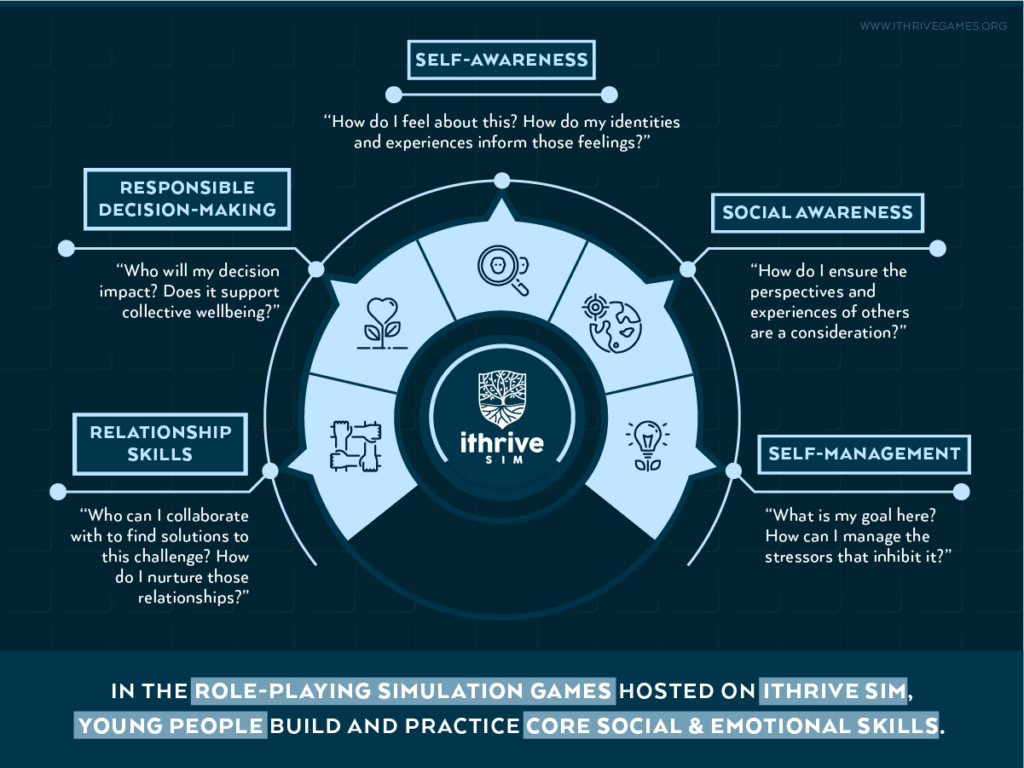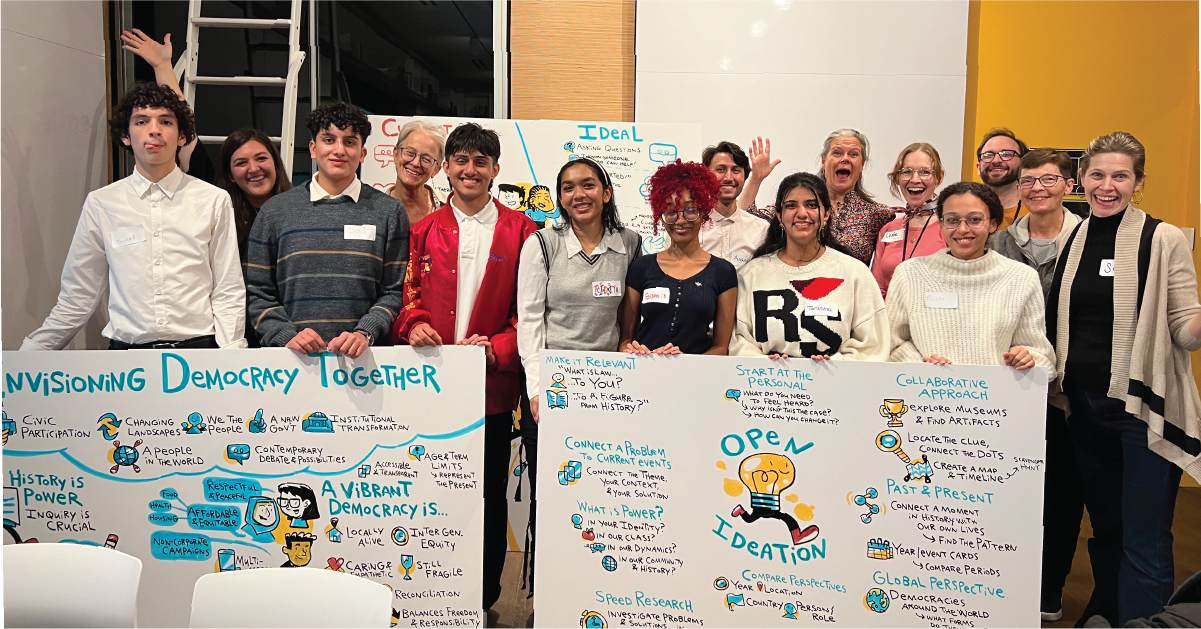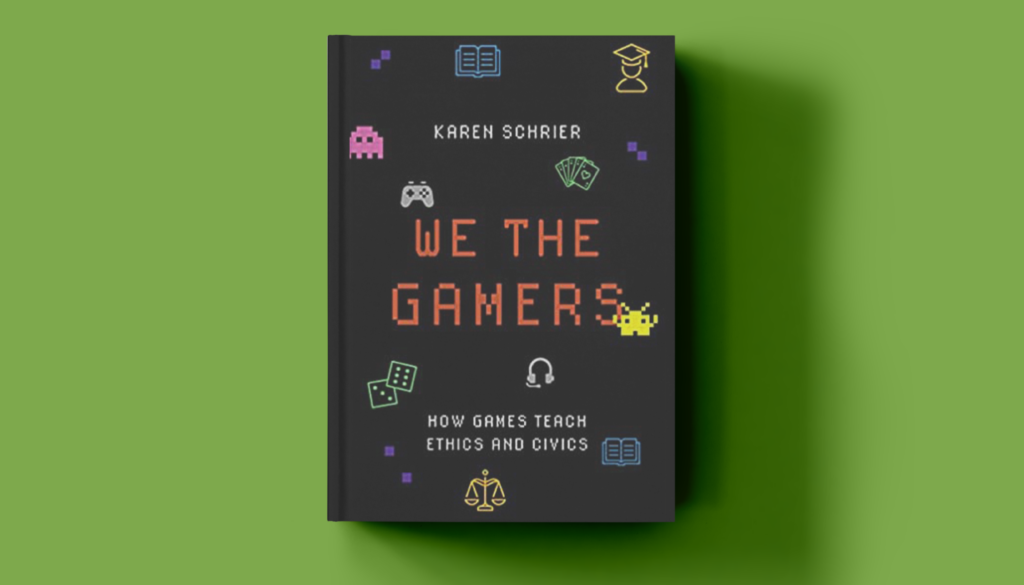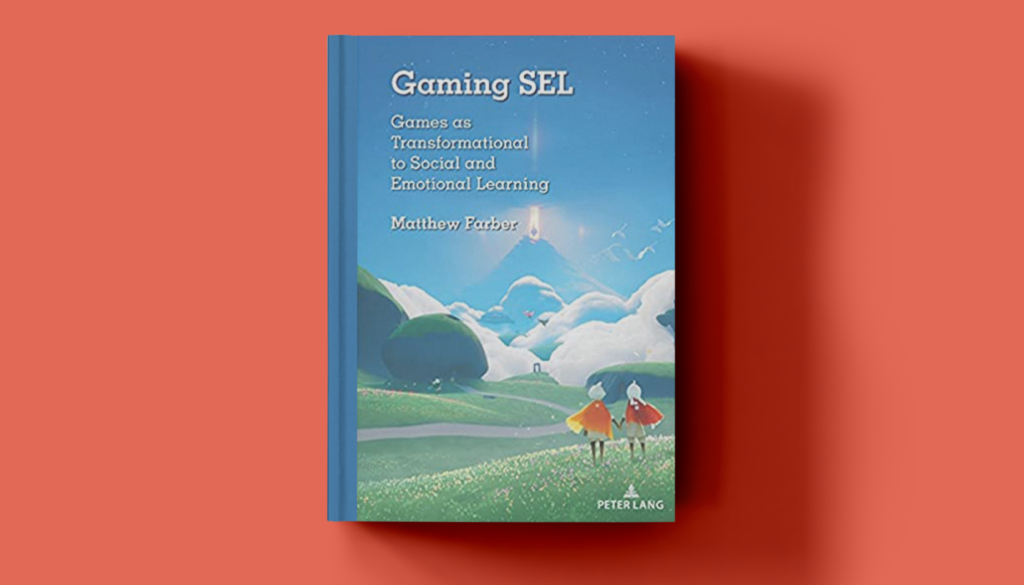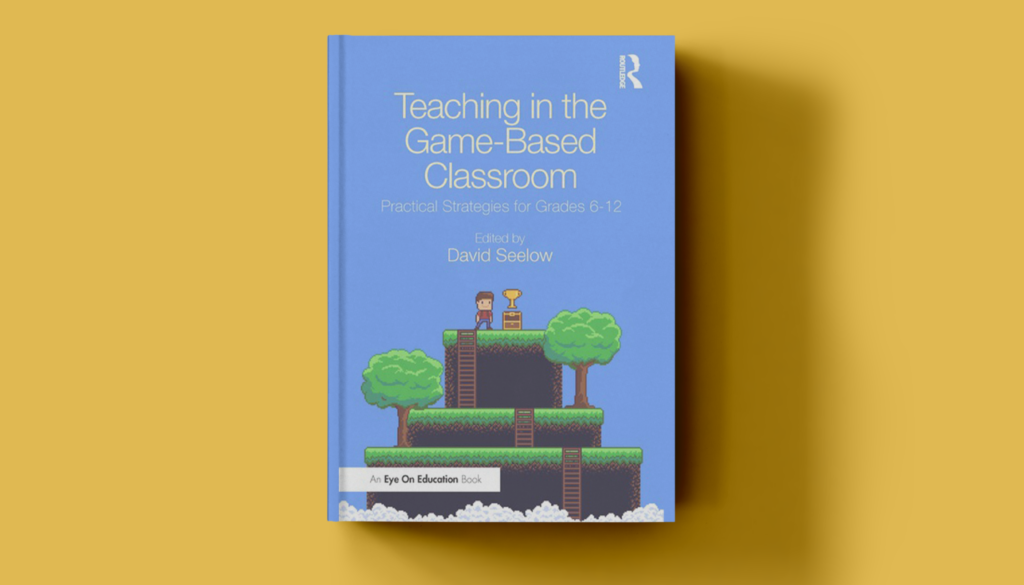iThrive Sim: A Game-Changing Tool for Adolescent Research

For researchers studying youth behavior, development, mental health, education, and social dynamics, a youth-centered approach is crucial.
Choosing a method that allows young people to be seen, heard, valued, and supported directly impacts the quality and authenticity of study outcomes. At iThrive Games, we know from experience that play offers a viable and valuable research method that meets young people where they are with what they know. Our award-winning iThrive Sim game engine is an example of this, creating simulation games that serve as rich conduits for exploration, experimentation, and learning. When used by psychologists, sociologists, and education researchers, iThrive Sim offers a game-based way to explore how young people confront challenges and navigate decision-making. We invite all with inquiry to connect with us to learn how they can use the platform in their research.
WHAT IS ITHRIVE SIM?
iThrive Sim is an accessible, web-based, and device-agnostic digital game engine to engage young people in any in-person setting or home with Wi-Fi. Designed for classroom use meeting in-person and virtual learning needs, it meets classroom requirements including low internet speeds, firewalls, time constraints, student absences, and child protection laws.
Named a 2022-2023 Learning Engineering Tools Competition Growth Award Winner and having won multiple industry awards, iThrive Sim offers single and multiplayer role-playing simulation games. Players step into assigned roles and encounter unique stressors as they navigate challenges and make real-time decisions that shape the unfolding narrative. Each player's experience concludes with a customizable outcome report, reflecting their in-game engagement and behaviors.
WHY ITHRIVE SIM WORKS AS AN ADOLESCENT RESEARCH METHOD
In adolescent research, finding methods that truly engage young people while delivering meaningful insights can be challenging. iThrive Sim bridges this gap with its plug-and-play technology, interactive capabilities, and thoughtful design, creating a robust environment for research. Its tech specs and unique approach to gameplay and learning make it an ideal tool for studying the complexities of adolescent development and social interactions. Here are five reasons why:
1. ENHANCED ENGAGEMENT AND MOTIVATION
Using a game-based research method like iThrive Sim increases engagement and motivation for adolescent participants by leveraging the immersive and interactive nature of games. Games provide a familiar and enjoyable environment where teens can explore scenarios, make decisions, and see the immediate consequences of their actions. This dynamic approach keeps participants interested and invested, as it feels more like play than traditional research. Additionally, the challenge and rewards encourage sustained participation and deeper involvement, leading to richer data and more authentic insights into adolescent behavior and decision-making.
2. REAL-TIME DATA COLLECTION
iThrive Sim supports data collection of in-game behaviors. Real-time interactions in the game platform allow adolescent researchers to gather time-sensitive data linked to in-game decision-making, stressors, information processing and sharing and more. Researchers can add video capture to support observational data collection of interpersonal interactions and nonverbal behaviors. Surveys administered pre, post, and during gameplay support for additional insights.
3. SIMULATION OF REAL-WORLD SCENARIOS
iThrive Sim's role-playing games offer a unique window into adolescent behavior. Role-playing games (RPGs) are known for fostering creativity, collaboration, and problem-solving. iThrive Sim goes further, providing a powerful tool for studying complex psychological processes in a natural setting. In the safe, playful environment of iThrive Sim, researchers can simulate real-world scenarios, allowing teens to make decisions and observe the outcomes without real-world risks. This approach yields valuable insights into behaviors and decision-making processes that are challenging to study through traditional methods, making iThrive Sim a unparalleled tool for adolescent research.
4. CUSTOMIZATION AND FLEXIBILITY
iThrive Sim's dynamic features empower researchers to create tailored experiences that precisely meet their study's needs. The platform's authoring tools allow for full customization of the research environment, enabling adjustments to difficulty levels, roles, decision points, and scenarios. Through this, researchers can also focus on specific variables, making iThrive Sim a versatile tool for targeting precise questions. This flexibility is particularly valuable in adolescent research, where the ability to adapt and refine the experience ensures that the study remains relevant and impactful, providing deeper insights into complex behaviors and decision-making processes.
5. SCALABILITY AND ACCESSIBILITY
With iThrive Sim, adolescent researchers can significantly broaden their reach. The platform is designed to engage a larger and more diverse population, including remote or hard-to-reach groups. Researchers can scale their studies to include participants from various regions and demographics, thereby enhancing the generalizability of their findings. iThrive Sim's user-friendly technology and adaptability to different internet conditions and hybrid settings ensure seamless scalability. This flexibility allows researchers to effectively conduct large-scale studies, reaching diverse populations and gaining richer, more comprehensive insights into adolescent behavior and development.
ENLIST ITHRIVE SIM IN YOUR ADOLESCENT RESEARCH
In adolescent research, it is crucial that young participants feel seen, heard, and valued as active contributors to science rather than just subjects. This approach not only enriches the data collected but also upholds ethical standards that prioritize the well-being and agency of young people. iThrive Sim embodies this philosophy, offering a platform where teens can engage deeply, explore real-world scenarios, and provide authentic insights in a safe and supportive environment.
By choosing a research method that resonates with the needs of young people, adolescent researchers can ensure their work is both meaningful and impactful. At iThrive Games, now part of the History Co:Lab, we work as an interdisciplinary team of game and experience designers, developmental psychologists, and learning science experts who are committed to unlocking the potential of games as tools for positive youth development. Contact us today to find out more about using iThrive Sim in your research!
Turning FEMA’s Lifeline Info Into an Immersive Game with iThrive Sim
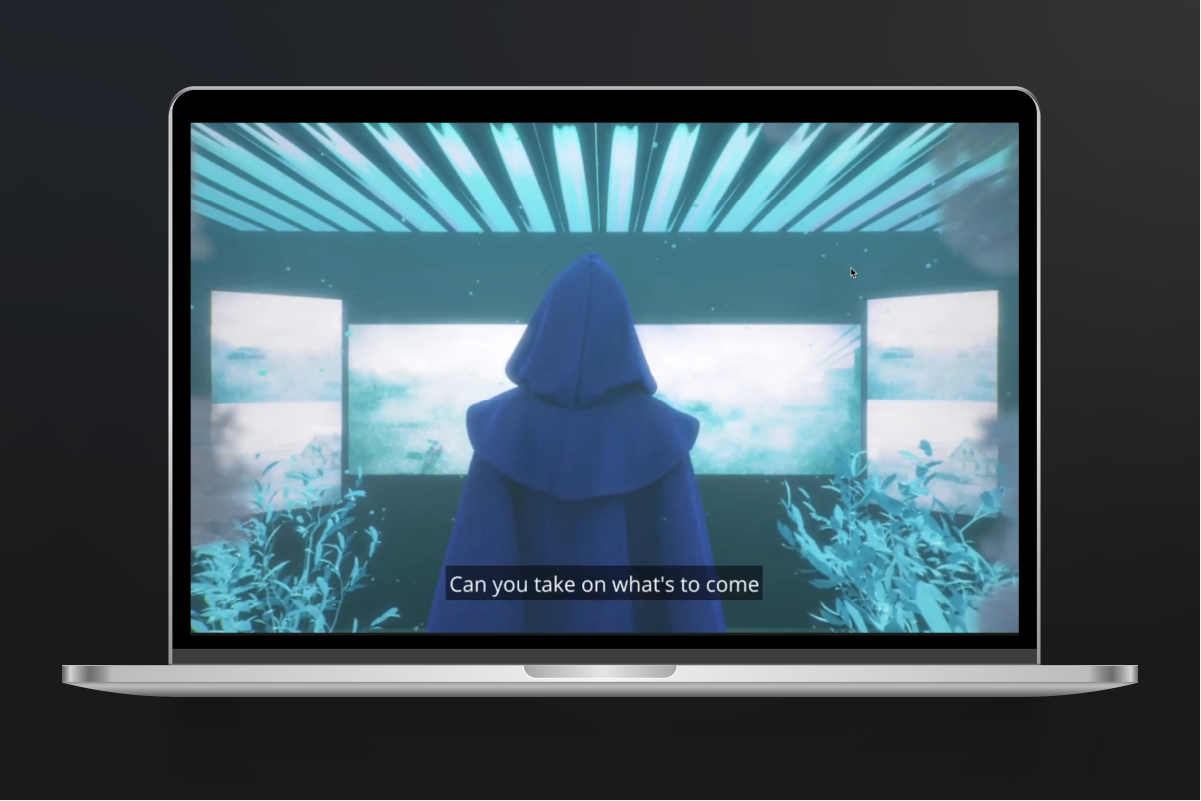
Young people feel the emotional weight of the world's challenges. They see the stories on their social media feeds and TV screens that bring forth questions, sometimes grief, and almost always hope for solutions that move us toward a world grounded in empathy, safety, and communal care.
Young people want to be a part of imagining and co-creating solutions that get us there, too, ones that bring forth better ways of being and doing that are supportive of their thriving and all our thriving. Teens and young adults already embrace and demand social action, according to the 2023 Deloitte Global Millennial and Gen Z Survey. Young and curious, they are instigators of change, with 83% saying they believe in their generation's power to inspire action in their local networks and impact societal problems, according to a 2020 CIRCLE Survey.
As agents of influence and drivers of transformation, young people wield within them a power to shape and steer both present and future. All in their learning ecosystem who believe in their genius and care about their thriving—from teachers to emergency management specialists—have a duty to nourish and honor that power.
For the Federal Emergency Management Agency (FEMA) Region 8 team, this duty led them to partner with the iThrive Games team to design and develop Disaster Mind, a disaster readiness and resilience-building game that meets young people where they are with play. Disaster Mind is a digital game designed to inspire social action toward community preparedness. Built and hosted on iThrive Sim, an award-winning game engine and development platform that creates and delivers role-playing simulations, Disaster Mind integrates live-saving information with interactive storytelling and an immersive play experience, actively connecting young people to knowledge that prepares them for disasters and activates them as movers and shakers capable of organizing their families, friends, and communities.
"We know that youth can be force multipliers in helping their families and households prepare for emergencies and disasters," shares Kirsten Maltese, the Youth and Adolescent Program Manager and a Community Preparedness Officer at FEMA Region 8. "[This] can spark a conversation with their friends and families but can also be a bridge between them and their local emergency management office. If we spark their curiosity and interest in preparedness at an early age, we can help them develop lifelong habits that will help them in their homes and communities."
A PLAN'S POWER: THE RESILIENCE PART OF DISASTER RECOVERY
Disaster preparedness is a silent sentinel that proves its power in times of chaos. It is core to disaster recovery. A proactive approach and an intentional mindset, reflected in historic taglines popularized by FEMA and on ready.gov like "Disasters don't plan ahead, you can" and "Prepare. Plan. Stay Informed," implore us to take action to reduce our vulnerability to disasters and increase resilience when they strike. "Disaster Mind gives potential survivors the opportunity to simulate real-life situations, " shares Daniel Nyquist, an Executive Officer at FEMA. "They make decisions that would lead to their eventual recovery." Here's how.
ITHRIVE SIM'S GAME-BASED LEARNING: A DIRECT-TO-YOUTH SOLUTION
Care in action means meeting young people where they are to support their thriving. In a world brimming with technology where over 600 million young people play video games, that includes leveraging play in spaces where they learn. Learning science shows that play has power; play supports engagement and can foster active learning through decision-making and problem-solving. In the months following the onset of the COVID-19 pandemic in 2020, as parents, guardians, and educators scoured for new virtual classroom and learning tools, many turned to play as a tool for connection and fun.
iThrive Sim launched in that same year as an accessible web-based and device-agnostic digital game engine capable of engaging young people in any educational setting or home with WiFi and a 1:1 device. The game engine delivers role-playing simulation games with integrated social and emotional skill-building. Players encounter unique stressors as they navigate challenges. They make real-time decisions that impact the unfolding narrative. With iThrive Sim, awarded for its learning engineering and design, we worked with the FEMA Region 8 team to build Disaster Mind, a single-player simulation game where players must navigate severe weather events, stay informed, and make decisions that impact how the story unfolds. The young people who play expand their understanding of disaster preparedness as they contend with unexpected weather events, manage its accompanying stress, and attempt to make the best decisions for the safety of themselves and their communities.
Disaster Mind has been both thought- and action-provoking for young people since its official launch on www.ready.gov this year. After playing, players express their motivation to get prepared, saying, "I should go home and make sure my family is prepared just in case something happens." Others shared in post-game focus groups that the simulation game expanded their sense of responsibility, opening them up to consider what it would be like to navigate a disaster without being accompanied by family or a trusted adult. The game is designed to activate and support young people's planning, involvement, and leadership in their community's preparedness efforts, core goals of the National Discovery Recovery Framework. "As young people navigate from support structures like their families and schools, we intend to help them prepare for their next phase in life," shares Maltese. "This type of engagement ahead of a disaster is what helps build resilience in communities - and we believe youth can be the driver of that."
THE SOCIAL AND EMOTIONAL SKILL-BUILDING IN DISASTER MIND
Vital to disaster readiness is prepping for the social and emotional. iThrive Sim's dynamic features are optimized to deliver experiential learning in a unique and developmentally nourishing way to teens. Disaster Mind is designed to be a social and emotional skill-building play experience that helps teens shift from an automatic mindset of "This won't happen to me" and "Other people will handle it" to an intentional mindset of "I may face an emergency at some point" and "I will think for myself".
Rather than prescribing learning, iThrive Sim encourages teens to make meaning of the content they encounter, allowing them to learn by doing and develop understandings that go beyond the surface knowledge of facts and information. Through a careful combination of game features and mechanisms that purposefully ignite feelings, teens are prompted to draw on their own experiences and skills while they make decisions. The game gives them opportunities to practice critical thinking, acquire and interpret information, and make real-time decisions while navigating challenges.
This active learning is transformative social and emotional learning.
WHAT A GAME LIKE DISASTER MIND CAN DO
The impact is in their testimonies.
Young people who've played the Disaster Mind simulation game walk away from it with a sense of ownership of the plan and investment in the outcomes, leading to greater participation and collaboration, too. "I've discussed with my family about disasters. We are making plans for them and intend on making them as clear and as direct as possible for everyone to stay safe during disasters," shared one of the first teens who tested Disaster Mind.
The scaffolded challenges, personalized feedback loops, and real-world applicable social and emotional skill-building that young people who play Disaster Mind experience makes them more familiar with the work of preparedness and the network- and community-wide planning and capacity-building efforts it entails.
"We often hear phrases like "if I only knew I would need..." or "I wish I had known that.." in the aftermath of disasters," says Nyquist. "Disaster Mind enables players to understand those needs in a safe and engaging setting before a disaster happens. This results in players being better prepared and equipped with information and strategies they need to maximize recovery resources and be resilient in their own recovery."
We knew that the effectiveness of Disaster Mind depended on young people wanting to play it. To ensure it would be engaging, relevant, and motivating for young people, we brought them into the design process using iThrive's as the participatory youth co-design approach. Their input shaped the story, the look and feel of the game, and the game mechanics. The impact and influence of Disaster Mind reflect the power of both co-design and game-based learning to engage young people in the work of inquiry, discovery, and reflection. Designed with collaboration and care and learning science, Disaster Mind animates and introduces life-saving strategies to agents of change and shapers for safe and resilient tomorrows: young people.
| |
PLAY THE DISASTER MIND SIMULATION GAME ON ITHRIVE SIM! 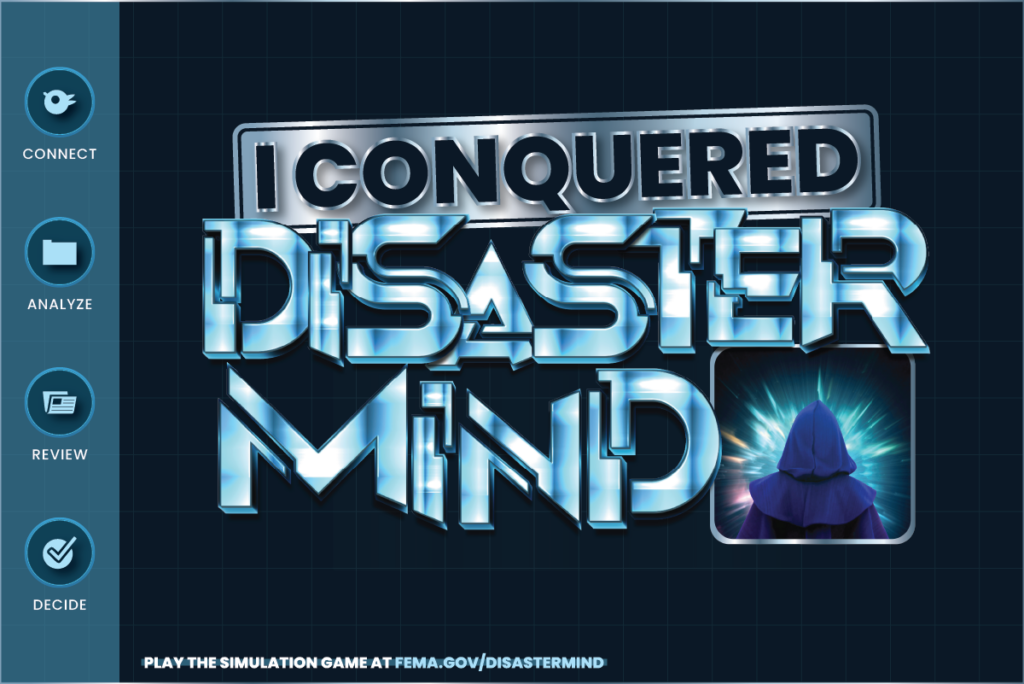 |
Our Year of Knowledge-Building, Knowledge-Sharing & Play
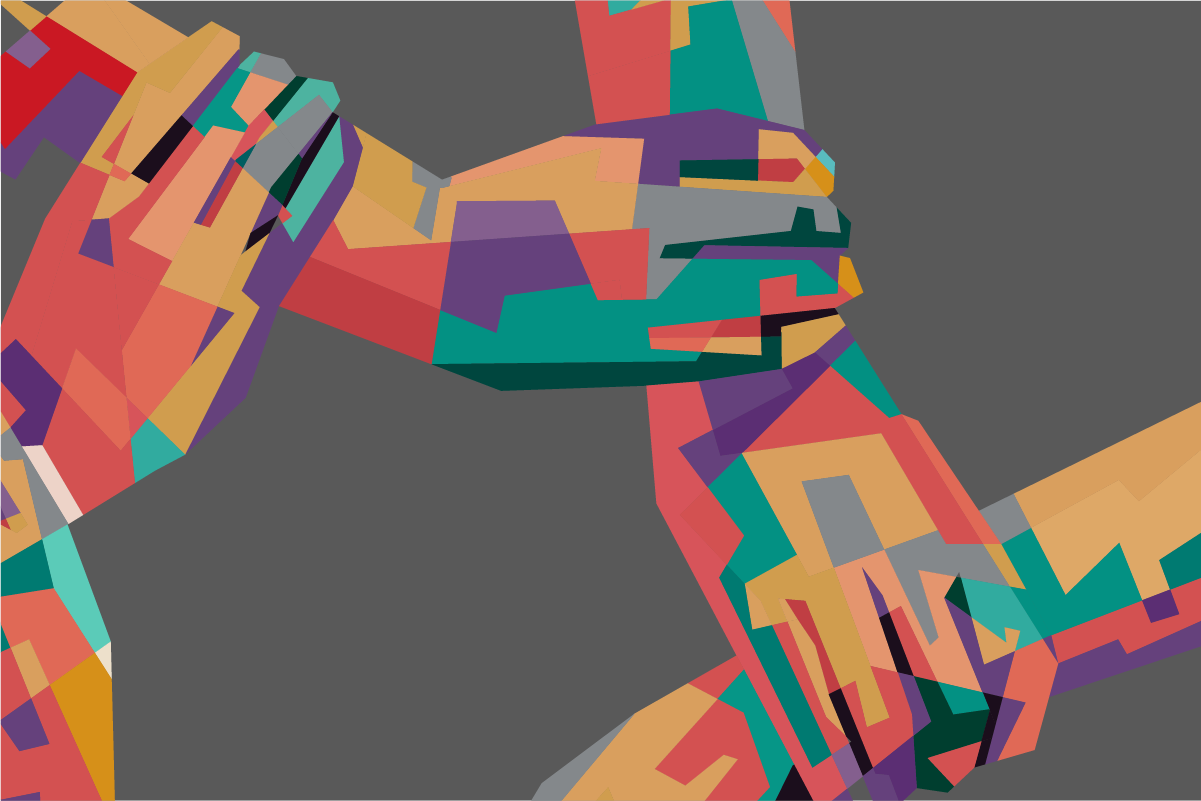
Joy enriches. As a connector, joy helps realize the 'we' and nourishes the 'us' that directs how we gather, steers how we imagine, and inspires what we create.
This year, joy guided our work alongside young people, nonprofits, government agencies, school communities, research institutions, game developers, subject matter experts, and learning experience designers. With teens and our partners, we built knowledge, shared knowledge, and co-designed transformative experiences for teens supportive of their learning, mental health, and thriving.
Throughout 2023, partnership propelled impact and possibility, helping us and those we collaborated with expand it in places where teens learn and play. Collaboration and community-building were consistently parts of all we did this year— from our co-design sessions that led to co-created games and learning experiences to the conferences and panels we were part of. In togetherness, we pooled strengths with teens and others. We leveraged the diversity of our experience and expertise and those we merged genius with to accelerate progress toward the world we each yearn—one where young people have the tools to live full, safe, healthy, and purposeful lives. It was amazing.
In celebration of what the year has been and all that is to come, here is a look back on eight joy-filled memories in no particular order, as well as our favorite collaborative moments, and unforgettable highlights from 2023:
#8. PLAYTESTING CADENCE FORD AT PLAY NYC
At Playcrafting's Play NYC this year, an event that magnified the power of play and brought hundreds of game industry professionals, indie game developers, and game designers together to exhibit their games to players and peers, we shared an iteration of Cadence Ford, the single-player, text-based strategy game we created with the One Love Foundation and Playmatics, LLC.
 |
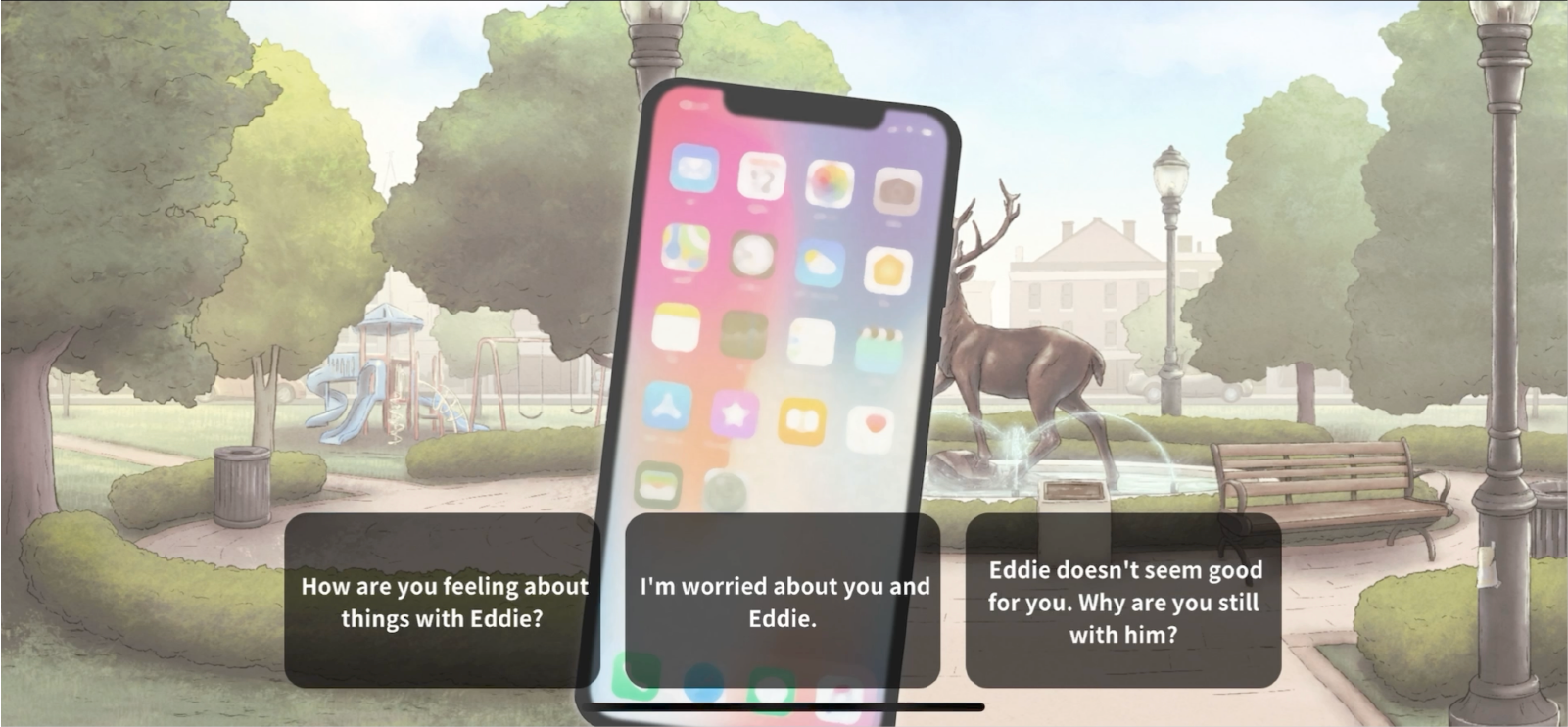 |
Building on One Love's mission to empower young people with the life-saving prevention education, tools, and resources they need to see the signs of healthy and unhealthy relationships, Cadence Ford supports young people in learning to love better, in being with partners who practice healthy Love and communicating with loved ones who are in unhealthy relationships. While New Yorkers of all ages played the game demo and shared feedback, teens, many of whom went on to become members of our Teen Hub, were particularly moved by the game's storyline, mechanics, and captivating 2D art. Read about Cadence Ford's co-design process and the forum for listening to and learning from young people we created at Play NYC.
#7. OUR CO-DESIGN WITH TEENS AT THE NEW YORK HISTORICAL SOCIETY
For the students from Thomas A. Edison High School who gathered at the New York Historical Society with us, History Co: Lab, a graphic notetaker, and others in Educating for American Democracy (EAD)'s network in November 2023, the co-design workshop presented an opportunity rare in their worlds—a chance to share how they envision democracy and impact civic learning that supports the future of it.
Our Game Design Studio model at the center of the co-design experience engaged them not just as students at the end of learning experiences but also as thought partners in co-designing them, setting the stage for meaningful co-creation. The teens, who ended up devising and developing a prototype for a new interactive EAD-inspired card game created to inspire high-quality civic learning experiences by the end of the workshop, called it "promising," "progressive," "unique," "revitalizing," and "relief." Read how the model brought many across the civic education ecosystem together and what came of the teens' collaborative experience.
#6. THE LAUNCH OF OUR DESIGNING FOR TEEN THRIVING MAILING LIST
Impact-driven nonprofits, youth-serving programs, and government agencies trust us to preserve their commitment to teen wellness and thriving.
This year, we launched Designing for Teen Thriving, a mailing list that gives people like them access to the resources and insight of iThrive's game designers, learning experience designers, and teen social and emotional development experts. Subscribing to the list helps individuals looking to create developmentally nourishing experiences and wellness-supporting games for teens (with us or on their own) ensure what they create meets young people where they are and supports their thriving.
Join the Designing for Teen Thriving mailing list today!
#5. THE SOFT LAUNCH OF DISASTER MIND, AN ITHRIVE SIM GAME MADE WITH FEMA
The work of disaster preparedness, response, and recovery is as emotional as it is manual. Disaster Mind, the single-player simulation game built on the iThrive Sim platform with Federal Emergency Management Agency (FEMA) Region 8, supports young people's understanding of it.
This year, the FEMA Region 8 team soft-launched the game after one and a half years of development.
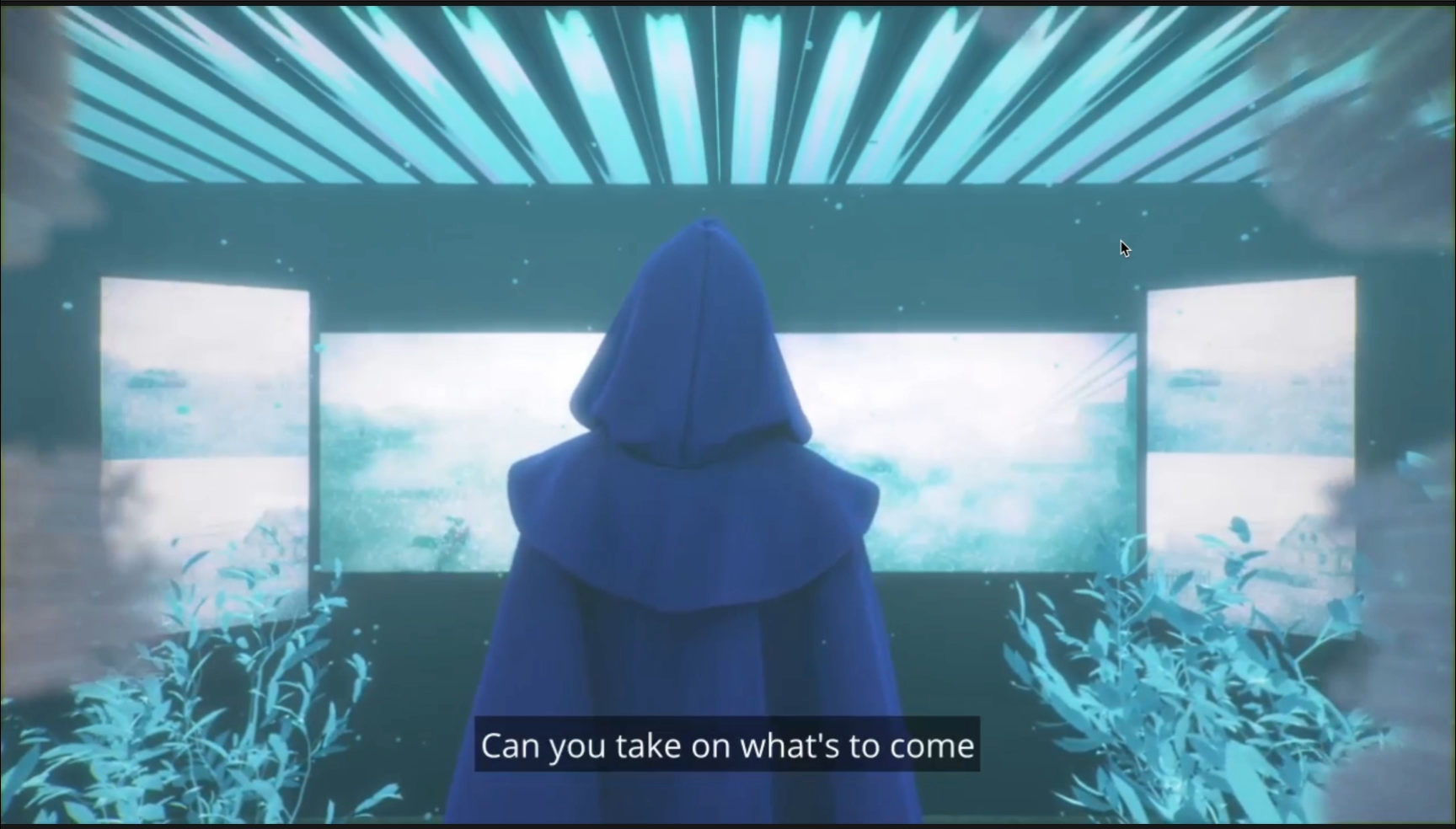 |
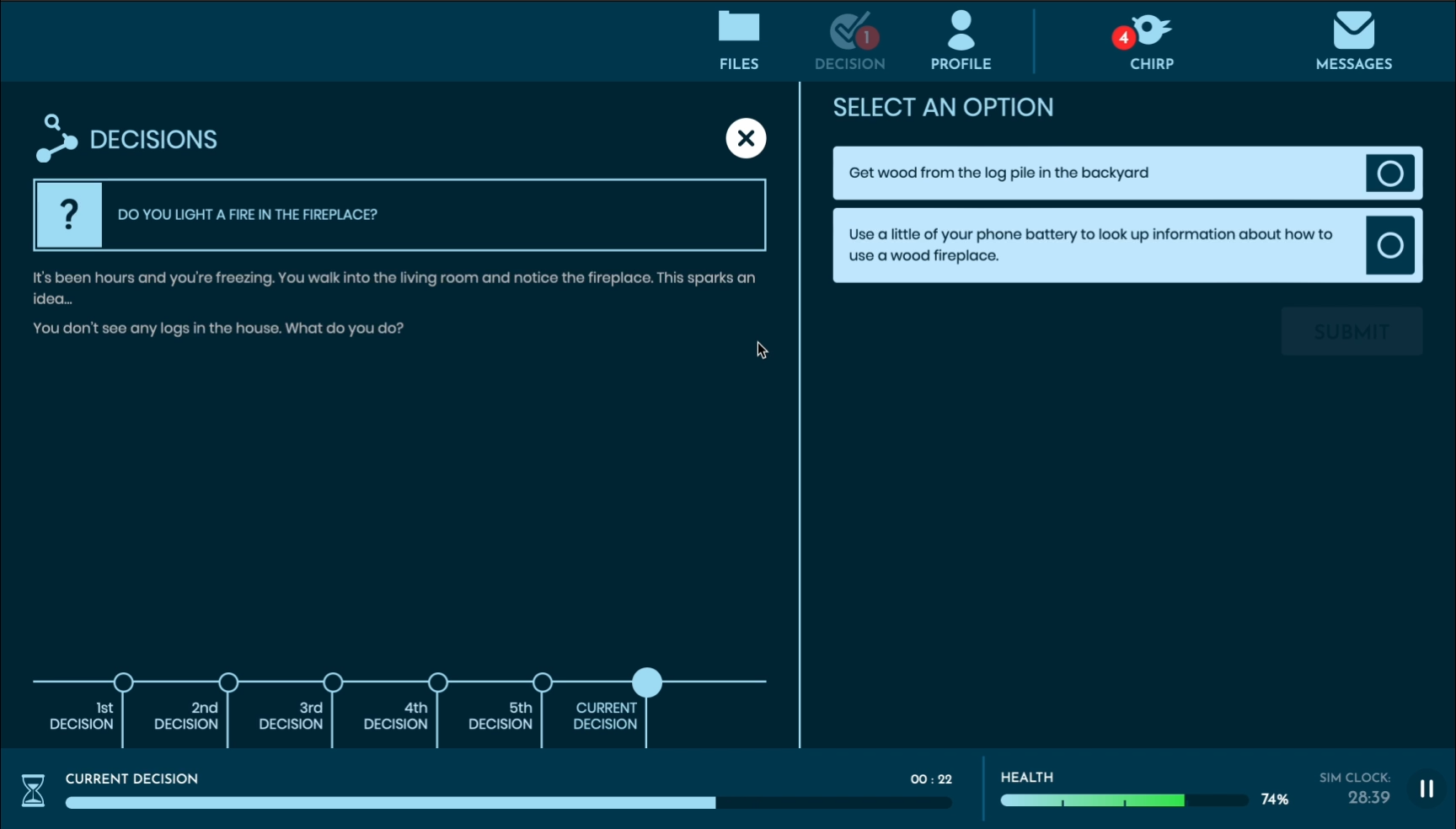 |
Young people who've playtested the game have reported feeling more confident in preparing for an emergency, managing the associated stress, and understanding the intentional mindset that underpins disaster preparedness. Many also have relayed plans to turn their awareness into action, mentioning specific disasters and sharing plans to talk to their families about exit plans, emergency kits, and meeting locations. Dive into the Disaster Mind's co-design process and explore what teens had to say about its readiness and resilience-building play experience.
#4. OUR CO-DESIGN WITH H.S. STUDENTS FROM THE GLOBAL NOMADS GROUP
Also this year, as part of an exciting learning experience design project currently underway with History Co: Lab and the XQ Institute, members of the iThrive Games team had the opportunity to gather virtually with high school students from the Global Nomads Group across two co-design sessions.
True to our norm of iterating for impact, the young people, hailing from several countries across the world, met with us to go over parts of the game-based, social and emotional skill-building experience we're creating, lending their ideas, feedback, and expertise to make it as engaging, accessible, inclusive, and resonant as possible. The play-filled meetings featured icebreakers, stretches, constructive questions, and Jamboards. It was an honor to learn from them while supporting their design thinking in the connective experience.
#3. ITHRIVE SIM NAMED A LEARNING ENGINEERING TOOLS COMPETITION WINNER
This year, the iThrive Games team was named one of the 32 winners of this year's Learning Engineering Tools Competition, selected from over 1,000 edtech innovation proposals submitted worldwide.
The win and accompanying $100,000 Growth Phase award in the Transforming Assessments track enables our team to expand iThrive Sim, our playful engine that hosts, powers, and evaluates immersive and interactive role-playing simulation games, with new ways to measure and assess the teen social and emotional learning fostered in them while developing alongside others in the growing learning engineering discipline. We are honored to share this win with our software development partners at Affordance Studio and EdTech Recharge's Kripa Sundar. Learn more about the Tools Competition and the expanded iThrive Sim to come.
#2. THE CONFERENCE CONNECTIONS
Attending game-filled, educational, and ed-tech conferences was an absolute favorite for us this year.
At Games for Change, we learned tons from designers, researchers, and changemakers, and at ED TECH WEEK NYC, we explore how tech innovation continues to support access, learning, and workforce development.
Members of our team also had the opportunity to showcase our co-designed games at ED Games Expo and PLAY NYC and lead discussions elsewhere too. In March, as part of MA Civic Learning Week, we shared on iThrive Sim's transformative civic learning games for high school classrooms. At ASU+GSV Summit in April, our Executive Director and Chief Scientist Susan Rivers talked about the necessity of social and emotional skills in today and tomorrow's careers on an American Student Assistance panel alongside others invested in the thriving of this generation's learners. At NSLA's Summer Learning Summit in October, she joined the Education Innovation Stage with other thoughtful experts to discuss learning and youth development that can inspire, challenge and deepen summer learning.
Each space we shared with others was carried by joy and animated by an eagerness to connect and collaborate with others eager to merge genius and create better systems of care and learning.
#1. OUR CREATIVE COMMONS-LICENSED, GAME-BASED LEARNING LIBRARY
Access enables impact. This year, we opened access to our game-based, social and emotional learning educational resources by licensing them under Creative Commons. Educators and teen-serving adults who care deeply about young people's thriving can merge it with their work and expertise.
Each iThrive Curriculum unit, iThrive Sim curricular surround, iThrive Game Design Kit, iThrive Game Guide, and iThrive-authored PDF resource can be remixed, redistributed, and built upon. Dive into them!
Whether you're a teen who co-designed or playtested with us, a partner or collaborator who co-created with us, an educator who brought our resources to your students, a game designer who used our game-making resources, or a supporter who read our blogs and cheered us on, we appreciate each of you for the many ways you engaged with us this year. A heartfelt thank you for sharing in our vision of teen learning and thriving, and happy new year to you and yours!
FEMA’s New Game, Built on iThrive Sim, Preps Teens for Natural Disasters
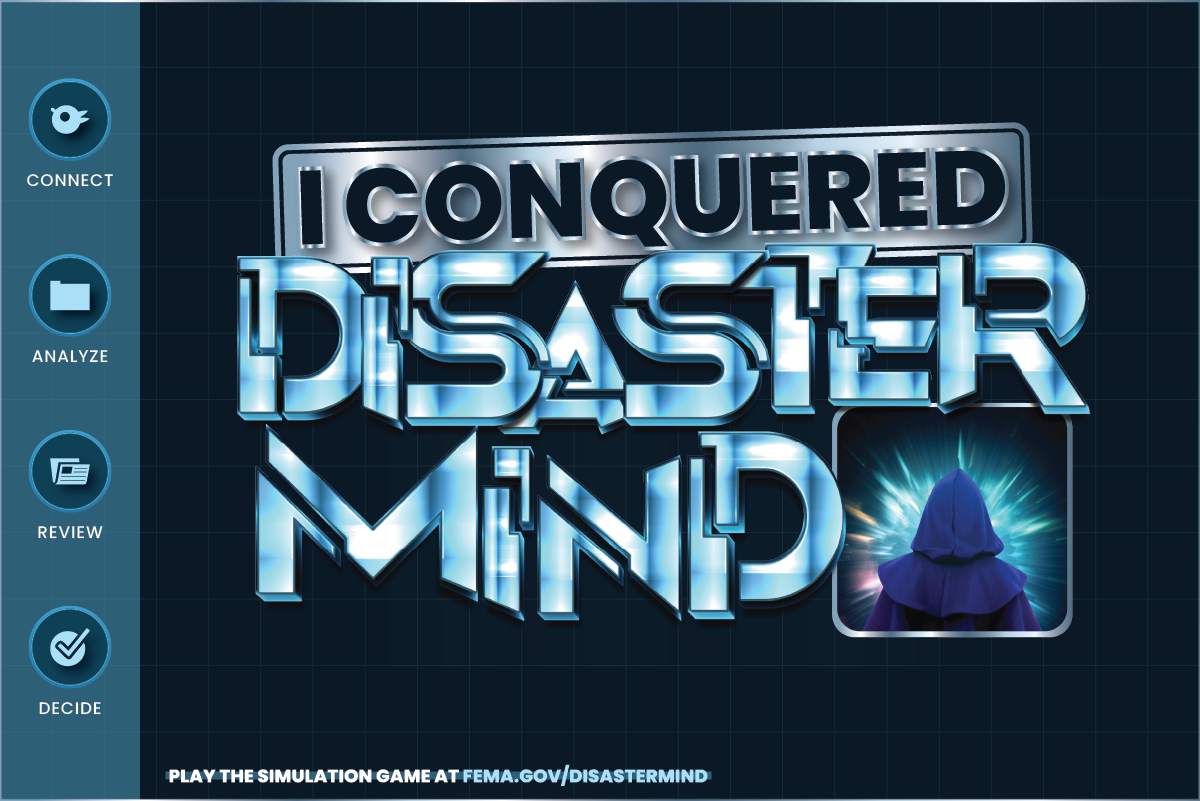
With natural disasters come disruptions and decisions.
Disaster Mind, a game created by the Federal Emergency Management Agency (FEMA) in partnership with iThrive Games, simulates all three in an immersive experience that makes the power of preparedness clear to all who play it.
The game puts the player in a world where they must navigate severe weather events, stay informed, and make decisions that impact how the story unfolds. Players expand their understanding of disaster preparedness as they contend with the unexpected, manage its accompanying stress, and act timely and effectively while under it.
Disaster Mind has been both thought- and action-provoking. The teens and young adults who have playtested it tell us that they are applying their game-based learnings to their real worlds and real lives soon after playing. "I should go home and make sure my family is prepared just in case something happens, " shared one teen after playing. "I've discussed with my family about disasters. We are making plans for them and intend on making them as clear and as direct as possible for everyone to stay safe during disasters," shared another.
As a resilience-building game, Disaster Mind seeks to empower young people with transformative education that helps them reach similar realizations. The impactful gameplay aims to activate and support their planning, involvement, and leadership in their network's preparedness efforts. "Young people are agents of change in their households, schools, and communities," shares Daniel Nyquist, the National Preparedness Deputy Director of FEMA Region 8. "iThrive helped us lean into their wisdom and lived experiences to design and produce Disaster Mind, and in the end, we have a compelling game that meaningfully helps their peers build skills supportive of their resilience and practices reflective of an intentional mindset."
DESIGNING FOR IMPACT: THE CO-DESIGN PROCESS
Our co-design process with and for teens is care in action and when brought to collaborations with partnering organizations, like FEMA, helps create a supportive context for discovery and powerful game design.
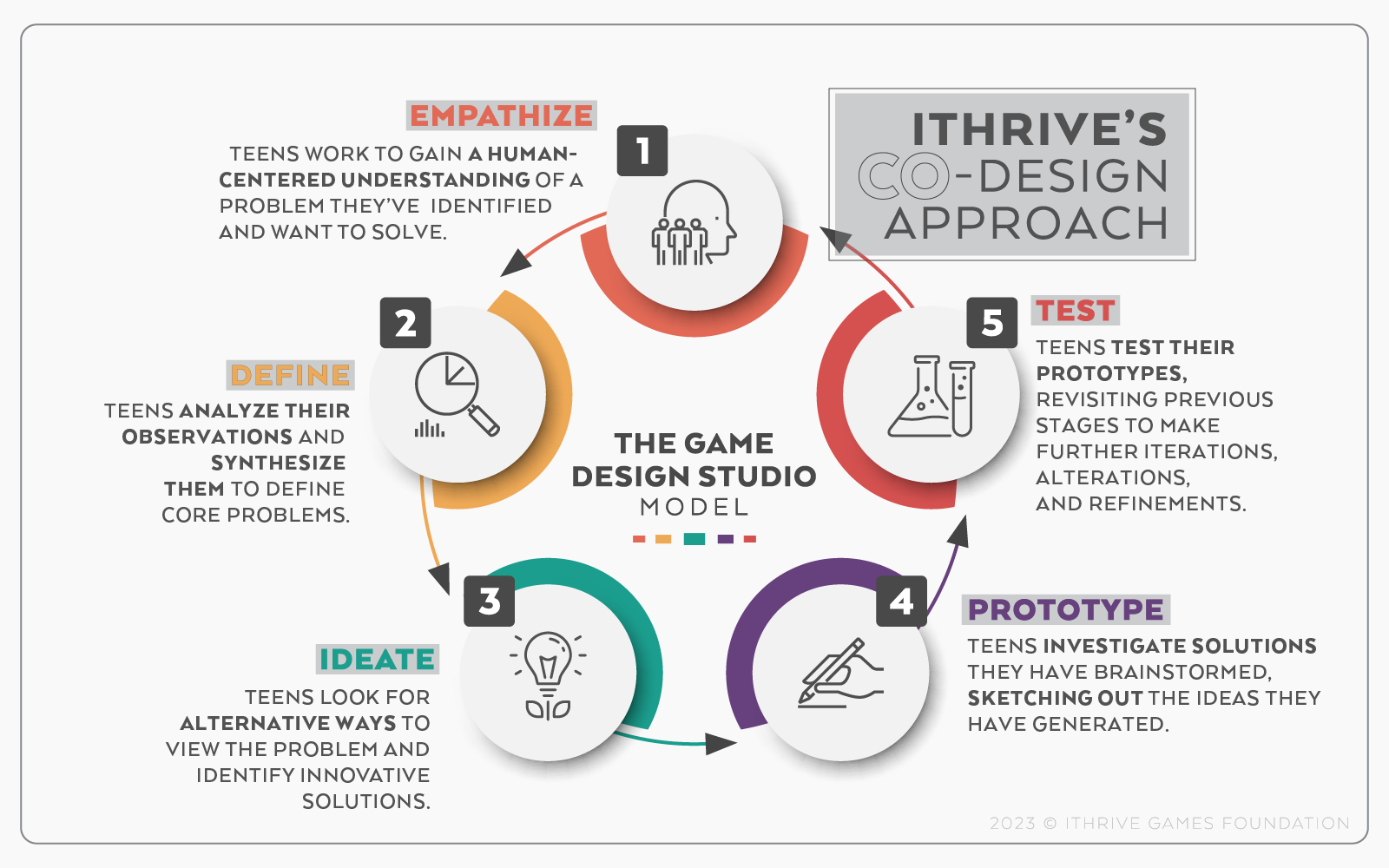
Explore some of the activities that make up iThrive Games' Game Design Studio model here.
The development of Disaster Mind began with co-design workshops with teens living in the states and territories served by FEMA Region VII (twenty-nine Tribal Nations, Colorado, Montana, North Dakota, South Dakota, Utah, and Wyoming). These gatherings sought to gauge their needs and understanding of the challenge Disaster Mind seeks to address. Teen co-designers surfaced themes that were top-of-mind for them, including the wellbeing of their pets, resource coordination, knowing which experts to trust, and cultivating the emotional ability to cope with disasters.
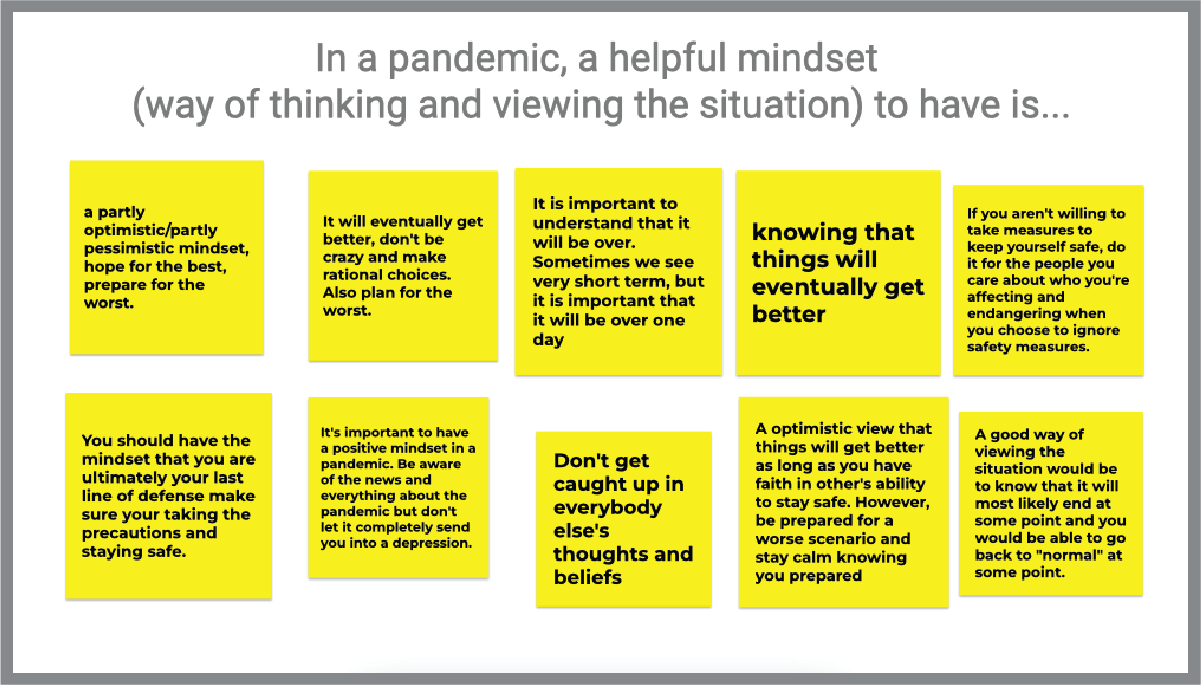
A snapshot of a Google Jamboard from an early co-design session held with teens virtually.
"Throughout this process, teens have been vulnerable, open, and generous in the sharing out of their ideas and wisdom. In their self-awareness, they've tapped into their firsthand experiences with hard topics to help make Disaster Mind relevant and responsive to their needs," shared Jane Lee, Senior Director of Operations and Mental Health at iThrive Games after our first co-design session in March 2022. "What they have contributed with their time, creativity, and retelling of their experiences navigating disruptions and shifts, has translated into a resonant resilience-building activity for their peers."
The themes and experiences teens shared with the design team and FEMA's emergency management specialists turned into actionable insights that informed Disaster Mind's content, ensuring the play experience we created was relevant, memorable, and responsive for teens.
MINDSET MATTERS IN DISASTER MIND
The work of disaster preparedness, response, and recovery is emotional. To convey this authentically and meaningfully in Disaster Mind, iThrive Sim—an award-winning platform that hosts single-player and multiplayer social and emotional skill-building simulations—was selected as the game's engine.
"iThrive Sim supports a 'learn by doing' approach where teens' emotions are ignited and used to support their active social and emotional skill-building," shares Dr. Susan Rivers, iThrive Games' Executive Director and Chief Scientist. "Each game offered via the platform is steered by teens' improvised interactions and real-time decisions, while the tech enables the modulation of stress and monitors in-game behaviors taken in response."


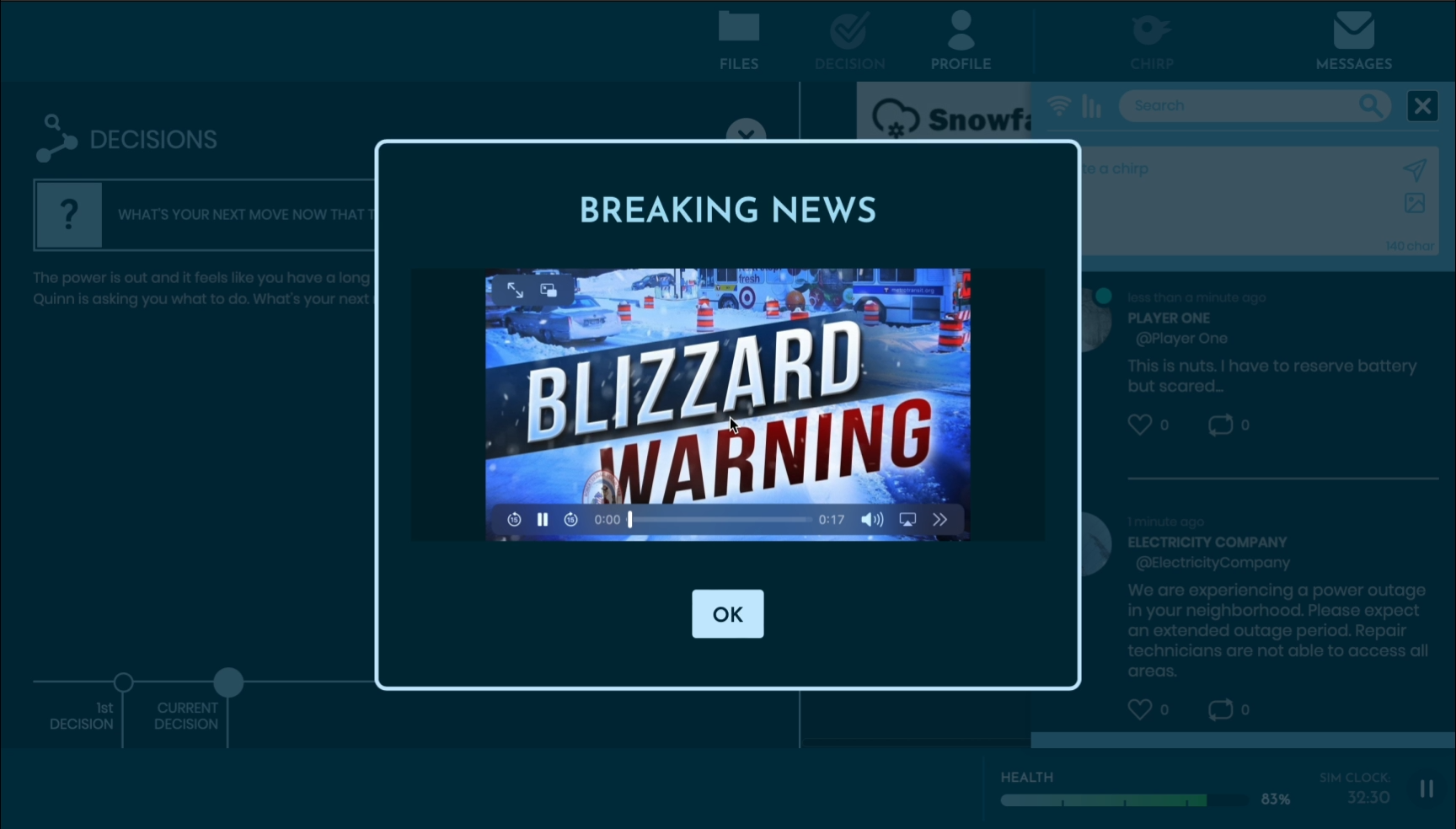
Screenshots of Disaster Mind, hosted exclusively on the iThrive Sim platform.
Using iThrive Sim's game mechanics, Disaster Mind invites players to practice social and emotional skills, like emotional regulation and responsible decision-making, while strategizing and solving their way through the game. By scaffolding this valuable skill-building with educational content meant to prepare teens for disasters, players grow familiar with the practices to lean on when complex emotions surface and the constructive mental pathways to call on when a natural disaster occurs.
Mindset matters as gameplay supports young people in being aware and actionable. Teens come to see through Disaster Mind's impactful play experience that underpinning the creation of a supply kit, or emergency go bag is an intentional mindset where one believes emergencies can happen to them and knows how to prepare.
'KNOW WHAT YOU PLAN TO DO': WHAT TEENS SAY ABOUT DISASTER MIND
True to our co-design process, teens across the country have been playing and testing Disaster Mind ahead of its launch later this year. Players reported feeling more confident in being able to prepare for an emergency and in managing the associated stress. Most report that they intend to talk to their family about an emergency preparedness plan, with many mentioning specific disasters, exit plans, emergency kits, and meeting locations.
After playtesting Disaster Mind, teens shared the following:
- "This game made me realize these types of disasters can really happen to anyone and you should always be prepared for the worst."
- "I think that it would be important in terms of cell service or other accidents to have a solid plan."
- "I now know to have a defined plan to be prepared if there were to be a natural disaster, especially if the family gets split, we should have a meeting spot."
- "Like it said in the game, you never know or never expect it to happen to you but it very well can."
- "I do intend on asking my parents if we do have a plan for if there were an earthquake. Living in an earthquake prone place, I realized that it is essential to have a plan with my family."
- "After [this] simulation, I feel like it is important to know what you plan to do."
The post-game reflections shared by young people attest to the power of the simulation. "Natural disasters are a challenge in today's world and will surely be one in the world teens and future generations will inherit," shares Stephanie Poore, the National Preparedness Branch Chief of FEMA Region 8." With Disaster Mind, our goal is to ensure teens are ready, aware, prepared, and practicing the skills that support their capacity when they strike."
New One Love Game Uses SEL to Help Young People Learn to Love Better
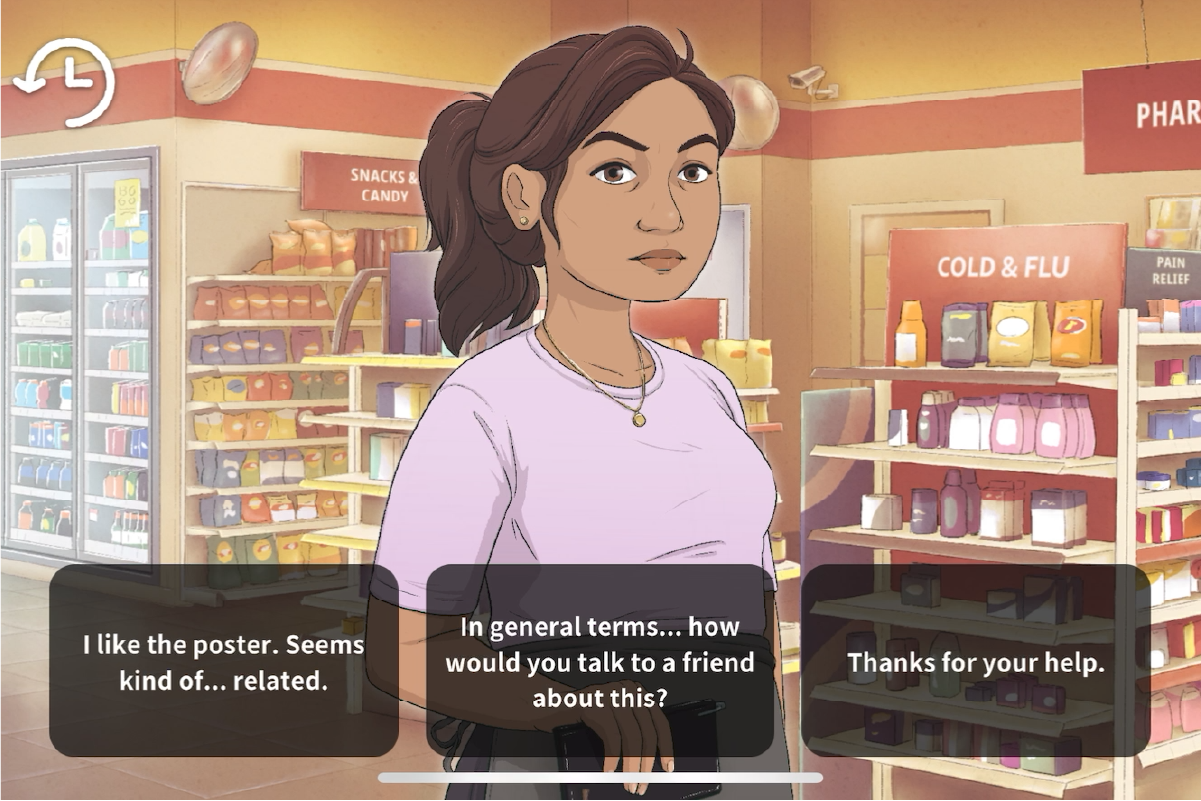
One in three young people will have an unhealthy relationship before reaching adulthood.
Interpersonal violence remains the third leading cause of adolescent death, contributing to one in every five teen suicides.
The need for more awareness-building and preventive interventions that help teens live full, safe, and healthy lives is unmistakable. Cadence Ford, a new mobile game made by the One Love Foundation in partnership with iThrive Games and Playmatics, LLC, responds to it with a safe and playful space for young people to familiarize themselves with unhealthy behaviors that may surface in relationships. As players interact with each story in the game, they are tasked with figuring out how to talk with their friends about uncomfortable issues and how to offer assistance in each of their unique circumstances. Through play, the game meets teens and young adults where they are to support their social and emotional learning and practice of constructive relationship skills.
"Cadence Ford builds on One Love's mission to bring life-saving prevention education to young people and expands on our honoring of Yeardley Love—a daughter, friend, and student-athlete whose life was tragically cut short by an ex-boyfriend in 2010 three weeks shy of graduating from the University in Virginia," shares Madeline Hopper, Senior Product Manager at the One Love Foundation. "Our goal with this game is to equip young people with the tools to love better, be with partners who practice healthy love, and advocate for healthy relationships. Because those tools are social and emotional, we were glad to have iThrive Games—experts in young people's social and emotional learning—be our partners throughout its development."
Our team joins One Love, and the teens and young adults who have played the game so far in hopes that Cadence Ford helps every person it reaches be aware, self-preserving, and better support systems for their friends in a world where antisocial interactions and unhealthy relationships are likely to be encountered. "We want all who play Cadence Ford to come to it with curiosity," shares Susan Rivers, Ph.D., iThrive's Executive Director and Chief Scientist. "And we want them to leave it empowered and better prepared to be ambassadors and practitioners of safe love and healthy communication."
MEANINGFUL GAMEPLAY, MEANINGFUL LEARNING
Cadence Ford sets forth a time-bending adventure in a charming town. Clocks have stopped, and the once-thriving community has fallen apart. The player must travel back to meet former friends, explore their stories, solve their mysteries, unearth past mistakes, and change the future before the present takes hold.
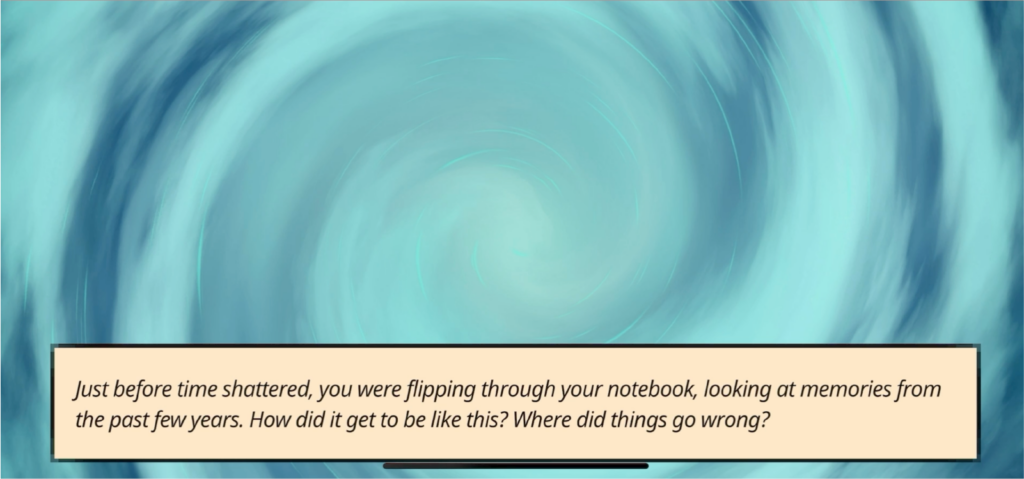
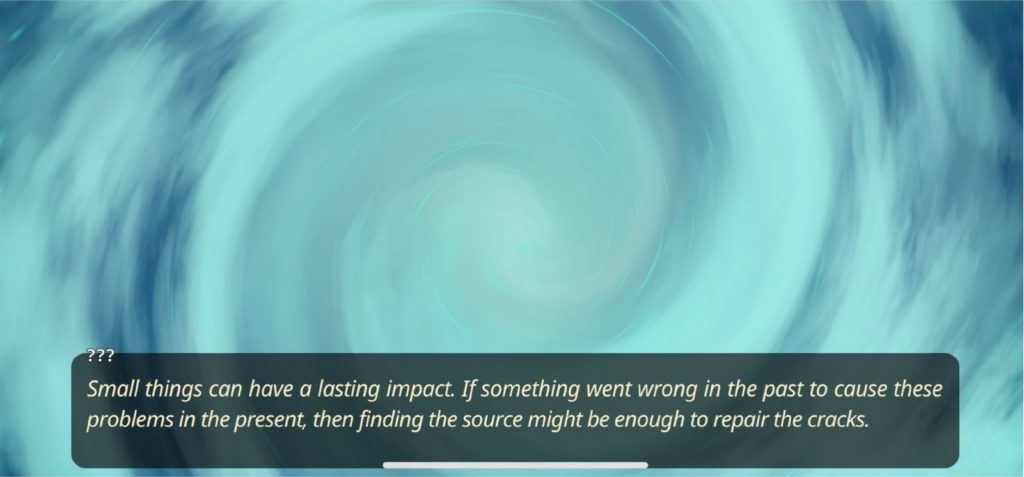
To do this, the player must make critical decisions throughout the game with how they communicate and interact with those past connections. Words must be chosen carefully since their friends' futures depend on it.
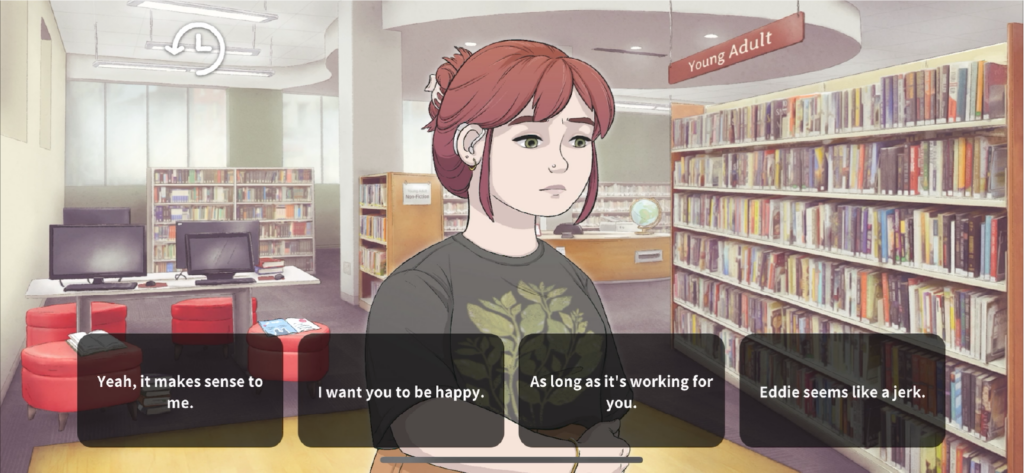
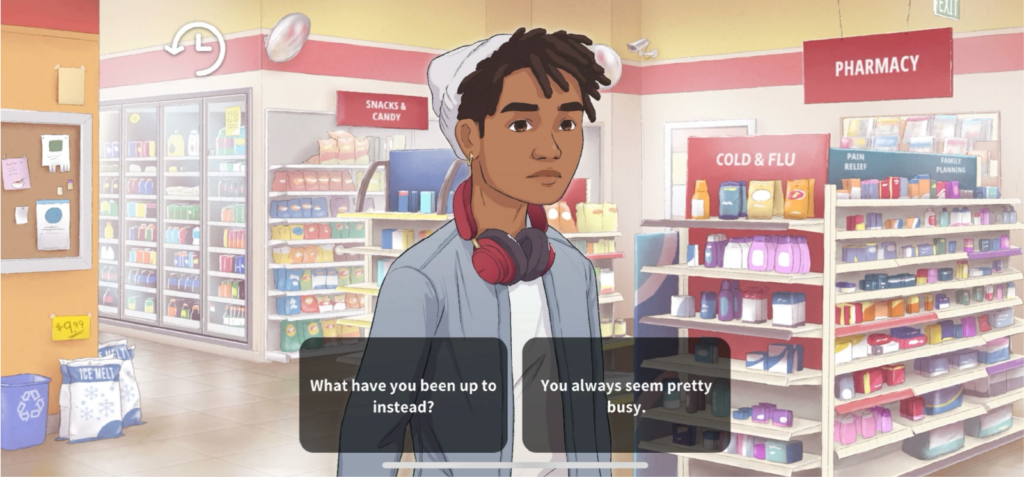
iThrive's teen social and emotional health expertise helped direct Cadence Ford's development cycle and supported the team's decision to make the game a text-based strategy one. In doing so, the play experience would build players' relationship skills by enabling their agency to make decisions and learn from them. "Games have always been microcosms of the real world, making them a springboard for exploring new ways of doing and being," shares Jane Lee, iThrive's Senior Director of Operations and Mental Health. "With Cadence Ford, we wanted to create a low-stakes, thought-provoking environment for young people to arrive at new understandings of who they are and the world around them. By making it a choice-filled offering, we offer young people a context to think expansively, arrive at learnings authentically, and fail safely."

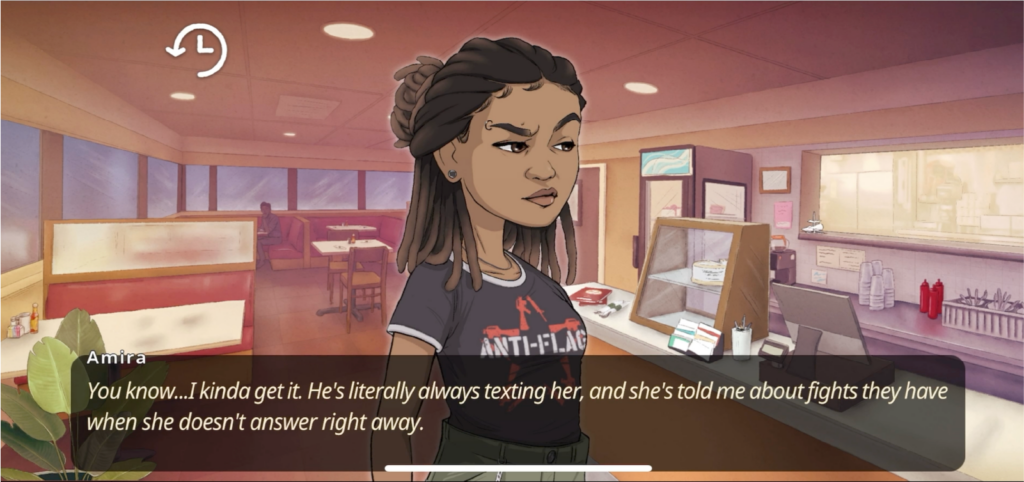
The game's mechanics assist players in navigating uneasy settings. Each of its interactive character stories helps sharpen the players' ability to listen actively, attend to conflict through productive communication, better understand restorative practices, recognize unhealthy behaviors, and uphold healthy ones.
Young people demand and deserve an ecosystem of care to do the social and emotional work that starts in early adolescence safely. Cadence Ford fits into that ecosystem by connecting them to this transformative social and emotional learning through play—a tool they're familiar with.
CO-DESIGNING STARTS WITH AND NOURISHES TEEN GENIUS
Beyond just using play as a lever for meaningful learning, the resonance of Cadence Ford is due mainly to its development alongside teens. iThrive's innovative co-design approach with young people was employed from the beginning to support us in folding in the wisdom of teens whose insights and feedback were integrated into the final play experience.
Everyone involved in the design and development of this game values the inquiry and imagination of young people. Teens and young adults in One Love and iThrive Games' networks were at the table from start to finish and developed their game design and social and emotional skills throughout the process.

Explore some of the activities that make up iThrive Games' Game Design Studio model here.
The Game Design Studio model at the heart of our co-design approach is a strengths-based one, and bringing it to the young people we co-created Cadence Ford with helped them uncover and share their thoughts. In co-design workshops, they shared perceptions on the importance of healthy relationships, defining what healthy and unhealthy signs of a relationship look like in their worlds and minds, and exploring with peers how to best navigate discomfort when it appears in the body and in peer relationships. Each of the co-designers and playtesters who lent their genius to Cadence Ford was compensated for their ingenuity as thought partners throughout this shared endeavor.
WHAT YOUNG PEOPLE SAY ABOUT CADENCE FORD
The play experience in Cadence Ford is yet another testament to the power of game-based learning. When young people who played the game for the first time were asked, "What did you learn about talking to friends in unhealthy relationships?" they shared responses that reflected their sharpened relationship skills and communication practices like "star[ing off small before jumping into the topic" and aiming to "understand their situation while encouraging healthy habits." Others shared that through the game, they "learned some new lines to help [themselves] and friends cope with relationship and friendship situations," "how to spot unhealthy behavior in a relationship," and "how to respond in situations where you see someone you know in these unhealthy relationships."
Like the many who have played the game and been a part of its making, we want Cadence Ford to assist young people in learning to be champions of healthy love and be with partners who practice it. "Yeardley's legacy of joy lives on in this game," shares Hopper. "At One Love, we work to change the statistics around relationship abuse one conversation at a time. With Cadence Ford, we're promoting that change one play session at a time."

Make It A Gameful School Year: Meeting Teens Where They Are With Play
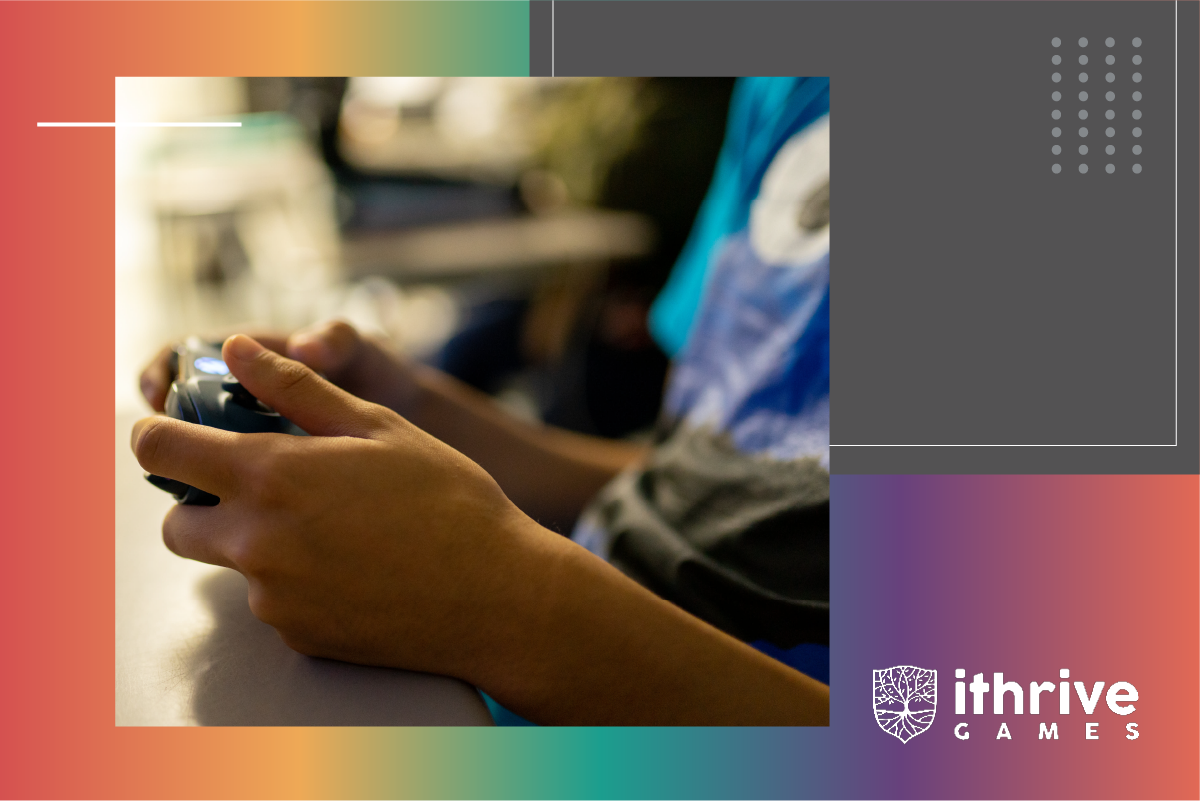
"I'm always going to enjoy a lesson where you can learn and have fun... It helps keep the students focused and even helps motivate them. I know I'm motivated to find out what happens next," shared a high school senior who, along with peers in his humanities class, was one of the first to gather around an Xbox One, play What Remains of Edith Finch, and meaningfully learn from it using our iThrive Curriculum unit, Museum of Me.
Games like What Remains of Edith Finch merge mechanics, worldbuilding, and challenges to deliver emotional and immersive experiences to all who play them. For the 85% of teens in the United States who play them (International Journal of Mental Health and Addiction), they are a solid and steady source of joy, connection, and entertainment.
At iThrive Games, we see the curiosity, embrace, and eagerness activated in teens by a never-before-seen start screen as a launchpad for social and emotional learning (SEL)—a transformative skill-building practice proven to protect and promote their mental health. Our team folds in what we know about the transcending and emotion-evoking power of games into a unique multidisciplinary, user-centered, and participatory approach that brings teens, researchers, game developers, and our adolescent development experts to the table to envision, create, and test tools that support teen thriving.
The games and game-based learning experiences we've co-designed alongside libraries, museums, schools, and youth-serving organizations we work with fully recruit the feelings conjured through play to create a wellness-supporting experience that centers teens' social and emotional needs. We use play to bring SEL to young people in a developmentally responsive way with games that invite them to uncover and nourish their strengths, craft and answer their own questions—activities that expand their understanding of themselves, others, and the world around them.
Beyond enthusiasts, we are ambassadors of play. Our team's first-hand witnessing of what games do (and can do) over the last five years has affirmed our belief in their unique capacity to support young people's thriving. We fully encourage educators, program coordinators, and all working with teens this school year to bring them into the spaces they share with them to see the power of play first-hand, too. Keep reading for resources, recommendations, and insights that support the integration of games in teen-serving settings and their use in teen-centered ways.
WHAT PLAY DOES (AND CAN DO) FOR TEENS
Play is beneficial for all of us, but for teens especially. Here are five things play does for young people, and can support, enable, and elevate when brought into the spaces where young people gather and learn:
Play activates deep learning and personal growth. Games present opportunities for teens to engage interactively and think expansively. Environmental storytelling coupled with mechanics that govern and guide the player's actions and the game's response to them give way to an experiential context where teens build knowledge while exercising personal agency—the conditions for deep, meaningful learning. "Games offer teens the ability to fully inhabit the world of a video game, to embody characters with agency along with the chance to impact the world and characters around them," shares Susan E. Rivers, PhD, iThrive's Executive Director & Chief Scientist. "They offer the agency and low-risk experimentation that teens rarely get but sorely need to discover who they want to be."
Play supports social and emotional development. Games make us feel. They delight us, challenge us, calm us, frustrate us, and excite us. They can prompt problem-solving, conflict resolution, and empathy, provoking opportunities that support teens' social and emotional learning. Social and emotional learning is defined by the Collaborative for Academic, Social, and Emotional Learning (CASEL) as "the process through which all young people and adults acquire and apply the knowledge, skills, and attitudes to develop healthy identities, manage emotions and achieve personal and collective goals, feel and show empathy for others, establish and maintain supportive relationships, and make responsible and caring decisions."
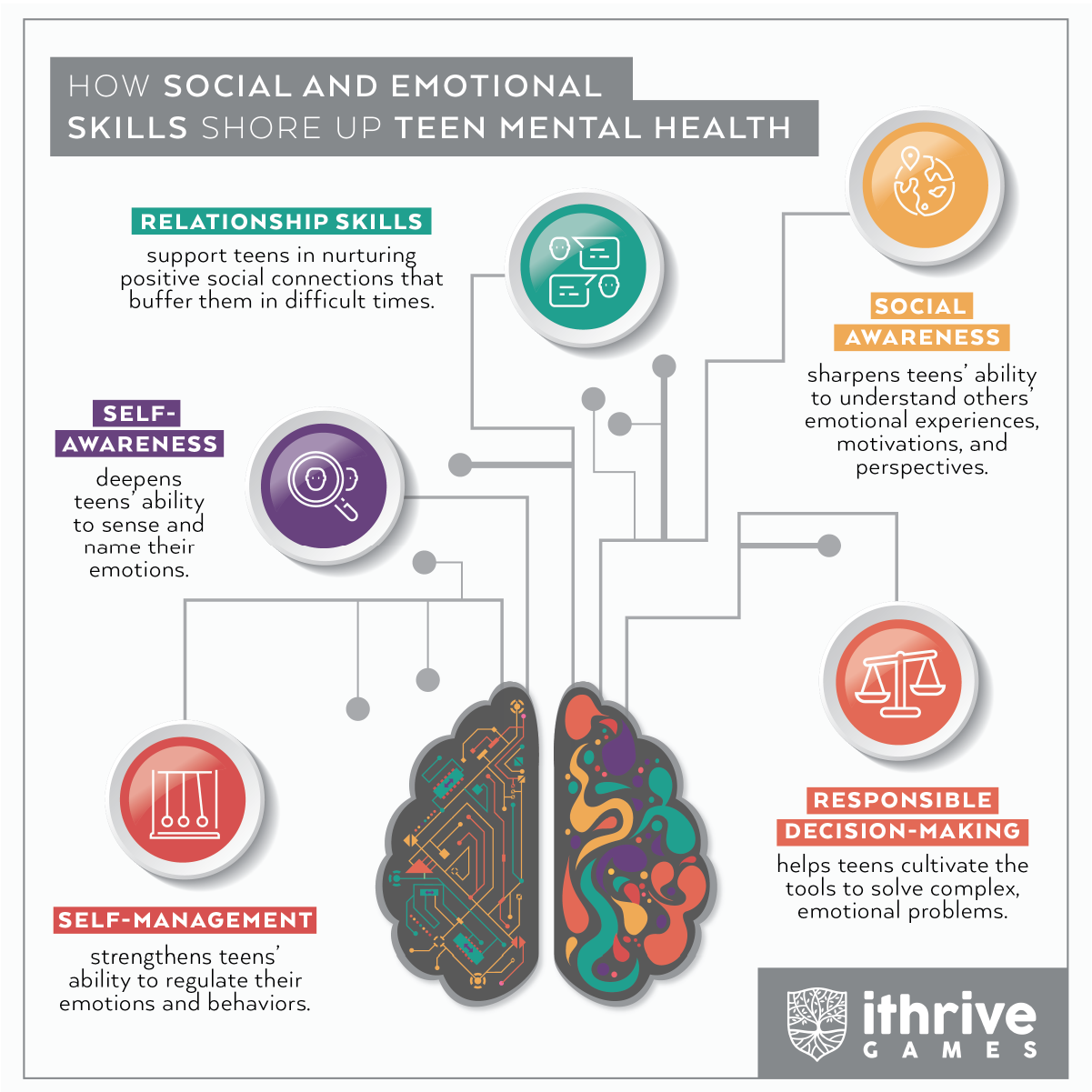
"How Social and Emotional Skills Shore Up Teen Mental Health." iThrive Games. https://tinyurl.com/what-sel-does-for-teens
Games provide a social space ripe with opportunities for young people to lean into these tasks, as well as developmental ones like identity exploration, establishing and exercising independence, and finding their place in community.
Play soothes. Games transport and immerse teens in new worlds, and with the space to interact as a new character and confront conquerable challenges comes the opportunity for stress reduction, self-gratification, and flow states. In countless co-design sessions with teens, we've heard that games are an outlet for relaxing and unwinding, providing a constructive space for coping, breaking for a bit, and pressing pause in challenging moments.
Play fosters connection. When teens play with peers, be it competition or collaboration, they socialize and connect, tasks paramount to their mental health. In the connective spaces games offer, teens can share their triumph and joy with others. They can work together toward a shared in-game goal and, sometimes, tackle the fallout of a shared loss in powerful bond-building experiences.
INTEGRATING PLAY WHEREVER TEENS LEARN AND GATHER
The work of adolescence has always been social and emotional, and young people need tools and strategies to help them navigate it. What games do for teens make them a useful means of support, and when enlisted by adults in their world as a medium of engagement, they are further solidified as valuable parts of young peoples' toolkits.
For all looking to leverage the power of play this school year while in community with teens, here are three ways to do so:
1. Pull in a game-based learning curriculum, or create your own.
Game-based learning supports educators in using the power of games to define and support their students' learning outcomes. When lesson plans leverage video games—an entry point familiar to most teens—they pave the way for a culturally responsive learning experience supportive of innovative thinking, deep learning, and in the case of our standards-aligned iThrive Curriculum units, A Moment in Time, Museum of Me, and Sam's Journey) that center themes relevant to teens like navigating identity exploration, relationships, and social media, their social and emotional development too. For educators who value accessibility also, game-based learning aligns with Universal Design for Learning principles. As a stark differentiation from traditional learning approaches, games help educators reach and engage teens with a practice that acknowledges that teens are vast and wonderful, engaging with concepts from different access points. Here's how to choose a video game for a high school humanities or English class and a case example of how iThrive Games does so.
2. Employ role-playing simulations to support a 'learn by doing' approach.
Role-playing simulations engage teens in a high-energy experience with hands-on learning as they are challenged to strategize and act. Multiplayer ones, particularly, invite them to interact and investigate with each other and pursue shared goals. The embodied learning accompanying the role-playing propels their curiosity and motivation to explore possibilities transferable to real-life contexts.
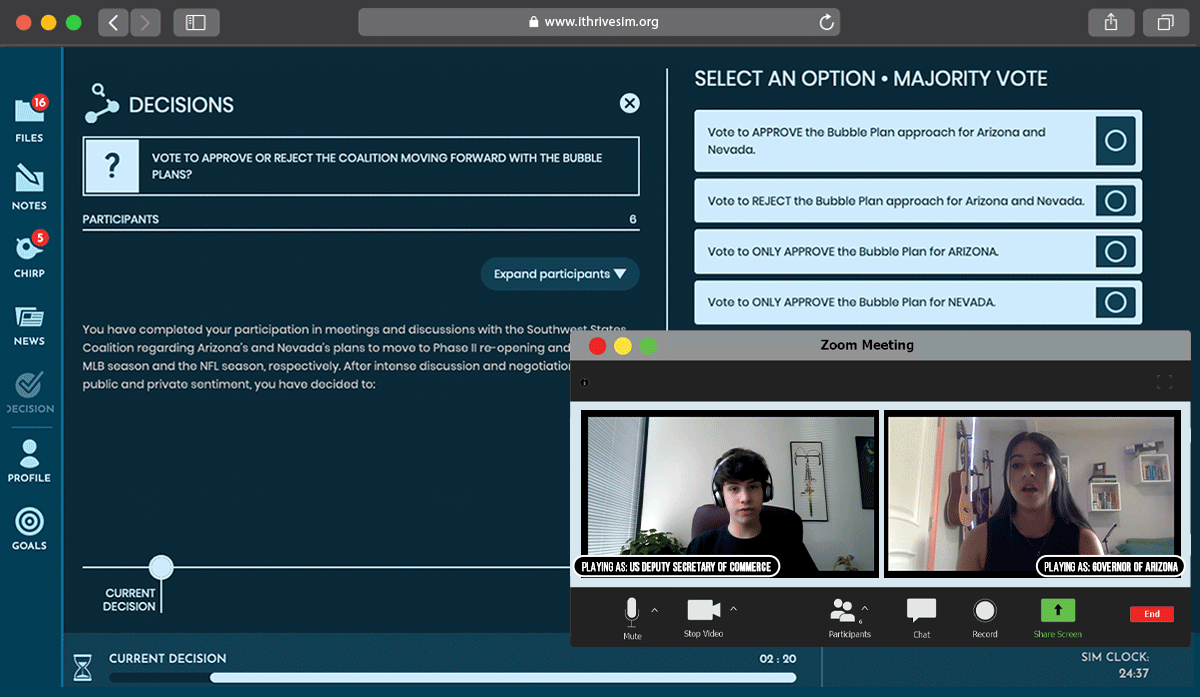
High school students playing iThrive Sim: Lives in Balance. See the gameplay in action here.
The simulations offered via iThrive Sim, our award-winning simulation platform that hosts dynamic role-playing games that scaffold educational content with social and emotional skill-building activities, encourage teens to learn by doing. Each one in our core civics library (Lives in Balance, Leading Through Crisis, and Follow the Facts) invites teens to play alongside their peers, prompts them to draw on their own experiences and their social and emotional skills while making decisions, demonstrate critical thinking, acquire and interpret information, and navigate challenges collaboratively. Dive into the social and emotional skill-building and civic learning that happens in each iThrive Sim game experience here.
3. Unleash teen creativity by inviting them to be game designers.
Why? As teens progress through adolescence and develop their capacity to reason thoughtfully and think critically, this three-letter question becomes all the more important and prominent in their lives. The cognitive growth teens undergo propels them to investigate the 'whys' that shape how they live and see their world. They move from thinking concretely and heavily relying on physical observations to thinking abstractly about possibilities. In this last major phase of development, where teens are primed to learn and adapt, curiosity becomes a growth point, and game design uniquely nurtures it in them. Our Game Design Studio Toolkit, developed in collaboration with EdTogether, sandbox games like Minecraft, and game-making tools like Roblox, provide teens with a springboard for unpacking complex challenges, investigating questions, and stepping fully into their creativity.
Games are unsurpassed in their ability to engage teens in physical and virtual worlds deeply. They offer teens a safe space to wander and wonder, exercise their innate curiosity, and build new understandings of themselves and each other. When used as a medium for engaging with young people in the spaces where they gather, they become more than entertainment—they become levers for social and emotional support.
How are you using play this school year? Let us know on Twitter by tweeting us @iThriveGames using the hashtag #GamesforThriving, and stay updated with our game-based resources and game design work, done with and for teens, by subscribing to our monthly newsletter.
iThrive Games Named a 2022-2023 Tools Competition Winner
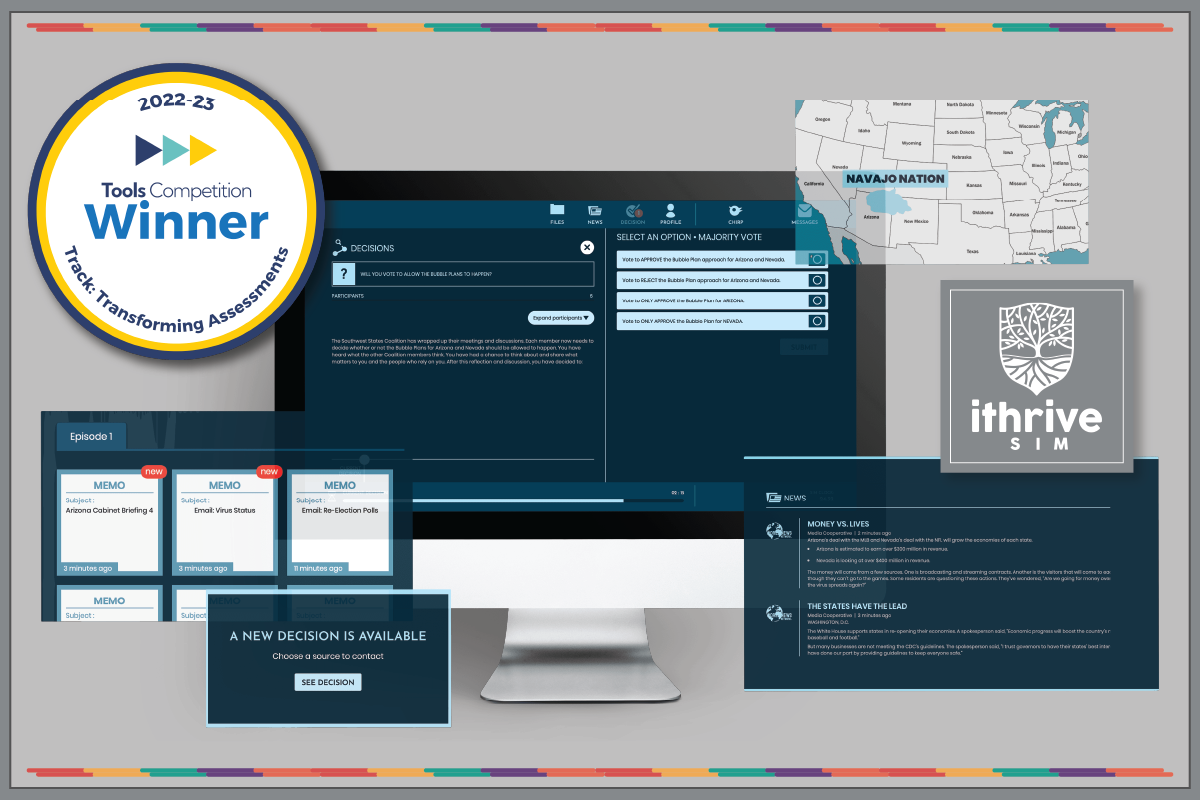
NEWTON, MA - Today, iThrive Games was named one of 32 winners of the 2022-2023 Tools Competition. The nonprofit, which leads the development of wellness-supporting games and interactive experiences designed with and for teens, joins teams from 12 countries being awarded more than $4 million to develop and expand tools that will impact 35 million learners by 2026.
As winners in the Transforming Assessments track and recipients of a Growth Phase award, iThrive Games will receive $100,000 to expand its proprietary simulation game engine, iThrive Sim, with new ways to measure and assess the teen social and emotional learning (SEL) happening on the platform through play.
iThrive Sim authors and delivers immersive and interactive simulation games for teens that translate into meaningful learning experiences in the spaces (in-person and online) where they gather. Since launching in 2020, the game engine, built with iThrive Games' software development partners Affordance Studio, has been cemented as an ed tech tool supportive of deep and enduring social and emotional learning, peer connection, and collaborative problem-solving, earning recognition for its innovative approach to learning and unique response to the educational needs of the COVID-19 classroom. Explore iThrive Sim's dynamic features here.
The Tools Competition win enables the iThrive Games team to build new data collection and assessment capabilities onto the iThrive Sim platform that will allow teens, educators, and teen-serving adults who facilitate games on the platform to measure and evaluate the social and emotional skill-building iThrive Sim games facilitate, expanding the game engine's responsiveness to a growing demand for holistic and experiential learning tools that support social and emotional needs as well as academic ones. Self-reported assessments and expanded monitoring of in-game behaviors will help teen players reflect and become aware of how they collaborate and respond to stress and connect them with tools to calibrate. With the expansion too,iThrive Sim game facilitators will be able to access individual and aggregate reports after each play experience, empowering them with valuable insights to support the planning of personalized SEL interventions.
"iThrive Sim embeds SEL opportunities to support and enliven teen-centered learning across so many topics, from civics education to counterterrorism, from game theory to emergency preparedness, and more," says Susan Rivers, Ph.D., iThrive Games' Executive Director and Chief Scientist. "This Tools Competition win enables our team to continue designing interactive experiences with and for teens on the iThrive Sim platform that are as fun as they are impactful, ones that not only amplify teens' strengths but also equip them with a play-driven way to measure and grow them."
As one of the largest edtech competitions in the world, awarding nearly $10 million to 80 ed tech innovators to date, the Tools Competition aims to grow the field of learning engineering by spurring ed tech innovations that leverage big data to support learning science research and the needs of learners worldwide. This year was its third cycle, generating more than 1,000 proposals from 73 countries.
The 32 winning teams from the 2022-203 cohort hail from institutions and organizations across North America, Europe, Asia, South America, the Middle East, and Africa, and it is an honor for iThrive Games to be among them. Recognized and supported through the Tools Competition, the win recognizes and supports each team in tackling solutions to improve students' K-12 math competency following the sharpest declines in decades, address equity in education, bolster students' problem-solving and emotional skills, and unlock career training opportunities for adults via virtual reality. The next cycle of the Tools Competition will launch on September 21, 2023. To learn more, sign up to attend the virtual competition launch event here.
"It's been an honor to take part in the Tools Competition this cycle and learn alongside other ed tech innovators who are bridging their expertise with others from different disciplines to craft solutions that accelerate learning and maximize our understanding of what works for young people's wellness and learning," shares Dr. Rivers and the iThrive Games team. "Our work as a nonprofit over the last five years has centered young people's learning and their social and emotional health. We're eager and excited to build on this mission and on what we know already to deliver even more transformative solutions powered by iThrive Sim and impactful play."
To stay updated with iThrive Games' impact-driven game development and experience design work as well as iThrive Sim's expansion, subscribe to iThrive's monthly newsletter here.
A full list of the 2022-2023 Learning Engineering Tools Competition winners and their projects can be found here.
CONTACT INFORMATION
Eghosa Asemota, Senior Director of Marketing and Communications, eghosa.asemota@ithrivegames.org
ABOUT ITHRIVE GAMES
iThrive Games Foundation is a 501(c)(3) nonprofit organization that leads the development of wellness-supporting games and tools, designed with and for teens. Our team of adolescent development experts builds on 30+ years of combined instructional and game design experience to create compelling and accessible experiences that nurture teens' genius by folding in social and emotional skill-building—a practice proven to nourish mental health and learning.
ABOUT THE LEARNING ENGINEERING TOOLS COMPETITION
The Tools Competition ran two funding opportunities this year: The Learning Engineering Tools Competition focused on Pre-K-12 learners and was supported by Schmidt Futures; Kenneth C. Griffin, Citadel, and Citadel Securities; the Walton Family Foundation; the Bill & Melinda Gates Foundation; and AlleyCorp. The DARPA AI Tools for Adult Learning opportunity is supported by the Defense Advanced Research Projects Agency (DARPA). The competition is administered by Georgia State University and The Learning Agency.
We Asked Gamers About Their Hard Days at Play NYC. Here’s What We Learned.
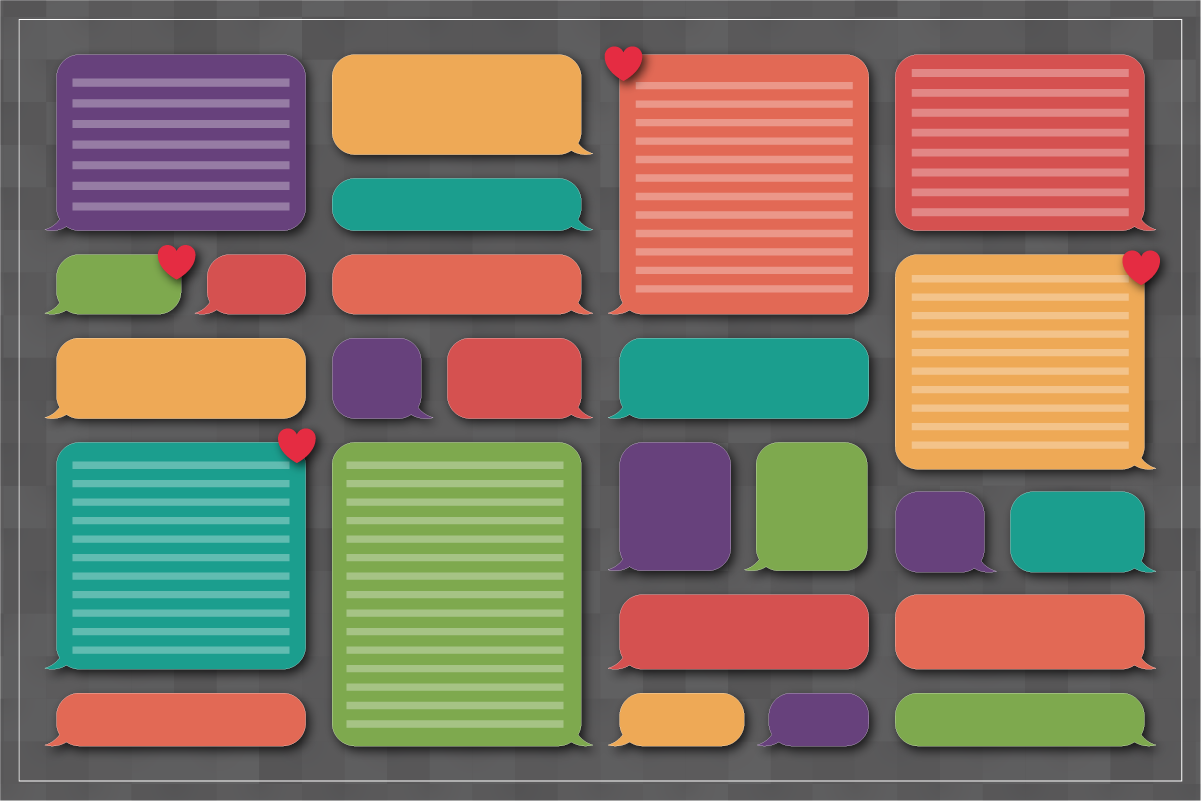
Our ability to feel is what makes us human. It is fundamental to who we are, underlying how we connect and the realities we co-create.
It supports our sense of self, helping us unpack our thoughts and reactions, build awareness of what's happening around us, and deepen our knowledge of ourselves in relation to the world we live in.
Games make us feel. They delight us, challenge us, calm us, frustrate us, connect us, and excite us. They're also uniquely captivating, not just in what they portray aesthetically and demand mechanically, but because of the state of embrace they insist on those who play them. Encountering a never seen start screen or the unopened box of a new tabletop game, we are ready, willing, and receptive to knowledge. Play's ability to get us to put our guard down, be curious, and engage with new possibilities helps create the conditions for transformation and meaningful learning.
Earlier this month, the iThrive team showcased at Playcrafting's Play NYC—an event that magnified the power of play and brought hundreds of game industry professionals, indie game developers, and game designers together to exhibit their games to players and peers. There, we shared Cadence, a single-player, text-based strategy game we created with the One Love Foundation and Playmatics, LLC. Cadence invites players to explore three of their friends' stories and converse with them via real-time dialogue choices that affect their friendships and outcomes. Building on One Love's mission to empower young people with the life-saving prevention education, tools, and resources they need to see the signs of healthy and unhealthy relationships, Cadence supports young people in learning to love better, in being with partners who practice healthy love, and communicating with loved ones who are in unhealthy relationships. While New Yorkers of all ages played a demo of the game and shared feedback, teens, many of whom went on to become members of our Teen Hub, were particularly moved by the game's storyline, mechanics, and captivating 2D art.
Beyond the valuable feedback we received on Cadence, slated for release later this year, the experience provided another opportunity for our team to create a forum for listening to and learning from young people. At PLAY NYC, we marked a large glass bowl with the question, "What makes you feel better on your hard days?", and teens and young adults anonymously shared the following:
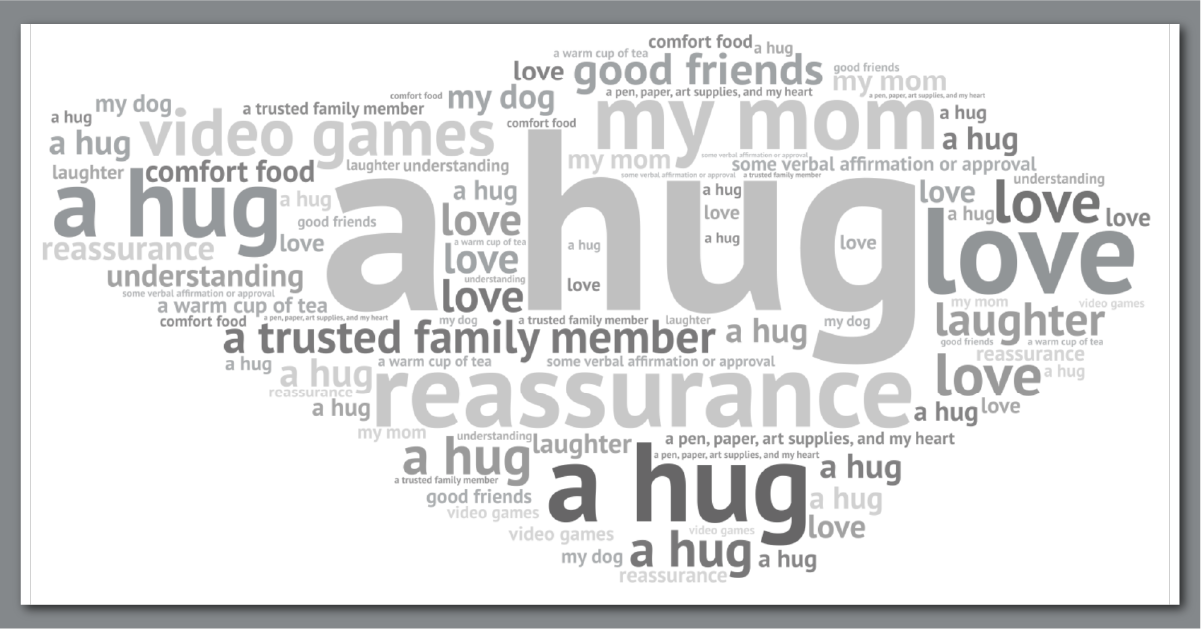
ARE WE LISTENING?
Tucked in each of these answers is a guidepost for innovation—caring, joy, connection, self-expression. Creating safe spaces where teens are heard and listened to with the intent to understand them has guided our game development and experience design work over the last five years, and empathic listening and design is what has made the impactful play experiences we've designed with and for teens possible. The needs echoed and desires illuminated in the responses we elicit from young people in the safe spaces our social and emotional learning experts create (in this case, a glass bowl, and lime green Post-it notes) are folded into the game concepts we envision with clients and collaborators
Empathic listening has long been a driver of breakthrough thinking. Being in community with teens and young adults has helped us think expansively and collaboratively. We've found that empathy, when practiced consistently, is essential to transformative change and central to the knowledge-building and knowledge-sharing that informs the design of meaningful solutions.
iThrive's co-design approach, which gives teens the tools to step into their genius and explore their needs, is care in action. Our approach creatively empowers young people with new ways to tap into their genius, share their experiences and wisdom with others, advocate for the support they deserve, and create with us the experiences they want to see.
With the Centers for Disease Control and Prevention (CDC) reporting that nearly half of U.S.-based high school students are experiencing persistent feelings of sadness and hopelessness, it is on all of us in the game design ecosystem to create the spaces, in person and digital, to listen and effectively gauge the thriving of end users. With over 90 percent of teens and young adults self-identifying as gamers, every game designer, developer, and writer has the tools to meet them where they are and equip them with valuable knowledge, tools, and support. It is on all of us always to ask, "Are we listening?"
ARE WE SUPPORTING?
The learning that comes from listening allows all designers and developers to respond constructively, and offer support in meaningful ways. Games are already socially and emotionally valuable, and when tailored to teens and young adults' strengths, developmental needs, and insights, they become vessels for further social and emotional support.
Our adolescent development experts work with and for young people, and in partnership with libraries, museums, government agencies, and organizations that care about them, fully recruit the feelings that play evokes to support teens' social and emotional health. The science of adolescence and evidence-based practices that support positive teen growth are folded into the games, game-based tools, and interactive learning experiences we create. Questions like "How does this enliven teens to practice healthy skills like exploring their identity, engaging with their community, and taking purposeful action in the world?"; "How does this invite teens to regularly notice emotions, helping them notice the thoughts, sensations, and behaviors that accompany their feelings?"; or "How does this normalize help-seeking?" steer the game development process we lead, ending in a play experience that nourishes young people in ways supportive of their wellness, learning, and thriving.
At Play NYC, we shared questions like these on a printout version of our 10 Things to Know When Designing for Teens resource, given to other game designers and developers eager to go beyond listening and to start responding and supporting young people's social and emotional needs. We're happy to now make that resource accessible to everyone and downloadable via the Resource Hub on our website.
Asking and listening helps us understand people and ideas. That insight and evidence-based practices nudge us toward wellness-supporting games and more impactful play experiences for young people. For the design team or studio looking to elevate the impact of the games they create for young audiences, connect with us today for a consulting report benchmarking your game in development against the science and sharing recommendations on ways to fold in social and emotional skill-building—a practice proven to protect and promote teen mental health.
Together, we can and should advance wellness wherever young people are. Join in.
Our Biggest Takeaways from the 2023 Games for Change Festival
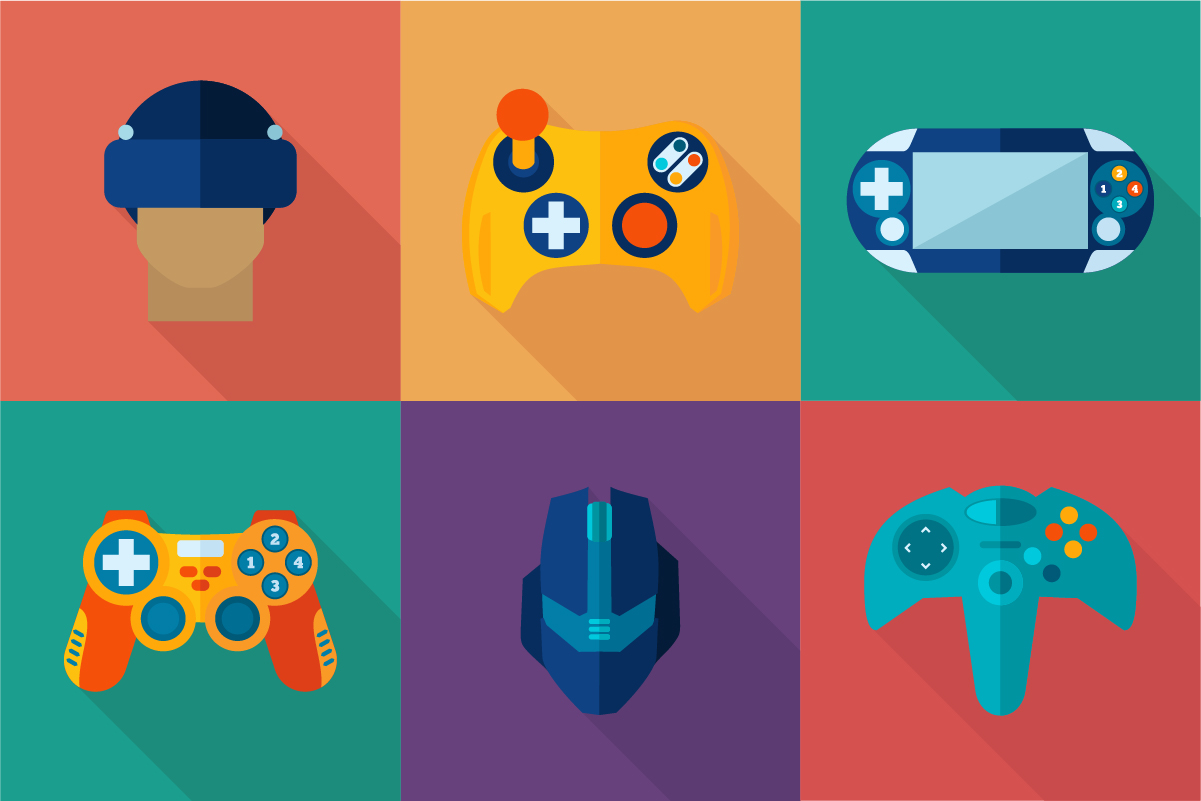
The 2023 Games for Change Festival marked the 20th anniversary of a cross-sector gathering of game developers, designers, journalists, writers, scientists, researchers, educators, changemakers, and more—all connected by their love of play and belief in its power to drive social change. Like its predecessors, this year's Festival continued its legacy of generating knowledge-building and knowledge-sharing, with talks that nudged us all to think expansively about our work and mindfully about our influence leveraging a medium played by millions of people.
Members of the iThrive Games team had the honor of attending both days of the 2023 Games for Change Festival in New York City, where we swapped stories, shared experiences, and made new connections. We had the honor of sitting in on sessions led by game design teams, funders, and nonprofit professionals that left us inspired, affirmed, and eager to join forces with others also designing transformative wellness and learning experiences powered by play. We collected many insights and possibilities relevant to our mission to design meaningfully with and for teens.
AFFINITY ELEVATES IMPACT, AND INTEGRITY IS BY DESIGN.
Impactful games and play experiences begin with intention. In a talk titled "How Our Values Impact Our Games' Cultural Influence," Kate Edwards, CEO of Geogrify and CXO/co-founder of SetJetters, explored games' cultural contribution, nudging listeners to remember that all content carries culture, all culture is a reflection of values, and the values we uphold and embrace consistently are what catalyze change. Her talk made clear that all of us in the game development space—from triple AAA studios to indie hubs—have a duty to think critically, iteratively, and unpretentiously about what is real and represented in the games we create, and how our values show up in them. If we pride ourselves on being impactful game designers who care about social change and inclusivity, it is on us to do the work to figure out how our games will be perceived by those they'll reach.
Jeffrey Burrell, Global Head of Social Impact at Riot Games, spoke on how the game design company has enlisted the 17 UN Sustainable Development Goals (SDGs) as a framework to inform and support their overall impact strategy. He also highlighted what happens when intentions are accompanied by a values-based approach and a commitment to understanding problems as framed by those most affected by them. Jeffrey implored us all to embrace an 'outside-in' approach that elevates what players care about rather than an 'inside-out' one that centers what designers think they care about. In pulling on the SDGs, as well as using in-game surveys to understand better the hopes and values of players residing in the 20+ regions Riot Games has a presence in, the company has been able to maximize their direct impact on those players' lives under the pillars of education, citizenship, opportunity, and sustainability.
It felt amazing to hear others affirm and share through their experiences how participatory approaches have animated and preserved the intentions of other game design teams and supported their impact. At iThrive Games, our co-design model with teens enlists their genius and perspectives in the exploratory research that begins before game development, throughout the design process, and during playtesting to ensure what we create with and for them and our clients and partners is truly impactful and wellness-supporting. Beyond just a value that lives statically on our website, our co-design model creates an affinity with young people, allowing us to reach and engage them better, effectively supporting their social and emotional development through play. We consistently use our co-design model to be in integrity with our mission as a teen-serving and impact-driven nonprofit.
RESTORATIVE AND TRANSFORMATIVE JUSTICE OFFER SOLUTIONS AND GUIDEPOSTS FOR ALL OF US.
A throughline across several talks, project briefs, and topic tables our team attended were transformative and restorative justice principles and practices increasingly being recruited and embodied by game industry professionals, researchers, and program coordinators earnestly committed to harm reduction and co-creating a better world, online and in real life.
Jae Lin's talk, "So You've Been Canceled. Now What?" began with the powerful words of Mariame Kaba, inviting us to explore how an apology can effectively communicate and capture both accountability for and acknowledgment of harm. Centering transformative justice, as Jae shared, supports us all in making space for multiple truths, separating guilt from shame, interrupting patterns of harm, and minimizing defensiveness. Their unpacking of an apology truly aligned with harm reduction supports us all in creating a culture of healing and restoration in the gaming and game-making communities we're a part of and beyond.
Restorative justice principles surfaced too in the "You've (Not) Been Warned: Content Warnings, Psychological Safety, the Audience, and You" project brief led by Take This's Community Director, Dr. Kelli Dunlap, as she covered the necessity of content warnings and the duty all interactive media designers have to provide them. Restorative justice heralds respect as an integral component because it enables a safe experience for all involved. Dr. Dunlap emphasized this point, stressing that psychological safety requires consideration for the player. "Trauma is not comfort," she shared. "And no one can grow while in survival mode."
Another resonant session iThrive members had the honor to join was led by Mishka Palacios De Caro, President of Fundav and coordinator of Demeter, a game-making education program administered in prisons in Argentina. In their heartfelt sharing of the program's goals as well as the stories and games that came of it, we were reminded of why restorative and transformative justice principles are needed in all places where we learn, play, and gather—to support a collective shift from a punitive mindset to an empathetic one that supports a safer, healthier world for everyone.
Generative magic comes from gathering with like-minded people, united by a shared commitment to social change and impact. All who participated in the two-day Games for Change Festival experienced this firsthand as they connected with others across sectors to start engineering new collaborative, playful solutions. Like them, the iThrive Games team looks forward to following up, learning more, working with, and gathering again with those we connected with at #G4C2023. Happy playing!
Co-Designing Wellness-Supporting Games with and for Teens
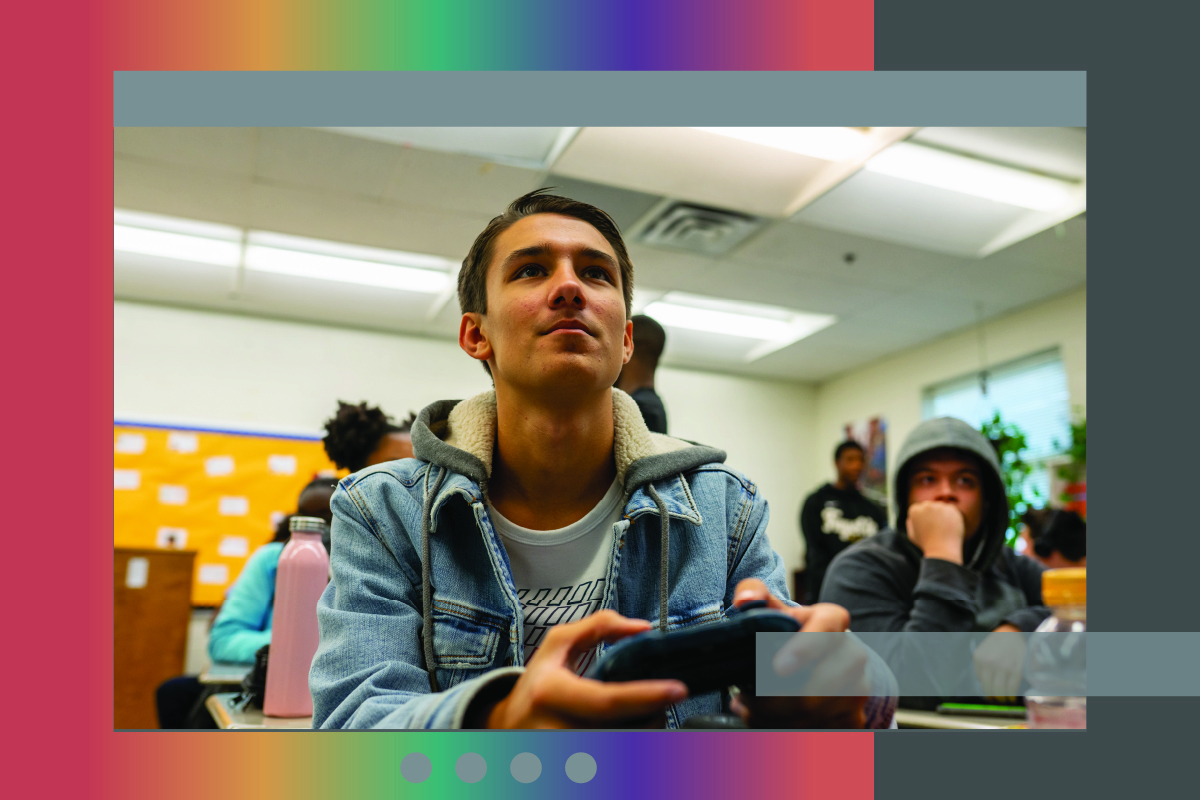
The work of adolescence is a social and emotional lift. Too often, adults in teens' worlds forget that, choosing to define young people by their vulnerabilities in an increasingly tumultuous world rather than by the magnificence they embody every single day to navigate it.
Doing teenhood in today's world is unparalleled to previous experiences. Mental health outcomes in young people have worsened with the prevalence of social media and the life-altering changes brought forth by the pandemic. In March 2022, the Centers for Disease Control and Prevention officially declared a youth mental health crisis.
There is a role that each of us in the game design world can play to help create and positively contribute to the ecosystem of support that teens need to live healthily and thrive.
Our 10 Things to Know When Designing for Teens resource, available exclusively to our Designing for Teen Thriving newsletter subscribers, shares insights and guiding questions crafted by iThrive's adolescent developmental experts that help designers center teens' strengths and vulnerabilities in the experiences they create for them.
What follows are two case examples that capture how iThrive's collaborative game design work has applied the resource's insights to create impactful play experiences. The science of adolescence paired with our unique co-design model have made each of the games highlighted here a springboard for social and emotional skill-building, connection, and exploration.
ITHRIVE GAMES' CO-DESIGN MODEL
Teens demand our care and commitment. At iThrive Games, our co-design model with teens is care in action. The model, devised by teen mental health and learning experts, equips teens with cognitive and creative tools that help them step into their genius. By centering teen magnificence with its strengths-based approach, iThrive's co-design model sets the scene for teens to feel safe to share their thoughts and experiences, heard about the issues they care about, and challenged to think through solutions with their peers and subject matter experts. It revolutionizes standard focus group setups and UX research strategies with immersive, hands-on activities, creating a supportive, teen-centered context for discovery. As a core part of the collaborative design approach we bring to our clients and partners, iThrive's co-design model is a throughline in these case examples.
CASE EXAMPLE #1: DISASTER MIND
![]()
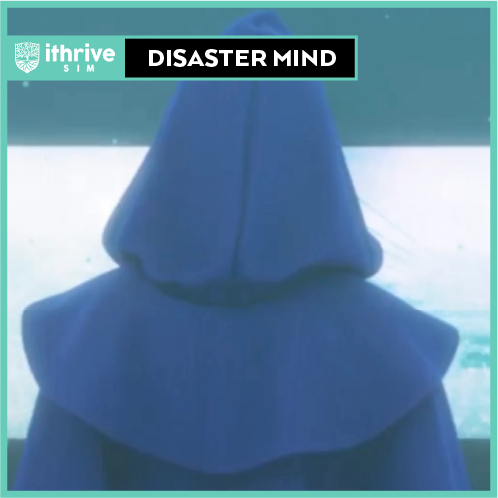 |
 |
Severe weather events over the last few years prompted the Federal Emergency Management Agency (FEMA) to explore new ways to prepare communities in times of crisis. In late 2021, FEMA reached out to iThrive Games, fully understanding that young people would be integral to their efforts. As positive influencers, teens are uniquely capable of bringing the message of disaster preparedness to friends, families, and communities. Disaster Mind, a single-player web-based game launching later this year, equips teens with vital emergency management skills and knowledge, training and activating them to be prepared for natural disasters.
Last year, the United States experienced 18 natural disasters, including winter storms, cold waves, heat waves, floods, droughts, tornado outbreaks, and three tropical cyclones. The intensity and frequency of these incidents firmly establish it as a stressor in the lives of teens, especially the ones living in areas more vulnerable to natural disasters. Disaster Mind offers teens an immersive, readiness and resilience-building experience that will help them develop and practice skills to respond to the need for ways to cope with and navigate natural disasters.
To create a Disaster Mind we drew on our evidence-based 10 Things to Know When Designing for Teens design principles. One insight is that teens are still learning to control impulses and emotions. With connections still developing in their prefrontal cortexes, it is relatively more challenging for most teens to gauge the consequences of their actions than it is for most adults. Another is that teens are also facing a lot of stress during their adolescent years and need flexible ways to cope and navigate the stressors they contend with in their daily lives.
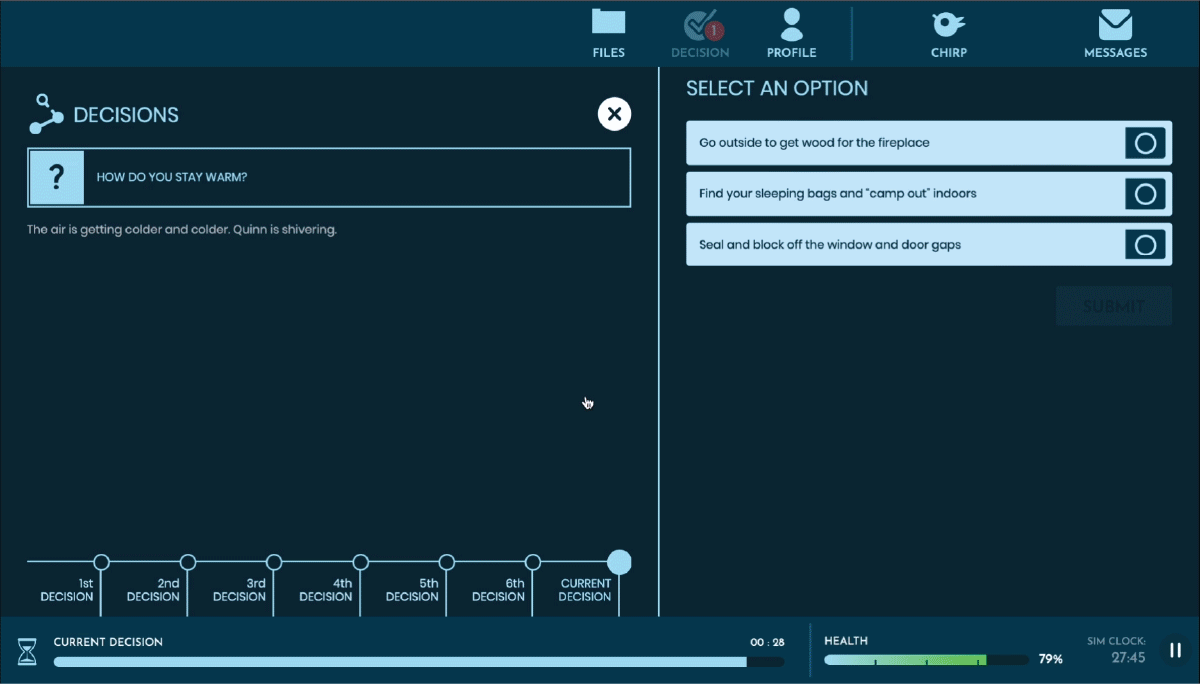
Hosted on iThrive Sim, a platform that authors and hosts playful, social, and emotional learning experiences, the game's storyline and mechanics work together to help players notice the connections between their emotions, thoughts, sensations, and behaviors as they make decisions while immersed in a crisis. With each decision impacting how the game unfolds, teens also practice responsible-decision making and self-management.
True to our co-design model, Disaster Mind was created with emergency management experts at FEMA Region VIII, which serves 29 Tribal Nations, Colorado, Montana, North Dakota, South Dakota, Utah, and Wyoming, and teens from those states who each helped inform the game's learning outcomes and story elements. Their wisdom and contributions highlighted a deep concern for their pets, a wishful desire for coordinated plans, and a need for strategies that combat feelings of loneliness and helplessness. These insights and wisdom were folded into Disaster Mind to ensure it reflects how teens frame challenges. By doing so and tactfully responding to teens' developmental needs, Disaster Mind delivers a resonant, teen-centered play experience that helps all who play it understand that stress management skills, the right mindset, preparation, and essential conversations with family and community members can prevent an emergency from becoming a full-blown catastrophe. "An engaging simulation is a fantastic tool for laying down the mental pathways we need to activate in times of crisis," shares Daniel Nyquist and Stephanie Poore from FEMA Region VIII. "That's why we are thrilled to be designing a disaster preparedness simulation with the iThrive team. iThrive's unique co-design approach is illuminating how to mobilize young people's creativity and distinct strengths in service of building mindsets and skills needed for resiliency across disaster preparedness, response, and recovery."
CASE EXAMPLE #2: CADENCE
![]()
 |
 |
One in every three young people will have an unhealthy relationship before they become adults. Interpersonal violence remains the third leading cause of adolescent death, contributing to one in every five teen suicides. Founded to honor the life of Yeardley Love, a daughter, friend, and student-athlete whose life was tragically cut short by an ex-boyfriend weeks shy of graduating from college, the One Love Foundation has worked to bring life-saving prevention education to young people over the last thirteen years. In 2022, they approached iThrive Games, seeking to amplify their educational programming with a new medium—a game. From the clear need for more accessible, awareness-building, and preventive interventions to support teens in living full, safe, and healthy lives comes Cadence, a text-based strategy video game launching later this year. The goal of Cadence is to equip all teens who play it with the know-how and skills to have and advocate for healthy relationships.
Our evidence-based 10 Things to Know When Designing for Teens resource guided our creative design choices for Cadence. Teens are working hard to figure out who they are in their adolescent years. To do this self-work productively, they need social spaces to interact, experiment, negotiate, and resolve conflicts safely. Teens also need access to experiences, environments, and relationships that help them grow positively. Cadence, produced by iThrive Games and developed with Playmatics, LLC, responds to these needs by providing a playful, low-risk, and low-stake space where teens can engage in self-work and practice relationship skills.
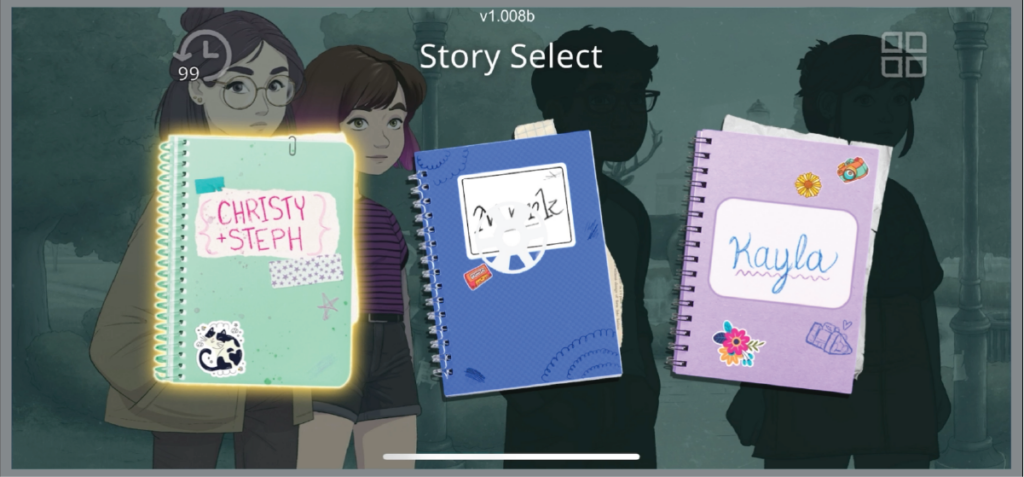
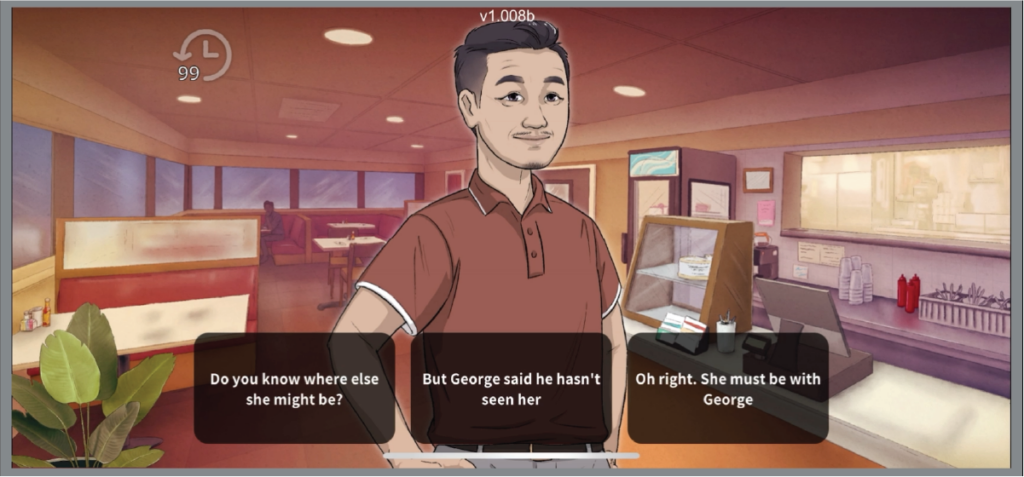
Screenshots from Cadence (beta), currently being play tested by iThrive's teen advisory members and teens in One Love's network.
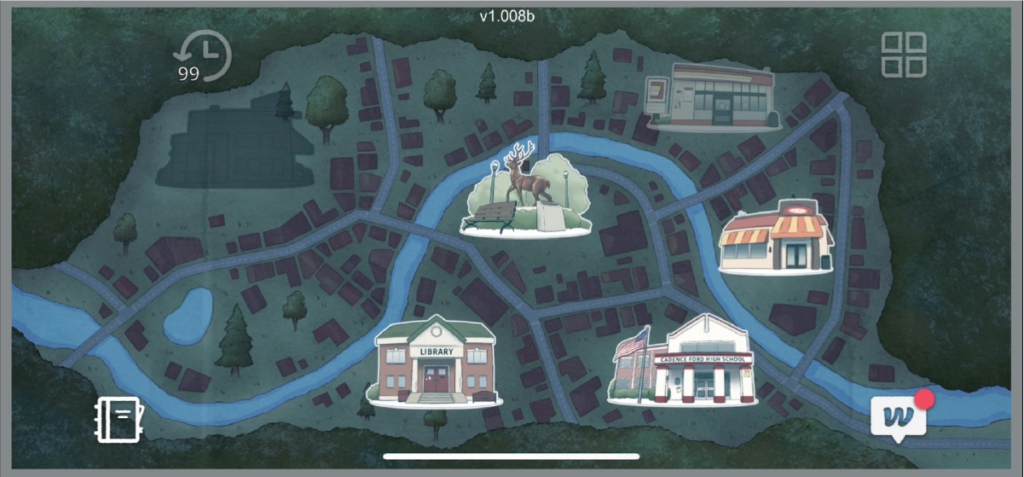
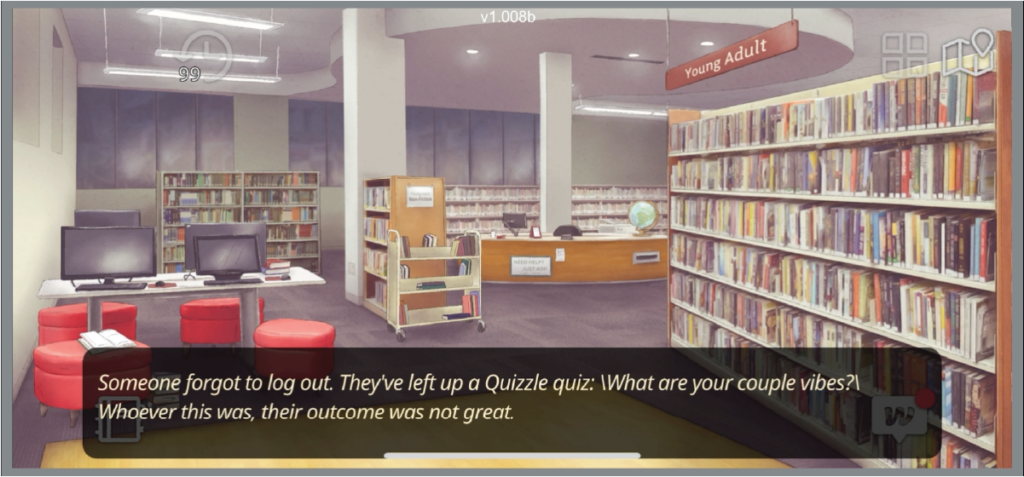
The single-player game invites teens to go back in time and explore critical events in three of their friends' lives. While interacting with each story, players must notice details of their friends' lives and figure out how to talk with them about uncomfortable issues. Meaningful gameplay fosters meaningful learning as teens practice having difficult conversations and familiarize themselves with unhealthy behaviors that may surface in relationships.
As a direct-to-teen experience, the development of Cadence began with iThrive's co-design model, allowing our design team to fold teen wisdom into the playful experience. The co-design process began with group discussions where teens in One Love's network and ours shared their perceptions on the importance of healthy relationships, defined what healthy and unhealthy signs of a relationship look like in their worlds and minds, and explored how they navigate discomfort in the body and in their peer relationships. Ultimately, their insights and ideas along with the science of adolescence,makes Cadence a wellness-supporting experience for players. "Cadence provides a low-stakes space for players to practice supporting a friend navigating an unhealthy relationship while providing the player with life-saving prevention education for themselves as well," shares Megan Shackleton, Chief Program Officer at One Love. "iThrive's co-design model was vital to making this game truly teen-centered - everything from ensuring the interpersonal challenges in the game were reflective of their worlds to the game dynamics being engaging and fun. From iThrive's careful partnership with youth comes a relatable and impactful play experience we're excited to share with the world."
A CALL TO ACTION FOR ALL GAME AND EXPERIENCE DESIGNERS
With 90% of teens self-identifying as gamers, games are an unparalleled lever for accessing and
supporting young people at a critical time in their development. With this access comes the opportunity to empower them with real-world applicable knowledge and opportunities to strengthen and practice social and emotional skills vital to protecting and promoting their mental health.
At iThrive, we're committed to taking part in the knowledge-building and knowledge-sharing that add to the ecosystem of affirmation, love, and support all young people deserve. As we work alongside teens with our clients and partners, we continue to build, share, and co-design our way toward a world where every teen is valued, proactively challenged, and cared for. We're reminded that in synergy, there is impact, and in this shared commitment to teen thriving, there is progress and a horizon full of teen wellness-supporting possibilities to explore.
Our team is eager to support your experience design needs. Share more about your project with us today.
The Social and Emotional Learning Opportunities in Video Games

The Last of Us. Elden Ring. Oregon Trail. Pokemon.
Though these popular video games vary in genre and generation, they share a throughline of social and emotional skills.
Video games, often microcosms of the real world, mirror daily stressors, challenges, and relationship dynamics. They also reference the emotional tools we lean on to navigate them. The ideas and questions that surface while playing video games, reflected in their characters, plots, elements, and mechanics, provide us with springboards to try on and construct new understandings of self, others, and the world around us. As one teen author shared in our Power of Play series, "Gaming is not just a simple time waster...It has the power to connect and teach people like no other media can."
Immersive and interactive by nature, video games are unparalleled in their potential to help all who play them reflect on, practice, and familiarize themselves with the skills, attitudes, behaviors, and values that support wellness and thriving. Their social and emotional value makes them powerful levers for social and emotional learning.
What Social and Emotional Skill-Building Play Does for Teen Wellness
Play is a bolster to wellness for all of us, but for teens especially.
The work of adolescence has always been social and emotional. Young people need tools and strategies to help them navigate it. Gameplay offers a way to meet them where they are and offers transformative and fun experiences.
At iThrive Games, we fold what we know about the transcending and emotion-evoking power of games into a unique multidisciplinary, user-centered, and participatory approach that brings teens, scientists, game developers, and adolescent development experts to the table to envision, create, and test tools that support teen thriving. With over 90% of teens playing video games, we put forth play as a lever for deep learning to the libraries, museums, schools, and youth-serving organizations we work with.
Games are unsurpassed in their ability to deeply engage teens in physical and virtual worlds to support their social and emotional development. They offer teens a safe space to wander and wonder, exercise their innate curiosity, and build new understandings of themselves and each other. The game-based tools and experiences we've created with partners and clients invite teens to practice how to disagree constructively, how to critically evaluate media messages, and how to manage stress. Performing these activities, tasks, and challenges, teens explore and experiment, sharpening the essential social and emotional skills that protect their mental health and support their wellness.
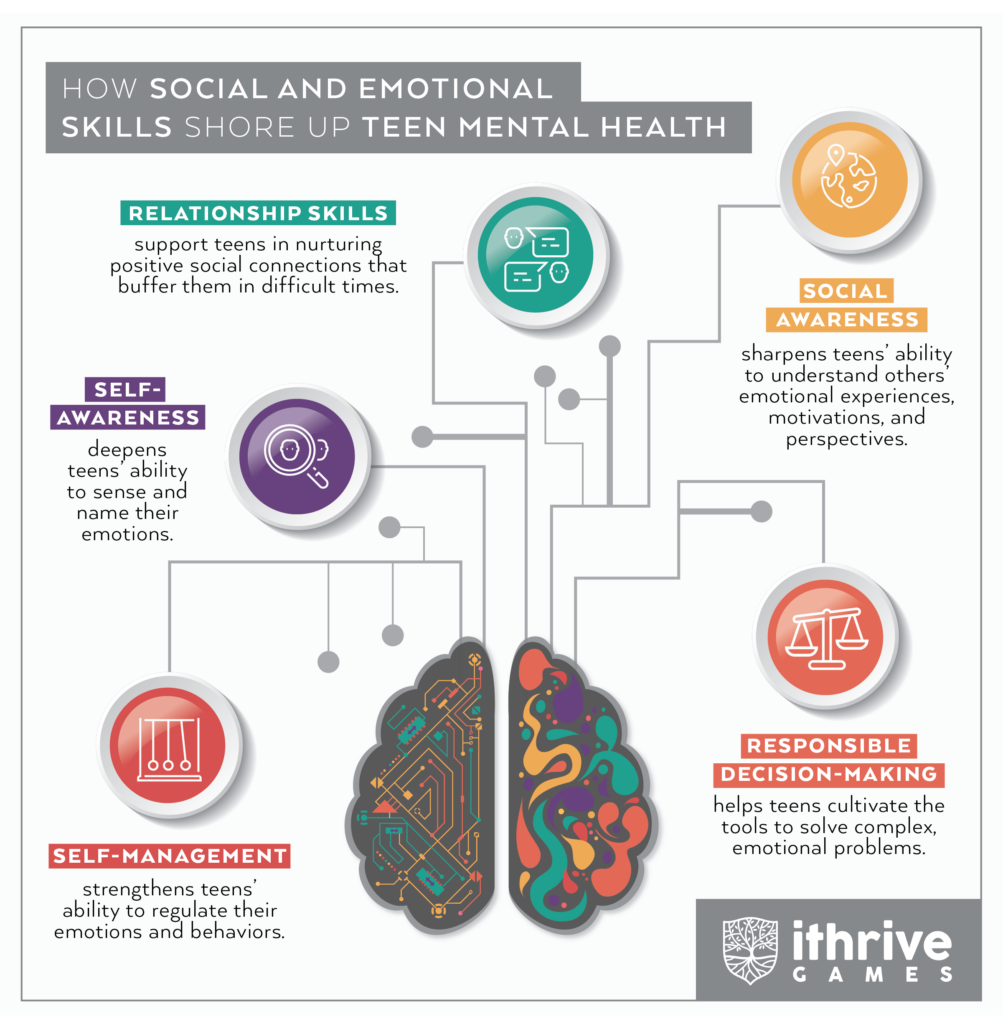
Download iThrive Games' How Social and Emotional Skills Shore Up Teen Mental Health infographic here.
A Look at the SEL Springboards in Your Favorite Video Games
Countless video games support players' social and emotional learning, presenting them with tasks, storylines, and challenges that reference or enlist the use of core social and emotional skills. Here's a look at a few:
- Self-Awareness in games can look like players self-selecting based on characters' strengths and weaknesses (Super Smash Bros. Ultimate), adopting a growth mindset (Minecraft), or them developing resilience to feedback (Super Meat Boy).
- Social Awareness in games can look like players empathizing with characters (That Dragon, Cancer), engaging from multiple perspectives (NieR:Automata, Octopath Traveler), or reflecting on how decisions impact other players or characters (This War of Mine).
- Relationship Skills are practiced in cooperative play experiences (Fortnite, Destiny 2) and can entail negotiating, problem-solving, and collaborating with others.
- Responsible Decision-Making in games can look like players weighing and watching the consequences of their choices to inform future ones (The Wolf Among Us) or trying different approaches and assessing results (Mass Effect).
- Self-Management presents itself in all games that invite players to persist through difficulty, prompting the feeling and managing of emotions like pride, frustration, gratitude, betrayal, guilt, forgiveness, complicity, and triumph.
Designing for teen thriving has led us to develop social and emotional skill-building games that deeply engage and connect young people in civics, media literacy, and current events. Our game guides offer tips for mental health practitioners who want to leverage games to connect with their teen clients. Our game-based curriculum units help teachers to transform learning in their high school English classrooms. These offerings are inspired by the wondrous magic of play and the potential games have in accelerating progress where all of us, young people especially, have the tools to thrive socially, emotionally, and cognitively.
Join our mailing list here to learn more about our work designing for teen thriving.
Fugees Family, iThrive Launch ‘Our Threads’, A Connection-Building Card Game
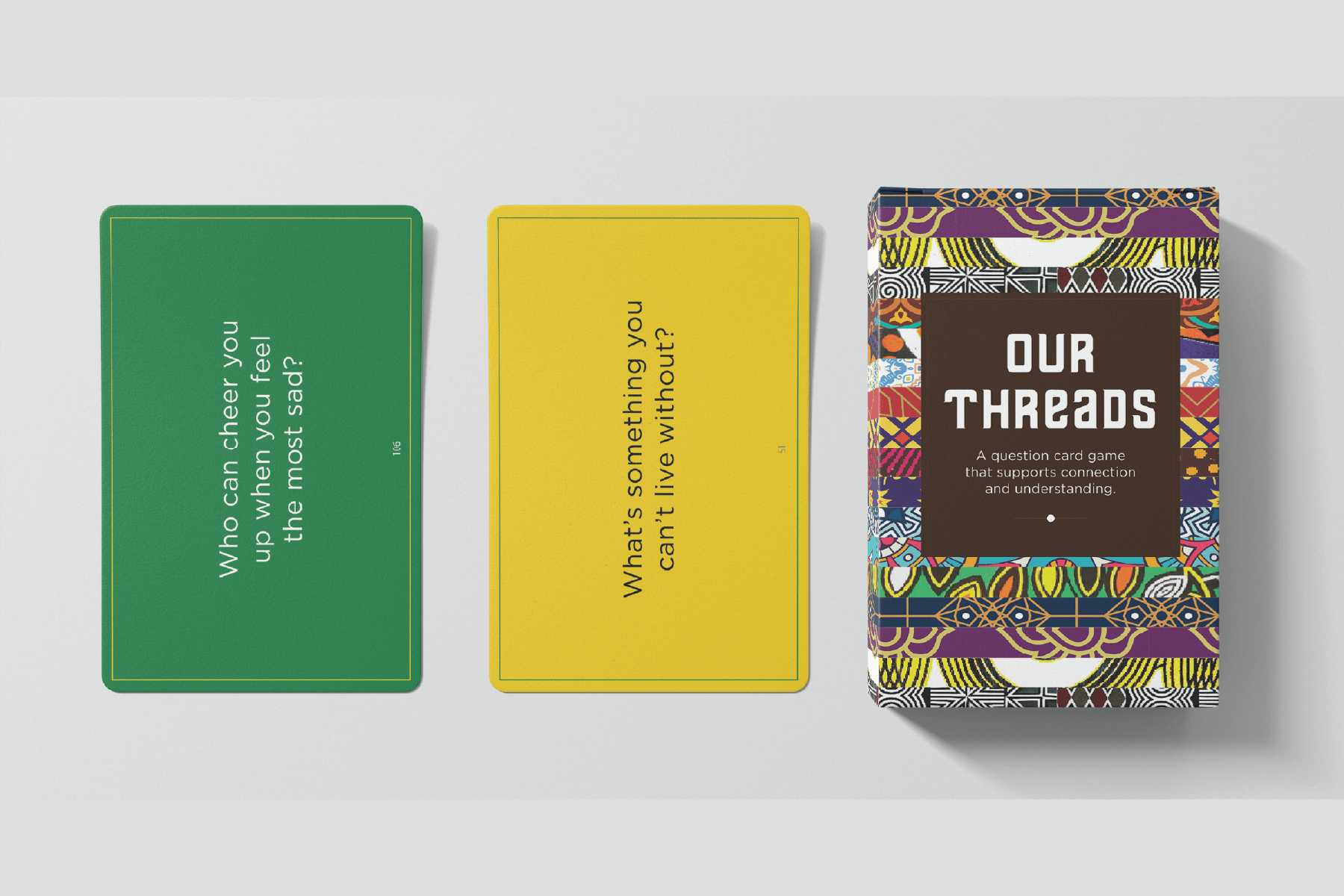
BOSTON—Earlier this month, the Fugees Family in partnership with iThrive Games launched Our Threads, a question card game envisioned and created to help set the scene for empathy, connection, and curiosity in schools, especially between refugee and non-refugee students.
Our Threads was sparked by a question posed to 22 Fugees Academy high school students at an iThrive Studio: "What do you want teachers and other students to know, feel, say, and do when they connect with students who are new to this country and to their school?" After two days of stories, knowledge-sharing, collaborative thinking, and play, answers to this question began to take shape in games that highlighted a universal desire for empathy and tools to help facilitate it.
"Empathy is essential to the world we all want to live in," shares Luma Mufleh, founder of the Fugees Family, which works to advance educational justice for refugee and immigrant youth by reimagining schools and retraining teachers. The Fugees team is also steering meaningful work to support the 60,000 estimated Afghan refugees resettling in the United States. "At Fugees Family, we lead with empathy. Our hope is that Our Threads helps spread the message and model that so much of what we seek to address and redress in the world is uncovered in community and while in connection to one another. It all begins with listening to and understanding each other."
In the generative space that was iThrive Studio: Fugees, students, reflecting on their stories, jotted down hundreds of connection-building questions that would be useful to anyone tasked with welcoming new students into a school community. After brainstorming questions, swapping decks, and iteratively testing them in groups, students decided which questions to keep. The iThrive Studio experience and the creations that came of it demonstrate the unique avenue game design provides to young people. It supports them in exercising their creativity, thinking analytically, and contributing meaningfully toward creating the world they want to live in.
"The beauty of Our Threads and the intent behind the game mirrors the magnificence of its young designers," says Susan Rivers, Executive Director and Chief Scientist at iThrive Games, a nonprofit that uses games and game design to support teens' social and emotional development, wellness, and thriving. "Whenever young people are given the reins to imagine freely along with the tools to delve deep into issues affecting them and their communities, we're reminded of why co-creation with them is vital to all that seeks to be sustainable. No one can take on a design challenge the way the young mind can."
For over 16 years, the Fugees Family has effectively used soccer as a tool for supporting students resettling in towns and cities across the U.S. in feeling understood, welcomed, and cared for. Our Threads, with its thoughtful mix of 108 light and thought-provoking questions and ornate, patterned covers representative of the 22 countries Fugees students hail from, builds on the same model - one in which play becomes a lever for care, compassion, and connection.
Our Threads ($34.99) is available now for anyone to purchase and is guaranteed to make a wonderful gift and addition to any holiday festivity. Purchase it exclusively on The Game Crafter website here.
iThrive Sim: What Embodied Play Ignited in a HS Social Studies Class

Play—like the learning and connection it fosters—is transformative.
To psychologist Peter Gray, Ph.D., play is an imaginative and active pursuit where the means are valued more than the ends. At iThrive Games, we know its power and use it to engage teens in their genius and meet their unique developmental needs, like identity exploration, social engagement, creative expression, and novelty.
A recent Nature article written by researchers from the UCLA Center for the Developing Adolescent affirms what we've known from being in community with teens over the last five years: experiences matter. The data shows that as the teen brain develops, nurturing it with opportunities for young people to explore, make meaning, connect, and discover purpose fosters mental health and reduces the likelihood of a crisis. The interactive, embodied learning experiences we create with and for teens expertly embed these wellness-supporting opportunities, enlisting the body, mind, and emotion-evoking power of play to build social and emotional skills vital to teen thriving.
The experiences our iThrive Sim role-playing simulation games have created in classrooms across the nation are testaments to what embodied play can and continues to do for young people. Using online play and tech—two mediums teens know well—standards-aligned civic learning is fully integrated with interactive opportunities for self-regulation, peer connection, and real-world applications. Since iThrive Sim launched, over 2,500 middle and high school students have played a game on the platform, where they have had the chance to compromise, negotiate, and collaborate meaningfully with peers in real-time to work through complex crises and 'wicked' challenges. Middle and high school educators who have brought iThrive Sim into their classrooms and facilitated one or more of its tech-supported games have remarked on how the experience enriched their classroom with a new way of learning and connecting.
Below, high school social studies educator Anthony Maida from the Methacton School District in Philadelphia, PA, shares his experience bringing iThrive Sim: Follow the Facts to his classroom and witnessing firsthand transformative learning in his students.
Q: What is your philosophy on teaching and how does iThrive Sim: Follow the Facts fit into it?
A: I guess I'd sum up my philosophy of teaching by saying that this job isn't really academic. Much like parenting, teaching seems much more like a relational pursuit than an academic one, so building good relationships with kids is the most important step in the educational process for me. With that, I'm trying to create experiences and opportunities in my classroom that move away from the transactional relationships that students and teachers often have with one another and more toward the transformational experiences necessary to show true student growth. This is where iThrive and Follow the Facts stand out to me. I've watched 17- and 18-year-old students who might otherwise be disengaged in their own learning step up and take an active role. I'm seeing kids with their own challenges really engrossed in what they're experiencing.
Q: What does social and emotional learning (SEL) mean to you, and how has iThrive Sim: Follow the Facts supported it in your classroom?
A: When I hear social and emotional learning (SEL), my mind immediately goes to building and fostering empathy in students. More than any content I teach, I'm hoping that kids walk out of high school in their senior years a little more willing and able to understand what their peers might be experiencing. While running Follow the Facts, I can see students interact with peers they may have never spoken to or even considered in their previous 12 years of school together. The content on the platform is so engaging that it brings together a group of students with really diverse backgrounds and experiences, and they all work toward a common goal.
Q: What shifts or moments during the play experience stood out to you?
A: When my classes are going through Follow the Facts, I am listening and watching as they have conversations with one another surrounding the issues presented in the Sim, such as keeping people safe or being honest in their reporting. It is no secret that many students are coming to schools today experiencing anxiety around a whole host of issues, especially in the wake of the pandemic. The most rewarding part of the experience for me was seeing students who may experience some level of anxiety in every other interaction during their day come out of their shells and totally engage with their peers in a way that might not otherwise have been possible. Students who might have struggled to find their voice in a large class suddenly spoke up, advocating for a position in our class simulation. I think that gets to the transformational part of education.
Learn more about iThrive Sim and register to bring iThrive Sim: Follow the Facts and our other tech-supported simulation games to your classroom.
Supporting a Friend in an Unhealthy Relationship Takes Courage. Teens Say That Takes Practice.

Adolescence is a time of rapid social development. The bonds teens make during this time play a crucial role in helping them begin to establish independence from family and make their way into the wider world. Healthy peer relationships are a reliable support for teens as they navigate and cope with the wonders and challenges that come with growing into young adulthood. Unhealthy relationships, on the other hand, can gnaw at self and safety and may have life-altering consequences.
Social and emotional skills are the building blocks of healthy relationships. Far from 'soft,' they are essential. At iThrive Games, we use play to build these crucial skills in teens to support their thriving as individuals, members of their communities, and members of the world at large. Our social and emotional learning games and tech tools nurture empathy and curiosity in young people while strengthening their ability to name and understand their emotions, and recognize and reduce unhealthy behaviors.
We are excited to continue our work supporting emotional resilience in teens with a new collaboration with One Love, a foundation working toward a world of healthier relationships by educating and empowering young people to bring life-changing relationship education to their communities.
One Love shares immersive content as part of its work to empower young people with the tools to identify unhealthy relationship behaviors. Unhealthy Connections is their latest public service announcement (PSA) campaign spotlighting unhealthy digital communication.
One Love is creating a game that builds on its mission of connecting young people to life-saving prevention education, empowering all who play it with the know-how and skills to have and advocate for healthy relationships. iThrive is supporting the design process with positive youth development insights that make the game a meaningful opportunity for teens to build social and emotional skills.
"Meeting teens where they are means meeting them in the digital spaces they spend time in and with the tools they are familiar with," shares Jane Lee, iThrive's Senior Director of Operations and Mental Health. "The game One Love is creating builds on what we already know about play and its unique ability to inspire young people to try on new ways of being and doing. The goal is to support One Love in creating something teens can take into their communities and use in their own personal lives."
Both iThrive and One Love center young people's genius and rely on their strengths, creativity, and influence to create tools with a wide-reaching impact. We're co-designing with teens to build nuanced understandings of how they view the work of helping a friend navigate an unhealthy relationship. Asked how they would define care and support in this circumstance, here are some the insights teens shared:
-
Care and support start with building knowledge and sharing resources. In our co-design sessions, teens who knew the 10 Signs of Unhealthy Relationships and completed a One Love workshop rated their confidence and responsibility to help a friend much higher than those who had not. "We know the signs and have the ability to help." "We all have a responsibility to do something when we see something wrong, especially for those of us who have the resources and the information." Strengthening teens' ability to recognize unhealthy relationship behaviors empowers them to intervene when they surface.
-
Being curious is a critical part of care and support. Teens shared that their genuine care for friends helps them gauge changes in their friends' emotional states and moods. "You want to see your friends happy, and when a friend is in an unhealthy relationship, they're not happy." "Friends can be losing parts of themselves; their identity." When friendships are close, care in them often looks like keeping a pulse on what's inhibiting thriving, and asking questions to help restore health.
-
Having the opportunity to role-play or practice having hard conversations would help teens build the courage to follow through. Teens shared that having the ability to practice what to say and see the possible outcomes of hard conversations with friends about their relationships would support them in building confidence and courage to help a friend. Games excel at providing these opportunities for safe practice. When young people are immersed in worlds that mirror their own, prompted to confront similar tensions, and exposed to all plausible what ifs, they build skills they can bring back to their real lives.
iThrive is eager to fold these insights into the game One Love is creating and help make a meaningful play experience where teens learn skills they need to actively take part in creating a healthier, safer, and more loving world. Follow One Love on Facebook and Twitter to be notified when the game is available for play!
iThrive Shares Wins with Affordance, SEED Institute at 2022 Serious Play Awards
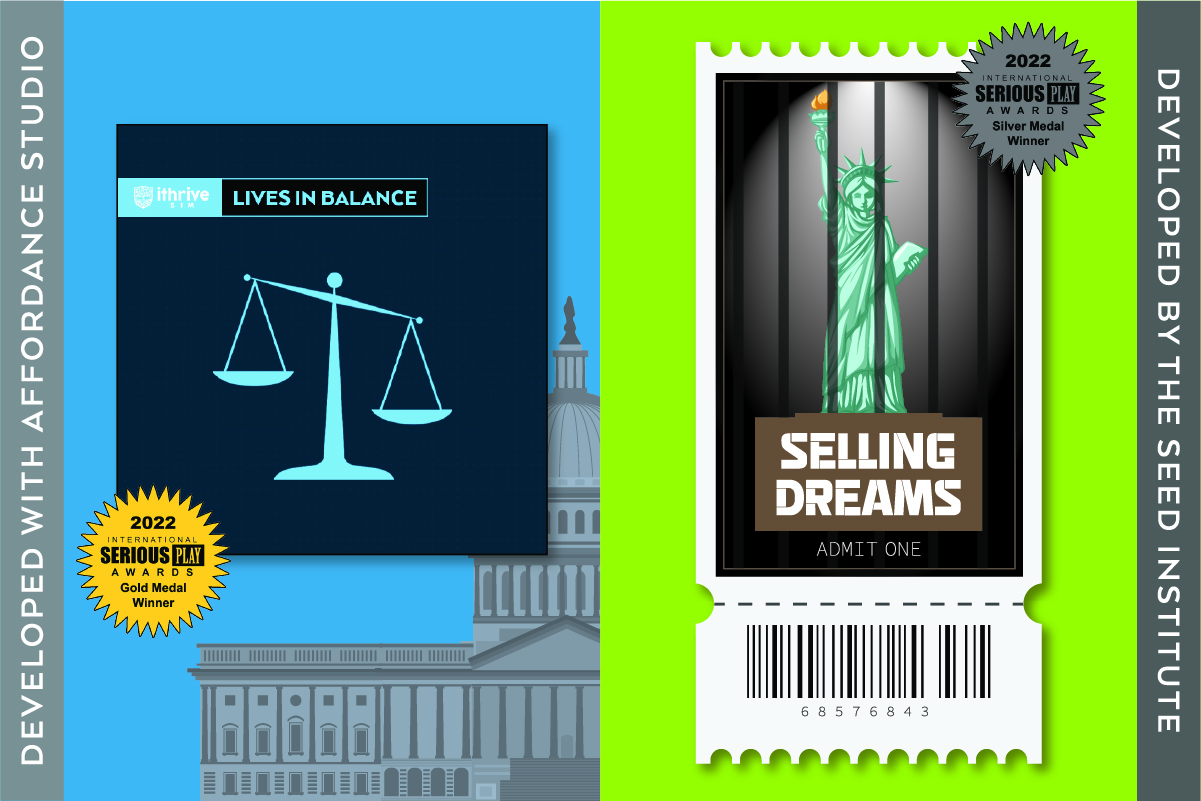
For Immediate Release: June 29, 2022
BOSTON— iThrive Games is pleased to announce two shared wins from the 2022 International Serious Play Awards, a program that honors outstanding commercial and student-developed games created for educational use.
iThrive Sim: Lives in Balance, created with our software development partners at Affordance Studio and the masterminds behind the Situation Room Experience, won a gold medal in the K-12 Education category, while Selling Dreams, the latest from youth game designers at the SEED Institute, won silver in the Non-Profit Training category.
Both digital games are hosted on the iThrive Sim platform, a lever for embodied learning and real-time interpersonal connection launched in 2020 to support the unique educational needs of the COVID-19 classroom. On an easy-to-use interface, players are asked to adopt roles, and are presented with unique information and decisions they must wrestle with in real-time. The players make choices that have ripple effects and drive the game forward. The device-agnostic, web-based software uses synchronous and asynchronous information delivery mechanisms to get players to work together and engage with the information they encounter in different ways. The immersion that iThrive Sim facilitates promotes enduring understandings that can be built upon in post-play debriefing sessions.
iThrive Sim: Lives in Balance, played by over 1,600 students and counting, uses iThrive Sim's dynamic features to enliven teen civic learning through student-led connection, improvisation, and embedded opportunities to grow 21st-century competencies. The interactive experience invites teens to play as government officials tasked with making tough decisions in response to a fictional pandemic. As players work through the 35-minute, tech-supported experience together, they evaluate data and lean into social and emotional skills like collaborating, advocating for their points of view and constituents, and compromising with each other to chart a path forward in uncertain times. Curricular surrounds and activities pair with the role-playing simulation game to deepen and extend the civics educational experience.
Selling Dreams, launching later this summer, uses iThrive Sim's immersive platform to tell SEED Designers' stories in an honest and resonant way that names the structural harm and shortcomings they've observed and experienced in Massachusetts' child welfare system. The single-player game invites case workers and youth-serving adults to take on the role of a Guardian tasked with meeting the needs of the young people they encounter and helping them through their unique challenges. In their role as a supportive actor, each Guardian must stay on top of files, messages, and relevant news sent to them about the youth they serve. Players must make decisions throughout the game using the insight they gather about how to engage with those in their care. With the 30-minute game, SEED Designers highlight the demands and stressors experienced by case workers tasked with disrupting the harm while providing a meaningful training opportunity to think critically about the behaviors that encompass truly responsive care and support.
Both digital games attest to the boundless creativity the iThrive Sim authoring platform supports. The content management system used on the platform allows for the development and editing of role-playing scenarios that fit the unique needs of each audience. The iThrive team is excited to invite new partners to use iThrive Sim and support them in creating new interactive, accessible, and scalable learning experiences.
"The iThrive Sim platform is embedding social and emotional learning opportunities to enliven teen-centered learning across so many topics, from civics to relationship health, to emergency preparedness, and more," says Susan Rivers, iThrive Executive Director and Chief Scientist. "One of iThrive's greatest joys is in co-creating new iThrive Sim scenarios with partners — young people and adults alike — in various sectors to amplify teens' strengths and interpersonal connections and make deep learning not only possible but immensely fun and impactful."
To learn more about the iThrive Sim authoring platform, click here. To contact us for questions related to licensing and developing experiences on the iThrive Sim platform, click here.
###
Media Contact: Eghosa Asemota (eghosa.asemota[at]ithrivegames.org)
About iThrive Games: iThrive Games prepares teens to thrive by meeting them where they are and working in partnership with them to co-create a world where their brilliance is honored, nurtured, and amplified. We use games and game design to equip teens with the social and emotional skills they need to be healthy and resilient.
How Games and Play Support Transformative Civic Engagement in Teens

The teen brain is magnificent, and youth-led efforts to organize and realize gun safety, climate action, and reparative racial justice within their lifetime attest to it.
Our work as adults who care about young people is to meet them where they are developmentally and shower them with experiences that build on and add to the breadth of their genius. Games engage teens deeply and can prompt the connection, reflection, and creativity needed to support them in building the social and emotional capacity to co-create transformative solutions together.
Transformative civic engagement that centers our collective well-being begins and ends with our sense of community. This definition of community widens as we deepen our understanding of ourselves, others, and the world around us. By providing a safe space to wander, learn, test, and create, games become learning environments for young people to do this. Games offer contexts where young people can explore and practice self-awareness, social awareness, responsible decision-making, navigating relationships healthily, and regulating emotions. These core social and emotional skills are civic skills that help young people be informed and responsible members of society.
At iThrive Games, we create with and for teens game-based learning experiences that support them in being in the world they'll inherit with empathy and curiosity. Our resources and the games we've co-designed and launched offer experiences that build teens' social and emotional competence in a meaningful way. In Accidental Queens' A Normal Lost Phone, for example, players are invited to explore a lost smartphone and uncover the story of who it belongs to. Players must stay in the space of curiosity to 'win' the game. In doing so, they build their social awareness of how others think, behave, and feel as they sift through the phone's content and decode what they encounter. High school students who've played the game while using iThrive Curriculum: Sam's Journey in their classrooms have remarked on the transformative learning that comes from the game's immersive storytelling and the investigative lens players put on while working through it. After playing the game, one high school senior shared, "We had a long discussion about our original perceptions of people. This just completely changed my understanding. It made me feel a certain way. It made me think a certain way."
This approach of using play as an avenue for young people to practice core social and emotional skills is also enlisted in our iThrive Sim collection of games. Like A Normal Lost Phone, iThrive Sim role-playing games enable embodied learning that nurtures young people's change-making abilities. Young people are invited to play as government officials who must gather information sent in real-time, analyze it, and think critically about alternatives and consequences before making decisions in times of crisis together. Teens who've played through an iThrive Sim game try on new perspectives and get needed practice as they embody the self-management that negotiation and compromise require, learn to honor dissent, and strengthen their ability to make responsible decisions in collaborative settings. These faculties are central to a well-functioning society.
Games mirror our world and have the capacity to ignite new possibilities in it and in the young people who play them. We see games not only as valuable tools for social and emotional learning but also as springboards for knowledge-building and knowledge-sharing. At this year's Games for Change Festival, iThrive's Executive Director and Chief Scientist Susan Rivers will be continuing the conversation with a virtual session titled, 'Designing Games for Civic Skills: The Power of Creation.' There, she'll be diving into how iThrive's Game Design Studio approach uniquely supports systems thinking in young people through game design, helping them magnify their civic voice, and co-create solutions to challenges in their communities. Register to tune in on Saturday, July 16 at 2:30 p.m. EDT and be a part of the discussion!
The Teen Mental Health Crisis is Real. Game Designers & Developers Can Help.
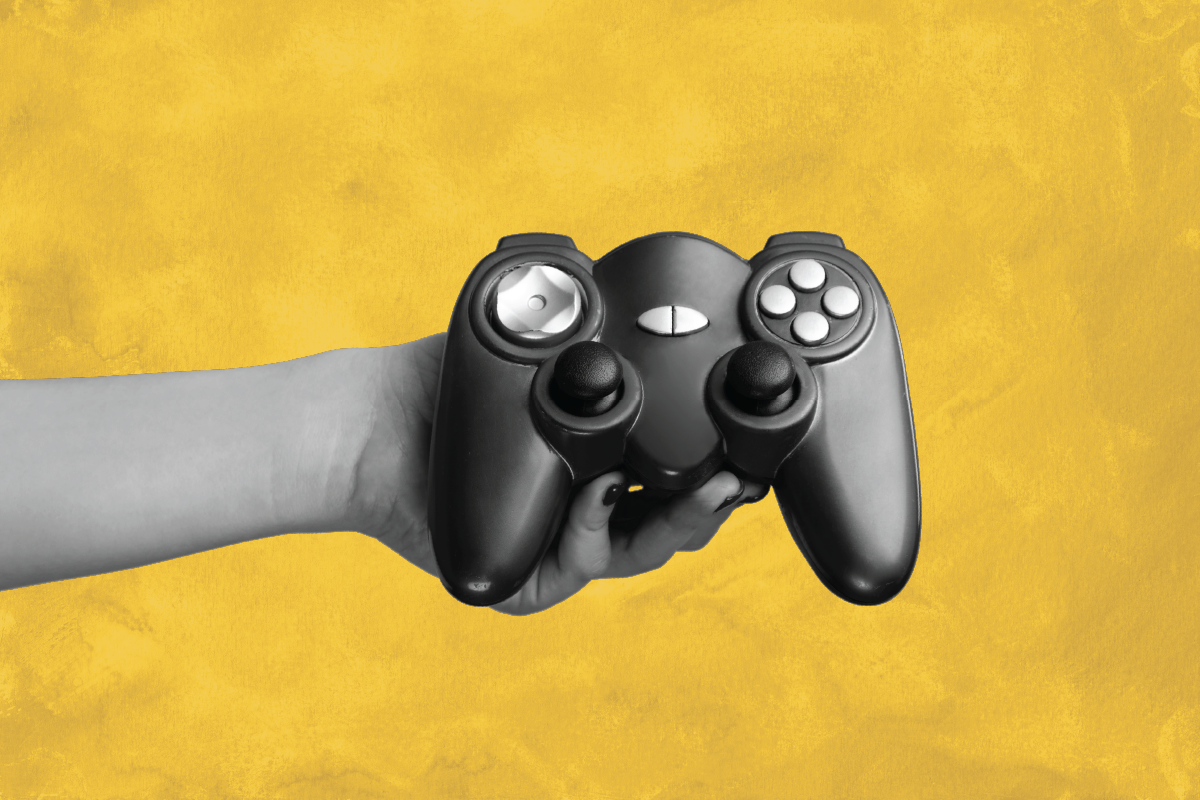
This post is the last in our five-part series, Supporting Teen Mental Health, which shares tools and insights that support educators, parents, and youth-serving adults in showing up for teens in this moment of need. Read earlier posts in the series about mindfully managing difficult emotions, using social media actively and intentionally, nurturing the teen brain with school-based social and emotional learning opportunities, and applying culturally responsive approaches in therapeutic interactions with teens.
Veteran game designer, Jason VandenBerghe, wrote for iThrive Games in 2018 that "If we want to make a large, positive change in our world, I believe the best route is to focus on providing teens with better models for the world." If teens needed better models for the world four years ago, how much more do they—and all of us—need them in 2022?
This month alone, two 18-year-olds separately made the ruinous decision to commit mass murder—one in a racially charged event in Buffalo, NY, and the other in Uvalde, TX. U.S. teenagers wake up every day to more evidence of gun violence, societal strife, greed and corruption in places of power, shrinking opportunities for financial security, and the threat of climate catastrophe. It's no small wonder that rates of mental health struggles among teens are higher than ever.
Video games and social media are too often the easy scapegoats for teens' mental health challenges. In reality, the impact of digital technologies on youth mental health and well-being is complicated, and conclusions in the research are mixed. We know that's largely because "digital technologies" vary as widely as the teens who use them and the circumstances in which they're used. Of course, playing video games under some conditions can be disruptive to the healthy functioning of some, and can facilitate the healthy functioning of others. So, what's the responsibility of a game designer or developer?
At iThrive, we value and know that it is both possible and imperative to empathize deeply with and design ethically for teens. One of the best ways we've found to do this: Co-design with teens the digital tools they use. A youth-centered approach to digital technology design is among the recommendations put forth by the U.S. Surgeon General in his Advisory on Protecting Youth Mental Health. When we design with teens, for teens, the digital experiences they engage with are both likelier to do no harm at this vulnerable developmental moment, and likelier to amplify teens' immense capacity to thrive emotionally, socially, cognitively, and physically.
There's so much that's fascinating and motivating about the teen brain and how it's changing. For designers, we've boiled it down to a list of 10 things to know when designing for this unique window of both opportunity and vulnerability to best support teens' mental health.
TEENS ARE:
-
BUILDING HABITS FOR LIFE: Teens' brains are undergoing the last major restructuring of development, making the teen years the perfect time to build skills and habits that help them throughout life. But negative habits "stick" more at this time, too.
-
CATCHING ONTO YOU, FAST: Teens are getting wiser about the world. They're reaching a cognitive peak and learn very quickly. They easily see through attempts to manipulate or preach to them and don't respond well to hypocrisy or unfairness.
-
IN NEED OF POSITIVE CONNECTIONS: Above all, teens need access to strengthening experiences, environments, and relationships that help them grow in positive ways. They want to be close to adults, even as they figure out how to be more independent.
-
MORE TOLERANT THAN TEENS USED TO BE: Teens today value diversity and acceptance even more than previous generations. They care about authentic inclusion and diversity.
-
NOT JUST "WEIRD:" Obvious, but worth remembering, teens aren't just Western, Educated, and from Industrialized, Rich, Democratic countries. They need their uniqueness and diversity to be reflected in the spaces where they spend time.
-
SENSITIVE TO REWARDS, ESPECIALLY SOCIAL ONES: Teens have more dopamine circulating in their brains than adults. They are very sensitive to "feel-good" rewards like those in video games. Teens do riskier things when other teens are around, partly to earn status and respect.
-
STILL LEARNING TO CONTROL IMPULSES & EMOTIONS: Teens are still developing connections in the prefrontal cortex. They have a more challenging time controlling impulses and emotions and predicting the consequences of their actions than they will in the future.
-
IN NEED OF MORE SLEEP: Teens need more sleep than adults to thrive, and they might need support to make the best choices and set boundaries for their health.
-
FACING A LOT OF STRESS: Teens are under a ton of pressure. Also, if they are going to appear, most mental illnesses show up between early adolescence and young adulthood. Teens need ways to cope and to be able to seek help without stigma.
-
TRYING TO FIGURE OUT WHO THEY ARE: Teens want to try on different roles and expressions and figure out where they belong. They need social spaces to interact, experiment, negotiate, and resolve conflicts. But toxicity and bullying should be proactively prevented in these spaces.
So, if you're a designer or developer of experiences teens use, how much do you think about their needs at this developmental moment? What models of the world are you making for them? And are teens a part of your design process?
Creating spaces that foster teens' mental health and well-being is a team effort. iThrive is here to support you. We offer Game Design Kits, evidence-based guides to designing for mental health, and specific components of teen thriving like growth mindset and zest. We also specialize in custom design services that draw on teens' genius and creative problem-solving energy. Reach out to find out how you can use our co-design approach at your studio or organization.
SEED Designers Bring Games & Experiences to The Heller School at Brandeis

This summer, youth designers at the SEED Institute are bringing their expertise (and games) about the harmful systems they've navigated to graduate students at The Heller School for Social Policy and Management at Brandeis University.
Those who are most impacted by systemic harm know what's needed to disrupt it.
This belief is a foundational one at the SEED Institute, a collaborative effort between Transition HOPE, iThrive Games, and the Black Ministerial Alliance-Ten Point Coalition. At the Institute, young people are SEEDs—System Educated Expert Disruptors. Synthesizing their lived experiences navigating systems of oppression into structured games, SEED Designers use play to advocate for meaningful change in youth-serving institutions. They then bring the games to sessions with community stakeholders throughout Boston, where the designers facilitate play-based conversations to share knowledge, identify and unpack inequities, and imagine possibilities for systems that truly nurture youth. The work of the Institute so far has been powered by SEED Designers' inventiveness and their commitment to building relationships and facilitating conversations that ignite and inspire action.
For a few designers at the SEED Institute, advocacy began with Transition HOPE's Summer of HOPE 2018, an initiative that paired them with graduate students and faculty at The Heller School for Social Policy and Management at Brandeis University. Working as research assistants over seven weeks, the SEED Designers had the opportunity to learn more about how structural violence impacts day-to-day life. Meanwhile, the graduate students and faculty learned more about how to best support young people.
This year, the SEED Institute will continue this vital work with The Heller School's newly launched Racial Justice and Tech Policy Initiative (RJxTP). Through this initiative, SEED Designers will engage in research and develop a game as part of the Hidden Bias Research Prize. RJxTP aims to create more opportunities for knowledge-building and knowledge-sharing between and among youth designers, graduate students, researchers, and policymakers. SEED Designers will use their stories, wisdom, understandings, and ideas to contribute to the dismantling of systems of injustice. Check out the video below for a glimpse of the collaborative work ahead:
Stay in the loop! To quote one of the designers at the SEED Institute, "awareness is like a fire—and that's what we're here for; to spread that fire and spark change in somebody's mind." Keep up with the SEED Institute's design team as they develop and launch new games, and press forward with their advocacy and awareness-building through play, by signing up for our mailing list today.
In Times of Stress, I Turn to Cooking Games. Here’s How They Help Me Cope.

The Power of Play blog series invites teens across the nation to share stories and reflections that highlight the ways games have helped them learn more about themselves, create new bonds, and better understand others. We're excited to continue the series with a reflection written and submitted by Ashley, a high school student based in Philadelphia, PA, on the ways cooking games have helped her destress and connect with herself in crucial moments.
Many people play games to pass the time and because they enjoy the effect games have on them. They have a relieving effect, and they are a way for people to forget about their problems temporarily.
Typically, I am a person who relies on other people to help me cope with whatever crisis I'm in to help get me through it. I also rely on games to help get me through it. Games are a one-stop type of thing that will never leave you. Games are there for you whenever, any time of the day. I am such an overthinker and struggle with self-confidence. When something devastating happens in my life, all I can think about is all the negative consequences that it will bring. That's it. Nothing. No one else. But having games, something to go to at any time of the day, has been really helpful. Playing them helps me forget about my problems in that moment.
I enjoy baking and cooking and the excitement that comes as I savor every second, minute, and hour before the food is ready. Cooking has always been a way for me to be and feel productive. I love the feeling that comes with making good food. You are so busy thinking about how good you want the food to be or how you do not want to mess up a recipe that you just feel more present and focused. Nothing else matters.
I found that same feeling in cooking games. Games like Cooking Mama, Cooking Fever, and Diner Dash help me take a pause from the world. I usually play anything that involves clear goals and the use of my time management skills. Cooking games mean a lot to me. Ever since I was a little girl, I have always had a passion for cooking because my mom cooks every day. Even if we have so much food leftover from the previous night, she will still cook something new the following day because of the relief it brings. I use cooking games in the same way. They help me deal with the problems I wish to overcome. In these games, there are numerous restaurants where you have to make and serve your "customers" food and drinks, and you earn money in exchange. The higher the level, the harder the difficulty range will be. The harder you push, the more productive and focused you feel.
These games are close to my heart not only because it brings me joy to serve others but also because, even if only for a little bit, it makes me forget about unpleasant things I can't control. These games also allow me to express my creativity through food. And what's not to love about that?
We are always looking to amplify teens' voices and share their stories that attest to how games help us understand ourselves, each other, and the world around us. Have something to share? Send us your thoughts, stories, ideas, and reflections at contact@ithrivegames.org with a brief blurb about yourself to see it on our blog this year!
One Thing Mental Health Practitioners Who Work With Teens Must Know

This post is the next in our series, Supporting Teen Mental Health, which shares tools and insights that support educators, parents, and youth-serving adults in showing up for teens in this moment of need. Read earlier posts in the series about mindfully managing difficult emotions, using social media actively and intentionally, and nurturing the teen brain with school-based social and emotional learning opportunities.
Teens' mental health difficulties and needs have peaked since the start of the pandemic, culminating in what leading U.S. child and adolescent health organizations have deemed a national emergency. As mental health practitioners strive to meet diverse teens where they are at this time of crisis—in part one spurred on and exacerbated by racial inequities—they need tools and approaches that offer authentic entry points for building rapport and trust.
The U.S. Surgeon General's 2021 Advisory, Protecting Youth Mental Health, stresses the need to "recognize that a variety of cultural and other factors shape whether children and families are able or willing to seek mental health services. Accordingly, services should be culturally appropriate, offered in multiple languages (including ASL), and delivered by a diverse mental health workforce." Using culturally appropriate tools and approaches invites teens and their families to engage as equal partners in improving and maintaining young people's mental health. Critically, this approach also amplifies and celebrates existing strengths and connections that are unique to each young person's cultural background and social network.
At iThrive, we've witnessed how games can be a powerful part of culturally responsive approaches to supporting teens' social and emotional skills, which are critical for mental health across the lifespan, both in schools and in therapeutic settings. That's because games of all kinds have the power to tell compelling stories, not just about the characters within them but about the players who play them, revealing truths about who they are and the world they inhabit. As one high school senior said of iThrive Curriculum: Museum of Me, our unit based around the game What Remains of Edith Finch: "You learn some things about yourself and others. It's nice to know that your [sic] not alone in seeing yourself a certain way. It's kind of relieving to know other people feel the same ways about themselves."
In an effort to help youth-serving practitioners better support teens with culturally responsive tools and approaches, iThrive's Senior Director of Learning Michelle Bertoli interviewed Lora Henderson, a licensed clinical psychologist, former educator, and assistant professor at James Madison University who specializes in supporting the mental health of young people in underserved populations. In the interview transcribed below, she shares best practices and tools — including game-based approaches — for engaging authentically with diverse teens in support of their health and healing. The interview has been edited for length and clarity.
Michelle: In your own work, how do you identify and define culturally responsive tools and practices?
Lora: I work at the intersection of education, mental health, and social and emotional learning. I define culturally responsive practices, or CRPs, as actions practitioners can take to build on students' strengths and cultural frames of reference. In the classroom, this might mean drawing connections between the curriculum and students' home lives and cultural experiences. In a clinical setting, it might include showcasing materials, games, books, and posters that reflect students' cultural backgrounds and experiences.
Michelle: And how do you get a sense of what's going to be culturally relevant and useful to students? It takes time to get to know them and you don't want to make assumptions.
Lora: Yes, that can be difficult because you don't want to fall into stereotypes about groups. We often go into our interactions with children and families with our own biases and assumptions about their cultural groups. Sometimes those things map onto their experiences and other times they don't. So, I do a lot of building relationships with kids, asking them what they did over the weekend, how their family celebrates holidays. Those small things aren't therapy, per se, but are really important to getting to know kids and their families and what culture means to them and looks like in their own contexts.
Michelle: At iThrive, we design our games and game-based tools with equity, representation, and accessibility as core pillars. From a practitioner's perspective, how do these design principles make a difference for supporting teen mental health and well-being?
Lora: We can expect youth to have improved outcomes when they can connect to the materials, games, or information being shared with them. When we design with youth, put them at the center, and make them experts, like everyone at iThrive really does, it can maximize positive youth engagement with the tools you're creating. At iThrive, it's a bidirectional process: the youth designers get to build social and emotional skills and increase their well-being, and peers who play the games also get to learn from the youth designers' expertise and experiences. That process can have large positive effects for the designers and their peers alike.
Michelle: What tools, including games or game-based approaches, do you use to strengthen young people's awareness and embracing of their cultural identities?
Lora: From my time as an elementary school teacher to my current role as an assistant professor and licensed clinical psychologist, my first job is to build rapport and authentic relationships with youth. All of the other positive outcomes are couched in that initial positive relationship that creates a safe space for youth and families to feel accepted. That's how I demonstrate my respect, openness, and acceptance of their cultural identities. In my classroom and therapy office, I ensured that the books, pictures, and posters reflected the diversity of my clients so that youth could see themselves in my office and know that it was a safe space to be themselves.
In therapy, I play lots of tabletop, board, and card games with youth. As one example, I've played a lot of Spades with Black families who play it at home, to bring an aspect of their culture into the room. I have emotions/feelings playing cards, so as we're playing Spades, and they get a "9" with an angry face on it, we talk about times when they were angry or observed someone else being angry, and how they managed those feelings. I really like to incorporate games that youth are already playing and then infuse mental health and social and emotional components into them. In in-patient settings, youth have taught me card games that they learned while in the hospital or juvenile detention. I let them lead the play. It's one way I demonstrate that I accept and value their lived experiences.
Michelle: How has embracing your own cultural identity as a practitioner helped you hone your professional skills? How have games played a role in this?
Lora: As a Black woman, I have had to examine my own biases and experiences to help me acknowledge the systemic racism that I experience in this country AND the privileges that I have as an employed, cisgender professional with a doctoral degree. While games have to be facilitated thoughtfully and in a sensitive way, gameful activities like "Step in the Circle," "Cross the Line," "Four Corners," and the "Privilege Walk" have helped me with my own personal exploration. I have moved away from the "Privilege Walk" activity because it visually moves privileged individuals ahead and those with less privilege behind and can perpetuate bias, but it was a meaningful activity for me when I did it about 10 years ago. It was the first time that I was really able to reflect on my privileges and challenges as a Black woman. The other activities that I mentioned still have the visual component of stepping into the circle, crossing the line, or going to the corner that aligns with youth experiences, but they remove the cumulative visual effect of moving further ahead or further behind.
Michelle: How would you recommend other clinicians who are not as practiced in culturally responsive approaches with young people begin to build those muscles?
Lora: The best way to become more culturally responsive is to engage with youth and listen to them. Reading the literature and learning about cultural responsiveness, humility, and competence is important, and still there's nothing like just talking to youth. Inevitably, they'll tell you that it doesn't work exactly how it's explained in textbooks or scholarly articles.
But before talking to youth, anyone who wants to be culturally responsive needs to engage in self-reflection about their own biases and assumptions about people from other cultural groups. It can help to have a group that you talk to about these things for accountability and outside perspectives. I can't stress how important doing that personal work is before stepping into work with youth. We don't want them to be our test subjects or to cause unintentional harm by doing things we think are culturally responsive but might be missing the mark and actually doing harm.
Talk to youth about what they like to do, what they enjoy, how they celebrate holidays. Get to know them in an authentic way.
Michelle: How can practitioners manage the fear or uncertainty they may have about making mistakes or unintentionally doing harm when striving to be more culturally responsive?
Lora: I think mindfulness-based techniques are really helpful. If you feel yourself getting nervous or unsure, stop and take a few breaths. Center yourself and remind yourself why you're doing this work. So many of us go from meeting to meeting to facilitating a workshop, etc. Sometimes just taking that breath can help settle your nerves and get you ready for those intersections.
Also, I think it can be fine and even acceptable to acknowledge differences between youth. You can highlight both obvious differences and similarities to help youth notice commonalities they share. Let youth know that you're trying, that you're maybe from a different cultural background and you might stumble, and you want to know about it if you do so you can do better next time. You need a safe space, too, in order to learn when you've made a mistake. It all comes back to authentic relationships because if you don't have that and you miss the mark, youth won't tell you. They might keep trucking along with the program or activity but the outcomes may not be as positive as they could have been.
Michelle: What are some resources you would recommend to practitioners who want to learn more about culturally responsive practices?
Lora: I lean heavily on the Double-Check framework. It's from education but applies in therapy as well. A shorthand tool it uses is the acronym CARES: Connections with curriculum, Authentic relationships, Reflective thinking, Effective communication, and Sensitivity to students' cultures.
For people who want to go even deeper, I also recommend this review of CRPs from an education perspective.
Michelle: Thank you so much for your time and insights, Lora!
[End of Interview]
Mental health practitioners seeking to find new ways to meaningfully engage and support teens from a diversity of backgrounds can also find inspiration in iThrive's Game Guides, which highlight unique ways to check in with teens and touch on their emotional experiences through the lens of some of their favorite games including Minecraft, Fortnite, and Super Smash Bros. Ultimate.
iThrive's Game Design Studio Toolkit is another rich resource for using games as systems to engage teens in complex, aspirational thinking that has its roots in awareness of their unique personal experiences. Individuals who aspire to something even more innovative can also make use of iThrive's design services to envision and realize completely fresh game-based approaches.
What are some ways you use games or game-based approaches in therapeutic interactions with young people? Let us know at contact@ithrivegames.org!
Game Design Supports Deep Learning. Here’s How It Can Help School Communities.

Engaged learning and connection help us get to the world we're all yearning for—one where we all have the social and emotional faculties to work collaboratively with empathy and curiosity in support of our collective thriving.
At iThrive, we see game design and play as springboards for both, creating connective pathways for knowledge sharing and knowledge building. We invite teachers and students to be game designers as a way to activate deep learning. In using game elements like rules, characters, ways of progressing, and win and loss states to craft a structured game reflective of lived experiences, the game designer has the chance to think concretely about the specific changes they want to see in the systems they navigate. The game they create, in turn, offers a play experience that opens up space for dialogue, exploration, and empathic listening, setting the stage for deep reflection that inspires movement from aspiration to action.
On March 30, iThrive's Susan Rivers and Transition HOPE's Janelle Ridley brought game design to High Tech High Graduate School of Education's Deeper Learning 2022 Education Conference in a deep dive crafted to engage educators in innovative and collaborative thinking. Attendees of their "Game Design for Understanding and Learning" workshop were invited to use game design techniques to reflect on their experiences, connect with other educators who care deeply about student thriving, and envision new practices that support deep learning.
Pulling from our Game Design Studio Toolkit, the four-hour workshop began with play. We played The Run Around, a game created by SEED Designers, and a prototype of one of the games developed by Fugees Family students. These served as an introduction to iThrive's unique use of game design in youth-centered spaces to support generative thinking and social change. Play and icebreakers were followed by empathy mapping, where educators were invited to reflect on their lived experiences as learners and teachers. After analyzing their reflections and noting the shared themes among them, participants synthesized the themes to define core needs, challenges, and possibilities. Working collaboratively in groups, educators then gathered to ideate ways to represent their stories and experiences using game mechanics and world-building tactics. Those ideas came to life in the participants' prototyped game boards and accompanying materials, which were exchanged and playtested by other groups for feedback. From this interactive experience came deep reflection on the needs and wants of students and educators, how things are in education, and how things could be.
 The Warm-Up, Empathize, Define, Ideate, Prototype, and Test sequence taken from the Game Design Studio Toolkit.
The Warm-Up, Empathize, Define, Ideate, Prototype, and Test sequence taken from the Game Design Studio Toolkit.
By the end of the "Game Design for Understanding and Learning" deep dive, 25 educators created four game prototypes that focused on topics such as the importance of designing learning experiences for student agency; the unreasonable demands placed on teachers; how a culture of deeper learning, in contrast to a culture of testing, leads to student success ; and supporting students to embrace productive struggle. Each of these games was demoed at the Deeper Learning Showcase later that afternoon.

Game prototypes shared at the Deeper Learning 2022 Showcase.
Participants in the deep dive shared that crafting a game based on their lived experience was a great way to solidify their thoughts, think critically about systems they've navigated, and identify ways to change those systems. All were excited and engaged by the deep learning and reflection that surfaced from the experience, with teachers afterward calling game design "collaborative," "relevant," and "an interesting way to view issues and problems."
"The openness and curiosity that comes from play, which is energy giving, creates opportunity for imagination, and to think about what could be next," shares iThrive's Susan Rivers. "Bringing the Game Design Studio approach to Deeper Learning was an opportunity to support teachers in reflecting on new ways of doing and being in and outside of the classroom in service of young people's thriving."
For educators and administrators interested in unpacking challenges in their school communities or sparking new ideas that contribute to educator and student thriving, we invite you to use design thinking activities from our Game Design Studio Toolkit in your brainstorming. Activities included within the complete kit support active listening, needs mapping, and iterative testing to ensure the solutions you dream up with your team are relevant and responsive to your school's unique goals.
Here's a glimpse of what's on the other end of the exploration the Toolkit guides its users through in the context of education:

Interested in using game design to support design thinking and program development in your school community? Contact us to explore facilitation options crafted to help educators and administrators co-design youth-centered solutions with their students.
How Are We Teaching Teens to Prepare for and Respond to Natural Disasters?

2021 saw a record number of catastrophic natural disasters and weather emergencies throughout the United States. Wildfires ravaged the West Coast, destructive flooding engulfed the East, extreme temperatures enveloped the South and Pacific Northwest, and the Atlantic hurricane season—the third-most active one in history—produced 21 storms.
The intensity and frequency of these natural disasters prompt important questions about disaster preparedness—what can we do to ensure our safety and the wellbeing of our communities in times of crisis? We think the answer must enlist the creativity and perspectives of young people, and the Federal Emergency Management Agency (FEMA) agrees. They view young people as "positive influencers" uniquely capable of bringing the message of preparedness home to their families. Like FEMA, we believe that equipping young people with emergency management skills is a crucial part of engaging whole communities. Together, we're creating a new iThrive Sim scenario that strengthens teens' emergency preparedness through play.
The new hands-on learning experience, designed in partnership with Federal Emergency Management Agency Region VIII, will be hosted on the award-winning iThrive Sim platform, which uniquely merges tech, role-play, social and emotional learning, and online gameplay to deeply engage teens with rich storylines and with core content. The resulting role-playing simulation scenario will help FEMA increase access to training opportunities and better reach young people living in underserved and rural communities.
"While nothing highlights the importance of emergency preparedness quite as well as the visceral experience of a natural disaster, we don't want it to come to that," share Daniel Nyquist and Stephanie Poore from FEMA Region VIII. "An engaging simulation is a fantastic tool for laying down the mental pathways we need to activate in times of crisis. That's why we are thrilled to be designing a disaster preparedness simulation with the iThrive team. iThrive's unique co-design approach is illuminating how to mobilize young people's creativity and distinct strengths in service of building mindsets and skills needed for resiliency across disaster preparedness, response, and recovery."
A core principle of iThrive's co-design process is involving teens in the development of products, programs, and services that seek to engage them. As we work with FEMA to create this new tool for Region VIII, which serves 29 Tribal Nations, Colorado, Montana, North Dakota, South Dakota, Utah, and Wyoming, we've been in community with teens from those states to gauge their needs and weave their input into each step of the game design process. An initial co-design workshop with 15- and 16-year old teens surfaced themes that were top-of-mind for them, including ensuring the safety of pets, coordinating resources, trusting experts, and cultivating the emotional ability to cope with disasters. These themes are actionable insights that will inform the game's content and ensure what we create is relevant, memorable, and meaningful for teens.
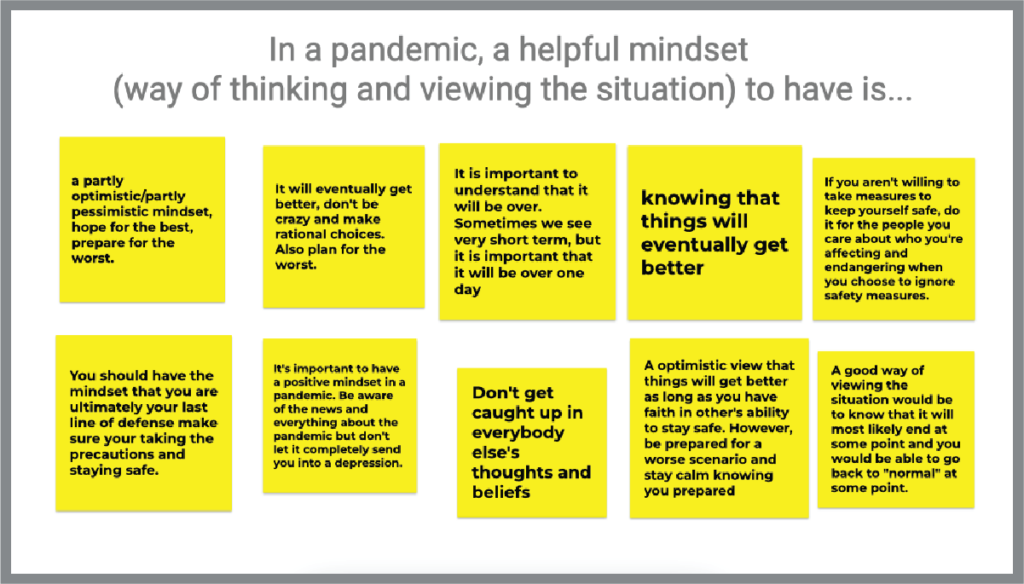
A snapshot of a Google Jamboard from a recent brainstorming session with teens featuring their responses.
As we work through the game development process, the wisdom of the teens we're working with continues to be both instructive and inspirational. "Teens never cease to impress me with their generosity, openness, and vulnerability when sharing about difficult topics—they get right to the heart of the issue with self-awareness and a solution-focused drive," shares Jane Lee, Senior Director of Operations and Mental Health at iThrive Games. "These teens have been through a remarkably challenging time, and it's only strengthened their resolve to build the skills and relationships they need to grow in their resilience."
The iThrive Sim scenario, launching in late 2023, will support teens and their families in knowing what to do in an emergency situation, covering disaster preparedness and response. To stay updated with its launch, be sure to join our mailing list today.
iThrive’s 2021 Annual Report Celebrates Teen Genius, Community, and Play

Connection brings healing the same way co-creation brings innovation—through intention.
In 2021, we intentionally leaned into both, connecting with teens, educators, game developers, university partners, museums, and youth-serving organizations across the globe to co-design meaningful learning experiences that enlist the power of play to support teen thriving.
True to our mission and vision, we actively sought partners who want to engage young people in their genius and support them in developing the social and emotional skills to be in the world they will one day inherit with both empathy and curiosity. Bridging our partners' subject matter expertise with our co-design approach ensured that teen voice remained at the center of every tool, experience, and resource that sought to engage them. Our 2021 Annual Report, Building Community In Service of Teen Thriving, highlights all that we co-created, refined, and shared last year. Here are a some of the report's highlights:
- Our commitment to knowledge-building and knowledge-sharing brought us to conferences where we connected, learned from, and shared with game designers, researchers, educators, administrators, policymakers, and other intersectional experts across the globe.
- iThrive Sim, our award-winning ed tech tool that hosts immersive civic learning experiences, expanded with two new role-playing simulation scenarios: Leading Through Crisis and Follow the Facts, both of which were created with guidance and input from students, teachers, and subject matter experts.
- In May, we launched iThrive Curriculum's third game-based learning unit, A Moment in Time, an eight-lesson social and emotional learning experience that pairs with the mobile game Florence and supports teens in reflecting on relationships, grief, loss, and life shifts.
- Working in partnership with iThrive, youth designers at the SEED Institute created and launched The Run Around, a board game that mirrors their lived experiences in the juvenile justice system, authentically communicates its harm, and advocates for structural supports capable of disrupting it. Since launching, The Run Around has garnered press in The Boston Globe and won gold at Serious Games' 2021 Serious Play Awards.
- Working with High Resolves Group and Rise, an initiative of Schmidt Futures, we have been working on curating transformative educational experiences and making them widely available through Symphony, a new online tool that supports student-centered and self-directed learning.
An all-of-us approach is needed in supporting youth as they navigate the complex challenges of this time. A special thank you to every teen, educator, and collaborator who connected with us in 2021 and joined us in our commitment to creating learning environments and shared spaces that ignite and value the potential of young people.
Join iThrive’s Teen Advisory Council and Co-Design Exciting Gaming Experiences
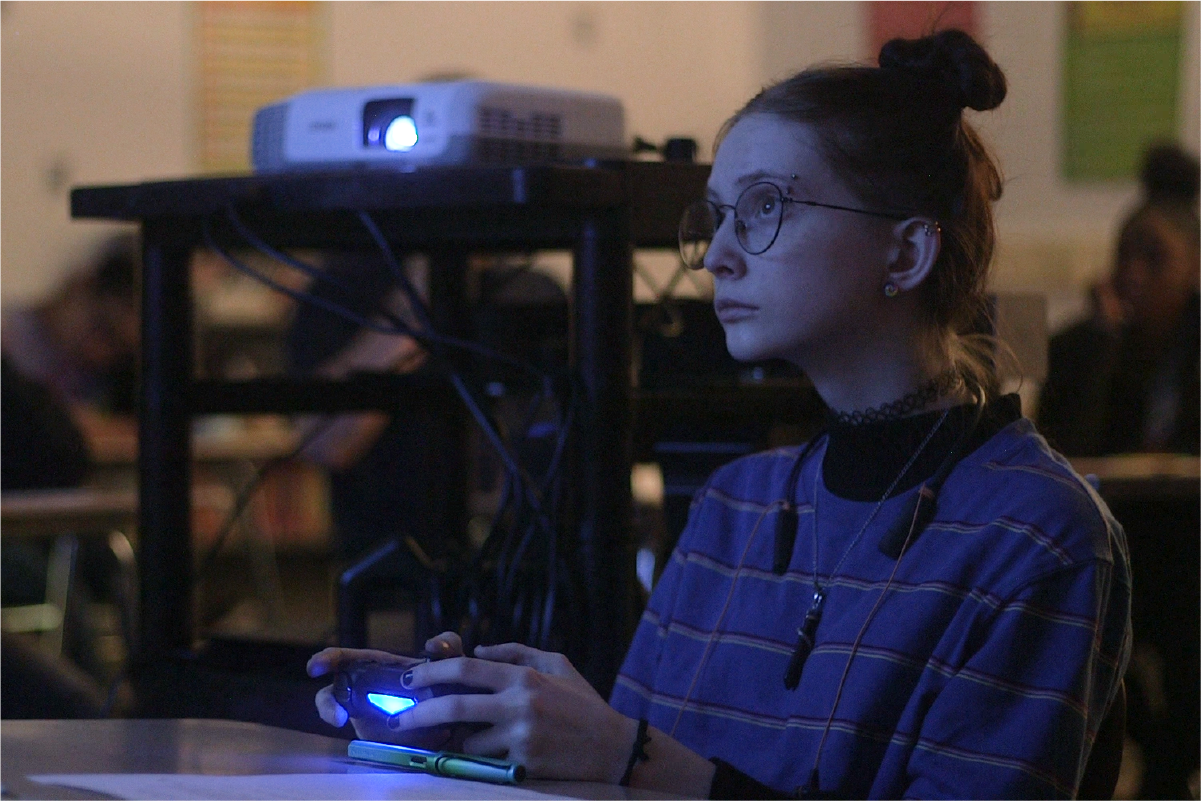
Do you love playing games? Have you dreamt of creating a few? If you said yes, then we need you on iThrive Games' Teen Advisory Council.
Teens tell us all the time how games help them connect with friends, de-stress, strategize take-overs of new worlds, feel a sense of belonging, inspire new ways to learn, and so much more. At iThrive, we love games for all these reasons too, and our mission is to use them to make the world a better place.
We have found that our game designs are better when we design them with teens. Teens challenge us, inspire us, and offer world views and perspectives that we admire and appreciate.
We are launching a Teen Advisory Council and are looking for teens who love games and believe that game design and gameplay can make the world a better place. Members of iThrive Games' Teen Advisory Council are high school students—ages 13-17— who want to:
- Brainstorm, co-design, and test new games and share feedback with game writers, game designers, and our game development team
- Brainstorm new game designs and meaningful, immersive game-based learning experiences with us
- Use their voice in writings, recordings, or designs to share their point of view and experiences about what teens need most right now on topics that may range from game reviews, new game designs, learning, wellness, and more
All members must be between the ages of 13 and 17. Members will serve for a one-year term (February 24, 2022 to February 24, 2023) with an option to renew and will receive a monthly stipend ($150/month). Each month, we will ask you to engage with us on different activities which may include:
- Co-designing and testing new games or courses
- Providing feedback on design or content ideas for our games or courses
- Completing brief surveys to share your ideas and opinions
- Attending a virtual meeting with members of the Teen Advisory Council
We expect that monthly activities will take no more than 6-8 hours.
Applications to join the iThrive Games' Teen Advisory Council have been closed. Follow us on Facebook or Twitter for future updates and opportunities to beta test and consult on games.
Leveling Up: How Playing Video Games Helped Me Find Passion and Purpose
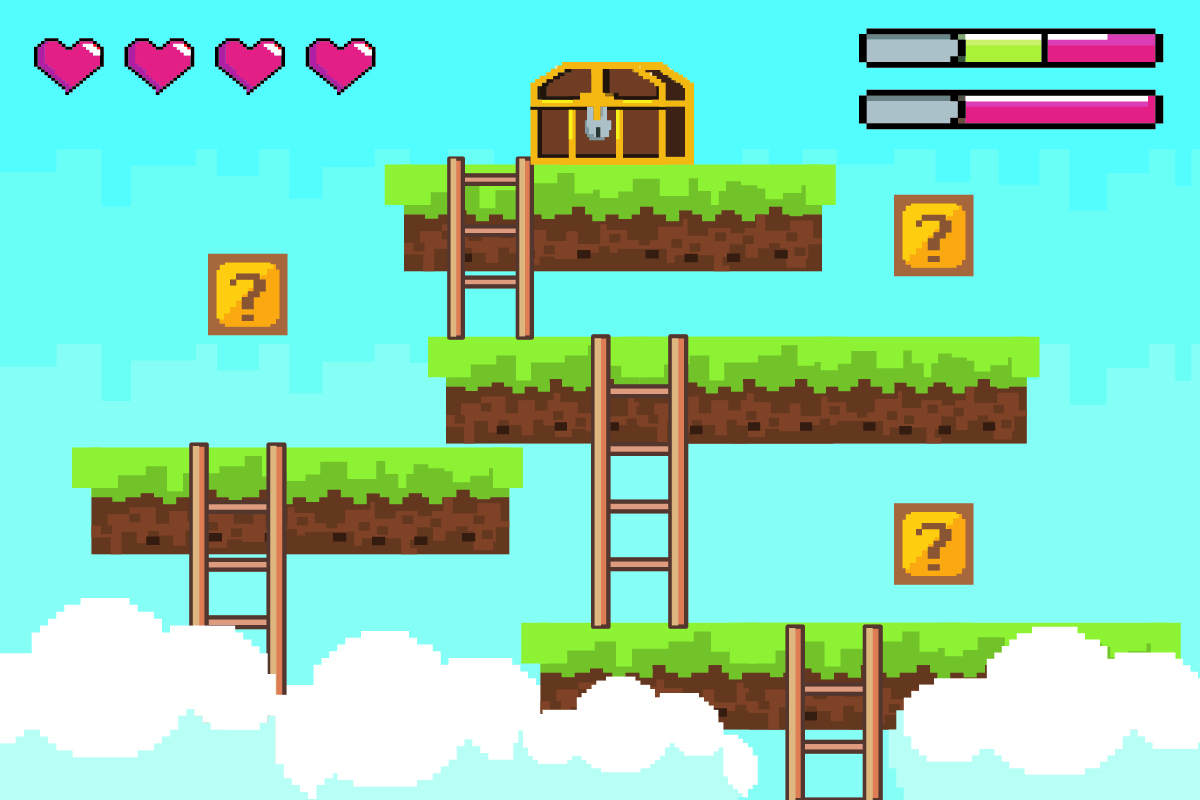
Games have the power to transport us to new worlds where we can safely explore new possibilities and perspectives. They delight us, challenge us, calm us, frustrate us, connect us, excite us, and invite us to uncover new ways of doing and being. Anyone who's played a game, be it digital or tabletop, knows this firsthand.
At iThrive Games, we see springboards for transformation in play's social and emotional value. We believe that when the emotions games evoke are recruited for learning, the learning that happens goes deeper and lasts longer. We champion play as a constructive avenue for academic, social, and emotional growth, co-designing game-based learning experiences with high school students and teachers that leverage the power of play and support teen thriving.
Last year, we launched the Power of Play, a blog series that shared posts from teens reflecting on the many ways games have helped them deal with life, discover possibility and purpose, and question the way things are in the world. We're excited to resume the series this year with the following post from avid gamer Jacob Rivers, an incoming college freshman, who shares a heartfelt story about how video games supported his self-discovery and becoming, preparing him for his next level in life.
"Jake, enough with the video games and get your work done," a phrase I have heard over and over again since elementary school. Being diagnosed with ADD at a young age, school never came easy to me. However, when I opened my Nintendo DS for Christmas, instantly, I was fascinated playing just about any game I could get my hands on, and it helped me become more focused. Once the bus had dropped me off from school, I would run up to my room and immediately play video games. As school got harder and I was about to enter middle school, video games became a sense of escapism for me.
Middle school can be difficult, especially for me who had just moved to a new town and started a new school. Coming from a large city to a small town where I only knew three people was daunting. Although joining a baseball league in sixth grade alleviated the apprehension, I continued to rely on video games. It was around this time that I began to watch Youtubers to learn more and improve my skills. Once I noticed myself getting better, I started to explore the platform of multiplayer. As I transitioned into high school, I became more competitive, and my passion for video games increased.
I was fortunate enough to sign up for an elective as a freshman called App Inventor. It was this class that sparked my interest to one day make my own video game. Knowing what kids enjoy as entertainment and creating something on my own felt like an achievement I could accomplish, and it motivated me even more. Every chance I had, I would take classes to improve my knowledge in the field I wanted to pursue. During sophomore year, one of my friends built his own computer, and this intrigued me. After I had turned sixteen, I got a job to save up the money to make this project happen. It took a lot of time and research to learn how to build a computer and have all the necessary parts. When I completed it, I felt proud, and I knew this was only the beginning of my abilities with computers. As the pandemic hit, I took a leave of absence from work; this caused me to isolate myself from society, and I became more involved with the gaming aspect. When junior year rolled around, I returned back to work. A month later, I was hit by a car, and fortunately enough, I only broke my wrist. Even with this setback, I maintained good grades, and the gaming continued to keep me in check.
As I finish my senior year, I will have the opportunity to take an online coding class where I will learn how to use Python, Java, and C++. This will add to my expertise and give me a head start for what I wish to pursue in college. Looking back at my younger self coping with ADD, I've realized how much I have grown. With gaming, my struggles of focusing in school lessened. With my wish to major in Game Design, I hope one day to make a game not just for amusement but to help kids who have fought with similar learning disabilities like me. I have finally completed this "level" in my life. Now, it's time to start the next one.
We are always looking to amplify teen voice and share their stories that attest to how games help us understand ourselves, each other, and the world around us. Have something to share? Send us your thoughts, stories, ideas, and reflections at contact@ithrivegames.org with a brief blurb about yourself to see it on our blog this year!
Vol. 3 of Journal of Games, Self, & Society Examines How Games Transform Us

BOSTON—January 6, 2022. The global COVID-19 pandemic marked a time of unprecedented social isolation. With it came an uncovering of new ways of doing and being, ones that met our social and emotional need for safe but hearty connection. Amid stay-at-home orders, games played an integral role in cultivating spaces for people to gather, connect, learn, collaborate, and wander. The newest volume of the Journal of Games, Self, & Society examines the ways play supports this level of connection in young people at a crucial time, highlighting the ways games accompany and ignite transformation in how we understand ourselves, others, and society.
Produced by iThrive Games Foundation, published through ETC Press, and guest-edited by Claudia-Santi F. Fernandes and Grace Collins, Volume 3 of the Journal for Games, Self, & Society features novel insights into gaming behaviors that emerged during the pandemic. Finja Walsdorff, Claudius Clüver, and Max Kanderske share a fascinating analysis of how 'tend-and-befriend' games like Animal Crossing: New Horizons, a game that soared in popularity in 2020, respond to human needs and behaviors in times of uncertainty and crisis.
Vol. 3 of the Journal also features a valuable case study for designers looking to create games that highlight systems of harm and erasure, and invoke an empathy capable of disrupting it. In an in-depth retrospective on the design choices made while creating Resilience—a game that centers the stories and plight of refugees, Drexel University's Lily Lauben, Justin Roszko, Alex Gallegos, and Zach Perry share how they cultivated an understanding of refugees' lived experiences that are not their own to create a transformative gameplay experience.
In addition to these two articles, Volume 3 of the Journal of Games, Self, & Society features two book excerpts from some of the most recent scholarship on game-based learning. In an excerpt from Gaming SEL: Games as Transformational to Social and Emotional Learning, Matthew Farber Ed.D discusses the emotions evoked by play, and how educators can leverage them to support growth and connection. The introductory excerpt of Karen Schrier Ed.D's We the Gamers: How Games Teach Ethics and Civics included in this volume of the Journal explores how games supported humanity and connection amid social distancing, and how they encourage teen civic engagement and responsible decision-making.
The Journal ends with an announcement of the Games + Learning + Society (GLS) Conference's return in 2022 and a call for proposals from all who are interested in games and their contribution to cognitive/behavioral change, social movements, sustainability, and joy.
The Journal's editor-in-chief, Susan Rivers, Ph.D., who is also the Executive Director and Chief Scientist at iThrive Games Foundation, says that she hopes the insights featured in this volume support the creation of compelling games and game-based learning experiences for teens that recruit emotions to supercharge learning.
"This volume of the Journal of Games, Self, & Society emerged during the COVID pandemic," she shares. "The scholarship and writing included reflects novel games and design approaches that reflect this moment and inspire new ways for connection, learning, and transformation."
About the Journal
The Journal of Games, Self, & Society (JGSS) is a peer-reviewed journal created and edited by iThrive Games Foundation and published by ETC Press. The journal highlights work focused on how games, game design, and gameplay contribute to a deeper understanding of learning, health, and humanity. It was created to foster interdisciplinary research, conversation, and community around game studies and games-related scholarship. Scholars from all disciplines are encouraged to participate.
About iThrive Games
iThrive Games Foundation prepares teens to thrive by meeting them where they are and working in partnership towards a world where all have the voice, choice, and agency to reach their full potential. We use games and game design to equip teens with the social and emotional skills they need to be healthy and resilient, tools to support and protect their mental health and well-being, systems thinking they need to recognize inequity, and meaningful opportunities to imagine and design a better world.
Media Contact
Eghosa Asemota
Manager of Marketing, iThrive Games Foundation
eghosa.asemota[at]ithrivegames.org
2021 Was a Year of Co-Creation, Collaborative Learning, and Play
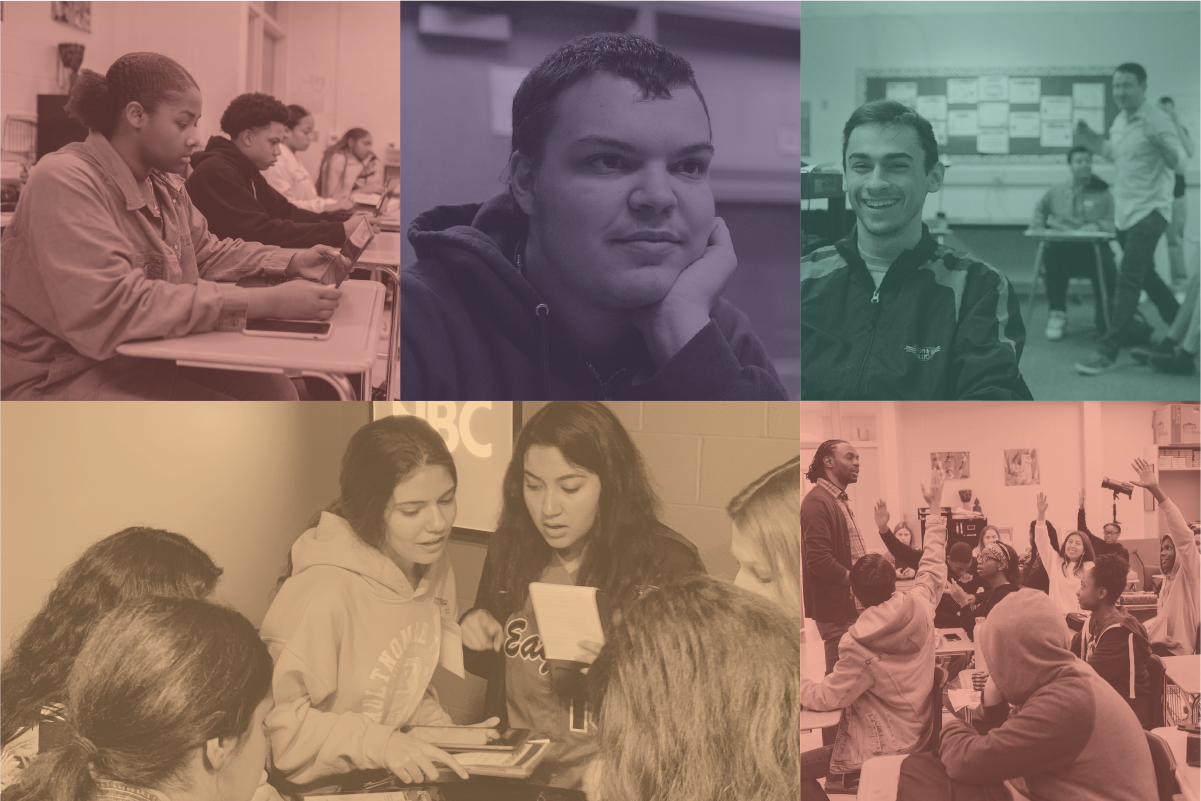
Whenever we are in connection, we learn about ourselves and each other. We entered 2021 with this belief in mind, seeking community with teens and educators to fully understand their challenges, desires, and needs in the classroom and beyond. From our commitment to knowledge-building came co-creation, and the development of new meaningful and collaborative learning experiences that resonate with young people, support their social and emotional development, and meet them where they are through play.
We were happy to release iThrive Curriculum: A Moment in Time, grow iThrive Sim's library with two new scenarios, Follow the Facts and Leading Through Crisis, and launch the Game Design Studio Toolkit after five years of collaboration. After equity reviews of Sam's Journey and Museum of Me, we updated both game-based learning units to include more means of engagement, representation, and action/expression and ensure all learners feel valued, seen, and supported in their genius. At the SEED Institute, we pressed forward in our partnership with Transition HOPE and engaged youth with lived experiences in the cradle-to-prison pipeline via game design, which led to the launch of The RunAround, a board game that highlights the hardships that lie in the journey from 'Maximum Security' to 'Home,' and opportunities to disrupt and dismantle them.
This year, we worked to provide teens with transformative opportunities to see possibilities they never before imagined, open up their thinking about themselves, each other, and the world, and build essential social and emotional skills that support them in stepping fully into their genius. Whether you downloaded an iThrive Curriculum unit, brought an iThrive Sim role-playing simulation scenario to your classroom, or read an article we shared, we appreciate you for the many ways you engaged with us this year. Below is a snapshot of the top five blog posts our readers viewed the most this year:
1. Teens Have Big Emotions. How Can We Help HS Students Navigate Them?: A rapidly developing brain in an increasingly complex world makes for big emotions. How can we help teens cope with them? HS educator and co-author of our game-based learning unit iThrive Curriculum: A Moment in Time Lauren Geschel shares: "recognize them as individuals," "validate their feelings," and "help them be self-aware and deliberate."
2. High School Teachers, Share Your Feedback on the New, Improved iThrive Sim: Read about iThrive Sim's teacher-friendly interface, a feature recently added to the award-winning tool to support high school educators in customizing, facilitating, and steering iThrive Sim's role-playing simulation scenarios in a way that best meets their students' social, and emotional needs.
3. Game-Based Learning Reads: Three Books That Will Make You a GBL Believer: With game-based learning, teachers use play to engage their students in their own learning, embracing student agency over student compliance. Read what seasoned educators and game-based learning experts Matthew Farber, Kat Schrier, and David Seelow say about it in this aggregate book review of their latest reads.
4. Burgeoning Journalists Try on Their Roles in New Media Literacy Game: In this digital age, more data is produced in a second than can be consumed in a lifetime. Our new role-playing simulation game iThrive Sim: Follow the Facts centers media literacy and nurtures players' ability to analyze, evaluate, and report on that data. Read what playing it did for two dozen high school students and burgeoning journalists at the Arizona State University's Summer Journalism Institute.
5. Use this SEL Activity to Help Your Students Process Pandemic Grief and Loss: For teens, grief and loss have been palpable both personally and collectively over the last two years. This social-emotional learning activity invites your students to unpack and process their experiences of these emotions during the pandemic.
As the year winds down, we hope you continue prioritizing connection and wellness throughout the holiday season. Stay connected with us next year by signing up for our monthly newsletter, stocked with updates on our game-based learning products along with exclusive opportunities to try them with your students. Here's to more community, co-creation, and play in 2022.
New Game Design Toolkit Supports Teens in Leading Systems Change
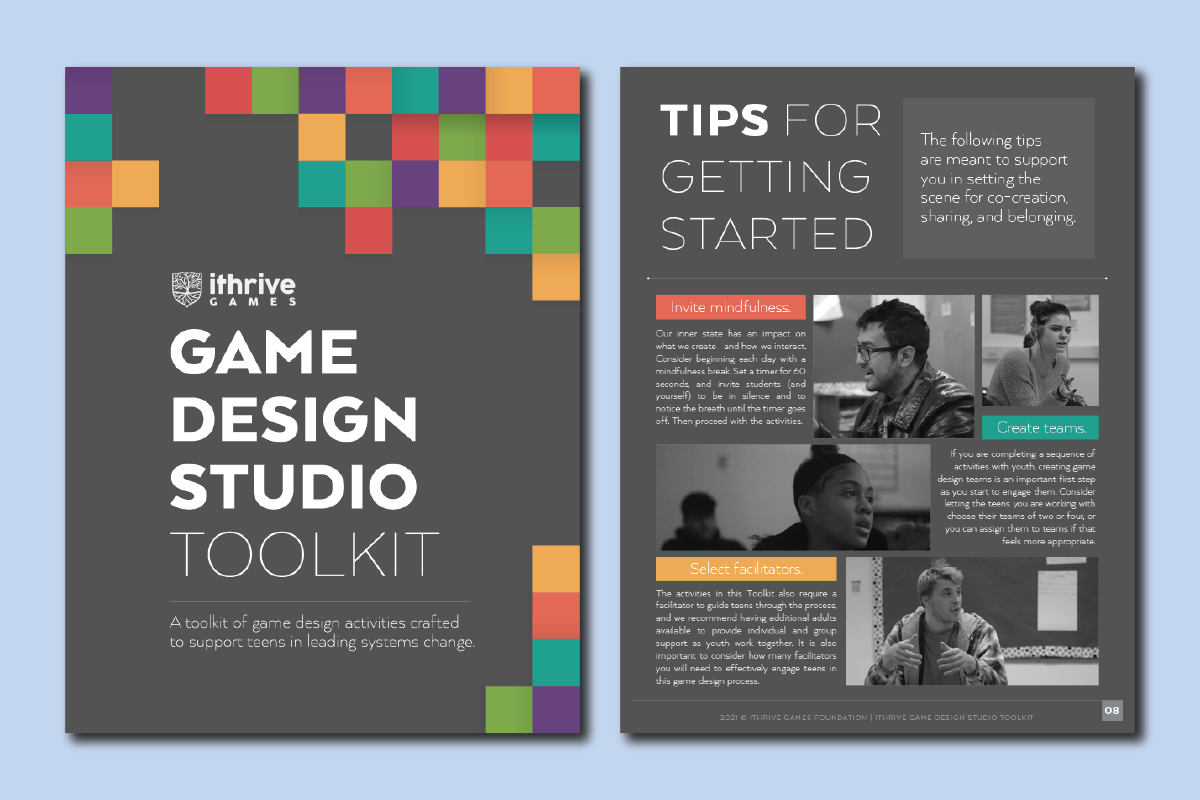
Games are microcosms of the real world, making play and game design springboards for possibility.
At iThrive, we use games to support teens in discovering new ways of doing and being. Our approach centers on their developmental needs, wielding the power of play and emotions to deepen their civic and social and emotional learning. At the core of each tool or experience we've created for and with young people is an unwavering belief in their genius and creative potential to build and imagine a better world. The Game Design Studio Toolkit, created in collaboration with EdTogether and made possible by the generous support from the DN Batten Foundation and the William T. Grant Foundation, assists them in uncovering this within themselves, using game design to reflect, connect, ideate, and lead systems change.
The Game Design Studio Toolkit features 50+ activity guides and accompanying worksheets that merge design thinking, social justice, and social and emotional learning to support teens in exploring societal issues that they experience while thinking collaboratively and creatively about how to respond to them. As teens work through these activities together and create their own games, they engage in individual and collective reflection and action as they challenge their assumptions, redefine problems, and imagine new solutions.
"These field tested activities invite teens to consider their own expertise from their lived experience as they work to understand the systems that surround them," shares Susan E. Rivers, Executive Director and Chief Scientist of iThrive Games. "The activities tap into and build skills like self-reflection and self-expression, empathy and compassion, collaboration and critical thinking as a means to unpack the rules and structures that shape relationships with parents, teachers, and other adults in the many systems teens encounter. Game design offers an amazing, engaging way to merge systems thinking, design thinking, and social and emotional learning."
An identity-safe environment is essential to help teens feel valued, accepted, seen, and welcomed. Tips and design principles found throughout the Toolkit help adult facilitators create this and set the scene for sharing and belonging—two parts integral to co-creation.
"We know that emotion is the driver in learning and in life. It is the thing on which we base our relationships and orientation to the world," says Gabrielle Schlichtmann, Executive Director and Chief Scientist of EdTogether. "With this in mind, we designed the activities in the Game Design Studio Toolkit to fully engage teens in playing games, analyzing games, and making games. The activities tap into and foster their social and emotional skills."
The social and emotional learning opportunities nested in each activity featured in the Game Design Studio Toolkit support the fostering of knowledge and attitudes across each of CASEL's five areas of social and emotional competence: self-awareness, social awareness, self-management, responsible decision-making, and relationship skills. Each activity prompts teens to nurture and exercise these essential skills in areas necessary for individual and collective well-being.
"As youth work together to design games and grapple with important issues, they are developing the necessary SEL skills to make change in their schools, communities, and beyond," shares Lora Henderson, a clinical psychologist, Assistant Professor at the James Madison University, and contributor to the Game Design Studio Toolkit. "We have grown accustomed to manualized social and emotional learning (SEL) programs that teachers implement in the classroom but game design offers a flexible and innovative approach that allows youth to use and further develop SEL skills while also engaging in activities that require both critical and systems thinking."
The Game Design Studio Toolkit invites young people to unpack complex social challenges and understand the human needs involved so they can imagine, create, and test games that prompt new solutions. Built across 5-years of inspiring collaboration with teens and adults across the US, we hope the Toolkit encourages and supports teens in creating the world they want to live in.
Download the complete Toolkit to bring it to the teens in your school, out-of-school program, museum, library, and summer camp today. And let us know how you are using it!
iThrive, Middlebury Institute Awarded DHS Grant for New Simulation Game

Earlier this week, iThrive Games, in a joint project with the Middlebury Institute of International Studies, was awarded one of 37 grants from the Department of Homeland Security (DHS) under the Fiscal Year 2021 (FY21) Targeted Violence and Terrorism Prevention (TVTP) Grant Program.
iThrive Games and the Center on Terrorism, Extremism, and Counterterrorism at the Middlebury Institute for International Studies will work together to create a novel, game-based learning experience that educates and empowers adolescents to become more aware and more resistant to radicalization, thus building resilience within their local networks.
Our approach to role-playing simulations embeds social and emotional learning and integrates tech and online play. iThrive Sim's role-playing simulations illuminate systems in the world that can be largely invisible until a person is invited to work and improvise within them. Experiences like these can propel students' curiosity and motivation to explore new ways of interacting and making decisions that can improve dysfunctional systems, counter extremism, and produce a better world for all.
"Using games to foster belonging and connection is what we are about," said Susan E. Rivers, Ph.D., Executive Director at iThrive Games. "We are saddened by the weaponization of belonging to advance radical agendas. This project is aligned with our mission to use game-based learning to support teens in recognizing true belonging and strengthening prosocial behavior."
Since teens are highly attuned to their emotions and social status, the experiential approach of role-playing meets them right where they are developmentally. The role-playing simulation game that will be created as a result of this grant will be designed to offer students opportunities to think about and practice self-awareness, social awareness, self-management, relationship skills, and responsible decision-making.
Part of the work of the grant will be supporting the local community-building the capacity at the administration and school level for delivery of the game-based learning experience.
According to a press release issued by the DHS, "The FY21 TVTP grants expand on the Department's new approach to prevention, which centers on providing local communities with evidence-based tools to help prevent violence while protecting civil rights and civil liberties and privacy rights. These grants will help local communities strengthen online and in-person prevention efforts, including by addressing early-risk factors that can lead to radicalization and violence."
High School Teachers, Share Your Feedback on the New, Improved iThrive Sim

iThrive Sim, designed to support high school educators in providing a deep civics learning experience role play through the lens of social-emotional learning, will soon be ready for teachers to facilitate! Since its debut, iThrive staff have facilitated the learning experience. We heard that educators want to be in the drivers' seat, running the simulations in a way that responds to their needs. We listened and are developing a new teacher-friendly interface for our three iThrive Sim scenarios that allows educators to run their own simulations in their in-person, virtual, or hybrid classroom.
Are you new to using iThrive Sim with your students? Each game merges online gameplay, immersive tech, and a content-rich storyline to engage HS students in a unique civic learning experience where they step into the role of leaders to make high-stakes decisions that impact the communities they represent. The new, self-guided versions of our iThrive Sim games are a great way to bring play, civics, and social-emotional learning to your high school classroom. Experience the best of our games, with the added benefits of being in the drivers' seat:
- Logistical Flexibility. Need an activity to engage your high school students on the spot? Want to run a simulation over multiple class periods? With self-facilitation for an iThrive Sim scenario, you'll have as much flexibility as you need. No need to schedule your classroom's Sim with a facilitator.
- Customize Roles and Groups. You know your students best. Think a particular student would benefit from a challenge? Or do you have students that are extra competitive or reserved? With you as the facilitator, you will have a full range of assigning roles and groups to meet your high school students' needs best. Place them where you know they will thrive and have the best experience possible.
- Engage with Your Students: Good facilitating fosters authentic engagement. When you know you're leading the discussion, you'll naturally be more engaged throughout the entire simulation and your high school students will too.
- Continued Support: Self-facilitating an iThrive Sim scenario does not mean you'll be totally on your own. When you sign up, you'll receive resources, checklists, prep materials, accompanying lesson plans and more, to support you in running a successful Sim for your class of high school students. Plus, our team is just an email away; we're always happy to answer any questions and provide technical support.
- Tie the Sim to Other Lessons: When you're in the driver's seat of an iThrive Sim scenario, you can easily reference previous lessons you've completed when relevant to the discussion and student experiences. In turn, you can challenge your high school students to draw more connections between content, resulting in a holistic learning experience.
Interested in using an iThrive Sim scenario in your high school classroom?
We're looking for high school educators who can pilot our new self-guided version of iThrive Sim, and give us feedback on the new teacher-friendly interface and process. We know you're busy, so we are paying $100.00 for your time. The pilot program will include:
- A meeting before running an iThrive Sim play session with your students;
- Running an iThrive Sim play session with your students using any of our three games (iThrive Sim: Lives in Balance, iThrive Sim: Leading Through Crisis, and iThrive Sim: Follow the Facts);
- Letting us know when (day and time) you'll run the session so we can be there to support you; and
- A follow-up conversation to hear about your experience
Sign up below and we'll be in touch to get you and your high school students set up to play!
Game-Based Learning Reads: Three Books That Will Make You a GBL Believer
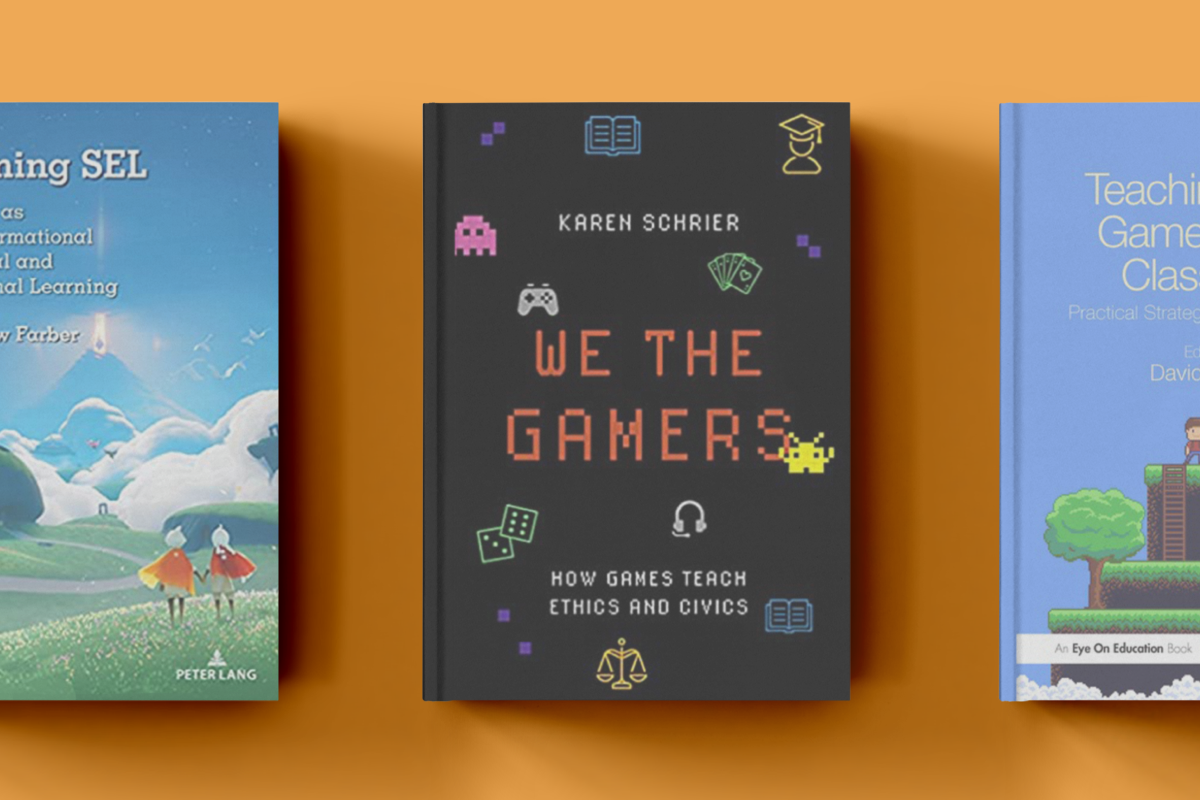
Game-based learning is part of iThrive's DNA as we support educators in bringing the power of play into the classroom. From impactful play and deep learning to personal transformation and social and emotional skill-building, the reasons to thoughtfully include games in educating young people continue to grow. Recently we have enjoyed the contributions of authors Matthew Farber, Karen Schrier, and David Seelow, who have written books adding to the body of knowledge related to game-based learning.
Karen Schrier, We The Gamers: How Games Teach Ethics and Civics
In this useful tome, Karen (Kat) Schrier explores the use of games in multiple contexts, from teaching ethics and civics, to creating connection and community, as well as for knowledge and action, and for critical thinking and inquiry.
Written during the pandemic, the book begins by exploring the many ways games were of great support to humanity during the stay-at-home orders and beyond. The author then takes a balanced approach by questioning when and how best to use games alongside learning, while acknowledging the limitations of games.
For educators who want to explore the power of games in the classroom, this one is a must-read.
Matthew Farber, Gaming SEL: Games as Transformational to Social and Emotional Learning
One thing that comes through in Matthew Farber's book on games and social and emotional learning is his deep love of and expertise in both. And we know that not only from the pages of this book but also because Matthew is a long-time collaborator with the team here at iThrive, having co-created Museum of Me.
Also written during the pandemic, the book is a very readable cornucopia of topics that span first-person accounts of gameplay and thought-provoking explorations of the neuroscience of games to comparing social and emotional learning models and contending with how games do or don't teach compassion, empathy, and mindfulness.
With practical information from links, lessons, and games, to well-woven-in peer-reviewed research, this book is useful to educators and caregivers who want to use games and understand why and how they are an asset for young people.
David Seelow, Teaching in the Game-Based Classroom
In this collection of strategies for game-based learning, editor David Seelow has culled the best teachers, researchers, and games to provide hands-on guidance for adults looking to introduce games into their classroom or youth encounters.
The introduction also stresses the multiple pathways one can take to succeed with game-based learning and ultimately help transform both teacher and student learning.
With contributors such as Paul Darvasi, Lindsay Portnoy, Claudia-Santi F. Fernandes, and more, the strategies offered within span empathy-building and support for wellness to project-based learning and useful feedback loops. A useful book for educators who want to use games to transform learning.
Interested in integrating game-based learning in your classroom this fall? Check out our iThrive Curriculum units and newest iThrive Sim role-playing simulation games, Follow the Facts and Leading Through Crisis, to get started!
World Affairs Council of Philadelphia Uses iThrive Sim to Prep Future Leaders

"My main takeaway from today was how challenging, complicated, and stressful it is to lead through crisis, and how important it is to work with your team in those situations," said one Philadelphia-area high school student after playing iThrive Sim: Leading Through Crisis in the 2021 Summer Global Leadership Seminar hosted in July.
What better way to learn about teamwork and collaborative leadership than to be thrust into the role of a crisis management team member during an international crisis? Twenty-four students had this opportunity through the summer program at World Affairs Council of Philadelphia, a nonprofit dedicated to informing and engaging people of all ages on matters of national and international significance. Each year the organization hosts an educational seminar for high school students who are interested in global affairs, public policy, and foreign policy.
This year, the Council opted to use iThrive Sim: Leading Through Crisis as part of its virtual programming. Staff said they thought the tech-enabled role playing simulation would be a really interesting addition to the summer program.
"One of our main topics for this leadership session was about constitutions and constitutional underpinnings of authority," said Eric Bumbaca, Director of Student Programs. "The Leading Through Crisis simulation was a really good opportunity for our students to engage with constitutional issues and times when our constitution isn't necessarily clear or events around it cause some uncertainty."
Students agreed. When asked what they learned, one student shared, "[I learned that] when leaders make choices, they aren't necessarily able to do what they feel is best, but rather they have to do what they think is best within the pressing circumstances of the decision."
Other students focused on the collaborative leadership and teamwork aspects, offering feedback such as, "It was fun to work through as a group," and "It was fun being able to learn about how to handle constitutional crises with other people."
Council staff shared that role-playing without tech allows for one to three decisions across the course of the event, but with tech-enhanced role-play, the negotiations have an amplified level of collaborative and individual decision-making.
"The rapid decision-making is a very unique aspect of the iThrive program," said Eric. "With iThrive Sim you need to make decisions quickly and synthesize your rationale and reasoning for decisions very quickly. It's good practice for the students, and the roles that they are playing do need to make decisions rapidly."
Students enjoyed the tech aspect of the simulation. One student shared, "It was very immersive, and the interface was surprisingly easy to follow."
They also keyed into the social and emotional learning competency of responsible decision-making, a skill vital to 21-st century leadership.
"I really liked the entire simulation and decision-making aspects, because having to coordinate with my team members and make solo/duo/team decisions in very little time was stressful but fun."
Council staff are excited to use iThrive Sim again in their program.
"I think our students really enjoyed the opportunity to engage in a different way than they have in the past," said Eric. "Any time we ask them to get outside of their own belief systems or view of the world, it's a great opportunity for students to think about the world in different ways."
Interested in bringing iThrive Sim: Leading Through Crisis to your classroom this fall? Sign up today to get started!
iThrive Sim: Lives in Balance Wins Gold at AAM’s 2021 Muse Awards
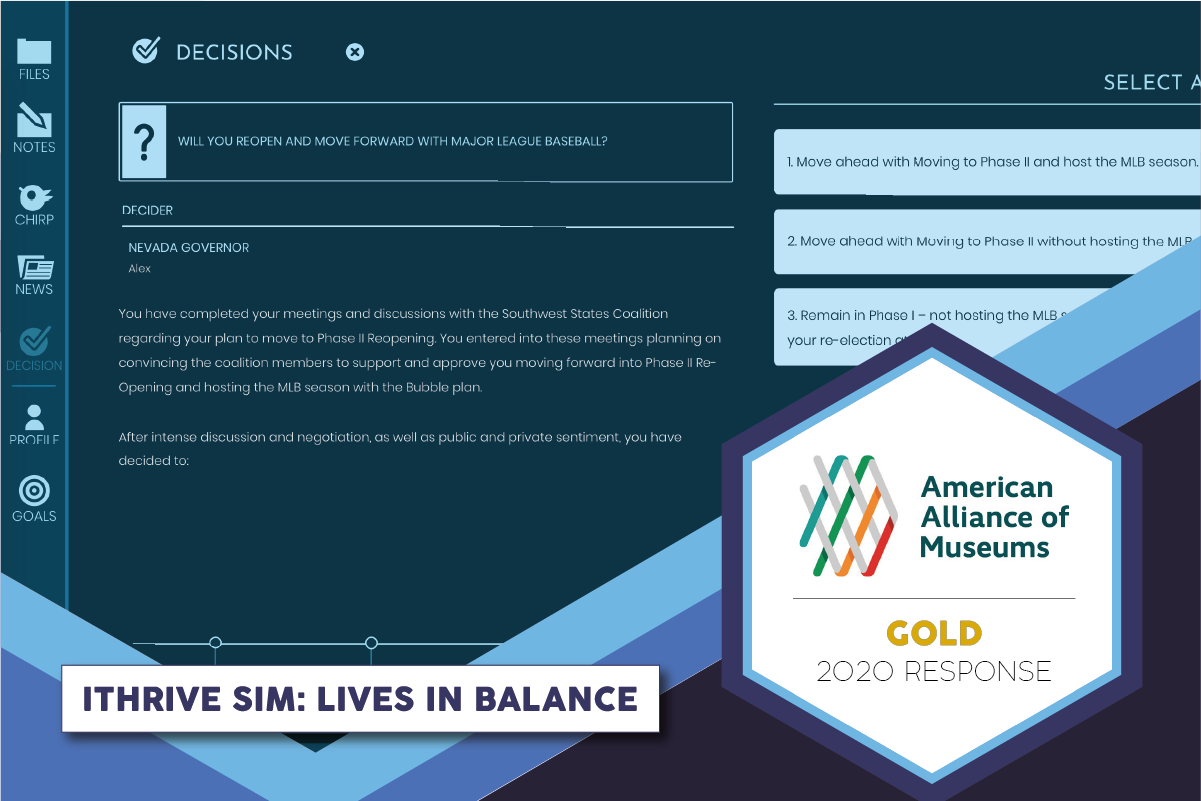
BOSTON-iThrive Sim: Lives in Balance has been named a gold award winner in the MUSE Award 2021's 2020 Response category. Created by iThrive Games in partnership with Ronald Reagan Presidential Library and Museum, iThrive Sim: Lives in Balance is designed to meet the need for engaged, authentic, and relevant learning experiences. This scenario thrusts the participants into a fictional, modern day pandemic where federalism comes to life as they take on the roles of government officials. The scenario has been successfully used with museum-based hybrid and virtual visitors, and in traditional educational spaces virtually, hybrid, and in person.
According to the website for the MUSE Awards, "The Media & Technology MUSE Awards recognize outstanding achievement in Galleries, Libraries, Archives or Museums (GLAM) media. Presented to institutions or independent producers who use digital media to enhance the GLAM experience and engage audiences, the MUSE awards celebrate scholarship, community, innovation, creativity, education and inclusiveness."
Susan E. Rivers, PhD, Executive Director and Chief Scientist at iThrive, sees tech-enabled role-playing as one of the most adaptable forms of interactive learning, whether it's in a classroom or at a museum, in person or online.
"When we created Lives in Balance, we sought to meet the tremendous demand for robust interactive learning experiences, especially during this global pandemic," she said. "And we are pleased to be able to offer this scenario and others as we head into the new school year to support learning in various settings."
iThrive Games offers two additional iThrive Sim civics scenarios for learners who are high-school aged and older: Leading Through Crisis, which explores responsible decision making during a critical event, and Follow the Facts, which explores media literacy during a natural disaster.
"I am grateful for our exceptional advisory board of educators and the students who have played with us and shared their wisdom," said Mira Cohen, Director of Education at the Ronald Reagan Presidential Library and Museum. "It's been a dream to empower youth learners with the decision-making tools to become thoughtful and caring leaders.
To learn more about iThrive Sim, visit https://ithrivegames.org/ithrive-sim/. To learn more about additional programs at Ronald Reagan Presidential Library and Museum, visit https://www.reaganlibrary.gov/.
###
Media Contact
Eghosa Asemota
eghosa.asemota[at]ithrivegames.org
About iThrive Games
iThrive Games prepares teens to thrive by meeting them where they are and working in partnership towards a world where all have the voice, choice, and agency to reach their full potential. We use games and game design to equip teens with the social and emotional skills they need to be healthy and resilient.
Add Play to Your Summer School Schedule: Virtual Conferences in July

After an unprecedented year, summer school programs are underway in several states across the nation, with an increased focus on students' social and emotional health. Game-based learning uniquely aligns with the times. When games are used in the classroom, they offer students a space to immerse themselves in new information, actively apply that information while problem-solving, try on new perspectives, and work in self-directed independent ways. The connective power of games also supports community-building and empathy, making play a springboard for responsible civic engagement.
As school administrators and teachers explore ways to enrich their classrooms this summer and later this fall, we're excited to continue putting game-based learning and SEL front and center at upcoming conferences where iThrive staff will be presenting. If you're interested in bringing games to your summer school program or classroom next school year, here are some interactive meetings to put on your calendar this month:
2021 Games for Change Virtual Festival (Monday, July 12th to Wednesday, July 14th, 2021)
The 2021 Games for Change Virtual Festival will feature virtual sessions hosted by an array of thought leaders on the transformative power of games and immersive media. iThrive's Executive Director and Chief Scientist, Susan E. Rivers, Ph.D., will be part of a session titled "Disinformation Games," where she'll discuss iThrive Sim: Follow the Facts, our new role-playing simulation game that supports media literacy skill-building. Join in on the session happening on Wednesday, July 14th at 5:30 ET/2:30 PT for a rousing discussion by registering here.
2021 NASSP National Principals Conference (Wednesday, July 14th to Friday, July 16th, 2021)
The theme of this year's NASSP National Principals Conference is "Together, We Will," with strands centering on equity, wellness, and innovation. We're excited to share our vision of how play supports each of these strands with all who'll be in attendance. In our interactive session, attendees will play iThrive Sim: Lives in Balance, our online role-playing simulation game that focuses on federalism and states' rights and uses a pandemic as the backdrop for practicing negotiation and decision-making. Players, acting as state governors and federal officials, will be tasked with moving the action forward themselves, aided by online gameplay and iThrive Sim's dynamic tech. They must work individually and as a group to assess the information at hand, defend their points of view, and make decisions that produce the desired outcomes in time. Register here to attend this conference, get in on the game, and learn how play can enrich your summer school program or school this fall.
More Ways to Meet
This fall, we'll be back on the road, virtually and in person, to share more on games, play, and their contribution to students' academic growth and social and emotional learning. There are many ways to engage with us. Learn about our game-based learning curricula and role-playing simulation games guaranteed to boost student engagement in your summer school classroom. Send us an email. Or sign up for our newsletter to stay in the loop with exclusive playtesting opportunities.
We look forward to connecting with you!
Learn about the Power of Play at these Upcoming Conferences

2021 SERIOUS PLAY CONFERENCE
The Serious Play Conference this year features different tracks and multiple sessions with the common theme of using games or simulations in training and education. Our session on Wednesday, June 23, 2021 from 2 to 3:15pm ET will be presented by Executive Director and Chief Scientist Susan E. Rivers, Ph.D., and Senior Director of Communications Nicole Taylor. Stress Storm/New Norm: How Role-Playing Simulations Can Help will explore how role-playing simulations can be used in the workplace to assist leaders in identifying opportunities for coaching people managers and staff members.
The ability to practice social and emotional skills such as self-management, emotional awareness, social awareness, and responsible decision-making under stress is necessary for a healthy culture and optimal performance. Being able to observe how leaders perform under stress is a high-value opportunity provided by role-playing simulations. Using iThrive Sim: Lives in Balance, Susan and Nicole will share how a role-playing simulation can be used both to observe stress behaviors, assist people managers in identifying and working with their stress response, and provide opportunities for coaching to improve how staff members manage themselves and others. If this lights you up, register here.
2021 ASCD CONFERENCE: EMPOWERED AND CONNECTED
The theme for this year's ASCD conference is Empowered and Connected. The annual conference is full of sessions that will accelerate your summer learning plans and help get you prepared for the school year. At our session, Susan Rivers will be joined by educators Paul Darvasi and Mira Cohen to present Play to Thrive: A Game-Based Approach to Social and Emotional Learning for High Schools. If you're heading to ASCD, this session will allow you to:
- Walk away with free, classroom-ready game-based social and emotional curriculum and tools to use immediately for in-person and distance high school humanities courses.
- Understand how game-based learning approaches align with teens' specific developmental, social, and emotional needs.
- Discover a roadmap for infusing core curriculum with playful, tech-supported interaction for high school students' social and emotional growth.
Sound useful for your classroom? Register for ASCD Empowered and Connected.
COALITION FOR JUVENILE JUSTICE (CJJ) 2021 ANNUAL CONFERENCE
The Coalition for Juvenile Justice (CJJ) is a nationwide coalition of State Advisory Groups (SAGs) and allies dedicated to preventing children and youth from becoming involved in the courts and upholding the highest standards of care when youth enter the juvenile justice system. At CJJ's 2021 virtual annual conference, iThrive's Susan Rivers, Transition HOPE's Janelle Ridley and iThrive youth designer Bernardo S. will be sharing a session on Friday, June 11th from 10 to 11:30am ET entitled "Designing Games with Youth Experts to Dismantle Unjust Systems." They'll share the story of youth game designers who created a game called The Run Around to delineate their lived experiences in the juvenile justice system and advocate for changes to it. They'll also share how decision-makers can bolster supports for the well-being of incarcerated youth. You can register for this event here.
MORE WAYS TO CONNECT
Next month, we'll share the conferences iThrive is presenting at for the remainder of the summer. There are many ways to engage with us, and we look forward to connecting with you.
iThrive Sim: Lives in Balance Named a 2021 GLAMi Award Winner

BOSTON--iThrive Sim won a bronze award in the GLAMi Award 2021's Interactive and Immersive category. Created by iThrive Games in partnership with Ronald Reagan Presidential Library and Museum, iThrive Sim is an innovative virtual augmented reality experience that provides an opportunity for meaningful and engaging experiences. The sim is currently used with museum-based, hybrid, and virtual visitors, and in traditional educational spaces.
According to the website for MuseWeb, the host of the GLAMis, "The annual GLAMi (galleries, libraries, archives, and museums) Awards recognize and celebrate innovative projects in the cultural heritage sector."
Susan E. Rivers, PhD, Executive Director and Chief Scientist at iThrive, sees immersive games as a true opportunity to support visitors in social and emotional learning: "Play is important for all of us," she said. "It brings us together in community. Play helps us create new solutions to problems...solutions we wouldn't have thought of otherwise."
iThrive Games is pleased to offer three iThrive Sim civics scenarios for learners who are high school aged and older: Lives in Balance, which explores collaboration and compromise during a pandemic, Leading Through Crisis, which explores responsible decision making during a critical event, and Follow the Facts, which explores media literacy during a natural disaster.
Mira Cohen, Director of Education at Ronald Reagan Presidential Library and Museum, says the virtual simulation was an important way to keep visitors connected during the pandemic, and beyond. "Through engaging audiences in meaningful and fun in-depth experiences, using historical records and government documents, we are able to increase our audience base, keep our current audience base engaged and further appreciation for the value of record keeping to our democracy, she said."
To learn more about iThrive Sim, visit https://ithrivegames.org/ithrive-sim/. To learn more about additional programs at Ronald Reagan Presidential Library and Museum, visit https://www.reaganlibrary.gov/.
###
Media Contact
Eghosa Asemota
eghosa.asemota[at]ithrivegames.org
About iThrive Games
iThrive Games prepares teens to thrive by meeting them where they are and working in partnership towards a world where all have the voice, choice, and agency to reach their full potential. We use games and game design to equip teens with the social and emotional skills they need to be healthy and resilient.
Exploring Juvenile Justice and Mental Health with Teen Game Designers (Part 2)
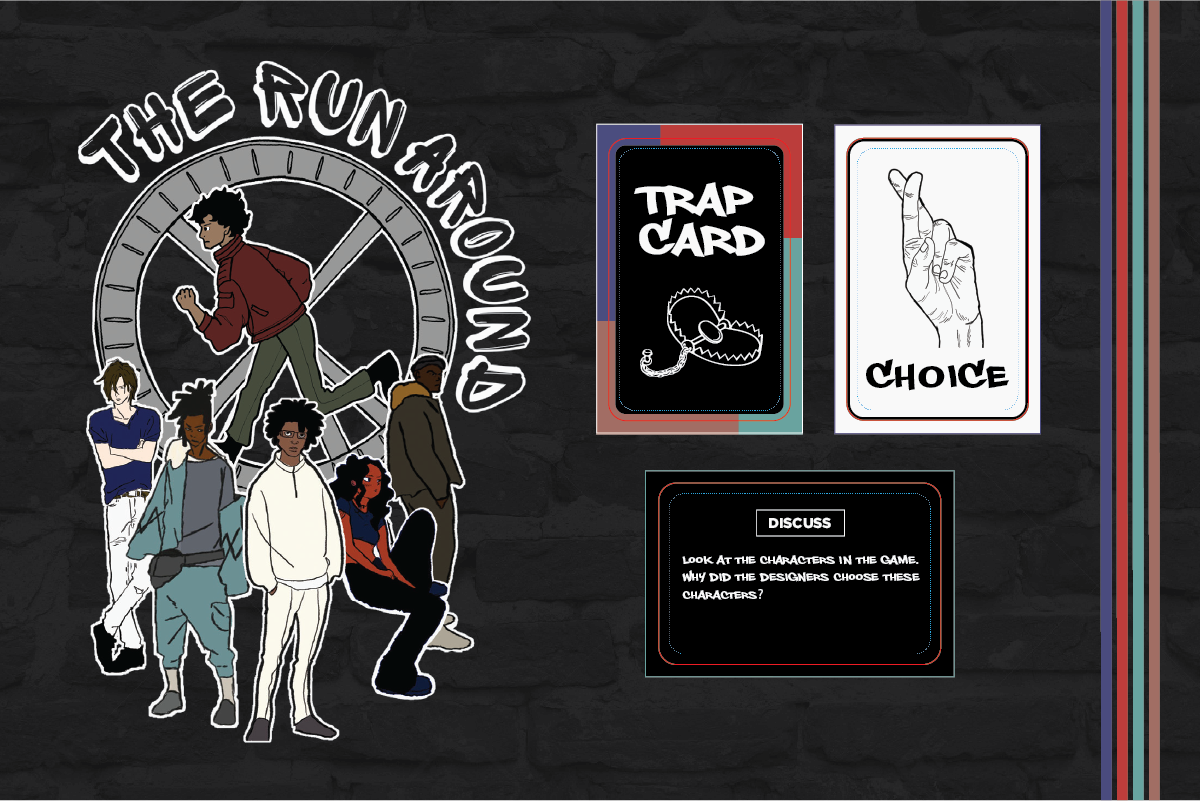
Part 1 of this series includes an overview of iThrive's Juvenile Justice System project and the framework for the Game Design Studio program. Click here to read Part 1.
It's called The Run Around. The goal of the board game is to be the first player to move all of your game pieces out of Maximum Security prison to Home. It's hard. It's frustrating. There are tons of setbacks. And it reflects the experiences of the youth designers who made it. The creative act, in the game design process, is part of how the designers cope with their experiences.
‟We tried to shape the game the way the justice system is," said K.C., one of the designers of The Run Around. ‟And we tried to base our directions and rules on what would happen in real life. One of them was like, when we are on parole or talk to our case worker, any little thing can get us put back into the predicament that we were in before. So we made the rules and regulations in the game to show that. It was to show how hard it is for you to get out."
While the subject matter was intense, K.C. found the design process enjoyable.
‟It was so fun," she said. ‟It was fun to see the finished product. It was fun making the rules and seeing other people get frustrated playing it [because our experience in the system is just as frustrating]. It was like when we were making the game, we were making it so people would get irritated because they wouldn't be able to win. And then seeing that they really did get mad. It was fun watching it become what it is now."
Another game designer was lit up by the aesthetic of the game.
‟I like the graphic designs of what we created," said R.D. "I like the clothes they have on. It looks very much like society right now."

K.C. agreed, saying, ‟They each have their own individuality."
Players advance their character through the game via the Choice cards. The Choice deck is stacked though. Only a few of the cards will actually allow you to leave prison. But watch out for traps! Landing on a Trap spot—and there are many—will cause you to move backward, lose a turn, or be sent back to prison.
R.D. sees the toughness of the game as a key design choice to add realism.
‟For guys who have been in jail, I feel like they can relate to it," he said. ‟A lot of stuff said in the scenarios in the game...it's realistic."
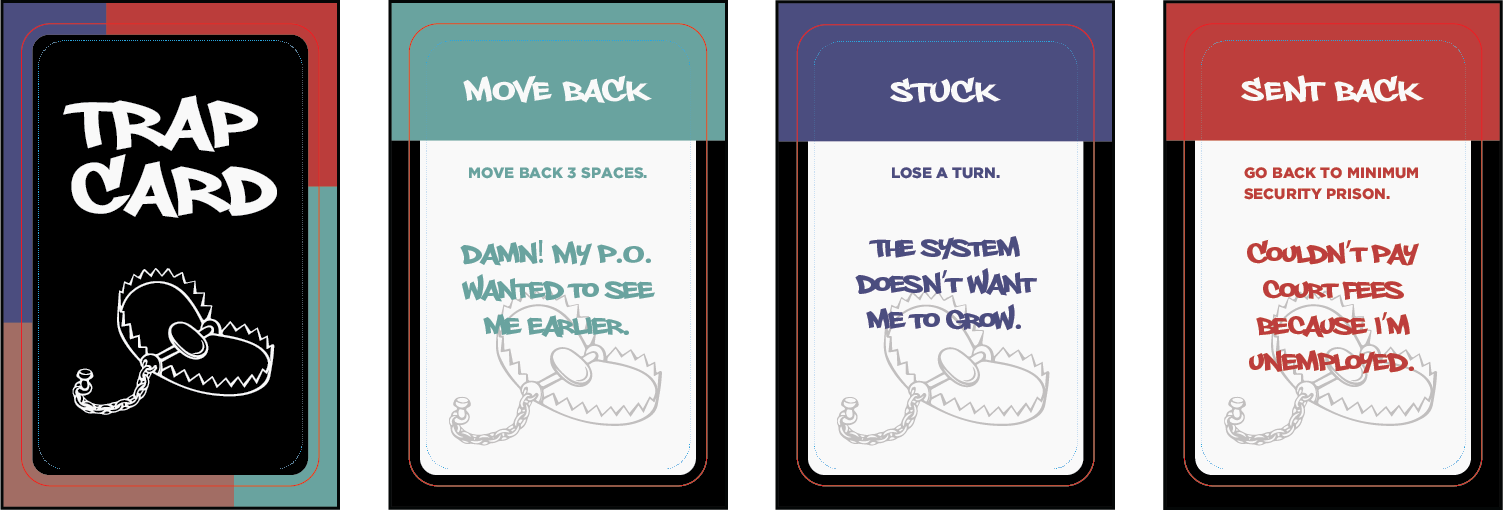
The game designers put a lot of intentionality into the design of the six characters, named Naomi, Marven, Jay, James, Ty, and Ace.
‟I created Marven," said M.A. "I relate a lot to Marven because my charge was similar. He gets caught up with friends and drugs and has to go to trial. People rat each other out."
For M.A, it wasn't just the circumstances that he channeled into the game. It was also the emotions.
‟The same thing with depression and anxiety happened to me while I was waiting for trial," he said.
And the final step of the game design process, which is to act, is set to happen over the next few months. The game designers will use The Run Around in workshops they are both designing and facilitating for stakeholders from the juvenile justice system in Boston beginning in May. They are also set to share their experiences at Games For Change this June. They are hoping that by sharing their experiences, decision makers can begin to create better support for youth who are system involved.

‟Anyone who goes through this has these feelings and the fact that it's a person of color doesn't make it any better," said M.A.
Exploring Juvenile Justice and Mental Health with Teen Game Designers (Part 1)
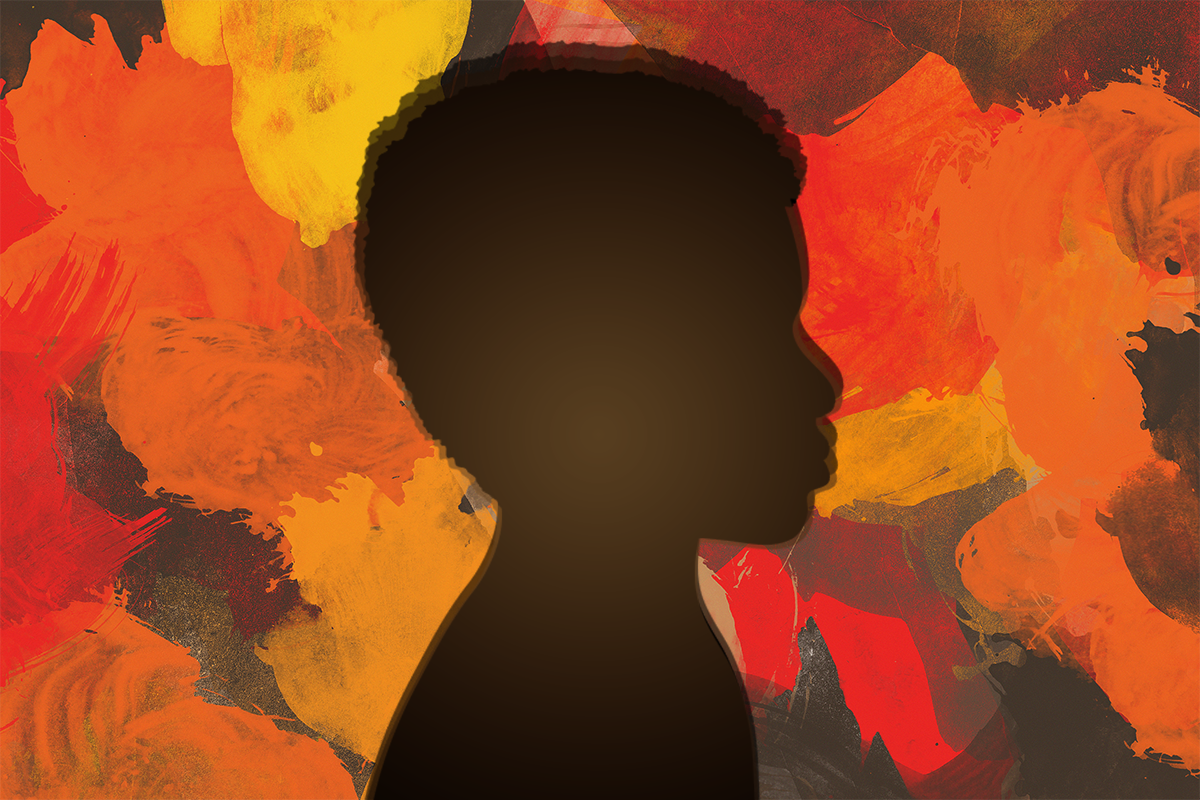
Since 2019, iThrive Games has been collaborating with partners to use games and game design to highlight the voices of Black youth involved with the juvenile justice system. Inequity in the provision of mental health services on the basis of race before, during, and after system involvement negatively impacts the health, well-being, employment opportunities, educational attainment, and relationships of individuals of color. Youth in our program use game design techniques to express their lived experiences with the justice system. They use the games they design to engage stakeholders in conversations about the inequities within the system and to identify how the systems could be improved to better meet the mental health needs of other young people who are subjected to the cradle-to-prison pipeline.
The current cohort of youth hails from Boston. The participants have been system involved at some point of their lives and now have a round of game development under their belts. For the purposes of this article, we'll use initials for the names of the participants.
These youth designers enhanced and completed a game called The Run Around, which was initially prototyped by an earlier cohort. The Run Around board game helps youth-serving adults and stakeholders understand how youth feel and explore opportunities to improve services and experiences for youth. The gameplay provides an opportunity to have important conversations around critical questions for supporting youth: how can we help youth who are getting out of the system reintegrate successfully to stable living? How can we better understand the feelings and behaviors young people grapple with to provide the support they need before being swept into the system, and while in the system?
The youth designers created this game using iThrive's "Surfacing-Coping-Acting" co-design cycle. The goal of this approach is to invite teens to raise up (surface) and work productively (cope and act) with the experiences that make adolescence both an incredible and vulnerable developmental stage.
"Social and emotional learning happens in community," said Susan Rivers, Executive Director and Chief Scientist of iThrive Games. "Belonging is key to our sense of wellbeing-especially so for teens as their brains continue to develop. Our co-design process not only supports well-being of the youth designers at this moment, but it also allows them to pay it forward by suggesting wellbeing supports for other youth who are involved with the system."
In the surfacing part of the design cycle, the youth designers shared some of the experiences they had when they were involved with the system. By sharing their experiences with each other, they validated one another's experiences and did the healing work listening and being listened to. Sharing difficult stories with others is one proven way to manage the discomfort and to challenge any fears that we're different or alone in our struggles.
K.C. shared what she thought was most important for people to understand about her experience.
"...It isn't easy at all. And we do go through struggles that we need help with," she said. "The world needs to know that the minority community goes through. It's sad that a lot of people in the world don't understand how messed up the justice system or school system is for minorities in the US today."
M.A. found that using his experience to design a game reinforced something he felt he already knew.
"It wasn't a surprise but when I saw it being implemented in the game, I thought, oh, that's dope," he said. "The only white character in the game starts off in minimum security. That was an insight...because he's white he goes in minimum not maximum."
"Game design has the power to help youth understand the systems that impact their lives," said Janelle Ridley, Founder of Transition HOPE. "In community, by sharing experiences and reflecting together, they can move toward how best to use their own agency to impact those systems."
The act of sharing and creating together offered an opportunity for social and emotional learning for the game designers.
"I knew it took a lot to make a game," said M.A. "It takes more than a lot. It takes everybody. Everyone brings a different skill. It takes a lot of teamwork. That's what I took away from the experience."
Part 2 of this series will explore the creation of the game and plans to share it with stakeholders.
2020 Wrap-Up: A Gameful Year of Connection, Creativity, and Play

2020 was not an easy one by anyone's standards. Educators scrambled to learn how to deliver distance learning and to change all of their lesson plans to an online format. Students struggled with the loss of much of their in-person social life and with the transition to learning from home. Parents managed working while trying to help their children with online learning. And nationally, as we grieved our pandemic-related losses, we also collectively faced systemic racism, with many finding ways to begin to make changes from where they stood.
While not easy, there was still the opportunity for social and emotional learning and joy in 2020. Whether we found new ways to connect with family and friends through play online or whether we had a lot of obstacles to overcome, we made it—because we are still here.
Like everyone else, at iThrive we had our ups and downs and lots to adjust to in 2020. We were happy to officially release iThrive Curriculum: Museum of Me, to collaborate with educators on the creation and release of iThrive Curriculum: Sam's Journey, to playtest our new role-playing simulation, iThrive Sim, with over 400 students, and to collaborate with our colleagues at the Situation Room Experience to create the civics-based Lives in Balance and Leading Through Crisis scenarios for our simulation game.
We appreciate you for the many ways you engaged with us, whether it was downloading one of our game-based learning units, attending one of our webinars, playtesting our role-playing simulation, or reading our articles. Below are the blog posts you read the most this year.
Top Five Blog Posts of 2020:
- Social Distancing and Staying Connected Through Games: Read about how playing games together at home can relieve stress, bring joy, and foster connection.
- Urban Assembly Students Create COVID-19 Choose-Your-Own-Adventure Story: Read about our first virtual Game Design Studio, held with students from Urban Assembly. We co-designed an interactive story game reflective of the students' experiences navigating the social upheaval of the pandemic.
- COVID Self-Care Package: Practicing #SELatHome: Try out our 14-day challenge to practice social and emotional learning (SEL) and self-reflection at home. Social and emotional skills are even more useful in times of confusion, crisis, and abrupt change.
- Games to Play While Social Distancing: MMORPGs: Read about how massively multiplayer online role-playing games (MMORPGs) can be a safe space to wander, explore, and connect with others.
- Staying Connected While Social Distancing: Games for Emotional Coping: Take a look at our gameful recommendations to help you practice self-care, savor life's best moments and experiences, and turn inward to explore, accept, and express what's challenging about this moment.
We hope that each of you has a wonderful holiday season. We'd love to stay connected with you. Click here to receive our monthly newsletter with resources and updates. Here's to more creativity, connection, and play in 2021.
The Power of Play: Finding Hope and Community in World of Warcraft
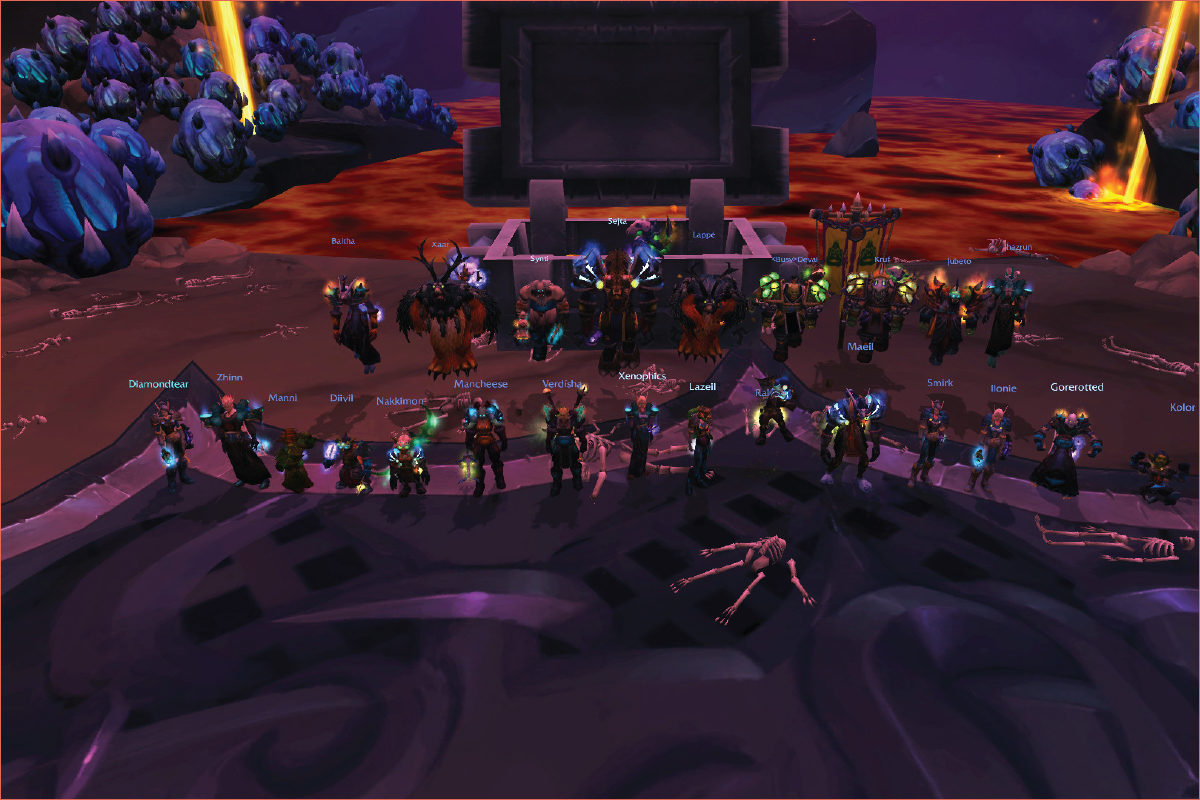
For many young people, games like World of Warcraft are more than play. Games provide a place to connect, a place to explore, and a place to learn. At iThrive Games Foundation, we have seen firsthand how game play can support teens in thriving, whether it's in the classroom or amongst friends playing together online.
Earlier this year, we asked teens from a high school in Philadelphia to share a bit about their experiences with games. For extra credit in their sophomore English class, a few students shared their thoughts on questions such as, "How do games help you deal with life? What games are meaningful to you and how do they help you better understand yourself or the world? How do games help you question the way things are in the world?"
As part of the Power of Play series, we'll be sharing their insights on play, from video games to card and board games. To protect their privacy, their reflections will be shared with initials rather than full names. We hope these stories illuminate the power of game play as seen through the eyes of these young people.
Finding Hope Through World of Warcraft
B.P., High School Student from Philadelphia, PA
"Video games are a waste of time for men who have nothing else to do. Real brains don't do that." These words were by Ray Bradbury, a famous writer and a pioneer of the science-fiction genre in the 20th century. Fahrenheit 451, one of his most well-known stories, foretold a dystopian society with remarkable technological advances similar to our modern world, and people were addicted to and disconnected by it. Bradbury regretted his accurate predictions, and hoped such a world did not occur. As a consequence, he despised gaming and believed that it was a meaningless hobby. His mentality is not unique and it is still popular, among many, to shun video games for being childish and a waste of time. However, I greatly disagree. From my experience, gaming is a worthwhile pastime, tremendously connective, and offers as many insights into life as books.
I was raised in a complicated and toxic household. When my parents divorced and my childhood best friend committed suicide, I was in a grim and lamentable place. Since I was an only child, I did not have anyone to consult about my problems. Often, I would hide in the bathroom and silently cry alone. On one Thanksgiving night, my older cousin found me sobbing in the dark. After he calmed me down, he proceeded to nonchalantly play a game on his laptop.
"World of Warcraft," I said out loud, curiously, since it was my first encounter with the world of gaming. He noticed my interest and offered me a chance to play it. Completely ecstatic, I picked one of his coolest-looking heroes—an undead warlock. After staying up all night playing the game with my cousin, I fell in love with World of Warcraft. Later, he allowed me to use his account and introduced me to his guild (in the game, players can join guilds and play the game together). From the guild, I have met amazing people who are unbelievably nice. One of the members of the guild that I interacted with was a therapist from Europe who plays the game in his free time. We would often farm monsters for drops, and talk about personal issues or life lessons while playing the game together. He helped me learn about the importance of mental health, and building healthy coping habits to deal with stress.
Although we both no longer play the game together or keep in touch with one another, he has made a considerable impact in my life through the amazing connectivity gaming enables. Furthermore, gaming allowed me to understand the importance of companionship and strategization in a way that no other form of entertainment could teach. In essence, gaming is not just a simple time waster. It has the power to connect people like no other media can. I wish more people could understand that gaming is so much more than ten year olds playing Angry Birds or sweaty thirty year olds in their mother's basement.
Power of Play: Finding New Friends and Perspectives in Destiny

For many young people, video games like Bungie's Destiny 2 are more than just play. Games provide a place to connect, a place to explore, and a place to learn. At iThrive Games Foundation, we have seen firsthand how game play can support teens in thriving, whether it's in the classroom or amongst friends playing together online.
Earlier this year, we asked teens from a high school in Philadelphia to share a bit about their experiences with games. For extra credit in their sophomore English class, a few students shared their thoughts on questions such as, "How do games help you deal with life? What games are meaningful to you and how do they help you better understand yourself or the world? How do games help you question the way things are in the world?"
Below, one teen shares their insights on play and the video game, Destiny in their own words. To protect their privacy, their reflections will be shared with initials rather than full names. We hope these stories illuminate the power of game play as seen through the eyes of these young people.
Finding New Friends and Perspectives in Destiny
A.C., High School Sophomore, Philadelphia, PA
Gaming has been a great tool in my life for learning lessons about people and life. They allow you to expand your perspective on a multitude of things while having fun. Gaming has brought many friendships to my life and I am happy about it. One game in particular I would like to talk about is Destiny.
To begin, Destiny is an open world game where you choose between three classes: Warlock, Hunter, and Titan. You wake up from death with the help of a ghost, a little exodroid that can restore your life force. He has been searching for you for thousands of years. You wake up earth but many years later where aliens have conquered the planet and humans have moved to a safe haven named the tower. This is where your journey begins.
Once you make it to the tower, they begin telling you all of the stuff you can do to power up your character and the lore behind what's going on. The main protectors of the tower are the vanguard that are made up of the three classes mentioned above—Zavala, Ikora, and Cayde-6. You can go through most of Destiny as a solo player but they allow you to be in a group up to six.
Destiny provides so much never-ending content you can play multiple hours a day and still have a plethora of stuff to do. This helped me a lot because I was able to talk to my cousin Jalen more often while playing, since I couldn't see him as often as I wanted to. We stayed up countless nights trying to get better than each other.
We ran into other people who wanted to do the same and just had so much fun. You can join a clan in this game where it allows you to become a group of friends so you can do encounters together. We joined one about a year ago and we have run into so many good people in the world. They are just regular people trying to have fun. We roast each other on who is the best in the clan or if you can hold your own weight. They just try to make you better at the game. It also made me a better person.
Destiny was a gateway for me to play other games and get to know people I have not met in person. Games, in my opinion, are crucial so you can see how people work and the lessons you will learn in life. I'm glad I was able to expand my perspective on the world while having fun in a never-ending game.
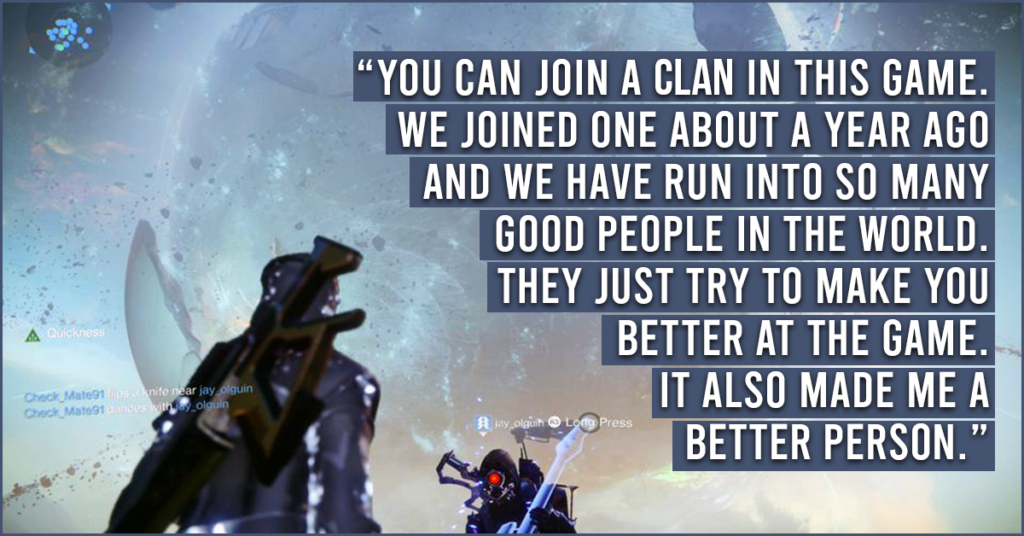
Check out our Game Guide for Destiny 2 for SEL-inspired themes in the game and discussion prompts crafted to invite depth to gameplay.
Call for Abstracts: Volume 3 of Journal of Games, Self, & Society

Journal of Games, Self, & Society (JGSS), a peer-reviewed journal created and edited by iThrive Games and published by ETC Press, publishes original research and scholarship examining the benefits to humans and to society when games include humanity as a core design element. We encourage interdisciplinary research, community, and conversation focused on how games, game design, and gameplay contribute to a deeper understanding of learning, health, and humanity. We enthusiastically seek original works that push the boundaries of what we know—or what we think we know—about the qualities of games that can benefit our lives emotionally and socially.
The theme of our next issue is games as fuel for connection and transformation for teens.
As society navigates the COVID-19 pandemic and charts a path forward, games continue to be integral to learning and connection at home, in our communities, and in educational spaces (be they virtual or physical). This is especially true for adolescents. We seek papers that highlight real-world applications of the science of gameplay's benefits for relationships, learning, and well-being during this critical developmental period.
We are pleased to announce that Claudia-Santi F. Fernandes and Grace Collins will join us as guest editors for this issue.
We invite educators, researchers, scholars, and game designers from across academic disciplines and industries to submit extended abstracts for consideration in the next issue of Journal of Games, Self, and Society.
Successful abstracts will meet the following criteria: (1) examine the use of games in settings with teens with a focus on relationships, learning, or well-being; (2) demonstrate applications of or commentary on theory and/or an evidence base, (3) are found to be of good fit, adequate rigor, and theoretical or practical soundness, and (4) make a new contribution to the field. We encourage submitted manuscripts to consider and include implications for theory, policy, and/or practice in the discussion section.
Manuscripts published in the journal typically include empirical research using qualitative or quantitative methods (including case study approaches); literature reviews, and detailed descriptions of the game(s) or game design that is the focus of the piece. Submissions may focus on the design approach and analysis of a specific game, use of one or more games in learning settings, applications of policy, or other innovative approaches examining the journal's area of impact.
Please explore previous issues of the journal for examples of works previously published. The journal audience is interdisciplinary and includes designers, researchers, educators, and other practitioners.
Extended abstracts are due by November 20, 2020. Invitations for full articles will be made in November. Full papers are due by May 1, 2021, and will undergo blind peer review. Notifications of acceptance will follow in May 2021 and revisions will be due by July 1, 2021. Accepted works will be published in Volume 3 of the journal in the fall of 2021.
How to Submit
Extended abstracts should be anonymized and follow APA formatting. Abstract should not exceed 1,000 words, excluding references. Please include in your abstract a brief introduction to your research topic, an overview of the theoretical or empirical underpinnings and relevant literature, methodology (if relevant), findings of interest, and implications for theory, policy, and/or practice. Abstracts should also include a brief statement about how the full paper will address the topic of this issue—games as fuel for connection and transformation for teens—and how it advances the mission of the Journal of Games, Self, and Society to foster a deeper understanding of learning, health, and humanity through games.
Abstracts should be sent to jgss@ithrivegames.org no later than 11:59 PM ET on November 20, 2020. More information about the journal can be found here.
About Our Guest Editors
Claudia-Santi F. Fernandes, Ed.D. LPC, MCHES, NCC, is associate director of the play2PREVENT Lab at the Yale Center for Health & Learning Games and an associate research scientist at the Yale School of Medicine. Claudia is an adolescent (mental) health expert with experience in public schools, clinical settings, and research institutions.
Grace Collins is founder and CEO of Liminal Esports. Grace previously taught high school computer science and led games and education policy at the U.S. Department of Education.
Game-Based Learning 101: How to Choose A Video Game for a HS English Class
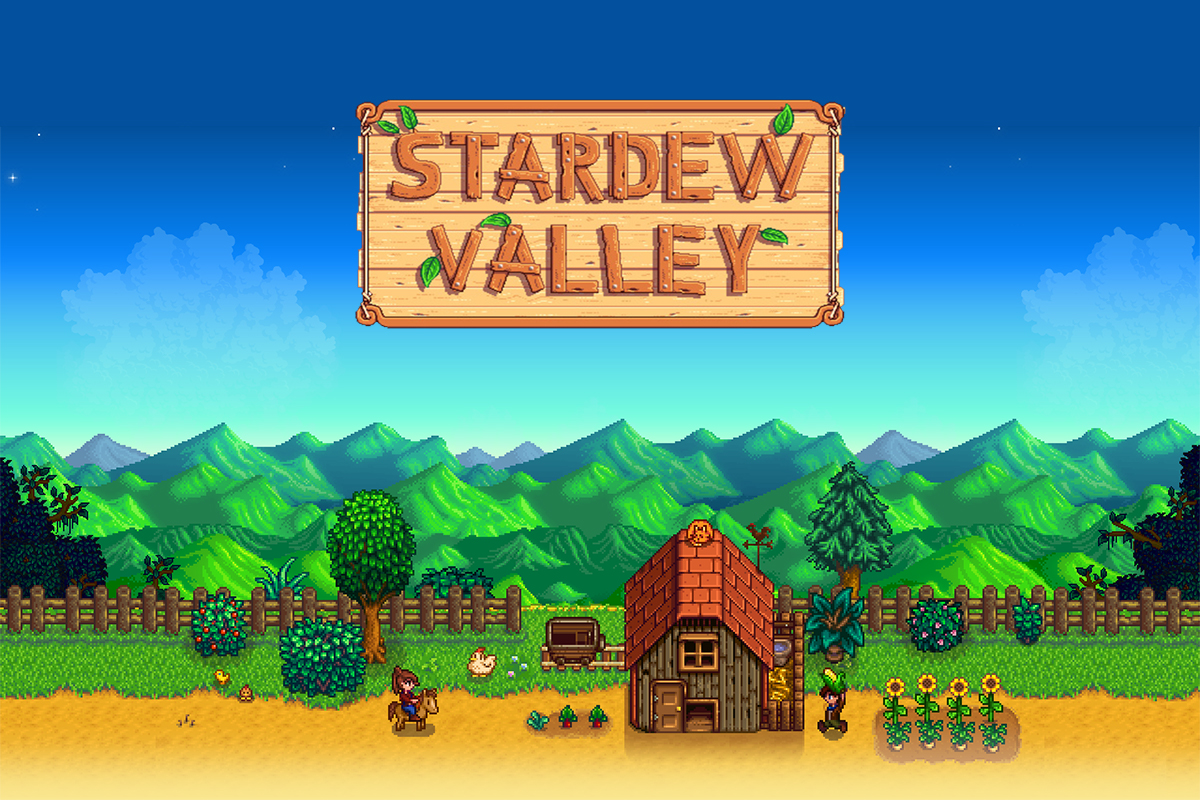
iThrive Curriculum game-based learning units are a set of social and emotional learning (SEL) curricular units for high school English Language Arts (ELA) and humanities courses that use video game narratives as core texts. In a previous post we outlined our approach to selecting games to serve as the narrative foundation for these units. In this article we'll illustrate how we applied this approach to assess the hit title, Stardew Valley, and why we ultimately decided not to pursue a Stardew Valley unit.
As we design any unit, we work closely with in-service and/or pre-service educators. In the spring semester of 2020 we worked with the students of our frequent collaborator, education and Universal Design for Learning expert, Dr. Gabrielle Rappolt-Schlichtmann of EdTogether. Her Harvard Graduate School of Education students were studying the role of emotion in learning.
We challenged Dr. Schlichtmann's students to design game-based mini-units that would embed social and emotional learning into ELA learning objectives. (This collaboration generated the core ideas for our unit, Sam's Journey, which uses the mobile game A Normal Lost Phone.)
One group of students chose to design curricular content around Stardew Valley, a hit game that's widely hailed as an emotionally touching, engrossing experience. The game is categorized as a farm-life simulator, meaning players simulate the process of maintaining a farm and building relationships with the townsfolk nearby. The game is open-ended in the sense that players have a lot of choice and agency in how to spend their in-game time and which goals to pursue. They can choose to specialize in trapping or fishing, for instance, and decide which animals to tend to on the farm, which produce to grow, and how much time to spend mining in the nearby caves. They can choose to run errands for the townspeople, and to pour effort into rebuilding the community or play a part in its eventual takeover by a soulless corporation.

A gameplay snapshot of Stardew Valley.
The draft unit that the students submitted for Stardew Valley was excellent. It was fully student-centered and focused on having students develop friendships with non-playable characters (NPCs), learning about their unique traits. The proposal was for students to tap into their empathy and perspective-taking to extend the characters' narratives through creative writing activities. These appeared to be solid angles from both an SEL and ELA point of view.
These aren't the only considerations we had to keep in mind, though. In the game, players start out as a novice farmer new to Pelican Town. They work for (in-game) days, seasons, and years to really understand what success in the game looks like and to make meaningful progress towards building relationships and contributing to the community. Members of the iThrive team have played for over 20 hours and still have a lot of work to do to get close to multiple NPCs and learn meaningful tidbits about their lives. The main drawback of Stardew Valley for our curricular approach is, ironically, the very mechanic that makes it an excellent springboard for discussions about relationship building: the time it takes.
The themes of integrating your character into the community and learning the unique traits, likes, and dislikes of your neighbors are a primary reason this game is powerful from a social and emotional learning standpoint. It just wouldn't do to rush students through the various components of the play experience just to "get to" the meaningful relationship-building moments; the drawn-out process is, in fact, the point. It takes sustained time and attention to build trust and reciprocity among community members.

A gameplay snapshot of Stardew Valley.
Another critical consideration that ultimately made us decide against pursuing a unit around Stardew Valley was a question of accessibility. The unit was designed for students to play the game alone so they could make choices that aligned with their interests and have the experience they wanted in a largely open-ended game. The game can be played on mobile phones, which is a boon to game-based learning since most teens have phones. But the game costs at least $5/license. That likely wouldn't be a barrier for a "hot seat" model of play — where students rotate playing in front of the class while peers observe — but for solo play the cost might be prohibitive for the many classrooms on tight budgets.
Here's a summary of our ultimate decision points around releasing a Stardew Valley unit:

A critical point in our decision-making process was to ask for feedback from one of our trusted teacher partners and game-based learning advocates. Our frequent collaborator, Brian Harmon, a high school ELA teacher in Georgia who uses multimedia teaching approaches, reviewed the unit proposal and noted that its biggest drawback was that "playing the game for 'hours' means we would need some formative assess[ment] component for every 15-30 minutes of gameplay. How many hours into the video game before characters are developed and how are the actual mechanics of the core gameplay addressed in the pedagogy? If the lessons are tied to the interactions only and not the gameplay then that could be a problem....The administration won't like the play, play, play, without a lot of doing (at least they won't at my school)."
All of this said, a teacher devoted to project-based, community-building efforts certainly could make Stardew Valley gameplay and discussion a recurring experiential component and discussion point of an entire semester or year-long course. But generally we have found that the more time-limited and contained gameplay experiences like those found in emotional hard-hitters including What Remains of Edith Finch and A Normal Lost Phone better deliver a feasible game-based SEL option for high school classrooms.
Are your teen students or kids already playing Stardew Valley? If so, use our game guide to connect with them about the social and emotional learning themes the video game touches upon.
Some additional questions to pose to Stardew Valley players to support critical SEL reflections:
- Among the NPCs, which ones are you drawn to and why?
- What are you noticing about your own biases and first impressions towards NPCs in the game?
- How is the culture of this community similar to or different from yours?
- How do you see your community members supporting one another in real life?
- What unique talents and points of view do/can you contribute to your community?
- How do you build relationships?
Reflecting on the Power of Play: The Game of Life is Not a Game at All
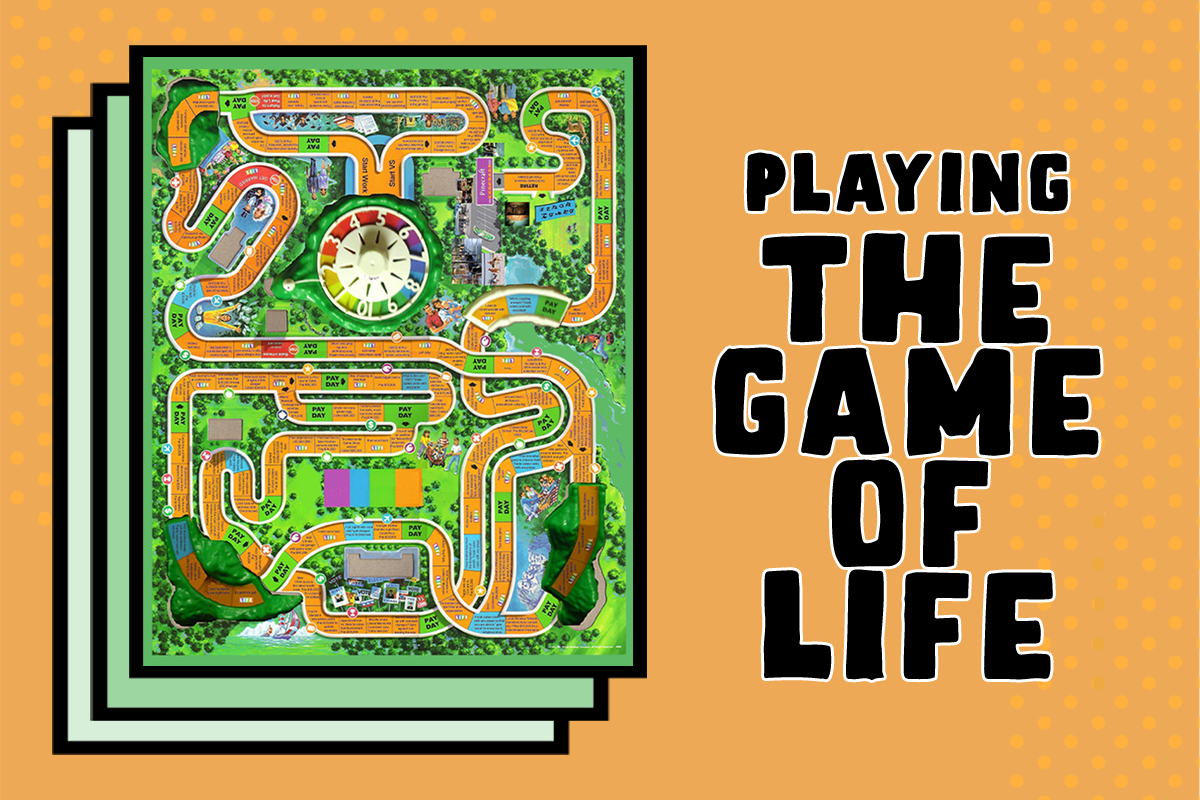
This is the third in our 'Power of Play' series of reflections by students from a Philadelphia-area high school. For extra credit in their sophomore English class, a few students shared their thoughts on questions such as, "How do games help you deal with life? What games are meaningful to you and how do they help you better understand yourself or the world? How do games help you question the way things are in the world?" To protect their privacy, their reflections are shared with initials rather than full names.
The Game of Life is Not a Game at All
E.S., High School Student, Philadelphia, PA
My name is E.S. I am a 16-year-old male from Philadelphia. Games changed my life. Growing up, all I did was play games with my friends and family, whether it was video games, board games, or even a card game. There was one game that I played that really did change my life. It was called The Game of Life.
This was always my favorite game to play because I always thought that life would be as easy as it was in that game. Spin a wheel, move forward, get a car, get cash, and have a family. But I learned it is not that easy. I learned I cannot just spin a wheel and move forward in life. I cannot just keep on moving forward space after space because that is not reality. I cannot land on a space and earn cash or choose the career path or the college path because life is not that simple.
I learned that if I want a career I have to work hard to get it. If I want to go to college I have to go through all of the stages that come before it in order to get there. If I want to make money I have to work hard for it. This game taught me that nothing in life is ever just handed down to you. It has to be earned through hard work and dedication.
Another thing is family. In this game, there are spaces you can land on that allow you to get married and have children. What this game doesn't show us are the struggles many people face. What this game doesn't show us is how hard it can be to find real love in the world. It doesn't show us how hard raising a kid can be. Another space on the board is to buy a house, but again, this game doesn't show us the struggles many people face when it comes to moving out or finding your own home.
In reality, you cannot just spin the wheel and hope to get the highest number. "The Game of Life" is a representation of a false reality, a utopia, and all the good things in life, but it doesn't show us all the struggles you have to go through to get to those coveted spaces. It doesn't show us how the more we try to move forward, the more we get held back. It doesn't show us all the pain and suffering that comes with life. It does not show us how life is not a game.
Happiness is hard to find in the real world and I learned that the hard way. "The Game of Life" was the life I grew up always wanting, but I realized that what I want in life is to succeed the right way. No loopholes, no handouts. I want to make it through life knowing I earned it. This game changed my life but it changed it for the better.
Civics and Gameplay: What Teens Say About iThrive Sim: Lives in Balance
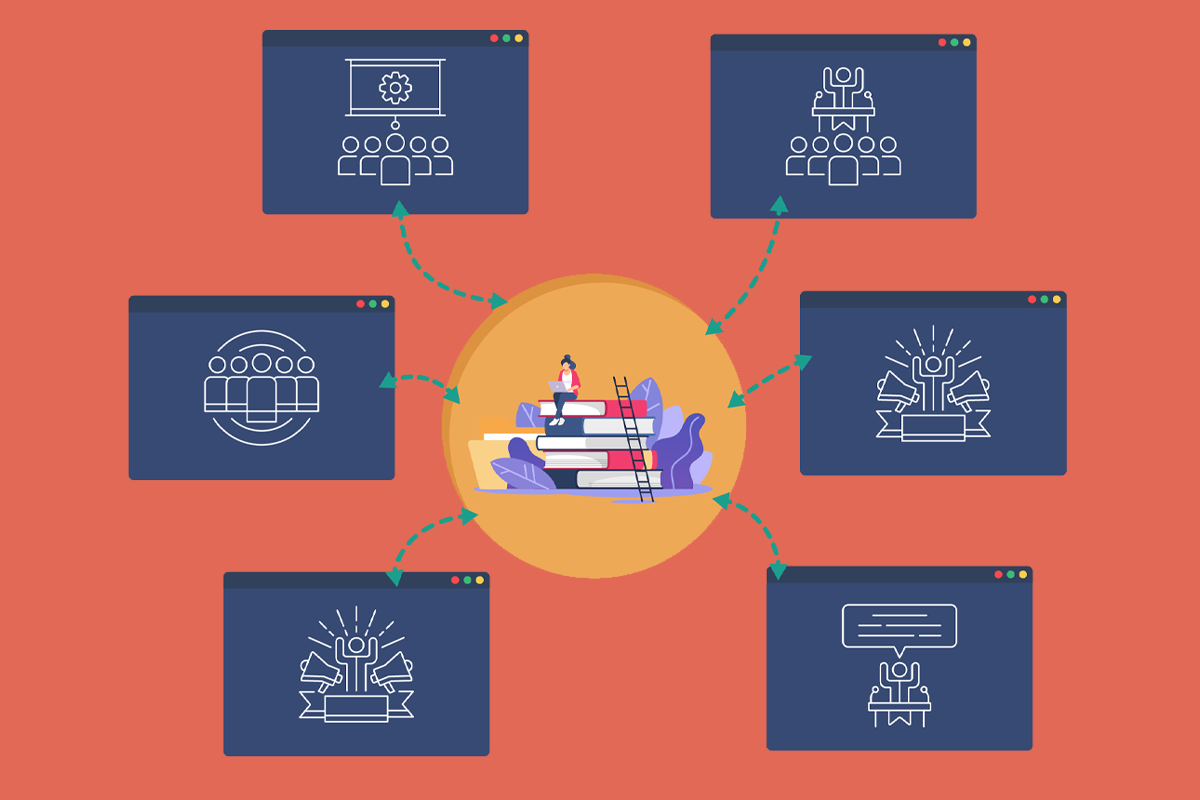
This Spring, over 60 students from the Los Angeles area playtested iThrive Sim — a robust web-based digital platform, created in partnership with the makers of the Situation Room Experience, that supports role-playing simulations as a powerful learning approach for civics. The students played the Lives in Balance scenario, which was created in response to the COVID-19 pandemic. The scenario focuses on the constitutional issue of federalism using a pandemic as a backdrop.
In both pilot rounds, students said that they found Lives in Balance to not only be fun and engaging, but also educational and thought-provoking. They shared that gameplay allowed them to think from different perspectives, participate in governmental decision-making processes, learn more about civics and engage in critical thinking-specifically about the impact of their decisions.
When asked what they'd tell their parents about participating in civics-based scenario, students offered the following perspectives:
- "I got the chance to stand as someone who is important in the decision-making process for a national crisis. It was fun and I would definitely do it again."
- "It's an educational game that showed me different perspectives on the topic and expands one's ability to reason and debate an idea."
- "It was really beneficial and a great way to learn more about the government and how it functions/makes decisions."
- "It was a fun experience working as a team."
- "...it prepares students for real-life situations/issues."
The main highlight of the experience for students was how interpersonal it was—many commented how much they enjoyed the discussions and debates with their peers in different roles. In this era of distance learning, interpersonal is key, as that's the component of education that was drastically reduced when school moved from the classroom into an online context.
With regard to learning outcomes, students in the first pilot focused on two: gaining new knowledge and critical thinking skills. Knowledge-based outcomes included how government and politics work, the nuances of civics-based concepts and the complexity of a pandemic. Critical thinking skills included being able to clearly state and advocate for one's opinion, understanding the process of decision-making, and learning how to prioritize different goals and work together towards a common goal.
Students in the second pilot homed in on what they learned about decision-making processes and how to navigate different perspectives. They described the difficulty of contending with making decisions because of their impact on the constituents and struggled with not knowing what kind of outcomes they would lead to. Additionally, students described how taking on the role of those in government helped them view civics-related issues from a different perspective, and to wrestle with the power of their positions.
At iThrive, we see playtesting as an element of co-design with teens. We invited the students to also describe any challenges they felt during gameplay so we could use that information to iterate improvements to the game. Some students described a desire for more time to read the materials and information in order to come to a more informed decision. Others enjoyed the time limit of the game, as this required them to come to a decision faster, rather than continuing to debate. Many students found the continuous pop-ups and files to be useful, as they provided them with new information, but some suggested the information should flow at a slower pace. This feedback guided modifications to the content and the gameplay experience.
At the completion of gameplay, almost every student said they would recommend or highly recommend the game, as a tool for connection, fun and civics education. Teachers offered feedback such as, "It's exactly what we need in classrooms, structured debate."
Lives in Balance is undergoing a large scale pilot this fall. Sign up here to pilot this scenario with your students.
Play and Possibility: Highlights from Games for Change (#G4C2020)

It was a pleasure to be one of the over 200 speakers and 6800 attendees at the 2020 Games for Change Festival. From interacting with fellow game lovers at the marketplace to tuning into the amazing conference speakers, our staff left the conference feeling inspired.
Thank you to all who attended the talk by our Executive Director, Dr. Susan Rivers. She spoke about addressing the needs of distance learning and attending to the opportunities and challenges of designing educational games for new learning environments. Since COVID-19 has and will continue to present barriers to traditional learning, organizations, and people who work with youth need new kinds of resources that can address the challenges of distance learning and create new possibilities. iThrive Sim, our proprietary educational tool which hosts embodied learning experiences for teens emerged from the design restraints and unique student needs the pandemic presented. Staying agile in meeting these need is now more important than ever, as the education landscape changes and the pandemic continues. And so is listening deeply to the needs of young people today, as their needs and requests change.
If you missed it, Susan shared how iThrive addressed these challenges. You can watch her presentation below.
Our staff loved the presentation by the folks from Gigantic Mechanic, fellow civics-based role-playing creators. It was refreshing to see other role-playing simulations designed to support students in their understanding of civics.
Some of our staff's favorites were Maria Burns Ortiz's session on game design with youth, our friend Matt Farber's session on the curriculum he collaborated on for the game Bury Me, My Love, and Colleen Macklin's session "Play for Change: Ten Games to Play Right Now" was chock full of impactful game recommendations.
It was wonderful to be in community virtually, sharing and being enlivened by the power of games.
"I appreciate the community's intent to support youth positive development with games and to meet the moment," said Jane Lee, Senior Director of Operations & Mental Health.
Power of Play: Tackling First-Day Jitters With a Game of CNUNO
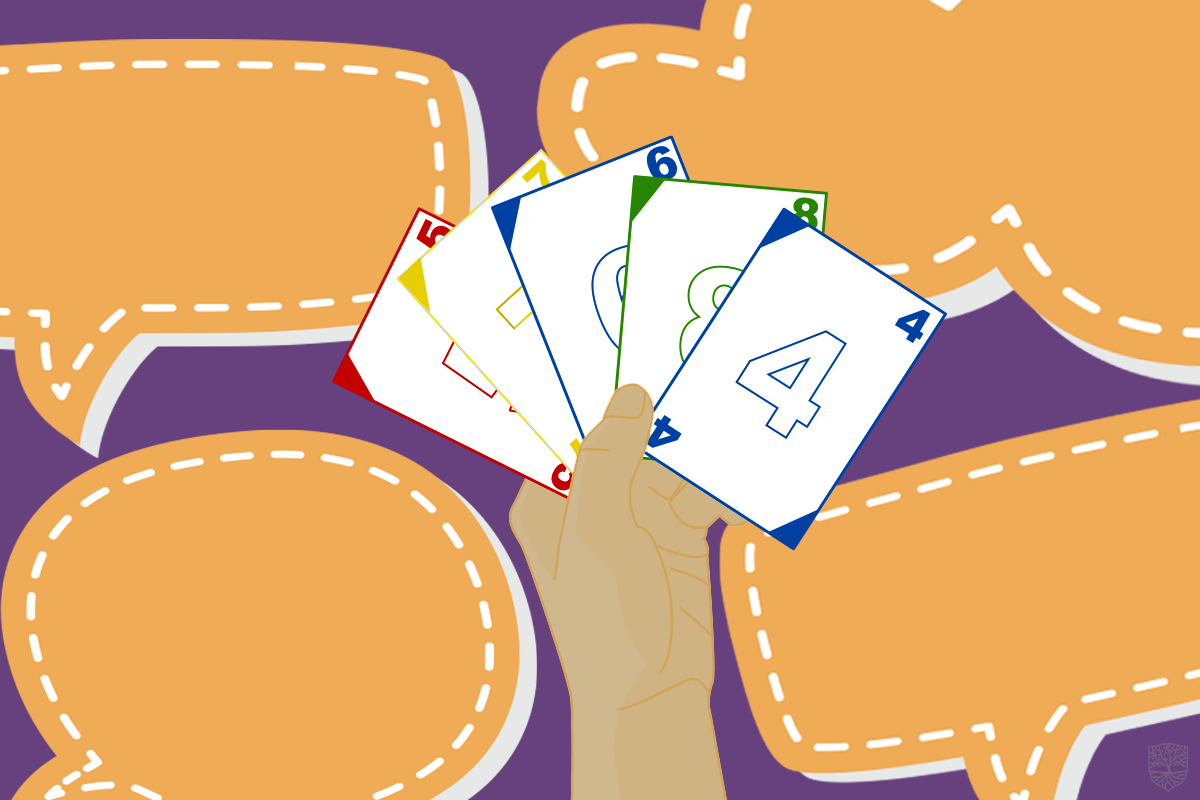
For many young people, games are more than play. Games provide a place to connect, a place to explore, and a place to learn. At iThrive Games Foundation, we have seen firsthand how gameplay can support teens in thriving, whether it's in the classroom or amongst friends playing together online.
We asked teens from a high school in Philadelphia to share a bit about their experiences with games. For extra credit in their sophomore English class, a few students shared their thoughts on questions such as, "How do games help you deal with life? What games are meaningful to you and how do they help you better understand yourself or the world? How do games help you question the way things are in the world?"
Over the next few weeks, we'll share their insights on play, from video games to card and board games. To protect their privacy, their reflections will be shared with initials rather than full names. We hope these stories illuminate the power of gameplay as seen through the eyes of these young people.
The following blog post is a submission we received from a teen sharing a story of what gameplay can do in their own words:
Gaming for Anxiety
E.M., High School Student, Philadelphia, PA
I started my first job at the beginning of sophomore year. I started working with my best friend and a girl I had never met. Our boss got us a card game called CNUNO. It is a knockoff version of UNO. We played it almost every day if there were no kids who needed homework help.
We laughed constantly and it made it easier to get to know my co-worker. It is hard to get to know people, especially for me. I deal with social anxiety and it can get really bad in new places with new people. CNUNO was our icebreaker. Since I was at work, I did not have a choice on whether I really felt comfortable or even wanted to get to know my co-worker. Luckily, she did not turn out half bad! We are good friends now.
I do not know why I get anxious about meeting new people, but it always helps if there is something to help with the awkward first few minutes. It is hard for me most times in any situation where I have to introduce myself. Icebreakers at school are a cause of panic for me. School presentations as well. When there is not a support system to lean on, it is so hard. Some people do not understand what it is like for me. When people force me to put myself in an uncomfortable position, they do not see the panic it causes.
CNUNO helped make an uncomfortable situation easy. I should never underestimate the strength that something so small has. It can help beyond belief and I am glad the game was there for me.
Have a story to share about games and what they mean to you? Share it with us here!
How to Choose a Video Game for Learning in HS English Classrooms
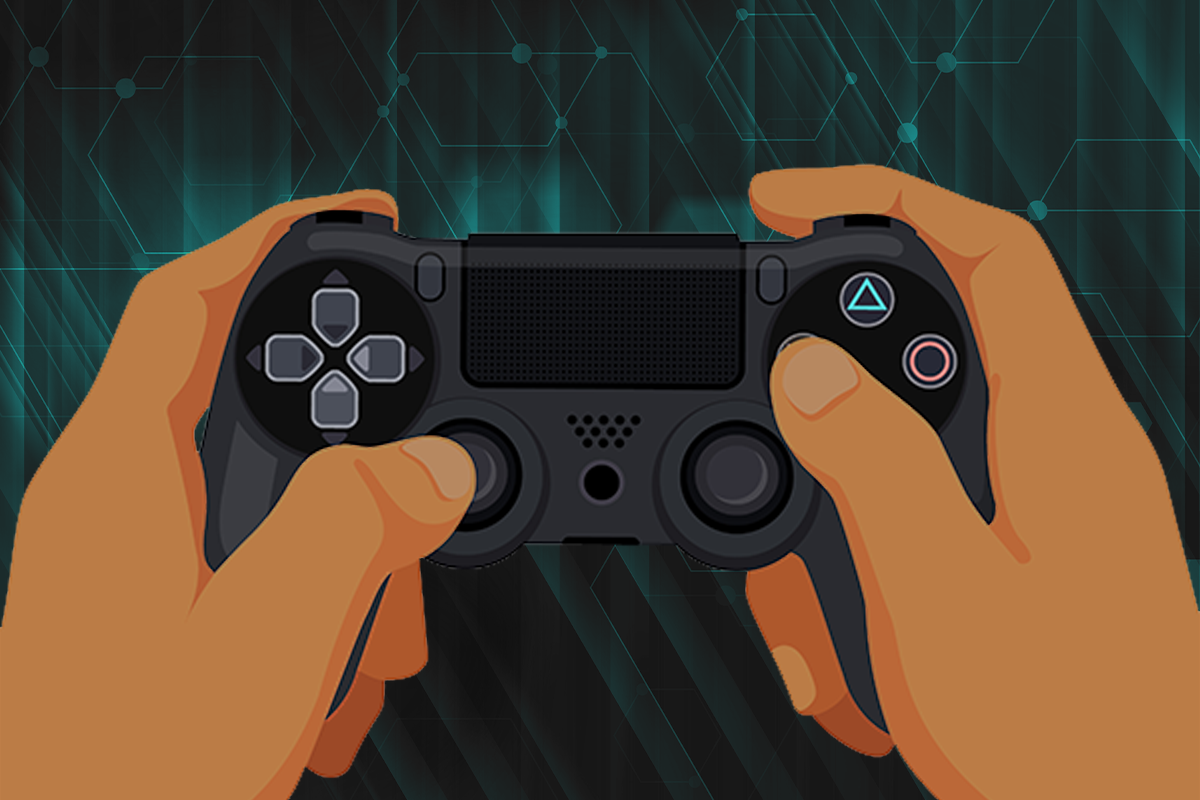
iThrive Curriculum is a set of units for high school English Language Arts (ELA) and humanities courses that use video game narratives as core texts. It's one way that we support teachers in connecting meaningfully with their students where they are—playing games—to build social, emotional, and academic knowledge and skills.
Video games are a defining narrative form of this era. Their complex characters, compelling settings, and unique storytelling strategies are more sophisticated than ever and deserve the level of analysis teachers regularly apply to literature.
Of course, there are many types of video games and some are generally better suited for this curricular approach than others. When we partner with educators and teens to design transformational game-based learning units for ELA and related courses, here's what we look for in a game:
- Emotionally impactful and appealing to teens. We keep an eye on what teens are playing. Games that are already popular with teens can be a fantastic opportunity to meet them where they are and take learning deeper. On the other hand, some games are epic and award-winning but don't yet have a huge following. So we also look for opportunities to design around powerful indie games that are relevant to teens, like Accidental Queens' A Normal Lost Phone, featured in our unit Sam's Journey.
- A strong tie-in with social and emotional learning (SEL) competencies. We look for games with narratives and themes that naturally prompt discussion and reflection around social and emotional skills including self-awareness, identity, empathy, relationships, perspective-taking, purpose, decision-making, and more, because we know social and emotional skills are critical for teens' learning, well-being, and achievement now and throughout adulthood.
- A strong academic tie-in. To be a candidate for iThrive Curriculum, a video game narrative has to be relevant to specific learning objectives that teachers already need and want to teach. Our units highlight aspects of games, like narrative structure and literary devices, that support students' core literacy skills and also provide ample opportunities for them to listen, read, discuss, write, and create to express themselves and their learning.
- Attention to diversity of learners. We look for games that can engage all students in narrative analysis, even those who haven't always experienced success with reading. Games generally do this well because they offer visual context and immersion, making the narrative easier to engage with and understand. Some games do this exceptionally well; in What Remains of Edith Finch, used in our Museum of Me unit, the text of the narrative appears on screen in response to players' movements via the controller, and every word is narrated through a voiceover so students are interacting with the story through sight, sound, and movement.
- Mindfulness about diversity of experiences. We seek games that convey a wide range of experiences to ensure that diverse and often marginalized backgrounds, experiences, and characteristics aren't ignored and absent from the classroom. We strive for our units to support empathy around stories that depict diversity of race, language, culture, gender and sexual identity, ability, and more.
- A low-stress addition to the existing curriculum. Using a game instead of a text is much more likely to happen if implementation is made easy. We like to ask ourselves:
-
- What equipment will be required to play the game in or outside of class? Games that work on mobile, PC, or in web browsers usually are a lighter lift for implementation than those that require a gaming console. But students' and schools' varying access to the internet also needs to be taken into account.
- How long does the game take to play? Games that are relatively short (1-3 hours) tend to keep the scope of the unit manageable, although longer games used in part or in whole can certainly work.
- Does the game's narrative branch a lot? In narrative games with little or no branching (fewer choices for students to make while they play), it will arguably be easier for the class to have a shared experience even if they don't or can't play together at the same time. It will also be simpler for a teacher to figure out where students are in the experience and what's coming next.
- How many copies of the game are needed and how much does the game cost? Sometimes only one game license is necessary, like in the "hot seat" model, where one student at a time plays and the rest of the class observes. This works really well for games without much player choice. For games where individual player choice is a key feature, multiple licenses might be best but could get costly.
Ninety percent of teens play video games, and they're a culturally relevant way to engage students in their holistic learning. We hope the criteria here can guide you in considering how game-based approaches might work to support literacy and engagement in your ELA or humanities classroom. Ready to try game-based learning? Museum of Me and Sam's Journey are classroom-ready units with opportunities for social and emotional learning baked in, so be sure to check them out.
Do you have a great idea for a game-based social and emotional learning unit for high school humanities courses? Tell us about it at contact@ithrivegames.org.
Role-Playing Simulations Offer Unique Opportunities for Teen Engagement

Educators have long used role-playing simulations to give students direct experience of academic subjects, whether it's as decision-makers during the Great Depression in a U.S. history class or as bankers or business owners in an economics class. Our approach to role-playing simulations is unique-we embed social and emotional learning and integrate technology. Role-playing simulations are of great benefit to educators and teens because of the varied opportunities they present for student engagement.
Here are six benefits of using role-playing simulations:
1. They engage students in a new way of learning. Students, especially at the high school level, get too few opportunities for experiential and embodied learning. Role-playing simulations invite them to interact with each other and with content in a hands-on way that leaves a big impression. Over 50 years of research on role-playing methodologies shows that role-playing is excellent for getting students interested in a topic (for a summary of these studies, see Druckman and Ebner, 2013).
2. They challenge students to strategize, research, and compromise. Students engaged in a role-playing simulation are responsible for moving the action forward. They must work individually and as a group to assess the information at hand, negotiate, defend their points of view, and make decisions that produce the outcomes they want.
3. They create high-energy, collaborative experiences that make lasting memories. When emotions are fully recruited for learning — like in an action-filled role-playing scenario — the learning that happens goes deeper and lasts longer. Research shows that role-playing helps students to retain information better than more traditional ways of learning.
4. They spark a deep love of learning about the world. Role-playing simulations illuminate systems in the world — like the inner workings of governmental entities — that can be largely invisible until a person is invited to work and improvise within them. Experiences like these can propel students' curiosity and motivation to explore possibilities for new ways of interacting and making decisions that can improve dysfunctional systems and produce a better world for all.
5. They inspire civic participation. Students who have engaged in a role-playing simulation have a leg up on those who've only read about a topic related to civic life in America; the players know what it feels like to take action and can better recall the strategies that work, supporting feelings of efficacy for taking action in the real world.
6. They embed social and emotional learning. Above all, role-playing simulations recruit and require emotional engagement and social interaction. Since teens are highly attuned to their emotions and their social status, the experiential approach of role-playing meets them right where they are developmentally. Our role-playing simulations are specifically designed to offer students opportunities to think about and practice self-awareness, social awareness, self-management, relationship skills, and responsible decision-making.
Ready to try it in your class? Contact us to learn more about our iThrive Sim: Lives in Balance and other our role-playing simulation scenarios.
Connect with iThrive Games at the 2020 Games For Change Festival!

Join us at the 2020 Games For Change Festival, where iThrive Games Foundation staff will unveil iThrive Sim—our new educational offering that reimagines distance learning. The event, which will be held online July 14-16, will feature experts in games for learning from across the country. We are thrilled to have two chances to connect with you regarding our new resource for virtual classrooms.
Executive Director and Chief Scientist Susan Rivers, Ph.D., will present Listening and Staying Agile During COVID-19. She'll explore how iThrive Games pivoted to address distance learning and the opportunities/challenges of designing game-based experiences for new learning environments.
Since COVID-19 has and will continue to present barriers to traditional learning, organizations and people who work with youth need new kinds of resources that can address the challenges of distance learning and create new possibilities. Staying agile in meeting the needs of youth and those who work with them is now more important than ever, as the education landscape changes and the pandemic continues. And so is listening deeply to the needs of young people today, as their needs and requests change.
Susan's presentation will focus on addressing the needs of students, teachers, and parents in distance learning, reimagining learning, and rapid development cycles. Utilizing iThrive's experience in re-designing classroom products for the virtual space, Susan will discuss the opportunities and challenges of designing from the ground up for new and non-traditional learning environments.
Additionally, at the Games 4 Change Marketplace, staff will be on hand to offer participants early access to iThrive Sim, which was co-developed, field-tested, and approved by educators and teen users alike. iThrive Sim offers tech-supported role-playing scenarios—including a specific Covid-19 scenario—that lets teens practice difficult decision making and collaboration in real-time. Attendees will also be able to speak with staff about iThrive Curriculum-our game-based, social and emotional learning units for English Language Arts classes. Sam's Journey is a short, easy to implement unit that debuted in June. Museum of Me is a unit with rave reviews from pilot teachers across the U.S. All of our offerings have a core focus on students' self- and social awareness and responsible decision-making that manifests through teens' playful engagement.
The festival is free to all who want to participate. Sign up here. We hope to see you at the session and at the virtual marketplace!
Power of Play: Teens Explore Connection and Meaning Through Gameplay
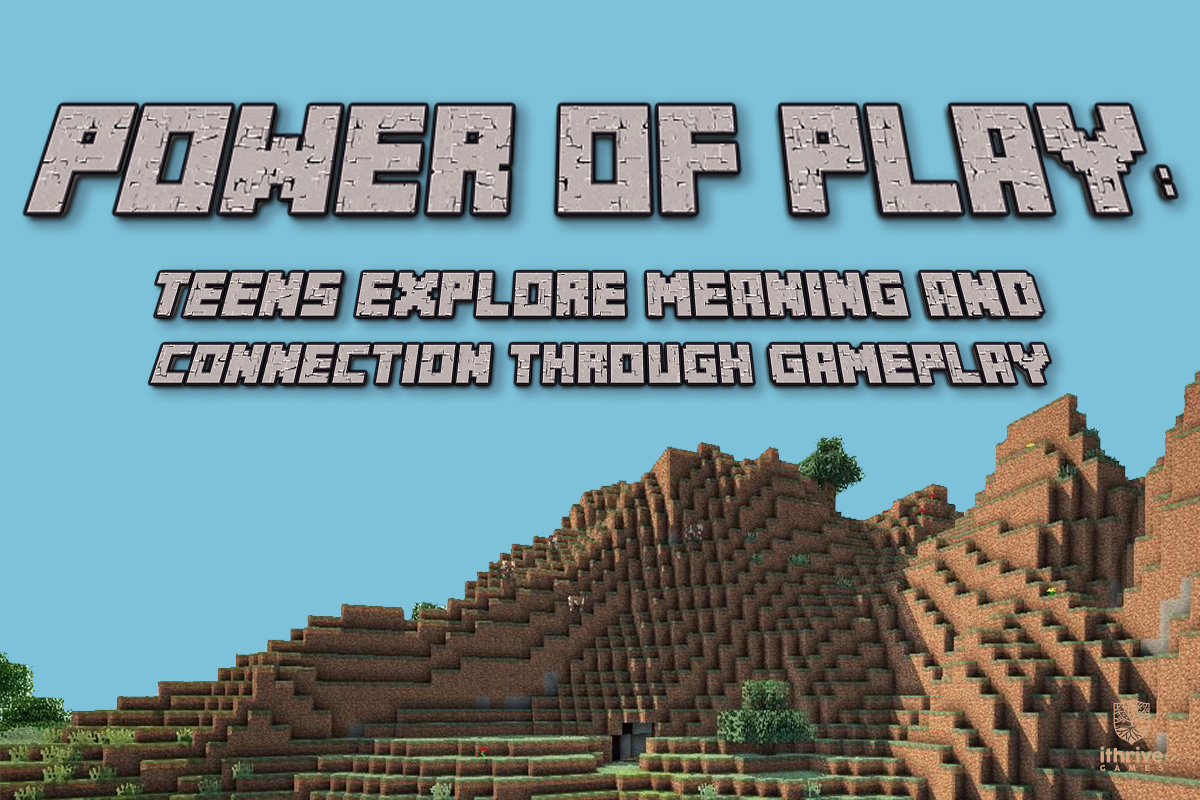
For many young people, games are more than play. Games provide a place to connect, a place to explore, and a place to learn. At iThrive Games Foundation, we have seen firsthand how gameplay can support teens in thriving, whether it's in the classroom or amongst friends playing together online.
Earlier this year, we asked teens from a high school in Philadelphia to share a bit about their experiences with games. For extra credit in their sophomore English class, a few students wrote thought pieces in response to questions such as, "How do games help you deal with life? What games are meaningful to you and how do they help you better understand yourself or the world? How do games help you question the way things are in the world?"
Over the next few months, we'll share their insights on play, from video games to card and board games. The pieces are in their own words. To protect their privacy, their reflections will be shared with initials rather than full names. We hope these stories illuminate the power of gameplay as seen through the eyes of these young people.
Minecraft: A Life of Blocks
F.T. High School Student, Philadelphia
My name is F.T. and currently, I am 16 years old. I was born in New York but raised in Puerto Rico, which means I have the privilege of being bilingual. Normally I have a difficult time communicating with my family and that leads me to play video games all of the time. Recently, I returned to playing Minecraft, which is a game that I always have in mind. It is peaceful and relaxing to play, and I don't even notice when I lose track of time. Minecraft has been with me since childhood even though back then I could not understand the concepts behind the game.
Minecraft has taught me the basic things in life. It has taught me how to survive. Who would have thought that I would be passionate about having a farm-taking care of my pigs, llamas, horses, chickens, wolves, cows, cats, donkeys, parrots, and even sheep?! This game takes me out of my reality and allows me to build my own reality where there is no cruelty. It teaches me to think about the environment and how it depends on me and how I depend on the environment. Minecraft is not just about building-it has more than that. At least for me, it forces me to take into consideration the resources, environment, and build of the house itself.
The game itself is composed of blocks that the user can mine and reuse to create new material. If certain materials are combined, the user can get a new thing to build with. My favorite part is the views of the world players can get. Since I do not travel, I do enjoy the views. It shows a little window of the massive world that is called the Universe. Another thing Minecraft helps me do is to think outside of the box and create materials with resources I never thought of using.
Minecraft helps me to cope with the bad events that occur in my days and takes my stress out.
New Issue of Journal of Games, Self, & Society Suggests New Paths in Game Design, Accessibility
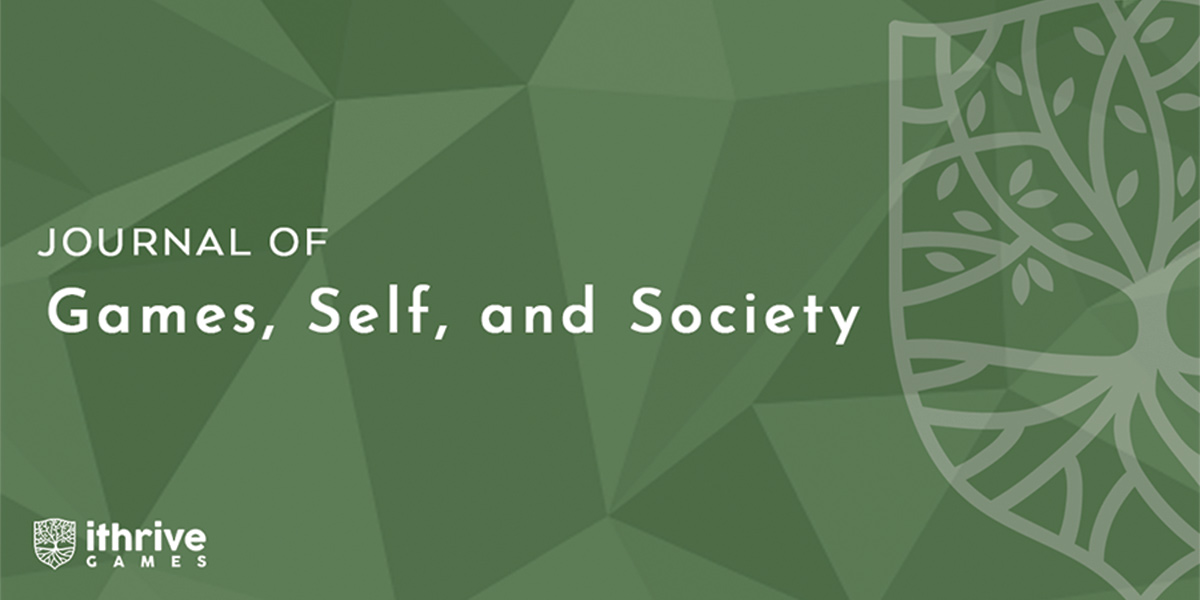
Experts Offer Insight Into Games' Contribution to Learning, Health, and Society
BOSTON-May 4, 2020. Exploring existential ideas as part of the game design process may yield new perspectives that result in games that offer lasting transformation to players, according to research featured in the latest issue of the Journal of Games, Self, & Society, published by iThrive Games Foundation and ETC Press.
Professor Doris Rusch, a game designer and researcher at Uppsala University in Sweden and the author of Making Deep Games - Designing Games with Meaning and Purpose draws on literature from existential psychotherapy and mythmaking, urging game designers to create new myths in their games to explore existential ideas—such as freedom, isolation, or death—in pursuit of finding meaning.
The issue also features an article by Professors Matthew Farber and Mia Williams and colleagues, who examine how facilitated game design can be used to support teens in exploring and expressing their lived experiences, as well as how systems are structured.
New research by graduate student Sasha Soriane and Professor Jacque Carette aims to fill a gap in the literature around the accessibility of mechanical challenges in games.
Two papers in this issue provide case studies of two games, one by Professor Gareth Schott exploring how digital games can serve as a memorial following the death of a loved one, and one by Professor Andrew Phelps and colleagues examining how game mechanics can be used in novel ways to represent the human experience.
The journal's editor-in-chief, Susan Rivers, Ph.D., who is also the Executive Director and Chief Scientist at iThrive Games Foundation, says that she hopes the interdisciplinary research will support continued deep learning about the power of game design and gameplay.
"I anticipate the creativity, innovation, and design choices put forth by the scholars and designers included in this issue will impact the field," she says.
About the Journal
The Journal of Games, Self, & Society (JGSS) is a peer-reviewed journal created and edited by iThrive Games Foundation and published by ETC Press. The journal highlights work focused on how games, game design, and gameplay contribute to a deeper understanding of learning, health, and humanity. It was created to foster interdisciplinary research, conversation, and community around game studies and games-related scholarship. Scholars from all disciplines are encouraged to participate.
About iThrive Games
iThrive Games Foundation prepares teens to thrive by meeting them where they are and working in partnership towards a world where all have the voice, choice, and agency to reach their full potential. We use games and game design to equip teens with the social and emotional skills they need to be healthy and resilient, tools to support and protect their mental health and well-being, systems thinking they need to recognize inequity, and meaningful opportunities to imagine and design a better world.
Media Contact:
Eghosa Asemota
eghosa.asemota[at]ithrivegames.org
Staying Connected While Social Distancing: Games for Emotional Coping
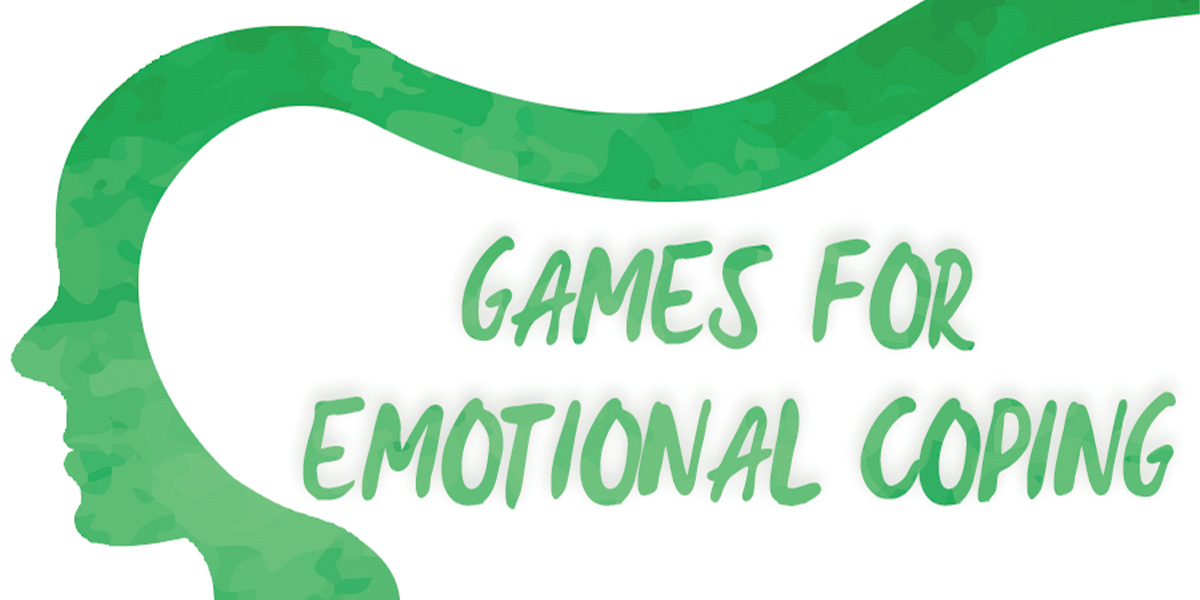
With social distancing in practice and peak coronavirus impacts underway, self-care, in its many forms, is essential to our collective well-being.
At this time of uncertainty and drastic change, it is natural for teens, parents, educators - everyone - to feel anxious and even grief-stricken. Many of us are either alone with these difficult emotions or deeply impacted by the emotional experiences of the people close to us.
At the iThrive Games Foundation, we know all emotions are valid and useful, and there are proven strategies for coping with the more unpleasant ones. We strive to offer gameful recommendations that help you practice self-care, savor life's best moments and experiences, and turn inward to explore, accept, and express what's challenging about this moment.
Managing Tough Emotions
Games are one avenue for attending to the tough emotions we might be feeling right now. That's because games can offer ways to practice self-care and strategies for managing emotions, including sharing how we're feeling, looking at our situation from a different perspective and, when necessary, distracting ourselves* by envisioning a different reality for a while.
Games and Self-Care: What We're Playing Now
Here are three games we are playing right now that are helping us process the angst around this extraordinary moment and make self-care a daily practice. We hope you'll take the invitation to join in.
- #SelfCare is the perfect meditative experience to help you look a little differently at self-isolation and lean into the restorative possibilities of staying in. This free app invites you into the cozy bedroom of a person who's decided to take a mental health day. You won't find any scores or time limits here. You're free to disconnect from the outside world and stay as long as you like. Through interactions with the items — and the sweet cat companion — in the room, you take meditative actions like rhythmic breathing that gradually lift the bedroom shades and let in some light, both literally and emotionally.
- Kind Words is a gentle interactive experience that supports you in disclosing what's weighing on you by writing brief, anonymous letters to kind strangers against a backdrop of calming lo-fi music. By both requesting and offering support on any issue across this network through short, uplifting letters and tokens of appreciation, you engage in the mindful self-care practice of naming your feelings, remember that you're not alone, and benefit from others' attention and thoughtfulness. Add some extra juice to this experience by challenging yourself to use precise language for your feelings, which is an emotion management tool all on its own. For a more in-depth look at Kind Words, check out this article by frequent iThrive collaborator Dr. Matt Farber.
- The Sims is the classic life simulator game where you're free to create the alternate reality you might be craving right now. With a wide range of versions including console and mobile experiences, and special editions like "Tiny Living," there's sure to be an experience that captures your imagination. Build your one-of-a-kind character using The Sims' impressive customization options, then design your space from the ground up and have any kind of adventure you can imagine. High fives and parties are still totally welcome here.
As people of all ages do the difficult work of adjusting to this new reality, these and other special games can be helpful self-care tools that help us destress, reduce anxiety and regulate our emotions. How are games helping you to process tough emotions during this difficult time? Share your stories with us on Twitter, and stay safe and healthy out there!
*Distraction can be a helpful or unhelpful strategy for managing emotions. Research suggests that it depends upon whether you are accepting the way things are or merely avoiding reality.
Games To Play While Social Distancing: MMORPGs

As we all do our part to stay safe by social distancing, games have emerged as an avenue for connection, fun, and exploring new worlds. Numbers published by Verizon show that video game usage in the United States has increased by 75 percent during peak hours since the coronavirus quarantine began. Needless to say, if you don't play video games, now is a great time to start.
At iThrive Games, we understand what video games do for those who play them. They provide meaningful opportunities for players to connect with others, better understand themselves and, for teens especially, develop social and emotional skills that support their thriving.
For anyone looking for a safe space to wander, explore, and connect with others, massive multiplayer online role-playing games (MMORPGs) are the way to go.
What are MMORPGs?
Massive multiplayer online role-playing games (MMORPGs) are games set in a virtual universe where a vast number of gamers from all over the world play at the same time. Role-playing as their customized character, MMORPG players earn experience points and level up by completing quests, combatting monsters, and collecting money, equipment, and rare items that help their character advance. With character growth as the primary goal of gameplay set in a world that continues to exist and evolve while players are offline, MMORPGs offer an evolving gaming experience perfect for those who are practicing social distancing.
Together Apart: How MMORPGs Foster Connection
MMORPGs are a great way to nurture your real-life relationships and foster new ones online. Teamwork and cooperation are common themes present in almost all MMORPGs as players are encouraged to participate in team quests and slay monsters with others to earn experience points together. Sometimes, players even take on roles to protect their friends against damage from monsters. Guilds and clans, which are in-game social groups that players can join, also offer another avenue for connection. With pronounced elements of collaboration, relationship-building, and trust, MMORPGs are a great way to stay connected while social distancing.
MMORPGs To Play
Convinced? Here are four massive multiplayer online role-playing games (MMORPGs) to try and play:
- World of Warcraft (13+ years): World of Warcraft is set in the fictional world of Azeroth. Players use their customized character to explore a visually engaging landscape, defeat monsters, complete quests prompted by non-player characters (NPCs), and interact with millions of players.
- RuneScape (13+ years): RuneScape pulls millions of players all over the world into Gielinor. In this medieval fantasy realm, they can travel via foot, spell or ship to combat monsters, collect resources, challenge other players, and develop their character's skills.
- MapleStory (13+ years): MapleStory offers a world of wonder for millions of people. Acting as a character and citizen of Maple World, players venture into numerous towns and earn experience, items, and Mesos through the completion of quests and slaying of monsters. Gameplay orients around leveling up in the player's in-game profession.
- Elder Scrolls Online (17+ years): Elder Scrolls Online features a non-linear storyline that connects with other Elder Scrolls games. Set in Tamriel, a fictional continent, players enjoy a mixture of quests and random events with opportunities to earn event-specific rewards.
Tweet us @iThriveGames to let us know what MMORPGs you're playing while at home, and subscribe to our newsletter for access to free, game-based social-emotional learning resources and more recommendations for games to play while social distancing!
Social Distancing and Staying Connected Through Games

At iThrive Games Foundation, we are passionate about games and we know that games can help us feel more connected to each other. As we all seek to do our part to #flattenthecurve of Covid-19, game play may increasingly become a part of daily life. Whether you're a teen whose school has closed or an adult who is working from home, many are practicing social distancing. Playing games together at home can relieve stress, bring joy, and foster connection.
Relieving Stress and Bringing Joy
Numerous studies suggest that playing video games relieves stress. A 2016 study shows that whether a video game was collaborative or competitive, players' stress levels declined over time during gameplay. Another study found that video game players reported turning toward games after stress, and that they were able to recover from stress as a result of play.
In addition to research, we love listening to youth voices. Our teen blogger, Eleanor Mather, has written about her experience of using video games to help relieve stress. She has shared the useful life lessons she has experienced while playing games, whether she's enjoying Super Mario Maker 2 and remembering that it's not about winning, it's about creativity or learning lessons about the value of working toward a goal through playing Animal Crossing.
Our Curated Games Catalog can help you find new games to try out. The catalog links our game recommendations to some of the skills that are important for all of us to practice. Check out which games you can play to strengthen your skills for kindness, curiosity, and empathy.
There are so many video games now, too, that can be played together (online) but apart. Playing these can help you stay connected and have fun with friends even when you're practicing social distancing. Check out our recent blog on engaging with your teen in game play.
Fostering Connection During Social Distancing
In addition to video games, iThrive staff loves playing tabletop games. We all work remotely, so when we are together physically, we use games to reconnect. We have had so many shared moments of true connection (and many deep belly laughs) from sitting down at a table and playing a game together. And all of us play games with our families and friends when we are at home. Some of our favorites are:
- The Mind is a collaborative game where the only way to win is as a team. Players are not allowed to communicate verbally. Cards are dealt and players must each card in numeric order without making a peep or using hand gestures. We have had a blast trying to interpret and respond accurately to each other's nonverbal cues. (And the post-game analysis is sometimes the best part.)
- Happy Salmon is a game that gets you up and out of your seat as you try to be the first one to get rid of all of your cards. This one will have your whole family laughing as you yell out card categories and run around the table switching places. The only change during this Covid-19 issue might be bumping elbows instead of slapping arms when you get the happy salmon card. (This one's competitive, so be warned!)
- Team 3 is a cooperative game where three players work together to build a structure. The only catch is only one person can touch and move the pieces to build the structure (and they can't open their eyes), only one person can shout orders, and those orders are dependent upon the plans the one person who can't speak is looking at. Oh, and it's timed. This game calls on your nonverbal communication skills, your spatial awareness, and your patience. It is such fun to discover how to work together and communicate as you play.
Whether its parents and teens, or siblings and friends, grabbing a controller and playing together can help you share a moment of joy, stress relief, and connection despite social distancing.
Talking to Your Teen About Healthy Gaming
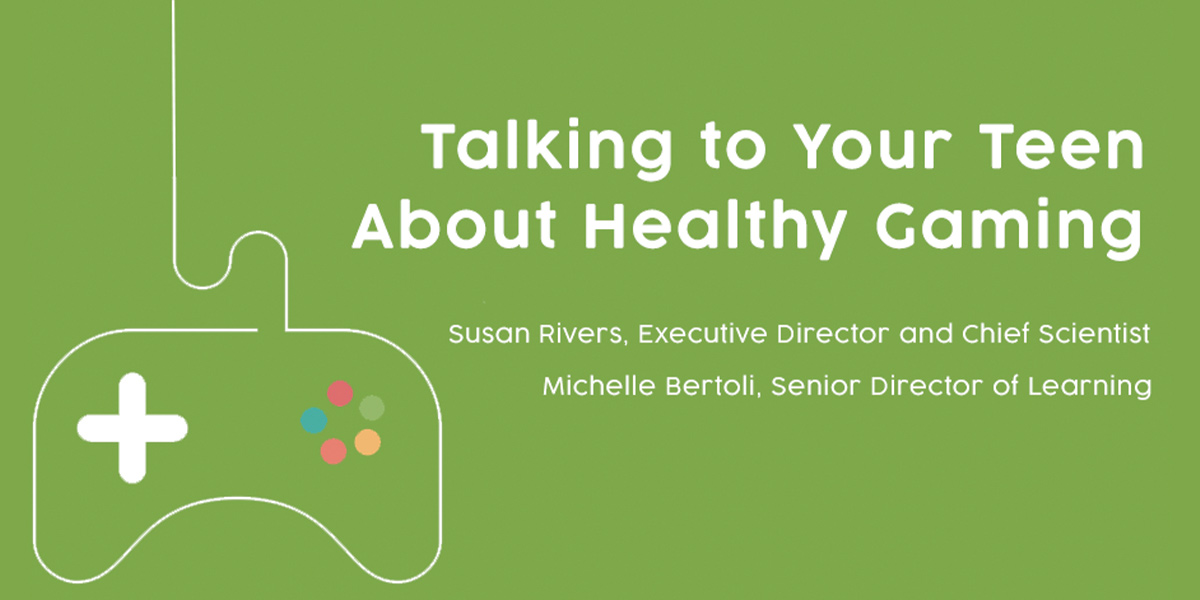
Many parents struggle with how to manage the amount of time their teens spend playing video games and ensuring healthy gaming habits. While the C.S. Mott Children's Hospital National Poll on Children's Health found that 71% of parents believe video games can be good for teens, nearly half of the parents polled also reported that gaming can get in the way in teens' lives, including family activities.
At iThrive, we know video games can offer teens meaningful opportunities to feel masterful, connect with others, and explore who they are and what they care about. In fact, parent and friendship researcher Lydia Denworth believes video games offer "a critical form of socializing." How can parents embrace this perspective in their interactions with their teens and encourage healthy gaming?
We've compiled some strategies for approaching and having interactions with teens around video games. To start, you'll need to get curious about why teens are playing. These tips allow parents to have conversations about video games in ways that respect teens and encourage healthy gaming.
-
-
Pay Attention To Your Posture: When you notice your teen is heading full-speed into hour 3 of video games for the day, what happens in your body? You might get tense, cross your arms, raise your voice, or go silent and steely without even being aware that you're doing it. It is a parent's job to set limits in your household, including for screen time. But getting mad or leading with disapproval is a surefire way to alienate your teen, stoke conflict and dissuade any fruitful conversation about developing healthy gaming habits. Set a small challenge for yourself to notice your body when approaching your teen about gaming. Practice an open posture: arms loose and relaxed at your sides, chest expansive and forward-facing, face and jaw relaxed, voice calm. Your body language signals to your teen either that it's time to get defensive and wall off, or that it's safe to venture some authentic sharing.
-
Listen Generously: Experts warn against dismissing or minimizing your teens' genuine interest in video games, no matter how mystifying it may be to you. Neuroscientist and mom of two former teenagers Frances Jensen shares, "The teen years are a great time to test where a kid's strengths are, and to even out weaknesses that need attention. What you don't want to do is ridicule, or be judgmental or disapproving or dismissive." Make time to engage with your teen around healthy gaming without rushing. Ask questions with genuine curiosity, "How do you decide which game to play? How do you learn how to play? What's interesting to you about this?" Think about a hobby you enjoy that might, on the surface, seem silly or trivial. Why do you like it? Chances are it's meeting a real and important need that makes you human. Video games are meeting some real and important need for your teen. Be curious about what it is. You might learn a lot about what makes your teen tick by asking open-ended questions from a place of genuine curiosity.
-
Make It A Shared Experience: Your teen is an expert in gaming, and you can learn a lot by grabbing a seat on the couch and requesting a tutorial on your teen's favorite title. (But prepare to be swiftly defeated!) Try exploring a new game together, with shared newbie status. "Couch co-op" games (meaning you're playing together in the same shared physical space) like Jackbox Party Packs, Overcooked, FIFA Soccer, Super Smash Bros., and many other titles offer a chance to associate a new emotional experience with your teen's gaming. Playing together is a chance to bond and have fun. It also will cement the message for your teen that you want to "get" and be involved in their passion and that you see its inherent value.
-
Game designer Jane McGonigal proposes that droves of people care so deeply about video games because they crave opportunities to solve tough problems and to test their limits in ways that real life often does not reliably provide. In your teen's case, there may be opportunities to find outlets for these needs and emotions outside of and in addition to video games. But you can't get a clear picture of those needs by standing on the sidelines, wishing things were different or waiting for this "phase" to end. When discussing healthy gaming with your teen, challenge yourself to step beyond your comfort zone with real curiosity, to meet your teen inside the magic circle and see what's so appealing there. You just might be pleasantly surprised by the richness you discover.
Coming Soon: New Issue of Journal of Games, Self, and Society

Games hit us where we are human. Gameplay is social. It is emotional. It is intellectual. We created the Journal of Games, Self, & Society (JGSS) to encourage interdisciplinary research, conversation, and community around games. Peer reviewed by experts in the field, the journal highlights qualitative, quantitative, theoretical, and experimental game studies focused on how games, game design, and gameplay contribute to a deeper understanding of learning, health, and humanity.
Our second issue of the Journal of Games, Self, & Society (JGSS) drops in April. From accessibility to how gameplay can teach systems thinking, each peer-reviewed article amplifies projects that are exploring how games help us thrive.
The first issue of the Journal shared a collection of papers that span fields of study from political science to interpersonal violence to STEM, and shared learning and insights in the realms of education, game development, physical health, relationship safety, and mental well-being. If you missed the first issue and its insightful game studies, click here to read it.
Sign up for our newsletter to receive an email when the second issue becomes available.
About iThrive’s Journal of Games, Self, and Society (JGSS)

The Journal of Games, Self, and Society (JGSS) is a peer-reviewed journal created and edited by the iThrive Games Foundation and published by ETC Press. The goal of the Journal of Games, Self, and Society (JGSS) is to encourage interdisciplinary research, conversation, and community around game studies and games-related scholarship. The journal highlights work focused on how games, game design, and gameplay contribute to a deeper understanding of learning, health, and humanity. Scholars from all disciplines are encouraged to participate.

iThrive Games really listened to the game developers and scholars in the HEVGA workshop, quickly brainstorming ideas with people in attendance, and stepping up to try and help the field grow with a new forum for scholarship focused around human-centered game design.
— Drew Davidson, Director of the Entertainment Technology Center at Carnegie Mellon
I am delighted that the editorial board is a set of very accomplished scholars in the field from a wide range of member institutions, and firmly believe that iThrive, given their philanthropic mission to understand these issues and status as a non-profit committed to furthering human knowledge, is the right group to help establish this important effort. It is the first in what I hope are a series of new academic venues for work in various sub-disciplines and knowledge domains as our understanding of games and immersive media continues to expand.
— Andrew Phelps, President of HEVGA and founder and Director of the RIT Center for Media, Arts, Games, Interaction, and Creativity
Frequently Asked Questions (FAQs)
How often do you publish the Journal of Games, Self, and Society (JGSS)?
Once per year.
When does the next issue of the Journal of Games, Self, and Society (JGSS) come out?
New issues of the journal are published in early Spring.
How much does it cost to submit to or publish in the Journal of Games, Self, and Society (JGSS)?
There is no cost to submit a paper or to have one published. All manuscripts are published digitally through ETC Press and therefore free to all. If you want a physical copy of the journal, ETC does charge a small fee for printing and shipping, simply to cover the costs of printing. There are no institutional or subscription fees.
How and where are calls for the Journal of Games, Self, and Society (JGSS) papers distributed?
The best places to hear about future calls for papers are our website www.ithrivegames.org, the iThrive monthly newsletter, and on our Facebook, Twitter, and LinkedIn accounts. We also publish our call for papers on the Games Network and HEVGA listservs.
How do I know if my paper is a good fit for the Journal of Games, Self, and Society (JGSS)?
The goal of the JGSS is to encourage interdisciplinary research, conversation, and community. As such, we do not have requirements for research to be in a specific field of study. If your game studies or research - either theoretical or empirical - is focused on how games, game design, or gameplay contribute to a deeper understanding of learning, health, or humanity, you're in a good place. Works focused on teens are especially encouraged. If you're not sure about your paper's fit, you can contact us at contact@ithrivegames.org.
Do you publish null results in the Journal of Games, Self, and Society (JGSS)?
Yes! Null results are still results and an important part of game studies, healthy science, and scholarship.
Will the Journal of Games, Self, and Society (JGSS) also consider publishing results-blind Registered Reports?
Yes. JGSS is committed to the advancement of publication methodology and observing best practices — embracing results-blind and pre-registered reports is an important step toward more transparent and ethical game studies and research.
What is JGSS's stance on republishing translated work?
We welcome texts that have been previously published in a different language provided that, in addition to translating the paper into English, they have made noticeable changes to the text to differentiate it from the previously published text. It's the responsibility of the authors to secure all permissions from the initial publication to republish an article. Demonstrated proof must be provided upon submission.
How does the Journal of Games, Self, and Society (JGSS) review process work?
Journal of Games, Self, and Society (JGSS) uses a double-blind review process which means that reviewers do not know the identity of the authors and vice versa. Each paper is reviewed by two members of the editorial board and is assigned a mark of Strong Accept, Accept, Weak Accept, Weak Reject, and Reject.
- Strong Accept - The work meets or exceeds the standards of a top paper in any reputable journal.
- Accept - The work is of value and the paper is worth publication; some minor revisions may be required.
- Borderline - The work may have value, but it is unclear if there is adequate time to make revisions necessary to clarify that value in the paper; OR unclear if it is appropriate for this venue.
- Reject - The work may have value, but significant re-writes are necessary before it should be considered for publication, OR it is reasonably sure this venue is inappropriate.
- Strong Reject - Neither the work nor its articulation appears to be ready for publication, OR this venue is inappropriate.
Reviewers' comments will be provided when authors are notified of their paper's status. Papers receiving an evaluation of Borderline (i.e. those requiring major revisions) will be required to submit a revised paper addressing the comments and concerns of reviewers in order to be considered for publication. Should a situation occur where a paper receives conflicting reviewer scores (e.g. one accept and one reject) a third reviewer will evaluate the paper.
My JGSS submission received an overall mark of Borderline. What does that mean in terms of acceptance to the journal?
Papers marked as requiring major revisions will be provided feedback from the reviewers and required to resubmit their paper for review. The paper will be reevaluated upon re-submission. If the work fails to comprehensively address the requested edits or does not meet publication standards during reevaluation, JGSS retains the right to decline the paper.
Super Mario Maker 2: No Limits
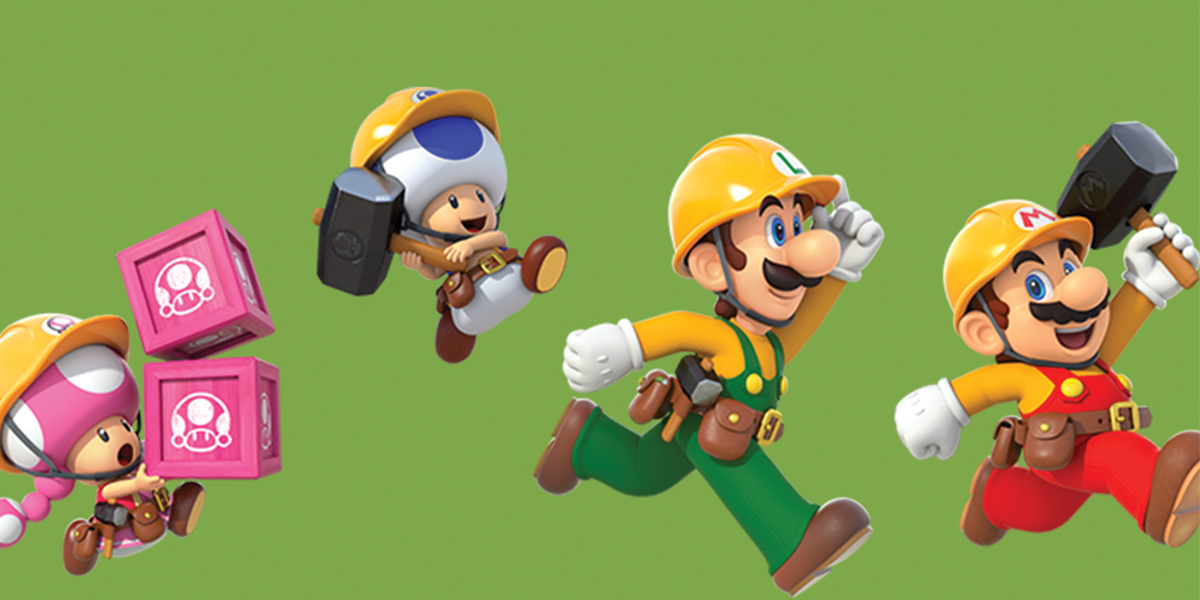
Late last June, the sequel to the beloved Super Mario Maker for the Wii U was released, bringing players back into a vast playground to fulfill their game design dreams. Taking inspiration from the story mode and other player's creations, players set their minds to crafting levels that suit their wildest dreams and astound those who would wish to participate.
While I was unable to play the first game, I was relatively familiar with the system because I spent quite some time watching playthroughs when it first came out. I was in awe of the innovating level design so when the second version came out, I wanted to play and maybe even create something myself someday. Surrounded by brilliant creations, my personal journey into this realm was preceded by a vague hope of creating levels that were just as perfect and fun as those done by the best. Soon enough, I clicked in the Super Mario Maker 2 cartridge and booted up the maker.
I was not the best.
I assumed my first levels wouldn't be the greatest, but I didn't realize just how difficult it was to grasp concepts that seemed intuitive to my peers. I was convinced that I could immediately jump in with mega cohesive levels that taught the player as they went and left them challenged but not cheated. However, all I was left with was a blank canvas, the saccharine blue sky taunting me from the other side of the screen.
After two days, all I did was erase and replace; erase and replace. How could I put anything out there if it's not the best I can do? Every choice was followed by me questioning if it was cheatable or too hard or too easy, and I couldn't bring myself to test it on others for fear of showing my work.
I was not the best at looking at the situation clearly.
After wallowing in my own perceived insufficiencies, I caught wind that one of the many Super Mario Maker 2 level creators crafted a stage based off of Touhou, a bullet hell game which while complex and hard to design, is structurally very different from a Mario game. It didn't fit the mold that I was forcing myself to conform to, but it was an incredible feat of effort. It was then that I realized I may have been missing the point.
Super Mario Maker isn't about making the best level, it's about making your best level and improving your own game design skills over time. I had lost sight of what the freedom of Super Mario Maker meant, which was to design as you pleased. No one's first level will turn out perfect, and if it's not from your own imagination, then what's the point?
Eventually, I booted up the game again, discovered you could take Lakitus off of their clouds and burnt an hour making something I enjoyed making. Messing around by flying across the screen just felt right at the time, so I tried to make something that would let me do that many times. Was it perfect? No. Was it good? Probably. But now I think I'm ready to give it to someone for comment so I can learn from my mistakes and use them to make the next level that much better.

Eleanor Mather is a 17-year-old high school senior at Horace Mann High School in Bronx, New York. She has enjoyed playing games since playing Pokémon Platinum with her brother and friends and has grown to love discussing and developing them in the past years. She is very excited to contribute her thoughts to the conversation on games as a medium and hopes to encourage others to join in.
This year at SXSW Edu in Austin, Texas, we'll be presenting a panel discussion entitled, Teens as Changemakers: SEL Through Game Design, where we'll share insights on the social and emotional learning opportunities that games and game design offer for teens. To learn more about the power of constructionist games like Super Mario Maker 2, check out this blog post written by our SXSW Edu co-presenter Matthew Farber.
Tabletop RPGs and Learning to Live with Failure

If I can be completely honest, I used to be and I still am not the best at boss fights. In platformers, I squirm at difficult timing or a misplaced jump that resets the entire fight, and in RPGs, I repeatedly forget to stock up on healing items before a difficult battle. Fortunately for me, I can avoid these pitfalls and start again rather easily by resetting my game. I can tell when a jump will land me a game over and reset to avoid the depressing trumpet and sad animations, and thanks to multiple save files I can easily go back to a shop and return to the battle thoroughly prepared. This was all through existing aspects of the game's console, so it never felt like cheating. When I was introduced to tabletop RPGs, I was looking forward to taking on an indestructible persona that I was used to in many games that I had played at the time. My first roll was a 1.

Flicker - D20, Anaglyph
The D20 has become a ubiquitous symbol of many tabletop games (namely D&D), deciding the fates of many players when making character checks to see if they can succeed to the extent that the player imagines. Unlike in many video games that I have played, the dice role is irreversible under most circumstances. In hindsight, of course, it is. The GM's goal is to create a believable world for their players to interact with, and if one's character was able to avoid challenge or failure at every turn, then there would be little to no stakes. In time, I found just how much more gratifying this format is compared to my old habits.
With the 'failure' of one plan comes the opportunity for another plan to flourish. My character may have failed to talk up an opponent and convince them to drop their weapons, but the rest of the party can take advantage of the situation and make the opponent get one of them stuck in a wall and prepare a counterattack. When you're in an environment where you can fail, you're given a chance to see that there are more solutions to be found. And in some cases, the recovery can lead to a more promising conclusion.
Practicing 'failure' through my tabletop RPG adventures has helped me in my real-life adventures as well. Seeing a mishap as an opportunity to see a different path makes life events much less daunting; there is not necessarily a 'point of no return' to run from, and even a terrible situation can be turned into something neutral, or maybe even positive.
I used to recoil more often at the thought of rainy days in the summer; much of the joy I get from the season is from being outdoors, and a few droplets felt like time wasted. Strangely enough, the pitter-patter of the droplets is not only perfect for reading, but for setting the tone during a tabletop RPG as well. What a perfect unexpected mishap, a catalyst to learn more through the fictional dungeons, villains, and perhaps even airship crashes created by a GM's hand.

Eleanor Mather is a 17-year-old rising senior currently attending Horace Mann High School in the Bronx. She has enjoyed playing games since playing Pokémon Platinum with her brother and friends and has grown to love discussing and developing them in the past years. She is very excited to contribute her thoughts to the conversation on games as a medium and hopes to encourage others to join in.
Video Games and Suicide Prevention

If you are experiencing a crisis or having thoughts of suicide, please contact the National Suicide Prevention Lifeline at 1-800-273-TALK (8255), the Crisis Text Line by texting HOME to 741741, or visit the nearest emergency room.
Suicide is a growing public health problem and the second leading cause of death among young people in the US and worldwide (Hedegaard & Curtin, 2018; World Health Organization, 2018). People may attempt suicide when they feel overwhelmed by problems, pain, and hopelessness but feel they lack the resources or support to cope (Verrocchio et al., 2016). Connecting people to others who can provide mental health support and assistance with coping skills helps prevent suicide (Stone et al., 2017), and video games can play an important role by fostering connections and support. Whether through in-game interactions, membership on teams or guilds of players, or interactions on communication/media platforms such as Discord and Twitch, games offer many opportunities for players to communicate and connect (Colder Carras, Rooij, et al., 2018; Kowert & Quandt, 2016). Recently, video game communities have been tackling the need for mental health support and suicide prevention for their members through a variety of innovative programs. iThrive Games is happy to be talking about our efforts in an upcoming panel called Suicide Prevention in Video Game Communities to be held April 27 at the American Association of Suicidology annual conference in Denver, Colorado.

Famous screenshot from Legend of Zelda (Nintendo, 1986), often used as a meme to encourage others to seek and utilize help.
Many different factors have been linked to suicide. According to one theory, individuals who die by suicide are driven by three factors: feeling that they are a burden to others, feeling frustrated in their efforts to make meaningful connections, and becoming numb to the pain and fear associated with the idea of dying (T. Joiner, 2005; T. E. Joiner et al., 2009). These, along with hopelessness and difficulty with solving problems, making decisions, or seeking help can drive suicide ideation and attempts (Gvion & Levi-Belz, 2018; Joiner et al., 2009). Addressing social isolation/loneliness and problems coping with life stresses can be important targets for suicide prevention programs (Stone et al., 2017). Although about half who die by suicide do not have a mental health diagnosis ("More than a mental health problem," 2018), those who have a diagnosis are more likely to feel like they don't belong (Ma, Batterham, Calear, & Han, 2019). Suicide is a particular risk for some groups such as adolescents, older adults, military veterans, the unemployed, or those with low socioeconomic status (Bryan, Jennings, Jobes, & Bradley, 2012; Nock et al., 2008; World Health Organization, 2018). Members of marginalized groups such as LGBTQI individuals, refugees and immigrants, and indigenous peoples also have higher suicide rates (Forte et al., 2018; Harlow, Bohanna, & Clough, 2014; Hottes, Bogaert, Rhodes, Brennan, & Gesink, 2016).
Preventing suicide is a challenge. Even though we know factors that are associated with more or fewer suicidal thoughts and behaviors, existing prevention programs have yet to make reduced rates of suicide worldwide. One of the most common measures in prevention is gatekeeper training-teaching individuals who are not mental health specialists how to recognize the signs of suicide risk, ask questions about suicidal thoughts and plans and manage suicidal behavior (Stone et al., 2017). Crisis intervention services such as the National Suicide Prevention Lifeline and local call or text centers provide anonymous assessment and counseling by trained individuals who often volunteer from the local community.

Twitter response to the prompt "Tell me about the happiest experience you've had either in a game or because of games? What do they add to your life?"
New approaches to suicide prevention are needed, and recent research has focused on the potential role of video games in suicide prevention. We know that video games help people connect and feel that they belong to a community (Kowert, 2016). Joining teams or guilds, or even just hanging out with people in-game helps players bond through shared activities (Steinkuehler & Williams, 2006; Williams et al., 2006). In a recent study of veterans in treatment for mental health conditions, playing games with others was found to be an important source of social interaction that helped some veterans overcome isolation or assume leadership roles (Colder Carras, Kalbarczyk, et al., 2018). Although taking a break from daily life through games or other entertainment media is a common method of recreation that can help people recharge (Oliver et al., 2015), this study found that some veterans used games to help ward off suicidal thoughts or substance cravings when other coping strategies didn't work (Colder Carras, Kalbarczyk, et al., 2018). Of course, excessive use of games can lead to other problems, so therapists should work with clients to understand the role and uses of gameplay in dealing with life challenges.
Video game groups, researchers, clinicians, and nonprofits are now seeking ways to leverage these potential benefits of video games. iThrive and academic groups such as the Games for Emotional and Mental Health Lab at Radboud University work to develop and promote games that enhance social and emotional learning, reduce anxiety, and teach problem-solving through gameplay experiences. The organization Stack Up provides a host of grassroots, game-related programs that support positive well-being through games, but is best known for its unique online suicide prevention program. STOP (the Stack Up Overwatch Program), which provides anonymous online crisis intervention services and referrals 24/7 for adult members of its Discord server.

Twitter response to the prompt "Tell me about the happiest experience you've had either in a game or because of games? What do they add to your life?"
Other organizations focus on education and messaging to reduce stigma—getting the word out about mental health problems and fostering healthy discussions about coping. The weekly Twitch broadcast PsiStream, led by a licensed mental health counselor, educates viewers about mental health problems and encourages them to ask questions about uncomfortable or challenging topics. The nonprofit organization Take This supports mental health in the game industry through initiatives such as the Ambassador program, which recognizes Twitch streamers who promote positive mental health through their streams. These emerging efforts provide exciting new opportunities to make a difference in suicide prevention and mental health support in the games industry.
Gameplay provides many ways to foster mental health, and the game community is leading the way with innovative programs. Join iThrive on April 27 as we discuss our efforts along with Stack Up and Take This at the American Association of Suicidology meeting. Stay tuned for a link to our live stream on Twitch. And remember that help is available-if you or anyone you know is affected by suicidal thoughts or behavior, contact the National Suicide Lifeline at 1-800-273-TALK (8255) or the Crisis Text Line by texting HOME to 741741.
References
Bryan, C. J., Jennings, K. W., Jobes, D. A., & Bradley, J. C. (2012). Understanding and preventing military suicide. Archives of Suicide Research, 16(2), 95-110.
Colder Carras, M., Kalbarczyk, A., Wells, K., Banks, J., Kowert, R., Gillespie, C., & Latkin, C. (2018). Connection, meaning, and distraction: A qualitative study of video game play and mental health recovery in veterans treated for mental and/or behavioral health problems. Social Science & Medicine. https://doi.org/10.1016/j.socscimed.2018.08.044
Forte, A., Trobia, F., Gualtieri, F., Lamis, D. A., Cardamone, G., Giallonardo, V., ... Pompili, M. (2018). Suicide Risk among Immigrants and Ethnic Minorities: A Literature Overview. International Journal of Environmental Research and Public Health, 15(7). https://doi.org/10.3390/ijerph15071438
Gvion, Y., & Levi-Belz, Y. (2018). Serious Suicide Attempts: Systematic Review of Psychological Risk Factors. Frontiers in Psychiatry, 9. https://doi.org/10.3389/fpsyt.2018.00056
Harlow, A. F., Bohanna, I., & Clough, A. (2014). A systematic review of evaluated suicide prevention programs targeting indigenous youth. Crisis, 35(5), 310-321. https://doi.org/10.1027/0227-5910/a000265
Hottes, T. S., Bogaert, L., Rhodes, A. E., Brennan, D. J., & Gesink, D. (2016). Lifetime Prevalence of Suicide Attempts Among Sexual Minority Adults by Study Sampling Strategies: A Systematic Review and Meta-Analysis. American Journal of Public Health, 106(5), e1-12. https://doi.org/10.2105/AJPH.2016.303088
Joiner, T. E., Van Orden, K. A., Witte, T. K., Selby, E. A., Ribeiro, J. D., Lewis, R., & Rudd, M. D. (2009). Main Predictions of the Interpersonal-Psychological Theory of Suicidal Behavior: Empirical Tests in Two Samples of Young Adults. Journal of Abnormal Psychology, 118(3), 634-646. https://doi.org/10.1037/a0016500
Kowert, R. (2016). Social outcomes: Online game play, social currency, and social ability. In R. (Ed) Kowert & T. (Ed) Quandt (Eds.), The video game debate: Unravelling the physical, social, and psychological effects of digital games. (pp. 94-115). New York, NY, US: Routledge/Taylor & Francis Group. (2015-20483-006).
Ma, J. S., Batterham, P. J., Calear, A. L., & Han, J. (2019). Suicide Risk across Latent Class Subgroups: A Test of the Generalizability of the Interpersonal Psychological Theory of Suicide. Suicide & Life-Threatening Behavior, 49(1), 137-154. https://doi.org/10.1111/sltb.12426
More than a mental health problem. (2018, November 27). Retrieved April 15, 2019, from Centers for Disease Control and Prevention website: https://www.cdc.gov/vitalsigns/suicide/index.html
Niederkrotenthaler, T., Voracek, M., Herberth, A., Till, B., Strauss, M., Etzersdorfer, E., ... Sonneck, G. (2010). Role of media reports in completed and prevented suicide: Werther v. Papageno effects. The British Journal of Psychiatry: The Journal of Mental Science, 197(3), 234-243. https://doi.org/10.1192/bjp.bp.109.074633
Nock, M. K., Borges, G., Bromet, E. J., Alonso, J., Angermeyer, M., Beautrais, A., ... Williams, D. (2008). Cross-national prevalence and risk factors for suicidal ideation, plans and attempts. The British Journal of Psychiatry: The Journal of Mental Science, 192(2), 98-105. https://doi.org/10.1192/bjp.bp.107.040113
Oliver, M. B., Bowman, N. D., Woolley, J. K., Rogers, R., Sherrick, B. I., & Chung, M.-Y. (2015). Video Games as Meaningful Entertainment Experiences. Psychology of Popular Media Culture, 5(4), 390-405. http://dx.doi.org/10.1037/ppm0000066
Steinkuehler, C. A., & Williams, D. (2006). Where Everybody Knows Your (Screen) Name: Online Games as "Third Places." Journal of Computer-Mediated Communication, 11(4), 885-909. https://doi.org/10.1111/j.1083-6101.2006.00300.x
Stone, D., Holland, K., Bartholow, B., Crosby, A., Davis, S., & Wilkins, N. (2017). Preventing Suicide: A Technical Package of Policies, Programs, and Practices. Atlanta, GA: National Center for Injury Prevention and Control, Centers for Disease Control and Prevention.
Williams, D., Ducheneaut, N., Xiong, L., Zhang, Y., Yee, N., & Nickell, E. (2006). From Tree House to Barracks: The Social Life of Guilds in World of Warcraft. Games and Culture: A Journal of Interactive Media, 1(4), 338-361. https://doi.org/10.1177/1555412006292616
World Health Organization. (2014). Preventing suicide: a global imperative. Retrieved from https://apps.who.int/iris/bitstream/handle/10665/131056/9789241564878_eng.pdf?sequence=8
World Health Organization. (2018). National suicide prevention strategies: progress, examples and indicators. Retrieved from https://apps.who.int/iris/bitstream/handle/10665/279765/9789241515016-eng.pdf?ua=1
Exploring the Intersection of Video Games and Mental Health
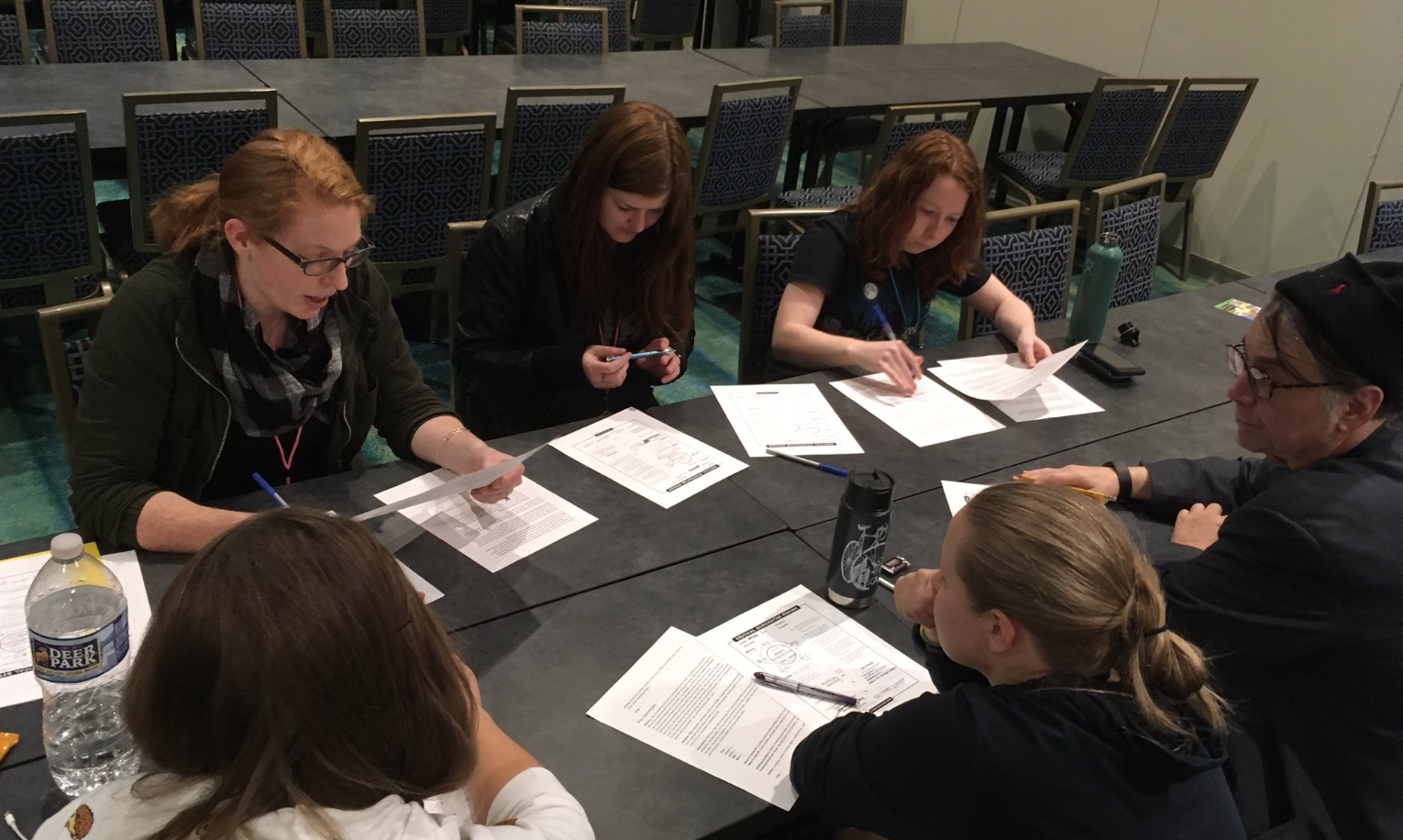
MAGFest 2019 - A Compilation of Panels, Playtesting, and so much more!
Kelli Dunlap, PsyD, director of Mental Health Research and Design at iThrive Games, playing our Critical Strengths Engine (CSE) as she helps a new playtester facilitate the game for the rest of the group.
With over 20,000 people in attendance, iThrive Games was beyond excited and thankful for the opportunity to be a part of MAGFest for the third year in a row. This annual event celebrates music and games while attracting attendees, speakers, musicians, and cosplayers from all over the world. MAGFest enables us to be surrounded by like-minded individuals who believe in promoting prosocial outcomes.
Showcasing iThrive's Critical Strengths Engine
MAGFest Indie Tabletop Showcase featured iThrive's Critical Strengths Engine (CSE), a pen and paper role-playing game ruleset for exploring and supporting social and emotional skill development.
In 2017, Ian McDonald posed this question to us at one of our game jams,
"What if there were a system for tabletop role-playing games (TTRPGs) based around social and emotional attributes like emotional integrity, instead of strength and dexterity?"
To say this piqued our curiosity is an understatement. It launched the idea for the CSE and we've been working on it ever since!
We designed the CSE to be accessible and enjoyable for all players, and were especially mindful in our development that it meet the needs of mental health professionals working with teens.
At the MAGFest panel, The Making of a Therapeutic RPG, iThrive's Kelli Dunlap, PsyD, director of mental health research and design, and Sean Weiland, producer, talked about the collaborative design process for the CSE and shared lessons learned in development and during playtesting. Also on the panel were our CSE collaborators, mental health provider and executive director of the Bodhana Group, Jack Berkenstock, and game designer, Max Raabe. We shared with the audience the unique rewards and challenges of designing with a truly interdisciplinary group, and how we strove to balance fun, a strengths-based focus, engaging stories, and therapeutic relevance.
Jack Berkenstock, mental health provider and executive director of the Bodhana Group, playtesting with a group of eager participants.
During development, our design team at iThrive went through 10 versions of the CSE character sheet. This game structurally lets players bring characters to life by engaging with their strengths and deficits via the "Whys" or circle of character motivation. Therapy often necessitates interacting with difficult issues. We consciously observed and allowed for the CSE to be an analogue where players can use characters to engage with issues that are difficult for them.
Following the panel discussion, 20 people joined us to playtest the CSE. Not only did this playtest extend past midnight, but it was also the largest concurrent playtest of the CSE to date! Playtesters thoroughly enjoyed taking part in the CSE playtest and it was delightful to watch both teams work together within the system of the CSE to solve problems and overcome obstacles that were thrown in their way. Some of the feedback we received from participants included the following,
"Positive! Refreshing! Great to think of solving solutions with emotional strengths rather than physical ones."
"I had a lot of fun! It was neat to focus on motivation."
"Very positive, lots of fun. Far more [than] we would have in another system with no combat. I liked how this focuses on other aspects of traveling/adventuring."
The CSE officially launches this Fall and includes four unique adventures: an official Pugmire story by Eddy Webb; Alteris, a contemporary science fantasy story by Toiya Finley; Dust, a post-apocalyptic survival game by James Portnow; and a fourth untitled story by Bodhanna Group founder, Jack Berkenstock.
Max Raabe, game designer, leading a playtest just after the panel on creating a therapeutic RPG.
Toward A New Vision of Mental Health Representation in Games
Kelli Dunlap spoke on a panel with Tanya DePass, and its organizer Meg Eden on the Mental Health Representation in Games. With standing room only attendance, this panel discussed important issues surrounding the representation, diversity, and accessibility of mental health in games. In addition to sharing their favorite examples of the representation of mental health in games, and tropes and ideas to be avoided, panelists expressed their hopes for what mental health representation could look like in future games.
Tanya said,
"I'd like to see people and characters have mental health as just a matter of course for their character and not have it be the be-all end-all. If a character needs meds or something like that just like everyday life for those that take medication it's not big deal, it's not like 'oh woe is me I have to take meds everyday to regulate my brain, therefore, I'm a garbage human' that a lot of us fall into.... This is something that is part of me and move on with it."
Kelli responded with,
"I would love for there to never be another horror game that uses an asylum ever... We see asylums or mental health institutions or psychiatric hospitals as a shorthand we use in media for 'Be afraid. Be very afraid. Bad things are going to happen.' Has anybody ever played a video game where you woke up in an insane asylum and something good happened to you immediately after? No. The trope is dead. Kill it."
The panelists also answered questions about respectful and ethical ways of dealing with difficult mental health topics within the game design process,
"Give players the chance to opt out of something. You don't know anyone's experience when you're programming a game or what's happening... Things like warnings or give me the chance to opt out or fade to black or something like that because I was not ready to deal with that scene at all." - Tanya DePass
"Games are such a creative medium that you can [do that] in creative ways that can actually benefit the design of the game. Allowing for those options can actually branch into a unique gameplay experience. It doesn't have to limit you." - Meg Eden
After the panel, one of the attendees shared his appreciation and excitement with Kelli saying, "I didn't think a game about ADHD is possible, but after your panel, I think it is and I'm excited to get started."
Keep The Conversation Flowing
At MAGFest, the fun never ceases and the conversations are always flowing. We are so grateful for the opportunity to meet with more people who aim to work to benefit teens at the intersection of game development, education, and mental health. We especially appreciated being part of the Music and Games Education Symposium (MAGES), of MAGFest, where we presented on topics related to the personal and social impact of mental health representation in games, strategies around self-care and confronting impostor syndrome, and designing for cooperation. If these topics interest you and you want to keep up-to-date with all of the happenings and projects here at iThrive, please sign up for our newsletter.
Game designer Max Raabe and Sean Weiland producer at iThrive Games (top left), the tabletop role-playing game (TTRPG) panel (top center), Kelli Dunlap, PsyD, director of Mental Health Research and Design at iThrive (top right), Jack Berkenstock executive director of the Bodhana Group, Max Raabe game designer, Sean, and Kelli (Bottom)
Live Action Role Playing To Support Healthy Teen Development
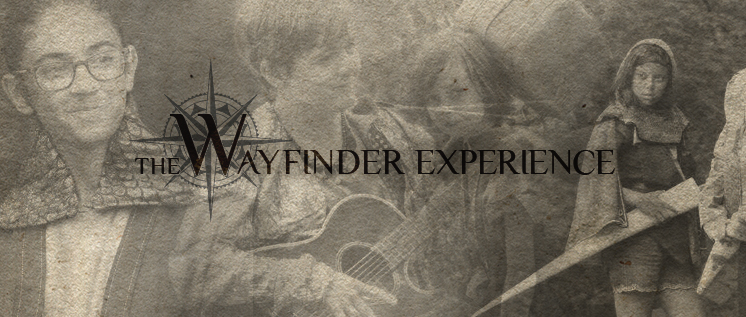
The summer I was 14, I saved the world for the first time. I also attempted to destroy it, spied on the Illuminati, and journeyed into the underworld, all in the span of two weeks. That's what happens when you go off to a summer camp for live action role playing or "larping." I went back every summer throughout my teen years, playing dozens of characters in different worlds. It wasn't long before I was writing games of my own, both for my friends at home and for the camp, the Wayfinder Experience. Over a decade later, I'm a professional larp writer and serve on Wayfinder's Story Board, helping mentor up-and-coming teen game writers as they create new worlds in which to tell stories and explore who they are.
I've run many games of my own, both at Wayfinder and elsewhere, and have learned a great deal about how to create a meaningful experience for teens before, during, and after gameplay. One of the joys of larp design for teens is that their feedback is immediate and obvious — their reactions to design choices are rarely subtle. So here are some takeaways that are relevant not just to larp design but all kinds of game creation for teens.
Design to Support Identity Exploration
One of the most powerful elements of larping is the act of embodying a character that you as a player help create. Sometimes you start from an existing character outline and sometimes you create one from scratch. Regardless, you are an active participant in the creative process, adding details and backstory and identity elements. Players of all ages use this as an opportunity to explore, but teens especially experiment with different possible versions of themselves. They might try larping as a more confident person, or a person with a different gender presentation. Often, these experiments help them test the waters, seeing what it feels like to be who they want to be — or who they could become.
This kind of experimental identity play shows up as soon as players are offered the slightest opportunity to impact a character. When I was in middle school, I loved the video game Chrono Trigger. The only choice I had as a player was to set the characters' names, but you bet I chose my own for the main character, and set the other party members' names to match those of my friends. I wanted to pretend that I could be that adventurous hero, even before larping gave me the opportunity to embody that hero physically.
When you are designing games, consider how your design allows for or encourages the character creation process. What elements of personal identity can players bring into the game? Will those choices have an impact on the game? Will their choices be reflected and respected, or ignored and contradicted by the game as designed? Giving players the freedom to experiment with their self-representation can be a profound tool for exploration.
Design to Support Storytelling
A larp isn't just one story — it's as many stories as there are players. Player each experience their own storyline, all in parallel with one another. This gives players the freedom to seek out different kinds of narratives, and teens will always gravitate on their own to the stories they find compelling and rewarding.
When I was a camper, my best friend always made sure his storylines revolved around epic romances, often ending tragically. He'd find another player or two, create a love triangle, and dig in deep, seeking out a kind of play that I had little interest in. I was more drawn to the political machinations, the schemes and betrayals. But I couldn't help wondering what my friend found in those romances, so I started trying to play with similar narratives. That exploratory process started helping me figure out my own identities.
Over the years, I've seen teen after teen find themselves drawn to particular kinds of play. The types they choose are often very revealing, whether or not the players are consciously aware of it. Allowing that kind of freedom as the designer can be hugely rewarding. If your game design gives players the freedom to seek or create narratives within the larger structure, they will naturally gravitate to the places they feel comfortable and find ways to explore and play.
Provide Scaffolding
While many larps are designed as escapist fun (a worthy end goal in its own right!), some designers build larps with education as the cornerstone. These "edu-larps" can take many forms, from short scenarios to be played in a history classroom up through full weekend-long, immersive adventures. There's a boarding school in Denmark built around edu-larping! Even larps that don't have education as their primary focus can bring in useful tools from edu-larping, though, and help teens grasp important lessons.
A key concept from educational larp design is creating structures that players can use to build their own lessons — what educators call scaffolds. These scaffolds help guide play, both in and out of character, and come in many forms. They could take the form of backstory provided before the game starts, structured decisions with clear options, or just about anything else. Some scaffolds are straightforward, such as providing a moral choice about how to treat a captive prisoner, while others might be subtler, like including characters who are struggling with complex emotional challenges that might mirror the lives of the players.
Years ago, I ran a game set in the mind of a teen girl, with the characters embodying her memories, personality aspects, hopes, and fears. The fears manifested as demons, but as part of the character design, each could be redeemed into a positive version. Isolation could become independence, stagnation could become stability, and so on. One young player confronted the fear of change, and in a tearful scene helped it become growth and moving on from pain. She sent me an email a week later thanking me for the game. She told me that her mother had died recently, and the things she'd been shouting in that scene were very real. The scaffold of the demon's redemption gave her a path she could use to transform her real grief and build an emotional outlet that she could carry forward into her life after the game.
Healthy scaffolding gives guidance that encourages productive avenues of exploration without feeling restrictive or overly didactic. A well-built scaffold can lay down a framework which teens will use to ground their own exploration. The truth is that most games are full of scaffolds, but many are unintentional. An often overlooked part of the game design process is to take a step back and consider what lessons and narratives your design is actually scaffolding. Are there particular choices your characters are making? Are there options that your design closes off or encourages? Are there ways your mechanics and themes are at odds?
You can never (and probably shouldn't try to) completely control the lessons that your players will take away from your games, but good scaffolding can encourage the ideas you want to support.
Provide Recaps and Debriefs
Whether or not game designers realize it, the gameplay experiences doesn't always end when the game itself does. Most larps have some kind of post-game wrap-up, whether it's a party or a diner run or a more formal debriefing process. Wayfinder uses what we call a de-rolling workshop to help ease our players out of the fantasy world and back into their default realities and lives. The next day, we have a story circle where everyone shares their favorite moments from the game and the writer provides an epilogue or closure.
These kinds of recaps serve a number of useful purposes. On a psychological level, they provide a sense of closure, which is helpful both for players whose stories ended cleanly and those who wish they had a more satisfying ending. The storytelling process also helps create emotional distance, separating the player and the character, which can be necessary after emotionally intense games. Game theorists often talk about the concept (coined by Johan Huizinga) of a magic circle, a space for play set aside from the real world. Recaps and formalized debriefs help players transition back out of the magic circle.
On a more practical level, recaps also help players spell out important lessons they learned from the game. This is especially useful with younger players, who may not have realized the game's relevance to their real lives during gameplay. Prompting them to consider the parallels with their real lives once the game is over can help them carry that awareness forward. It also gives them nice clear stories they can take home to their parents.
Here are the biggest lessons I've learned for designing meaningful experiences for teens:
- Allow players to participate in the character process, or at least provide space for them to apply their own concepts to the existing characters.
- Give players options to seek out narratives that they find compelling, and pay attention to what they gravitate towards.
- Provide your players with scaffolds for them to build lessons from. Give them clear choices, and consider the ways your design supports or undermines the lessons you want to be imparting.
- When the game is over, take time to recap the game with your players, both to help transition them back to reality and to help cement the ideas you want them to carry forward.
__________
About the Author

About iThrive's Critical Strengths Engine
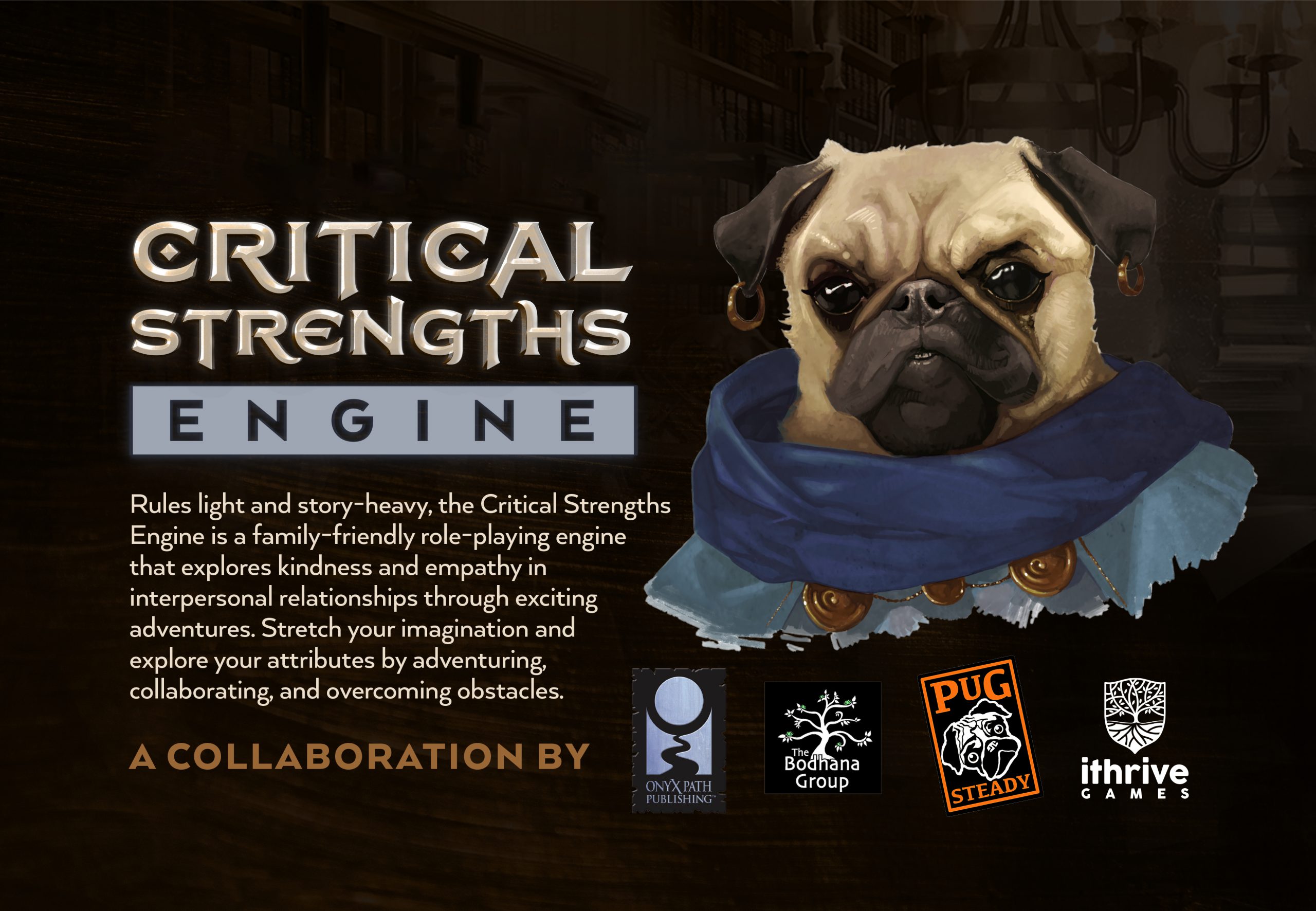
At GenCon earlier this month, we were delighted to announce our Critical Strengths Engine. Critical Strengths is a tabletop role-playing game (RPG) engine — or ruleset with which to play tabletop RPGs — that applies the science of empathy and kindness to exploring interpersonal relationships through adventures. We are developing this engine in partnership with renowned RPG publisher, Onyx Path Publishing (known for such popular RPG titles as Wraith and World of Darkness); Pugsteady, the beloved RPG developer of Pugmire (an RPG starring dogs); and mental health providers from the Bodhana Group.
If you're familiar with the world of tabletop RPGs, Critical Strengths is a rules-lite, story-heavy engine designed to stretch your social skills and emotional acuity. Classic attributes such as constitution (CON), dexterity (DEX), and intelligence (INT) have been replaced with social and emotional abilities like perspective (Mind), self-control (Will), and self-advocacy (Voice).
If you're unfamiliar with tabletop RPGs, that's okay! We specifically designed the game to be accessible to newcomers. In general, "RPG" refers to a game in which players assume the roles of characters in a fictional setting. A tabletop RPG is one played in a physical — rather than digital — space and often requires the use of pen and paper or a game board.
Critical Strengths is the ruleset or framework within which players take on their roles in order to accomplish a specific goal. In traditional tabletop RPGs, players are given skill sets such as dexterity or wisdom and use these attributes to inform how their character would solve a problem, interact with other characters, and react in a specific situation. Instead of attributes that determine how agile or wise a character is, Critical Strengths uses attributes tied to social and emotional skills. The goal is to encourage players to playfully explore how different strengths or deficits in social and emotional skills can help or hinder the player's progress in a variety of different situations.
We developed Critical Strengths for all players who enjoy a tabletop RPG experience of interpersonal intrigue. But because we developed Critical Strengths in cooperation with mental health professionals who regularly use tabletop games as part of the therapeutic process, Critical Strengths can also be used specifically in clinical and therapeutic settings as a way to engage teens actively in their own treatment. The attributes, narratives, and mechanics core to Critical Strengths enable facilitators to create an environment that actively elicits the kinds of social, emotional, and cognitive skills often targeted in therapy, such as empathy, social connectivity, and perspective-taking, all while teens explore, try new things, fail, and succeed in a playful, supportive space.
Over the next several months, iThrive and our amazing partners will continue to develop the Critical Strengths Engine. In the next few months, we'll be collaborating with authors to craft narratives for the engine, one of which will be an official Pugmire adventure! We'll also be writing essential content such as a facilitator's guide and a list of special suggested house rules that take a player's physical, emotional, cognitive, and social abilities into consideration. And last but not least, we'll be refining our rules and mechanics through playtesting. Lots and lots of playtesting. In fact, we may even be playtesting in a city near you! Stay tuned to our newsletter for more information about our next public playtest and other iThrive updates.
Game Culture is As Important As the Game

Do you floss? I'm talking about the dance, not dental hygiene, and I think everyone should at least know one reason flossing is so popular.
I recently learned to floss because my 7-year-old niece and I disagreed on how it's done. Who was right doesn't matter. What does matter is that my 7-year-old niece knows the dance because it is popular in Fortnite, a game rated Teen (suitable for ages 13 and up) by the ESRB. My niece has never played Fortnite and it's possible that many of her friends have not played it either. But Fortnite isn't just a game. Elements of it, flossing included, have colored the surrounding youth culture. Fortnite has inspired prom invitations and helped shy kids gain popularity. And I've found that the culture surrounding games like Fortnite can provide mental health clinicians with meaningful opportunities to connect with clients.
(Image from https://www.tes.com/news/fortnite-classroom-floss-dance-craze-sweeping-schools)
Gaming As a Language
As a mental health counselor, I once worked with a teenage client who loved to play Destiny, a popular - although not as popular as Fortnite - sci-fi-themed, multiplayer, online first-person shooter. Being an online game, it was impossible for us to play the game in my office. Well, unless I set up two televisions, two consoles, and connected both to the internet. That was not the setup I had, but what we could easily do was talk about the game and share stories. When he found out I also loved to play Destiny, it helped us build our therapeutic relationship and I could immediately tell that he felt more comfortable in therapy. Just knowing that I enjoyed the game helped my client feel like I could understand him better. And since we both knew the game so well, Destiny references became a second language we used in our sessions.
He talked to me about his favorite moments from a match and we discussed how he socialized online with his friends and people he didn't know. We were able to talk about value in terms of the colors used for engrams (in-game prizes) and used the "loot cave" (a location in the game from which it was very easy to gain prizes and which was later removed by developers) as a metaphor for something that changed despite people wanting it to stay the same.
My client started bringing videos of his in-game accomplishments to our sessions. He wanted to share some of his greatest and funniest gaming moments with me, and I welcomed this sharing. However, we saved these moments for the end of our sessions because we agreed our focus should be on learning to deal with his anxiety. But hearing him talk about the in-game moments that mattered to him in his own voice and seeing his actions on the screen helped me appreciate what he was like in a more natural, comfortable setting and how much the game meant to him.
(Destiny 2 by Bungie. Photo from https://www.destinythegame.com/size-requirements)
Like in Fortnite, dancing is a big part of Destiny. It's what you do to celebrate or kill time, and sometimes you start a dance party where lots of people just, well, dance. Other than playing the game yourself, watching a livestream on Twitch is the best way to begin to appreciate the culture around dancing in a game like Destiny.
I suggest that clinicians explore the games their clients seem to care about, from watching Twitch streams to playing the game themselves if possible.
Understanding the culture around a game can build a bridge to discussing lived experiences outside of the game. My client once showed me a video of him "cheesing" a boss battle and it opened the door to a serious conversation about cheating on a test in school. Is "cheesing" the same as cheating? Is it acceptable to cheat if you never get caught? Is it the teacher's fault that it was so easy to cheat? Our understanding of the game and its culture made talking about aspects of his life a lot easier.
If my client had not brought footage of himself playing, I would have had only an idea of what playing Destiny was like for him, based on my own experiences. I can look up information on a game and watch news coverage or trailers, but those videos will not always help me understand the culture surrounding the game.
Boundary Setting
In terms of setting appropriate boundaries with my client, I did face a conundrum around our shared interest in Destiny. One day, he asked if we could become friends on the PlayStation Network so we could play Destiny together online. I explained that there were particular boundaries we needed to set. I realized he found it difficult to understand this particular boundary. He understood that I was his therapist and that we couldn't be friends or hang out between sessions. But being an online friend seemed different. And if we both played Destiny, why couldn't we play Destiny and fight the enemies together?
After that session, I made changes to my intake and consent forms to address this boundary. I wanted to make sure that all my clients understood that even just being in the same game clan was a dual relationship and we should avoid these whenever possible.
Even if we couldn't play together, I know my client understood that we were both Guardians, rekindled by the light of the Traveler, and that when you finish a Nightfall you celebrate with a dance party. That kind of understanding only comes from deeply sharing an interest with your client. But every clinician can show at least some interest — that can go a long way and can be a very important part of the therapeutic relationship. Start by asking your clients what they like and take it from there.
__________
About the Author

The 2018 Design Hive: Plenty of Buzz, and a Real Bee
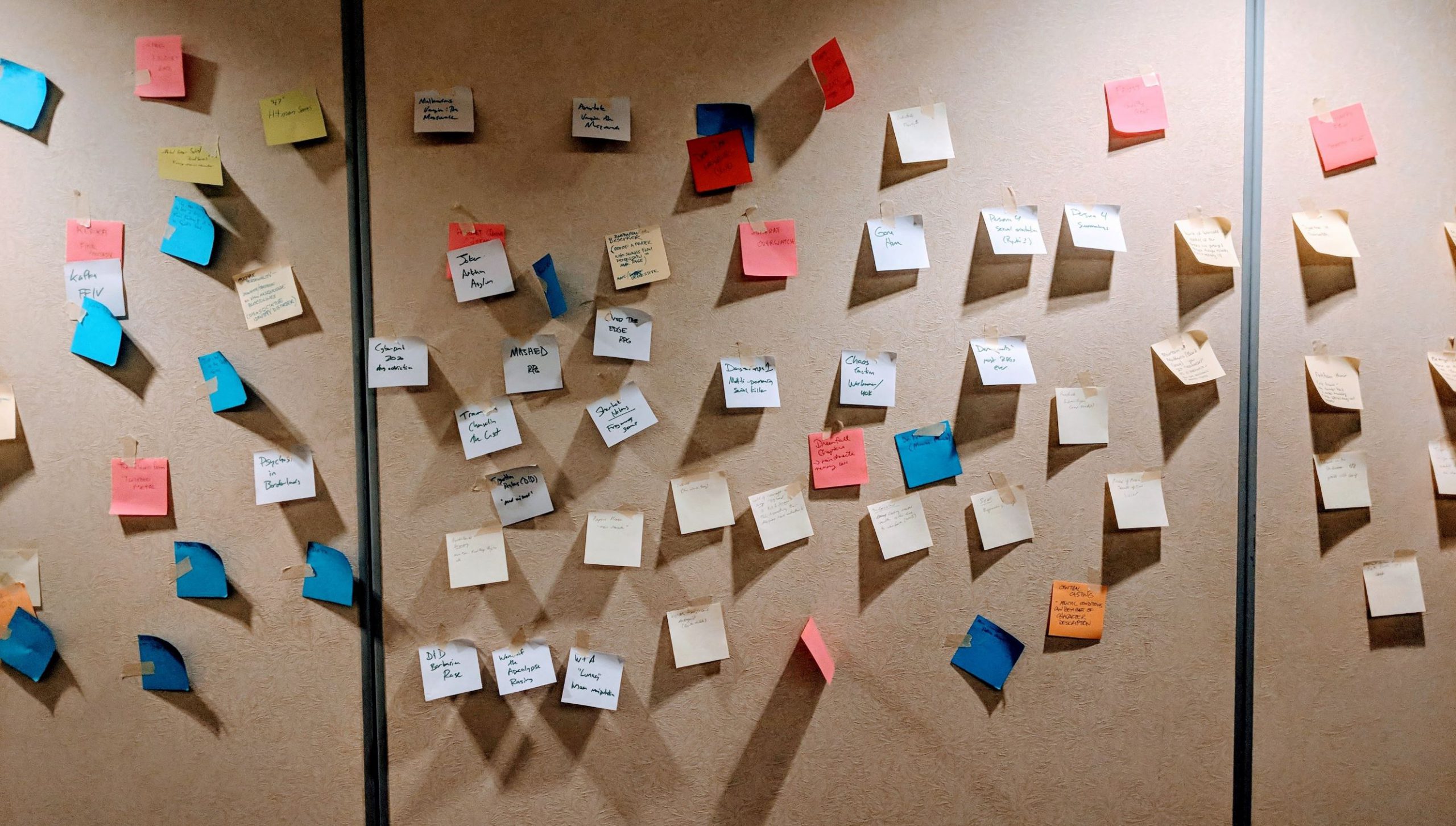
iThrive Design Hives are annual retreats with veteran game developers and scholars in the field. The iThrive team, along with these folks, works to identify best practices in game design, on various topics, after we review the scientific literature around components of social and emotional well-being. We seek to produce resources that support the design of compelling and engaging games around habits like empathy, stress management, curiosity, kindness, and many other strengthening practices.

Design Hive discussions inform iThrive Design Kits — our design tools for game developers — and other projects and products, like our in-development RPG engine, the Critical Strengths Engine. The iThrive Design Kits that result from discussions at these Hives are field-tested at iThrive Game Jams as part of the iteration process. Among other Hive topics, we nearly always source from experts a good portion of the design guidance that eventually becomes a Design Kit (that is, when we're not playing games, swimming in the pool, eating creme brulee, and flying drones in people's hotel rooms).
This year, we held our Design Hive at the Tapatio Cliffs Hilton in Phoenix, Arizona, where it was a mild 106 degrees! We were lucky enough to host these attendees, each of whom added something unique to the experience:
-
-
- Ellen Beeman, a fascinating conversational partner who shared thoughtful insights to support the continued development of the Critical Strengths Engine and our work with universities.
-
- Osama Dorias, who was able to frame our conversations from the perspective of a professional developer and ground us in realistic game production processes and schedules.
-
- Rami Ismail, who reminded us to think globally since teenagers in different parts of the world don't always care about the same things.
-
- Jennell Jaquays, who provided valuable historical context around games and shared particularly good advice on our Critical Strengths Engine.
-
- Molly Proffitt, our secret weapon as far as keeping conversations focused and helping to (literally) arrange the insights into something that made sense; she categorized over a hundred post-its in a matter of minutes!
-
- Mike Sellers, who enriched our discussions with his masterful way of analyzing and designing games as systems, and also shared his good humor and intimate knowledge of the industry.
-
- Ian Schreiber, who always asked exactly the right questions to get the group talking thoughtfully. We especially benefited from his encyclopedic knowledge of games and game mechanics.
- Eddy Webb, whose analytical mind left no doubt as to why he's such a big Sherlock Holmes fan! He helped the group arrive at important insights and is a fantastic gamerunner.
-
We playtested our Critical Strengths Engine using an adventure, created by Eddy Webb, which takes place in the Pugmire universe. We all got the chance to "be a good dog"! Ian Schreiber was particularly pleased to play alongside Eddy because, as he said, it's always extra special to get to play a game run by its creator. Personally, I was happy to have defeated a group of undead cats by throwing catnip at them.
We also dove deep on several topics near and dear to the mission and heart of iThrive, and our discussions resulted in these in-development projects (look out for them on our website soon!):
-
- Design Kits on the topics of:
-
- Designing for teens
-
- Designing for mental health games
- Designing for self-reflection and self-awareness
-
- Design Kits on the topics of:
- A new iteration of our Critical Strengths Engine
There was one thing that particularly warmed my heart. Osama Dorias, who founded the IGDA's Muslims in Games SIG, had met Rami Ismail before but had never really gotten to hang out with him. The sense of brotherhood that developed between these two at our Design Hive was palpable. They taught each other card tricks at the dinner table, flew drones, and laughed and had the greatest time. It was so rewarding to see this happen because we'd invited them both to our event.

We also, ironically, had an actual bee show up at the Hive this year. It flew in right after lunch. I am personally allergic to bee stings and didn't have an EpiPen on me in the conference room. Mike Sellers and Jennell Jaquays cooperated to temporarily trap it under a drinking glass, saving me from harm. We then wondered whether we should ask the bee about its thoughts and feelings on designing games for teens, as Jennell noted, it was now a captive audience.
The Design Hives are the highlight of my professional year and are so valuable to furthering iThrive's work in the game developer community. I'm grateful to iThrive team members who participated in planning and facilitating, and to our attendees, who brought their brains, their hearts, their humor, and in some cases, their drones and their games, to share with us. This event left me the very best kind of exhausted, but, I need to rest up and hop to it, because there is such important work to do as a result of this!
Virtual Reality and the Search For Happiness

Happiness is a habit and a skill. According to Richard J. Davidson, professor of psychology and psychiatry at the University of Wisconsin-Madison, the brain can learn to maintain happier, more compassionate states through consistent training. I believe that one way this kind of training can be done is through the responsible and intentional design of virtual reality (VR) and video games to support the experience of flow.
Flow can be defined as a "state in which people are so involved in an activity that nothing else seems to matter; the experience itself is so enjoyable that people will do it even at great cost, for the sheer sake of doing it." Flow is the zone in which the challenge we face is well balanced with the skills we have — the task is appropriately difficult to keep us from getting bored, but not so difficult that we become frustrated or anxious.

Flow is the state you enter when, among other conditions, your skills are a good match for the challenge before you. Image source
Game designers are no strangers to flow. Raph Koster popularized the relationship between flow and video games in his book, "A Theory of Fun," and flow has been a part of game design discussions ever since. But flow existed long before video games. In his book, Flow: The Psychology of Optimal Experience, Mihaly Csikszentmihalyi describes how everyone from farmers in remote lands, to master meditators, to entire civilizations have thrived by tapping into flow. And it makes sense why people spend so much time searching for flow: Steven Kotler, co-founder of the Flow Genome Project, describes how flow helps us perform better, makes us less self-conscious, and releases some of the most potent feel-good chemicals in the brain.
Action sports, meditation, creative activities, and religious experiences are some of many potential sources of flow. Video games are, too, because their very design aligns with some of the conditions for flow: namely, having concrete goals, demanding action just on the cusp of a person's capabilities, clear and timely feedback, and reduction of distractions. (In contrast, watching television is too passive an activity to meet these flow criteria). Video games are good at putting players in flow, but more progress can be made. Kotler describes flow as an emotion that we can experience in a shallow or deep manner. VR may be the key to reaching deeper levels of flow than non-VR video games support.
In Kotler's recent book (co-authored with Jamie Wheal), "Stealing Fire: How Silicon Valley, the Navy SEALs, and Maverick Scientists Are Revolutionizing the Way We Live and Work," the authors share that "Palo Alto Neuroscience, a Silicon Valley startup, has developed a system that can tag the biomarkers of a non-ordinary state [essentially, flow]-that is, brainwaves, heart rate variability, and galvanic skin response—and then use neurofeedback to guide you back there later. Trained meditators like Tibetan monks can put themselves into a transcendental state, and the machine will record their profile. Soon, as the technology matures, a novice will be able to put on the device and use these biomarkers to steer toward the same experience." There are also efforts to recreate different styles of meditation and make them accessible through VR headsets. VR is beginning to offer consciousness-altering experiences at an exciting scale and rate. That means that what once required years of practice may soon be able to be achieved much faster in VR.
[Related article: VR and Empathy: Tread Carefully]
However, a caveat: Csikszentmihalyi points out that flow is neither inherently good nor bad. Flow can be achieved in productive or destructive tasks and is simply a tool to be used wisely. If VR has the potential to induce flow using "passive" experiences where the player is not necessarily putting forth effort, does it still meet all the necessary conditions of flow as it's currently defined? When it comes to VR and flow, developers may need support and resources to ensure that this exciting medium fosters authentic self-development rather than simply an escape or a shortcut.
__________
About the Author

Eric Vignola is a game developer, thinker, and obsessive. He uses artificial intelligence and interactive experiences to help players explore some of life's toughest questions. In the past, Eric has helped create tools that allow video game authors to create more expressive worlds that allow for deeper player interaction through artificial intelligence. Presently, he is creating a game about the experience of being biracial in the United States and feelings of social isolation. Eric is planning to create an online media company that uses micro games and blog posts to help people develop greater levels of emotional intelligence through play.
Friendly Competition: Starting an eSports League at My High School

It's do or die. I'm in the loser's bracket quarter finals. After a defeat to THUNDER, Ontario's third best Super Smash Bros 4 player, I move to the losers bracket to face s0rry. I've never heard of s0rry but I never underestimate a new opponent. After several nail-biting moments, the score is knotted at two wins apiece. The dying seconds of game five approach and I know I'm at a disadvantage. I struggle to distance myself from my opponent and with one flick of the thumbstick, I'm out of the tournament. While I feel a bitter defeat, this loss only ignites my desire to win the next game. At home that night, I turn on my Wii U and start to grind.
My interest in eSports began at a very rudimentary level, before I knew it existed. Little did I suspect that one day I would start my own league. My brothers and I would gather around our TV, the old-school one that had the slot for VHS tapes, and fight to the death on a variety of Nintendo consoles. Mario Kart (rated 6+ years), Goldeneye (rated 13+ years), and Mario Party (rated 8+ years) all brought out my competitive spirit. I always wanted to finish in first place. I'm not sure where this fire came from, but the thrill had me hooked.
I'd owned a few Call of Duty (rated 18+ years) games in the past, a first person shooter series in which teams compete to eliminate an enemy team and, in some cases, control an "objective" like capturing flags or securing building locations. I had always been below mediocre. Somewhere between laughable and horrible. In 2016, Call of Duty Black Ops III (rated 18+ years) was released and I actually became really good. My stats tripled, and I was boasting some impressive numbers. Initially, I didn't quite realize that I was excellent at the game, but when it finally sunk in I felt this moment of excitement and desire to play more. This development led me to establish my own eSports team, Onyx eSports, after connecting with people who matched my skill level.

Author (middle) and the two friends who helped him start the eSports league dressed as Luigi, Mario, and Wario for Halloween. Image: Author
After many tournament wins and climbing North American ranks, I developed a passion. Every gun fight I won, every clutch situation that went my way, made me feel unstoppable. I would daydream about eSports, replaying scenarios in my head of flanking enemy lines and memorizing capture point rotations. I would nerd out thinking about the game, and when competition crossed my mind I got excited. I loved it.
In my junior year I was offered a spot to run the Gamers Union club at my school, which was fun, but I felt like we could do more. Lightbulb. Let's feature eSports in the club! Around the same time I transitioned between playing Call of Duty at a professional level to playing Super Smash Bros 4. Super Smash Bros (rated 11+ years) is a Nintendo fighting game series where characters from a variety of different games duke it out in whacky combat. When Smash Bros was featured in the club it was always a big hit and, with my newfound love for the game, I knew that I would have no trouble using my passion to turn my idea of eSports in schools into a reality.
When I first announced it in assembly, this idea was met with laughter, primarily from staff. Frankly, I didn't blame them. My school had never been exposed to eSports and the idea might seem outlandish to the staff members who did not grow up playing video games or watching Twitch streams. That said, students were excited and the club's attendance tripled as a result. Several months went by. The Super Smash Bros Tournament had ended and it appeared that people were now on board with the idea. We packed a lunch hall with almost every student to witness the final match. It was breathtaking, and this tournament was just the beginning.

The thrill of a good challenge is written on students' faces at a league competition at Royal St. George's College for boys, Toronto, Canada. Image: Author
After the success of the league, I joined forces with two friends who participated in our first eSports tournament to create something big: the Coalition of Independent Schools eSports League. Our goal was not just to bring people together for friendly competition, but to compete against other schools. We marketed the idea to other schools and within a few months, the league was born.
From my experience operating these leagues over the past two years I now understand the profound impact that eSports has had on me and those who participated. I have always been a competitive person. But eSports is unlike any competitive energy I have ever experienced. There's something about the thrill of winning and the enraging feeling of losing that makes me push myself. This mindset of resilience has improved not only my gameplay, but my academic life, as I have seen a noticeable change in my work ethic over the past three years. My average has climbed up 10 points since I started competing, and I have no doubt that the mindset I carry with me to my everyday life is a contributing factor.
The beauty of eSports is that it is all you need to get started are a set of hands and a brain. I've seen a range of people compete, from those who have never touched a controller to those who have played games for years. eSports is a space where anyone can participate and succeed. You do not need to be an athlete or mathematician and that is a core strength of eSports.
In addition, I have seen some tremendous friendships grow from these friendly competitions. In my athletic career, I never made friends with my opponents unless I knew them from some other part of my life. Our eSports competitions are different. During downtime between matches the room is full of smiling, camaraderie, and laughter. I have known many quiet players who don't normally assert themselves in social situations flourish into charismatic people. The social connection that I have seen come out of eSports is something special and rare in other arenas of competition.
I believe this league is the start of something big. It was a relatively challenging task to get the league off its feet but I'm certain that it will continue to grow in popularity over time. The mindset that I have gained from my experience competing has a positive impact on my work ethic and who I am as a person. The number of people I have seen flourish, from the quiet types to the social butterflies, is vast. You give a gamer a game and they'll play it. You give a gamer an opponent and now they have something to play for.
__________
About the Author

Michael Vassos is a student from Toronto, Ontario, currently enrolled to study Media, Information and Technoculture at the University of Western Ontario this fall, with early admission into the Richard Ivey School of Business. Michael's interest in video games has led him to a passion for eSports. He has participated in over 20 professional level tournaments under the name "KnucklesUp" for the game Super Smash Bros for Wii U. His best result is a fourth-place finish at No Chill Gaming Tournaments on July 15th, 2018. Aside from gaming, Michael enjoys creating artwork through photoshop, camping, politics, and cooking on the barbeque.
Student Game Developers Win for Compassion in Accessibility

In early June, I was fortunate enough to be a guest speaker at the Gotland Games Conference (GGC) in Visby, Sweden. The GGC is an annual festival at Uppsala University, where the students present and demo their game projects and compete for awards, and where speakers deliver lectures on a yearly theme. I was invited this year because the theme was empathy, something that Uppsala folks saw me speak about at the Game Developers Conference (GDC) earlier in the year.
Gotland is an island in the middle of the Baltic Sea, equidistant from mainland Sweden, Denmark, and Russia. It's a location that might have been suggested by the History Channel television show, "Vikings," with a wall that's over a thousand years old, rocky cliffs, and steep hillsides. In the village of Visby, where the university is, narrow cobbled streets twist around old world buildings, modern buildings, and centuries-old ruins alike in a labyrinthine manner. It's a popular vacation spot for Swedes, where everyone walks everywhere or rides bicycles.

Visby, Sweden
This kind of atmosphere is delightful, quaint, very active, and sustainable, but can make life challenging for people like myself who have rheumatoid arthritis, an autoimmune condition where my body declares war on itself in response to weather changes, too much stress, or too much physical activity. Imagine yourself with the flu...the fever, body aches, and exhaustion. Now, imagine that you feel this way every time it rains, or you travel from one temperature into another, or you're stressed out, or you've walked half a mile. It's a constant trade-off about your energy and pain levels, wondering things like, "If I walk uphill ten blocks to that restaurant tonight, will my mobility be affected tomorrow morning when I need to get to the university for my talk?" Gotland is lovely, but there aren't really any meaningful accommodations there for people with mobility issues, so I had to think extra hard about the tradeoffs while I was there.
My first trip to Gotland was in 2013, when I gave a talk about narrative as a tool for inclusiveness in games. Back then, I was particularly impressed by the creativity and game development abilities of Uppsala's students, which are as fine as the best I've seen around the world. They often make games with particularly creative kinds of controllers, and games with very physical components, like one displayed at GDC where you had to lie in a coffin with a cell phone and text with someone on the outside who would help you escape. This year was no exception. There was a game where your controller was on the underside of a couch cushion, so you had to play by scooting your body one way or another. There was a game where you had to physically shovel "coal" into a "coal chute" in order to make the train onscreen go. There was a game where you had to balance your weight, seesaw style, on a shifting platform in order to engage in an onscreen battle between two elevators, suspended on cords. (Yeah. Fighting elevators. It was rad.)
As a speaker, I was also a juror for the awards, so was responsible for playing each of the games. With the games that had more physically driven controllers, I had to ask for someone to play the game for me so I could observe. (Too much physical activity would mean I couldn't walk back uphill to my hotel later, or would have significantly less energy and maybe have to miss an evening activity.) On my rounds, I found a game called ReLeap. It's a platformer in which an Asian girl with a prosthetic leg runs and jumps, and the activity is controlled by a floor bar for sliding and a handlebar that you pull back and then push forward to get her to jump.

The main character in ReLeap prepares to soar through the air.
I started to give this team my usual spiel about having a disability and asking if someone could play for me, and they surprised me by explaining that they had thought of this and had brought a regular controller so that people with a unique physical need could play. I can't explain how it felt — after having to disclose my disability to different teams all day, and having to judge only by observation — to have this team say, "We expected folks like you and considered a way to let you play, too." I got kind of teary about it, actually. They were the only team with a more physical kind of controller who offered me a way to play for myself rather than having to just watch.
As I spoke to this team about their game, I realized that their sensitivity and compassion went even further than I thought. Most times when you see an amputee in a video game, the prosthetic is used as a weapon (Bayonetta), or the disability becomes "compensated for" by a superpower (X-Men), or the amputation is used as backstory for why the character is tough (several Overwatch characters). This team, on the other hand, didn't even mention the main character's prosthetic leg until they were asked about it directly. Watching the animations closely, you'll see that the girl only ever jumps from her human leg, not her prosthetic one. We aren't given any backstory or any reason for the prosthetic, we are simply invited to accept that this is the character's reality.
It was for these reasons that, when the jury met to discuss who should win the awards, I nominated ReLeap for "The Woke Award," the award for games that were compelling examples of social justice, or meaningful representations of race and gender issues. The jury thought initially that maybe it wouldn't give the award this year, as no games fit this exact definition. I disagreed, which was difficult for me because it meant sharing my disability with the rest of the jury during my explanation, when I have kept that information pretty close to the vest after my diagnosis last year. I made my points explaining that I was aware that my reasons are highly personal, and I would not think anything less of those who didn't support my opinion, and wouldn't take it personally.
I explained that not only did the ReLeap team go out of their way to represent a character with a disability, but they went about it in an incredibly sensitive and respectful way. Representation is important, but doing it correctly and well is equally so. In the more meta sense, they were the only team to have considered, "What happens when a player with a disability wants to play my game that showcases a character with a disability?" The controller wasn't the only option that took this into consideration, explained that team's faculty advisor — the special apparatus they'd built was also wheelchair accessible.
A conversation ensued among the judges about what "woke" really means, and whether that term is exclusive to race, gender and socioeconomics, or whether it could also apply to any type of situation where a minority (in this case, people with disabilities) are represented truly and well. The various points I made were supported by the jury, and someone made the additional point that this game was special because it caused the jury to reexamine our own definition of what "woke" means, which in itself is what a game described as "woke" should do: start conversations and expand our understanding. I was pleased to present the ReLeap team with The Woke Award at GGC, and while doing so, told my story and shared about my disability publicly for the first time.
Since the conference, I alerted my contacts at AbleGamers and the Microsoft Accessibility Lab about ReLeap, and also brought it to the attention of Ottobock, a manufacturer of prosthetics (some worn by athletes at the Special Olympics). I hope this group of first-year Swedish students can enjoy additional success and attention with this incredibly beautiful and respectfully developed game. For me, it was an excellent example of something I'm noticing more and more as I interact with game developers around the world through my work with iThrive: we are seeing a new generation of developers who want to make compelling, meaningful experiences that are inclusive and which build in empathy and awareness at every level...developers who think about how they can reach a larger number of players simply by remembering to ask the question, "How can they play, too?"
Gaming Disorder and the World Health Organization

[Note: This article originally appeared on www.takethis.org and is reposted here with permission.]
In June 2018 the World Health Organization (WHO) finalized its draft of the 11th revision of the International Statistical Classification of Diseases and Related Health Problems (ICD-11). Included in the latest version of the medical classification manual is the controversial diagnosis of "Gaming Disorder."
Gaming Disorder Debate: Overview
In general, the scholars who support the inclusion of Gaming Disorder in the ICD-11 and those who don't are not divided over whether a player's gaming can become problematic; gaming, like any activity, can be done to excess. Instead, the debate centers around whether or not problematic gaming as it is currently understood, measured, and researched, meets the scientific litmus test needed to create a new diagnosis. It is important to note that scholars on both sides of the debate want to do what is best both for those who struggle with problematic gaming and those who engage in normal gaming behaviors. Although estimates vary, the most rigorous studies of problematic gaming have found that a very small percentage of players — between 0.6% - 3% — display behavior that "looks anything like this disorder."
The Arguments: For
Supporters of the inclusion of Gaming Disorder in the ICD-11 argue that the goal of the diagnosis is not to pathologize healthy players, or even video games themselves, but to provide support and access to treatment and life-improving care for those struggling with debilitating effects of extreme video game engagement (e.g. loss of a job or relationships due to inability to stop playing). Having a recognized diagnosis, they argue, will enable those who rely on insurance for access to mental health care to seek treatment that will help them rectify functional impairments in their lives caused by their extreme engagement. Furthermore, some scholars emphasize that medicalizing gaming addiction will decrease stigma and increase access to treatment in areas of the world, such as China, that use harsh, punitive "addiction boot camps" as a method of gaming "detox." Pro-diagnosis scholars, Behrang Shadloo and colleagues, argue, "...that in the absence of proper diagnostic guidelines and preponderance of diagnostic-orphan cases, there is the possibility of overuse of restrictive and discriminative approaches, such as involvement of judiciary systems and law enforcement agencies in some countries."
Lastly, supporters of the Gaming Disorder diagnosis argue that the lack of an "officially recognized and unifying diagnostic framework" may be responsible for the confusion and contradictions in the research and that by having an "officially recognized diagnostic framework," future research will be improved because scholars will have a clear goal to work toward. In other words, officially defining what it is would help us find better answers and solutions because we would all be speaking about the same ideas. With the same language and constructs, we could also build more effective intervention strategies.
The Arguments: Against
Concern about including Gaming Disorder in the ICD-11 was first expressed in September of 2016, the same month the diagnosis was proposed, via an open letter to the WHO. This letter was signed by more than two dozen scholars whose areas of research specifically pertain to technology use and its impact on health. In the letter, the authors outlined three main areas of concern and three potential negative consequences of including even a proposal of Gaming Disorder. The first concern focused on the existing quality of research on gaming addiction. "The quality of the research base is low. The field is fraught with multiple controversies and confusions and there is, in fact, no consensus position among scholars."
In fact, there is no consensus on what gaming disorder is even amongst its supporters. Scholars who penned the 2016 open letter of concern highlighted the variety of different conceptualizations of Gaming Disorder they received through commentaries in their follow-up piece:
Would a gaming disorder relate only to gambling oriented games or to video games more generally (James & Tunney, 2017)? Is the problem behavior caused by other underlying mental disorders (Billieux, King, et al., 2017), or is it a consequence of alluring game mechanics (James & Tunney, 2017)? Are we diagnosing people who play online games or offline games, or both (Király & Demetrovics, 2017)? And is gaming disorder just a subcategory of a broader Internet addiction disorder or perhaps just one of many behavioral addictions (Higuchi et al., 2017)?
The second major area of concern voiced in the open letter focused on the diagnostic criteria. According to the ICD-11, Gaming Disorder has only 3 symptoms - impaired control over gaming activities, increased priority given to gaming activities, and increase in gaming activities despite negative consequences. These three symptoms must be present for 12 months, either continuously or in recurrent episodes, and must cause impairment in important areas of functioning (like grades, relationships, work, etc). However, there's no guidance on what "impaired control" looks like or how it may manifest in different contexts (i.e. age of player, type of game, social vs solo gaming). The criteria of giving games priority over other "life interests and daily activities" is equally problematic. Is preferring to play a video game over doing homework (or in my case, doing the dishes) pathological? Probably not. The last symptom, increasing gaming activity despite negative consequences, is also problematic as there is a tendency by those who may not personally engage in or enjoy gaming to misread gamers' immersion and interactivity as addiction. Griffiths himself stated, "Any high level commitment (e.g. sports, music, school) will have some detrimental consequences as other important activities are not given as much priority, but it would be a mistake to always confuse this with addictive behavior."
The vagueness of these criteria becomes even more obvious when you consider that they can occur in recurring episodes, but there's no guidance on what that means. How long do these symptoms have to be present before they're considered "an episode?" A month? A week? A day? How often do these episodes need to repeat? Could a week of intense play in January and again in July (when a highly anticipated game is released, for instance), where the three symptoms could (arguably) be met, satisfy the criteria for Gaming Disorder? It's unclear. And, just to make things even more obtuse, the duration requirement can be shortened "if all diagnostic requirements are met and the symptoms are severe." This kind of ambiguity is frustrating, unsettling, and most of all a recipe for improper diagnosis, especially given the lack of experience with games and negative perception of games amongst many clinicians.
Even scholars who support having a diagnosis for gaming addiction warn that:
(T)he criteria should be set in a way that healthy gamers are not pathologized and the diagnosis should benefit from adequate specificity.... (W)e also insist that WHO and the affiliated work groups should adopt a conservative approach in developing diagnostic guidelines to prevent overdiagnosis and arbitrary inferences... it should be ensured that the boundary with normality is clearly defined and only a minority of cases with significant impairment are diagnosed with gaming disorder.
The criteria, as currently defined in the ICD-11, do not measure up to the standards of its supporters.
Another problem with the criteria for Gaming Disorder is the construct itself. The construct has been based on the existing diagnostic frameworks around substance addiction and gambling disorder and is categorized as "a disorder due to addictive behavior" in the ICD-11. But using criteria based in the addiction frameworks "too often pathologizes thoughts, feelings and behavior that may be normal and unproblematic in people who regularly play video games." Also, these criteria "do not predict problematic outcomes from gaming particularly well because they are not aligned with the gaming context and culture."
Some research into gaming addiction has found that problematic gaming is more akin to impulse-control disorders, like ADHD or Obsessive-Compulsive Disorder, than to addiction. Because treatment strategies are largely shaped by disorder frameworks (i.e. strategies for treating mood disorders differ from strategies for treating psychotic disorders), it's critical that the lens through which Gaming Disorder is viewed reflects the actual underpinnings of problematic gaming.
The third issue scholars have raised is that instances of problematic gaming often occur alongside established mental health issues, such as depression and anxiety, and it is doubtful that the criteria for diagnosing Gaming Disorder are nuanced enough to separate the two. In addition, neither anxiety nor depression is listed among the disorders to consider for differential diagnosis, the process of differentiating between diagnoses with similar symptoms and presentations.
If someone is depressed and spends all day in bed, you do not diagnose them with Bed Syndrome, you look at why they spend all day in bed. There is a fear that if a person's gaming is focused on and not the person themselves, this will lead to inadequate mental health treatment. - PlatinumParagon
The last concern voiced by the scholars in the 2016 open letter concerned the consequences of including Gaming Disorder in the ICD-11. There is a long history of media panic over digital gaming that extends back to the early 1900s and the societal anxiety around the moral dangers of pinball. There are news clips from the 1980s and 1990s about the potential negative impact of children and teens playing video games like PacMan and the original Mortal Kombat, concerns that seem quaint and laughable now.
By including a specific gaming disorder, scholars warn that the media panic around video games could lead to a significant number of misdiagnoses and false-positives. Not only would this render the diagnosis practically useless, but it also threatens to label normal play as pathological and healthy players as "addicts."
According to games and mental health expert, Dr. Christopher Ferguson, "The evidence we have doesn't suggest there's anything particularly addictive about games. Most often when parents talk about their kids being addicted, they're actually talking about kids doing something they don't want." Division 46, the American Psychological Association's specialized research group on media psychology, commented on the potential harm of recognizing gaming disorder:
We can discern no clear reason why video games are being singled out for a disorder rather than a general "behavioral addiction" category if the concern were truly regarding clinical access for those with problem behaviors. Thus, an obsessive focus of the WHO on VGA would appear to us to be a response to moral panic (e.g., Cohen, 1972;Ben-Yahuda, 2009), one which in turn is likely to fuel more moral panic, including miscommunications that game playing can be compared to substance abuse.
And last, but not least, is the concern that formalizing a diagnosis of gaming disorder will have a significant, increasingly negative impact on society's attitudes towards games and on people who play games (which is a more varied population than people might think) by pathologizing an incredibly popular pastime. The stigma around games is as old as games themselves. In the past 30 years, games have been blamed for many of society's ills, especially mass shootings, despite repeated studies debunking such claims. The diagnosis of Gaming Disorder could set us back instead of advancing attitudes in a more evidence-aligned direction.
What's Next?
There are a few more steps before the ICD-11 goes into effect. First, the ICD-11 has to be presented to the World Health Assembly in the spring of 2019. If it is approved, it will go into effect January of 2022. However, concerns that this diagnosis will re-stoke the moral panic around video games have already begun to be justified. An article titled, "WHO's Ruling on Video Game Addicts Could Help Prevent Mass Shootings," published the same day the ICD-11 draft was finalized, is one fear-mongering and completely inaccurate headline that managed to conjure the damaging, stigmatizing imagery of those slapped with the addict label, and the harmful, wildly inaccurate stereotype of the mentally ill as exceedingly violent.
Despite this, there is reason for optimism. New, rigorous research in the area of problematic gaming is emerging (Weinstein et al., 2017; Snodgrass et al., 2017, 2018) and more is on the way. The recent push in psychological research for pre-registered studies and an increase in transparency around research methods, procedures, and analysis will hopefully address and clarify the controversy and confusion in the games addiction research space. The ultimate goal for all researchers, whether they support the inclusion of Gaming Disorder in its current form or not, is to continue to investigate the underpinnings, expression, and treatment of problematic gaming.
Overwatch Endorsements and Promoting Player Kindness
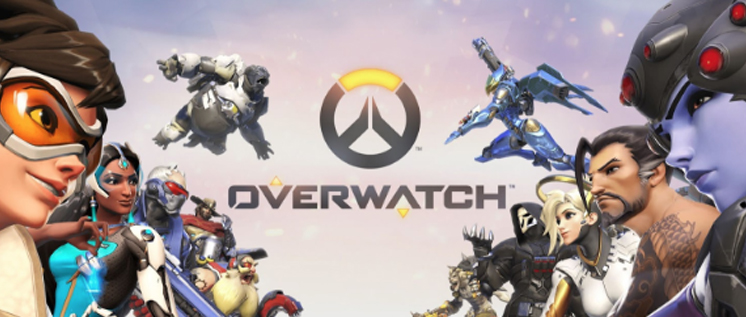
Blizzard Entertainment has added a feature to their co-op shooter, Overwatch (rated 13+ years), which promotes kindness in their player base. The system took effect in update 1.25 of the game. The idea is that after someone completes a team match, each player has the chance to award up to three "endorsements" to other players, in one of three categories: Shot Caller (leader/strategist); Good Teammate (effective communicator); and Sportsmanship (someone who behaved in a positive and respectful way). Specific players can be rewarded by a particular person only once per round, and only once every twelve hours.

Screencap of the new endorsements system in Blizzard's Overwatch v1.25.
iThrive Games has created game design resources around concepts like Empathy and Kindness, which are available on our website. In my recent conference talks at GDC, the East Coast Games Conference, the Gotland Games Conference, and a Lunch and Learn event held in Montreal last week, I explained the mental processes that humans go through in order to get from apathy to empathy, and that empathy facilitates kindness. Empathy can exist without kindness (I understand how you feel but I'm not going to actually help you), but it's harder for true kindness to happen without empathy. To be kind requires that a person 1) recognizes that someone else has a need (awareness), 2) understands how that need makes the other person feel (a key part of empathy), 3) has the ability to help in some way (capacity), 4) feels that helping is the right thing to do (morality), and 5) gives something of oneself without expecting anything in return (sacrifice).

Slide from Heidi McDonald's conference talks at ECGC, Gotland Games Conference, and Montreal Lunch and Learn, on the components of kindness.
In our studies of how kindness and empathy manifest in games, we've noticed that, with rare exception, narrative-based and RPG games tend to have baked-in features that promote kindness and empathy, whereas with co-op shooters like Overwatch, PUBG, Fortnite, or League of Legends, the kindness and empathy can be found (or, not found, in cases of toxic behavior) outside the game, in the interactions among the players. (It may be interesting in the future to examine cases where these qualities might exist both inside and outside the game, and the E3 trailer for BioWare's Anthem suggests that this might be such a case. We'll be paying attention!)
iThrive applauds the new Overwatch endorsement system because it encourages kindness. The system asks a player to think more about the experience that they've just had, in the context of their teammates' behavior. For example: Kid32 could have run ahead with everyone else, but she stayed behind to heal and cover me, when she could have gotten wiped out herself. It asks players to momentarily consider how their teammates acted in the interests of others and of the team as a unit, and then to reward others for their helpful play. Not every player will reflect deeply on the match before choosing which teammate to endorse, but those who take this (optional) step will nonetheless be spending some additional time recognizing others, a task for which they receive nothing other than someone else's appreciation and the warm feeling of doing something kind. Endorsements may encourage more positive behavior as well as help players to identify and cooperate with other kind players, increasing the odds that they'll avoid a toxic encounter.
What happens, though, when someone gets reported for bad behavior? Will that affect the person's endorsement score? Couldn't this system mean that jerks just endorse other jerks and then you can't tell jerks from the respectful players? Blizzard thought of that, because of course they did: "Those who consistently maintain a high endorsement level will receive periodic rewards, while those who display negative behavior or accrue suspensions will lose their endorsements."
This new mechanic has been criticized for "forcing players to be 'fake nice,'" and IGN reports that the player community appears to be divided in its opinions. Perhaps those folks complaining about an optional opportunity to be kind to other players are the folks who don't like being kind in the first place. And, honestly, even if players only pretend to be nice, they're practicing a kind behavior, and they're doing that instead of being jerks to each other, and that counts as an improvement in my book.
Mike Sellers, Professor of Practice at Indiana University, authored a paper about a hypothetical player behavior system and cautioned designers against using a reputation system with a single good/bad behavior axis. "Yes, this is a great step," says Sellers of the new Overwatch feature. "But there's a good way to make negative behavior self-defeating, without ever having to decide centrally what negative behavior is. You can be loved by the Capulets and hated by the Montagues, as we all know."
Despite any imperfections in the system, our organization considers it to be a good step toward encouraging positive player behavior, and applauds our friends at Blizzard for approaching this thoughtfully. When successful AAA studios recognize a need for games that encourage more positive behaviors like empathy and kindness, iThrive stands ready to support their efforts with our subject matter expertise, developer education, and design resources because the end result is that those who are playing the games — particularly teens — will reap the emotional benefits as they play video games. It's why we're here.
How Difficult Video Games Inspire Me in My Career at Microsoft
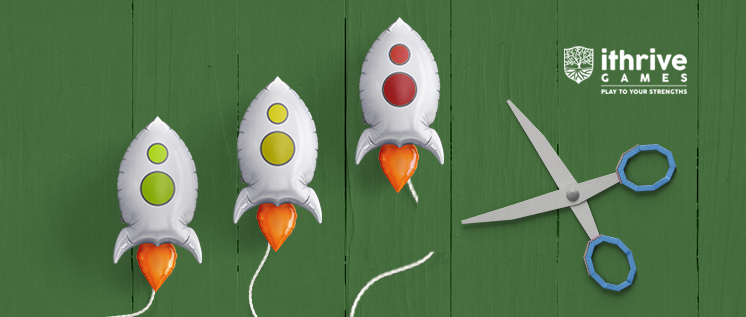
As a Software Engineer and former Technical Evangelist at Microsoft, I often have people — sometimes parents — ask me how I got my start in technology. The truth of the matter is, though I've been inspired by a lot of different sources over the years, my biggest source of inspiration to start in technology has always been video games. It was video games that made me curious to learn how to use the internet at a young age, so I could look up cheats and tips or just talk about my favorite games with friends all around the world. And it was also those early games that inspired me to learn exactly how they worked, so that I could modify them, with the dream of someday making my own.
Now that I'm an adult, I haven't stopped playing games. My game library ranges all the way from the most popular games in the world, like the team shooter Overwatch (rated 13+ years), to a long list of lesser-known indie titles. Throughout my career I've been an artist, designer, community manager, and developer. I think being willing to try a variety of games also inspires me to try a variety of challenges in the real world. I'd like to discuss some games I've found inspirational in my career, and maybe it will encourage people to seek out such games, or think of their own examples.
The game that first taught me how to "hack" was actually a very famous one - the first person shooter Doom (rated 18+ years). Though the game's content looks primitive now, it was actually pretty scary at the time, and there was some controversy about whether teenagers should play the title. I'm very glad my parents let me, though, because after I got bored with the levels in the game, I discovered that there was a level editor for the game available online. Soon I was able to create my own levels and skins, and share them around the internet. It's an act that combines design, art, and programming, and can be self-taught at a fairly young age. I heard just the other day that a local high schooler also impressed a tech company by game modding, and had a sudden nostalgia.

Facing off with a Cacodemon in Doom. Source: Author
Other modern games that people might choose to mod:
-
- The Elder Scrolls series (rated 15-18+ years)
- Minecraft (rated 8-10+ years)
- Half-Life series (rated 18+ years; I turned modding this game into a short-term job once when I was in school!)
Another type of game that's inspired me later in life is difficult action platformers. Games in the masocore genre are very hard action games, but that's part of their appeal. With difficult levels combined with unlimited lives, the games reward perseverance and courage under fire. The lesson learned from masocore is that it can be safe to fail, as long as you learn something new that helps you try again. That lesson has stuck with me when trying to learn something new gets tough, or just doesn't work out.

One of many punishing levels from Super Meat Boy. Source
The indie game Super Meat Boy (rated 13+ years) is an example of such a game. Its simple and almost crude presentation hides slick level design. Although I found the game too hard at first, I realized that the trick to the game was typically not to hesitate, but to try to perform levels as quickly as possible. The go fast, fail fast attitude that it promotes helped me to understand game development itself with its design language. Super Meat Boy teaches that it's better to keep trying, even if you fail, than hesitate and never start the level at all. And in development, a project never started is one also never completed. At the end of each successful level in Super Meat Boy, the game celebrates failure in a small way by replaying, all at once, all the mistakes the player made before finally completing the level. It's a cute, if messy way to see just how far you've come.
Other difficult games that reward fast failure and perseverance:
- Escape Goat 2 (rated E for Everyone)
- Ori and the Blind Forest (rated 9+ years)
- I Wanna Be The Guy (no age rating available)
- VVVVVV (rated 10+ years)
There is another certain type of game that I've found inspirational in the workplace, and that is the puzzle adventure game. As a sharp contrast to action games, these games don't rely much on reflexes, instead training your mind to find connections among clues in an environment. As a child, I was most fond of the King's Quest (rated 10+ years) and Myst (rated E for Everyone) series. Now that I'm an adult, these games have grown up a lot, but they are still out there in different forms.

A puzzle from Zero Escape: Virtue's Last Reward. Source
A team-building exercise within my group at Microsoft involved a "Room Escape" game - the type of live entertainment that has become popular around the world, which challenges players to solve puzzles within a locked room. I had never done a live room escape before that exercise. But I had trained my logic muscles on the video games Zero Escape, an adventure puzzle series involving the same kind of locked rooms and logic problems. Because of the Zero Escape series (rated 18+ years) — my favorite game in the series is Virtue's Last Reward (rated 17+ years), where the story is full of strange twists and interesting characters — I felt confident solving difficult puzzles. And solving these sorts of puzzles can also help train the brain to think through logical problems when writing code. Many puzzle games also test spatial reasoning useful in design, and the skill set to code-switch between these two modes of thought.
Other challenging puzzle and exploration games I've found inspirational recently:
- The Witness (rated 11+ years)
- Frog Fractions 2 (no age rating available). The game's release was unusual — here's how to find it.
- Obduction (rated 10+ years)
This just scratches the surface of games I've found inspirational throughout my career, but I hope it gives you a start to checking out some games for yourself. Whether you like to play with fast fingers, or using primarily your brain, there's always a way to use video games as part of lifelong learning.
__________
About the Author

Amanda Lange is a Software Engineer at Microsoft in the Philadelphia area. She has worked on projects with Michigan State University, West Virginia University, and Schell Games studios in Pittsburgh. She is a gamer and well-rounded developer who is also interested in health, app development, design, Mixed Reality and Virtual Reality, AI and conversational frameworks, and the Internet of Things. Her website is http://secondtruth.com. She tweets at @second_truth, Twitch streams at twitch.tv/litagemini, and blogs at http://www.tap-repeatedly.com.
"Link"ing Games and Therapy: A Triforce Intervention
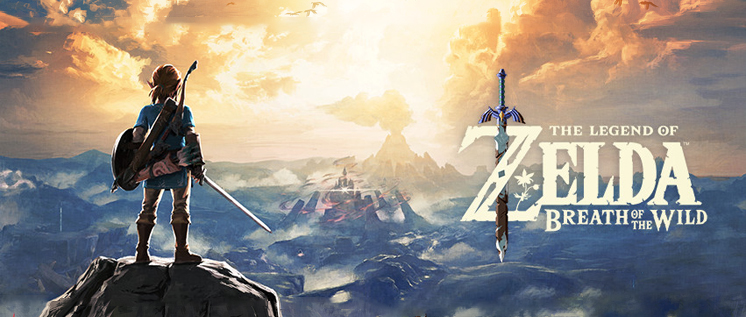
[Content Note: Description of trauma, sexual assault]
Jane (not her real name) was a 13-year-old girl referred to me after being groped multiple times by random peers in the hall at school while visiting her locker between classes. As a result of Jane's traumatic experiences, she was afraid to go to school, walk in the halls, visit her locker, or be home alone, and she was becoming increasingly dependent on her parent.
Although Jane's school staff was supportive of her, they felt there was not much they could do to protect her from future instances.
Jane came to our first several sessions wearing pajamas, often with a hat on and the brim over her eyes. She shared with me that she wore her hat to avoid potential social contact.
Like with nearly all clients I encounter, I asked Jane about what she liked to do her free time. I like to capitalize on clients' skills and interests to help them meet treatment goals. This often initiates a conversation about video games when they're of interest, and it turned out Jane loved to play Legend of Zelda: Breath of the Wild (rated 10+ years) on her Nintendo Switch. Even though she was bashful in our first session, she positively lit up when we talked about gaming. I could see her physically relax. I met the real Jane in that moment.
Link, the protagonist of the game, was a great character to apply in Jane's situation. Link is granted special abilities via the Triforce - a magical artifact that allows him to be powerful, wise, and courageous. In the Legend of Zelda games, Link battles to preserve the country of Hyrule. In Breath of the Wild, he wakes from a deep sleep to re-discover himself and his story, returning to his role as the warrior who battles with the queen of the land to preserve the balance of the Triforce.

Link and the Triforce in Zelda: Breath of the Wild. Source
In Jane's situation, it was clear that her courage and power were taken from her. Her healing journey mirrored that of Link's, re-discovering herself and her autonomy. Our main work focused on how she could embrace her inner Link, arming herself with her mental Triforce and entering school emboldened by a new persona she carried on the inside. I encouraged her to find a physical reminder of Link, whether it be a bracelet, a small token she could carry in her backpack, or a symbol to draw at times when she felt weak or anxious. I encouraged her to find her own protective measures since school left her wanting. She advocated with her teachers to visit her locker at less-frequented times until she was more comfortable and kept with friends whenever possible. We discussed her ability to play the game as homework, finding inspiration in Link's adventurousness and exploration. Link often faced challenges at night, trying to find safety in warm places where he could rest protected. We used this analogy for her to create her own safe space at home when she was alone, so she understood the barriers between herself and the frightening world outside.
In the end, Jane's transformation is one I will never forget; it was both physical and internal. One day, several sessions in, she came to see me dressed in bright, colorful clothes that were a stark contrast to the subdued, baggy pajamas she had worn before. Instead of her typical hat, she wore her hair styled - and with a brave new haircut. In the side-shave of her new 'do, she had the Triforce cut into her buzzcut. It was a statement few could miss. She smiled, showing off her new purple lipstick. She walked with purpose and her head held high as she entered my office. We celebrated her ownership of herself, her courage, and the wisdom she gained in her process. Her parent reflected how she was back to her old self: bubbly, happy, unabashed. She walked her school's halls feeling more in control of herself, able to have a say in her journey.
Legend of Zelda: Breath of the Wild game trailer.
I think much like how we approach clinical interventions in general, it is inconsiderate to the client to only use one method to help them achieve their goals. Therapists have been trained in many ways to consider mental illness and to help facilitate change - it is incredibly important to personalize what we do with clients, so we can meet them where they are and help them find their own growth. Games can be another tool in the theoretical tool box, a useful antidote against suffering that can improve lives. Proper use and intentional application of games are the key to doing this properly.
Games unlock the door to exploring new selves, connecting with stories, and practicing skills like social connection, patience, and ingenuity. The way people mentally approach games is unlike how people typically approach therapy; it is an invaluable way to allow for a curious, open headspace that builds rapport and takes down internal walls. Of course, proper psychoeducation about regulation of play time is key to helping clients lead balanced, healthy lives.
Takeaways / Pro Tips for Therapists
- Be open and curious about games, regardless of how much you know. Your clients can be your guides, and will be expressing their passion at the same time.
- If you are new to game content a client brings into therapy, do a quick online search to find a thorough explanation.
- Don't assume it's mostly your male or teen clients who enjoy gaming. In fact, adult females make up a bigger proportion of the gaming community than teen boys!
- Try to elicit clients' own ideas when setting goals: they have creative ways to integrate game content if you don't have suggestions!
- Don't assume you need a console to engage in gaming therapy. There are tons of ways to apply games without any devices in the therapy room. You could:
- Have clients draw their avatars and discuss their choices
- Discuss game narrative and clients' interpretations of the story, including how they apply it to themselves
- Assign homework for clients to play games with targeted objectives
- Have clients record their play on Twitch or by camera for in-session review, or watch videos of others playing the game online
- Nearly all games have an underlying message of overcoming adversity, always a great discussion topic
- Using Legend of Zelda: Breath of the Wild:
- Capitalize on the mobility of the Switch and have clients bring their game to the session to show you how they play!
- Discussion concepts:
- Adventure, exploration, and new experiences
- Power, courage, wisdom, and the balance between them
- Teamwork
- Self-understanding (Link wakes from a coma and has to re-discover his story)
- It takes a village: Link cannot defeat the enemy on his own. How do clients relate? What are their supports? How do they find more?
__________
About the Author

Sarah Hays is a mental health provider and passionate geek therapist — she integrates the anthologies and play of comics, video games, board games, and movies into her therapeutic interventions. She works in private practice in the Seattle area, recently graduating from the University of St. Thomas' Counseling Psychology doctoral program. She also directs psychological operations for Recovree, a MN-based startup creating a telehealth app to help peer recovery specialists connect with their clients about maintaining sobriety. Sarah specializes in LGBTQ+ care, dual diagnosis, geek therapy, and technology and its advancement of the psychological field. Learn more about Sarah at https://sarahhayspsyd.com/.
Sea of Thieves: Anchored in Positive Design

Sea of Thieves (SoT; rated 13+ years), a pirate-themed, open-world game, launched in March of 2018 with over 1,000,000 players ready to set sail on day one. What initially sparked my interest in SoT was an article in US Gamer about how Rare, the development studio, had specifically designed the game to preemptively combat the toxic and trolling behaviors commonly seen in games that feature player versus player (pvp) combat.
It was refreshing to see a developer be proactive rather than reactive to well-known problems. They chose the strategy of encouraging good behavior rather than solely punishing unwanted behavior. For example, each ship has a brig where the crew can detain disruptive teammates by voting. Managing problematic players in other titles usually entails "kicking" or "booting" the player from the game. This is both ineffective at dissuading future negative behavior — as getting removed from the game is frequently the goal of the griefer — but also tends to put the team who just lost a player at a disadvantage.
According to Rare's Design Director, Mike Chapman, the brig system empowers players and disempowers trolls as the only way disruptive players can leave the brig is by having teammates vote to release them or by quitting the game. In other words, Chapman suggests the brig provides an "interesting psychological shift" wherein the focus is on encouraging players to play the "right way" rather than using punishment tactics.
Of course, it's not all fair seas and jaunty jigs. Players can get pretty salty and trolling and griefing do happen — including on sloops, where only two players are allowed at a time, so there's no way to get a majority vote to lock a disruptive player in the brig:

Another avenue of griefing even takes advantage of the brig detainment system. One strategy is to get thrown into the brig and then go AFK (Away From Keyboard). While the troll's character is detained, the player can go off and make a sandwich IRL while their teammates complete quests and earn coin, spoils that the troll still gets even though they did not help earn the rewards.
There have also been issues reported of teams of three setting sail on a four-person galleon in order to be matched with a random fourth player whom they instantly vote to put into the brig. The system has its loopholes, but Rare is actively collecting information about player interactions via in-game telemetry and through the "community hot topics" section of the SoT online forum to inform iteration and improvement efforts.
Even though this positive design isn't perfect at curtailing disruptive behaviors, players' many positive social experiences in the game speak volumes about the culture that's built up around it. Arguably, the game's biggest value lies in its potential for joyful social interactions.
SoT is really meant to be played in multiplayer mode. There's a general consensus online that single-player mode is frustrating, and I certainly found that to be true during my first attempt at playing SoT solo. The learning curve is fairly steep and there isn't a great deal of in-game support to get started. As I was fumbling around trying to figure out how to set my quest, a random player jumped aboard my ship and shot me. R.I.P. me.
The second time, though, I joined a group of friends and really got a taste of the SoT experience. Cooperating with experienced players significantly lessened the learning curve and allowed me to really enjoy just being in the game. Before setting sail, we drank a tankard of grog and watched the world go blurry and our crewmates start swaying. We all pulled out our concertinas and hurdy-gurdies for a quick disembarking shanty. Then we plotted our course, raised anchor, lowered and trimmed the sails, and steered in a northwesterly direction. (Pro tip: turn off your lanterns so you're harder to spot!)

In SoT, players sail together and complete quests to win gold and fame. Image source
When it was time to call it a night, I didn't want to stop. I had pirate-related dreams and was excited to play the next day. Ever the psychologist, I wondered what it was about this game that excited me. What I landed on was that the game felt immensely satisfying. My friend Joe was at the helm while Brian manned the back sails and Allison tended the front sails. I sat in the crow's nest with my spyglass watching for enemy ships. We solved rhyming clues to find the location of a buried treasure, fought skeleton pirates, evaded hostile ships, repaired damage to the hull, and traded treasure chests for coin. It was like an epic adventure with my friends, a digital road trip in a boat.
The components of SoT align with what iThrive Games has found to be meaningful game design — opportunities to: explore a system, exercise agency and autonomy, face incremental challenges, find support even in failure, and connect with other people in a meaningful way.
System exploration: Sailing your sloop or galleon requires an understanding of how the parts of the ship interact, and experimenting with those components changes how the system functions. For example, adjusting the main sail ever so slightly is the difference between cutting through chop at a quick clip or merely chugging along across the waves.
Agency and autonomy: Being an open world, there is ample opportunity for player choice and self-expression. As the player, you choose what you want to do, where you want to go, and how you want to get there, and almost every choice you make feels meaningful and of consequence.
Incremental challenge and good feedback: The game scaffolds quest challenges from easy to more difficult and provides tons of feedback in terms of your status as a player and a pirate.
Support even in failure: Failure in this game happens a lot, and although there is some disappointment at losing a treasure chest or special item, the game doesn't punish you. One of the first times I played, I (accidentally) sunk four different ships. It was frustrating to lose my cargo, but another ship was always provided and I was never left stranded. Even if your character dies, the penalty is not particularly punitive. You spend a few seconds on the Ferry of the Damned and then can rejoin your crew. Also, the world is absolutely gorgeous.

The beautiful world of SoT. Image source
Meaningful social interactions: One of the coolest things about this game is its strong pull towards social and cooperative play. Yes, you can voyage alone, but it's both easier and more fun to sail with a crew. And because it's an open world, social interactions are not limited to those in your party.
"Bringing players together in a multiplayer game, creating new bonds, making new friends, that's this game in a nutshell, that's what we want to do." - Joe Neate, Executive Producer
Here's an anecdote from an SoT player (shared with me by @Lvl25Magikarp via DM on Twitter) about his encounter with some friendly strangers:
[My friends] and I were going to an outpost to sell our loot. Instead of pulling anchor, we slammed straight into dock where another ship was unloading. Both teams were screaming into our mics that we were all friendly. Sold our stuff then joined them on their ship for a while! We sank a few ships together and ended up facing a skull fortress. We agreed to split the loot 50/50. We expected them to be true pirates and steal our half but we all kept true to our promise and sold the loot without issues. We had hours of random shenanigans and laughs with people we had never met before. It felt like we had known each other for years. After the initial suspicion went away, we all got along extremely well and the crews integrated pretty flawlessly.
And another example:
As a solo sloop, I wasn't looking to pvp or get caught in any prolonged combat, so when a galleon pulled up close to me, I did the only logical thing. I waved. Next thing I knew I was surrounded by three well dressed sailors, playing instruments and dancing. So i did the logical thing. I started playing along with them All of a sudden, a well dressed captain walks up to me, blue gold garb, with a very large hat. He turns on push to talk and asks, "Hello there ltroyal! Have you heard the word?" "what word" I respond?
"Why?! The word of ARRRRR. KELLEY!"
And with the end of that proclamation, the group of 4 burst out dancing while the captain blasted Ignition - Remix into push to talk.
After dancing for a couple minutes, a little singing, and some grog. The song was over, and the captain told his crew to go back to the ship. "Arrrrrrr I think I'll stay with you ltroyal." "You sure you don't want to go back to your ship?" I responded, kind of confused. After the galleon with the 3 crew sailed away, it was me and that captain.
Of course he started playing the titanic theme, ran to the front of the boat, "hold me ltroyal."
About 15 minutes later, we ran into another sloop, which opened fire on us. But without missing a beat, the captain starting blasting the Pirates of the Caribbean theme song. After hard combat, a unlucky cannon ball blew the captain off the boat, where he boarded the other boat, and was slain so that I could get away. As he I was sailing away, I could hear him yell "GO ON LTROYAL, I'VE GOT THEM NOW!"
I will never forget you captain, preacher of the word of ARRRR. Kelley, and truly unique, kind player. You proved that this game can be an amazing sandbox for those who put their minds to creating unique, fun encounters. And I bought SOT instantly after logging off for the day.
These kinds of social interactions foster a sense of togetherness, connection, and community which, even in brief encounters, can have positive effects including increased happiness, confidence in our ability to connect with others, and feelings of social engagement, and decreased feelings of loneliness and isolation.
Sharing spaces with friendly, kind strangers has been shown to increase optimism and self-esteem, make us feel safer, and help people generally enjoy their lives more.

Player leaves a treasure chest for a random player to find and trade in for coin. Image source
SoT's focus on deep and consistent social interaction requires of players the kinds of robust social and emotional skills we hope teens will develop: communication, collaboration, and cooperation. Other skills such as planning, organization, good decision making, and foresight are crucial to navigating the seas. The game creates the opportunity space for players to form, disband, and reform communities and foster a sense of camaraderie and connection. Flaws aside, that's gaming at its best.
How Games Change the World by Modeling the Truth

"How can a game change young people's minds in a positive way?"
There's a hopeful idea underneath this question. It's hidden beneath the words, and it's one any parent would recognize: "I believe that my message to my children will be heard."
Certainly, parents' messages to their children are often heard. Still, anyone who has raised a child understands that we don't necessarily get to reprogram our children at will. They take some of what we say, and leave much of the rest behind.
I believe that game designers face a similar dilemma. Can games change people's minds? At all?
It might seem like an odd question at first. Of course they can! Can't they?
Let me be more specific. Can games deliver a particular message to a player? Especially a young player? Can game designers alter the way people see the world, similar to the way a parent, a book, or a movie can?
I have a controversial opinion on this matter. I believe that games do not change people's minds in the same way as linear narrative forms of entertainment. Linear narrative asks us to accompany a character (who we come to empathize with) on a journey, and the fact that we do not have any control over that journey allows (or forces) us to go places we were not expecting to go. If this journey reveals human truths to us, then that revelation changes us.
Games are not like that. Not even close. I believe that the true power of games is to reveal systemic truths.
Systemic Truths
It may be strange to think of systems as having any truth value at all. What do systems reveal about the truth? Does the public transportation system of a city have some kind of higher truth embedded in it?
There are many truths embedded inside a public transportation system:
- Crossing a city takes time. How much is not just a factor of distance, but of how the design of the streets and the vehicles and many other things interrelate.
- The more connections one must make in a connected system like this, the less efficient any particular journey will be...
- ...but, without points in a transportation system where people can make choices to go different directions, the system loses a huge amount of its value.
- The overall efficiency of a system is related to its complexity and its flexibility.
And so on. These are technical truths. Are there deeper truths we can find?
- The users of a public transportation system will tend to be a less affluent, more vulnerable population. These kinds of systems support certain groups more so than others.
- Without public solutions to transportation problems, humans will tend to destroy their own cities. Or, at the very least, growth will be capped.
Or, how about:
- Cities require public systems (like transportation) to thrive...but also to lessen the harm that cities do, both to the environment and to the people who live within its bounds.
Those are some examples of what I mean by systemic truths.
I would argue that a game that dealt with public transportation systems should embrace some or all of these truths. If it did not, it would not come across as "true" to the player.
No other art form besides games can so clearly speak to truths like these...but if we are going to use games to help prepare people (especially teens!) for the real world, we have to understand what games can and cannot do for their audience. Let's talk about how this works, and what it means to this burgeoning art form.
Agency
One of the greatest challenges that game designers face every day is how to build their game in such a way as to allow the player the right kinds of liberty.
Players do not generally want to be led by the nose. Players who are forced to take a series of scripted actions to play out linear events will balk, and rightfully so. We balk at the same thing when we experience it in real life, so why would the virtual world be any different?
It's better when games provide a playground; a set of interlocking systems that — as the player interacts with them — produce emotions and sensations in the player that fulfill the fantasy that was on the box.
Action games have combat systems, movement systems, and spaces to move and fight through, and the accumulation of all these interactions fills the player with excitement, tension, dread, and glory. RPGs and more narrative-driven games have conversation systems and character customization systems and vast areas to explore that evoke a sense of curiosity, wonder, intrigue, and suspense.
But...where is the room for the 'message' in all of this? Where is the human truth that we are attempting to reveal?
When I start up a game of Skyrim, I want to pursue my own curiosity. If the game interferes and insists that I engage with a character or a mission that has a particular moral message, I might resent the game for getting in the way of my agency. I mean, if the game designer just wanted to tell me a linear story, why did they make a game?
The best games do not do this, generally.
Freedom vs. Control
Even if we do design a game that has poignant, meaningful sequences within it, what will the player's mindset be during those sequences?
Interactivity — the great power that games have, and that other mediums do not — requires that we offer the player agency in these sequences. And that agency means that the player's own motives (curiosity, or stimulation, or mastery, or relaxation) are going to be paramount in those moments and not the message we are trying to convey.
Again and again, designers learn that if we design our games to put too many limits on agency, players walk away. But without offering a very narrow experience, we lose the ability to draw any kind of conclusion about what the player will walk away thinking or feeling.
The more freedom we offer players, the less control we have over how they will feel and think after they have played our game. It is almost a truism (more freedom = less control), but it is often overlooked in game design.
But this can't be the whole story. Games do change peoples minds.
So, how can we do that? What are the limits?
Messages
When we think about how entertainment can make the world a better place, we often refer to landmark books or films that made a huge impact on society. Roots, or Thelma And Louise, or more recently, Get Out. Orwell's 1984. Sun Tzu's The Art of War. The Diary of Anne Frank. Works that opened the eyes of a large population to parts of the world they would never have seen for themselves.
The methods employed here are simple: the creative team generates characters that the audience can identify with and then puts those characters into situations that will reveal the world as it actually is.
But key to this method is the notion that those characters act on their own agency. The audience has no input in what those characters will do, and so the viewer/reader is forced (with consent, of course) to ride alongside these characters as whatever happens to them reveals itself.
Empathy is the primary key to narrative's ability to change human minds.
Drama vs. Curiosity
What I have just described is my definition of drama. Drama is the emotional experience of the tension that is created by watching a character who I have come to care about move into a moment of danger (or, at least, uncertainty) when I have no control over what that character will do. That empathy-induced anxiety is actually pleasurable for many people, and it opens the mind.
I believe that drama (as I have defined it here) is required to change minds with this technique.
In games, however, the exchange is different. I, the player, am that character. I get to decide (within bounds) what the character does. I expect to have some choice and liberty in how I play this game.
When I am exposed to a narrative choice in a situation where I have this kind of agency, my experience is very different.
Consider: Should I have my character save my daughter or the doctor, who will be able to save so many other lives in the future?
As a player, that moment has a certain amount of tension in it, to be sure. But, often, instead of drama, players in these situations experience a kind of tense curiosity. "What will the consequences be?" the player thinks. The mind engages a kind of value equation, searching for some reason to make one or the other choice. That experience can be illuminating...but if I choose the doctor, what have I learned about the world?
Not much, most likely. I've maybe learned something about myself (something games are amazing for), but I probably have not have learned much about life itself.
This pattern repeats itself across games that make an effort to illustrate the world. We game designers often set up narrative situations of great import and meaning...and then, without intending to, drain them of their dramatic power by putting the player in a position to (intellectually) weigh the outcome.
Interactivity and Systemic Truth
So are we doomed? Are games unable to change minds at all?
Quite the contrary. The answer to this dilemma rests in the greatest strength of games: their interactivity.
For something to be interactive, there must be some kind of system that the player can interact with. The simplest systems are built on action: if I push this button here, something predictable happens over there. More sophisticated systems are build on automation, or on top of other systems: this train runs in a loop, and if I stand on this platform here, I can step onto the train when it shows up, and be whisked away to the other side of the city.
On the surface, there does not appear to be a great deal of opportunity for message here.
The question game designers keen to change minds might want to ask themselves is this one: which systems should they be modeling?
Truth
Anyone who has played action games quickly begins to understand the way that space (the placement of walls, the shape of the floor, entrances and exits, etc.) affect their odds of success. Outnumbered? Find a doorway.
These learnings — the models that players are building in their heads, if you will — turn out (in many cases) to be true in the real world as well. Doorways are actually a great way to defend yourself against a larger force.
In the same way, games that simulate, for example, economic disparity (such as Sim City), or how living conditions affect human beings (such as RimWorld and other survival simulations) in a way that mirrors enough of the real world as to be at least somewhat true present the player with the opportunity to interact with those systems, experiment, and learn. And then, when they go out into the real world, those players will be carrying those true models with them. They will have been changed.
Games are Practice
Games, unlike any other medium, invite repetition. If the systems being modeled are interesting, and if the play is stimulating, players will want to come back. Humans love learning.
"Practice" sounds a lot like homework. Still, players often love to practice. Good games make practicing a joy, often by hiding the effort of learning underneath great content.
Games struggle with revealing large, human truths. But games invite players to engage with systemic truths — such as the way architecture guides people through spaces, how systems of conflict interact with each other, or how playing your position as a part of a team can produce amazing results — constantly and repeatedly until they know them in a deep way.
Games are practice for life. And while this art form does struggle with moving people towards grand revelations, there is no better medium for offering an opportunity to practice what they have learned.
Build the Truth
My belief is that games do not change people by showing them movies, or forcing them through narrative funnels. Games change people by putting them in the midst of systems that in some relevant way mirror the systems they are experiencing in their actual lives.
We can teach players how the world actually works. This is something that movies and books have a more difficult time doing; they can tell their audiences how the world works, but that is not the same thing as teaching.
What we give up for this extraordinary power is at least some of our control over what message our players will take away from the systems we model for them. We cannot know in advance what those players will want to do with our games; nor should we. It is the player's liberty that makes learning so much more powerful in games than it can be in other mediums. Students who want to learn accumulate knowledge so much faster than those who don't.
As we know, teens are in a part of their lives where they are absorbing information about how the world works at an extraordinary rate. If we want to make a large, positive change in our world, I believe the best route is to focus on providing teens with better models for the world.
Models that prepare them for and ask them to develop their empathy. Models that show them the complexity of the world without overwhelming them. Models that ask them to develop as leaders, as collaborators, and as guardians. Models that demonstrate the positive consequences of taking responsibility and giving back to the world you live in.
Some designers are already doing this. One example is Eco from Strange Loop Games, which proposes a world you must save from a looming meteor strike without upsetting its ecological balance (at least, not too much.)
So: "How can a game change people's minds in a positive way?" The primary question is: what systems has the game design team modeled, and what models are their players walking away with? Those models can change the world.
If you are a game designer, ask yourself:
1) What practices do you want to see flourish in the world?
What routines, what habits, what behaviors would you want to pass on to your children? I'm not talking about moralizing here; what actual behaviors would you like to pass on to the next generation?
For me, there are many: a dedication to quality, a daily striving for self-knowledge and honesty, working towards more efficient outcomes, altruism, valuing and acknowledging our differences and our similarities...there are many more, but you get the idea.
2) What are the systems that these practices that you want to pass on exist within?
Self-knowledge, for example, exists in a system where:
- Humans are all different from each other in ways that are difficult to predict, but are entirely codifiable
- Humans must discover themselves through several means — question/answer, being put in choice-rich environments, being put under pressure, etc.
- The variation in humans is a large part of what will determine where they end up fitting into the world
3) How can you model those systems in a way that will reveal systemic truth?
As an example: it is one thing to offer the player several positions to play on the field of battle (warrior / mage / rogue / healer), but it is something else entirely to offer them a roleplaying system that relates to actual personality types.
Imagine a system that would allow young people to explore their actual selves, and in a way that is not confined by the need to win your particular game, but rather embraces their real individuality. There are such systems everywhere — Buzzfeed gives us hundreds of personality tests per week, it seems, and character customization systems often do an amazing job at this. For teens, could we somehow harness that drive better?
Trust your Players
These examples can of course be extrapolated to other types of games. The point is this: If you want to change your players' minds, first, decide what practices you want your players to voluntarily adopt. Then build a world that contains the true, systemic realities that those practices would fix.
Players would then be able to engage with those systems. They could follow their own curiosity, their own values, and experience for themselves the consequences of those truths.
They would then carry that learning with them out into the real world. For the rest of their life, they would know the truth that you showed them.
I like to think that this is how positive change begins: by young people learning the truth of the world.
Build the truth. Trust your players to find it. Help them to engage with it, in a place where they can safely practice.
The rest, as any parent knows, will be up to them.
__________
Postscript
I need to add a caveat to my position.
After writing this article, I had a remarkable encounter with a designer who insisted that I was wrong about some of the assertions I make here. He explained that — for him — video game characters have always been emotionally real people. He explained that although he of course understands that these digital characters are fictional, his emotional reaction to them is nonetheless indistinguishable from his reaction to real people. I asked him, "How do you feel about pushing around a third-person character, then?" and he explained that he tells himself that he is helping the character, as though making suggestions with his input.
Because of this experience, he claims that playing third-person video games with fully realized characters is one of the most intense narrative experiences of his life. He finds this article's claim that game narratives do not change us in the same way that other narrative styles do to be completely false in his case.
Unsure, I took the question to the internet. I asked my Facebook network if there was anyone else who could relate to this "game characters are as real as real-life characters" experience. Much to my surprise, I got fifteen more responses — passionate ones — from people who absolutely agreed and were willing to go into great detail about what this means to them. (I have little idea what this number represents as a percentage of the population; my intuition says "less than 10%" but that is in some ways a total guess.)
I still believe the position I take in this article to be true. Still, I need to add the following caveat to the whole thing: "...for a majority of people." It appears that there are people who experience systemic narrative as powerfully as they do traditional narrative.
For the record, this is something I am delighted and excited to have stumbled across, and I look forward to digging into its implications in the near-term.
__________
About the Author

An Interview with Kinful: Bringing Cross-Cultural Empathy to Schools with VR

How do we prepare today's students to thrive in an uncertain world? One proven technique is for schools to wholeheartedly support students' social and emotional development — their empathy, their ability to bounce back after failure, and their capacity to connect meaningfully and sensitively with diverse people across the world. Schools are demanding effective social and emotional learning (SEL) approaches now more than ever, and Michael Auerbach and Sam Williamson, co-founders of Kinful, are two of the visionaries rising to meet the need.
The Kinful curriculum is designed to build five key social and emotional skills in students from elementary through high school. Among SEL programs, one really unique thing about Kinful is that it leverages the power of virtual reality (VR) to empower students to connect in meaningful and empathy-building ways across geographical boundaries.
Students in Kinful classrooms — so far in New Jersey, New York, Texas, Washington, South Africa, Turkey, and soon the Ukraine — create 360-degree videos to share their daily activities, interests, thoughts, and feelings with peers across the country and the world. iThrive caught up with the Kinful team to find out more about their inspiration, their successes and obstacles, and their hopes for the future of the program.

Students using Kinful's VR headsets react to 360-degree videos created by students from another country. Image source
iThrive: You have shared that Kinful's mission was inspired by your Peace Corps service. From there, how did you decide to use VR in schools to support cross-cultural empathy?
Kinful: Peace Corps exemplifies a powerful aspect of humanity: the innate ability of humans to empathetically connect with one another despite vastly different cultural backgrounds. Peace Corps volunteers and host-country nationals instinctively laughing together, crying together, and caring for one another highlights how empathy can transcend cultural boundaries. The idea that empathy is the thread that binds humanity together is a central inspiration for Kinful.
We knew we needed active engagement, as opposed to passive engagement like watching a documentary, in order to recreate the Peace Corps experience in the classroom. The immersive aspect of VR provides the exact type of active engagement needed!
iThrive: What are the key components of the Kinful curriculum?
Kinful: A typical Kinful lesson consists of non-sequential workstations where students rotate between activities. Half of the workstations are VR-related (viewing and filming), and half are "standard" SEL activities (e.g., teamwork games, group reflections, etc.).The VR and the 360 filming activities within that rotation are fundamental to Kinful's vision and impact, but they make up only a portion of the greater Kinful whole. The tech and non-tech activities support and extend each other. As students move from one workstation to the next, they experience and reflect on SEL themes individually, in groups, and through someone else's eyes (VR).
The Kinful kit comes with a range of engaging materials — including VR headsets — teachers can use to support students in building 5 key social and emotional skills. Image source
iThrive: What is it like when a student first connects with a peer from another place and way of life? What emotions do you see being shared, and what kinds of stories?
Kinful: It's all smiles when a student puts on a headset — but to be honest it's hard to tell if the smile is coming from the inherent delight in identifying with someone else in a different country, or if it's coming from the awe of using VR presumably for the first time. It's probably a little bit both, which is fine with us!
iThrive: What about after the connection — what do you see or hear from students? How do they talk about the experience?
Kinful: In an effort to get students to relate to one another, we always prompt students to share videos of universal experiences like spending time with family/friends or taking care of responsibilities. Of course, these things will look different across cultures, but the general concept is always recognizable and relatable.
From there, students usually come out of a Kinful video saying something like, "I eat lunch with my friends too!" or "I also have to do house chores after school!" These simple and universally translatable experiences help bridge cultures — moving us away from a more removed, academic understanding (fun facts of a foreign country) and getting us closer to a more personable familiarity ("Mohammed from Senegal loves walking his dog in the morning. So do I!").
iThrive: What has surprised you most about what students want to share with each other through the videos they create?
Kinful: What they want to share hasn't been particularly surprising (again, our prompts revolve around everyday stuff), but how they've been sharing has been surprising. By that, I mean their eagerness! I anticipated awkward hesitation in our students' first videos (probably because I could easily imagine my twelve-year-old self awkwardly talking about my Warren G CD or Green Day blacklight poster). But no — teachers tell us their students love filming themselves!
A student uses a head-mounted camera to create 360-degree video for Kinful peers around the world. Image source
iThrive: What's your biggest (or favorite) success story to date?
Kinful: Our biggest success story to date has been our adoption of "standalone" VR headsets, which are headsets with an operating system and screen built in. Prior to this adoption, we used a smartphone + headset setup to view VR videos through a Kinful app, which involved two central hurdles: 1) procuring a smartphone and 2) Wi-Fi connection to stream videos.
Standalone headsets solve these two hurdles because: 1) the price of a standalone headset is a fraction of the cost of a smartphone and 2) standalone headsets allow us to upload our entire VR library onto the device, bypassing the need for Wi-Fi to stream (smartphones typically don't have the capacity to store our library).
iThrive: What are some of the obstacles to extending the reach of a program like Kinful into poor and rural areas across the globe? What are some solutions you are using or planning to use?
Kinful: The biggest obstacle was internet access needed to view our VR videos. Our recent adoption of standalone headsets with our VR library preloaded has solved this problem. Now, we're able to send a Kinful kit to a partner site with everything needed to execute Kinful programming (VR hardware, activity supplies, etc.).

A student donning the Kinful VR headset. Image source
iThrive: What advice would you give a developer who wants to design tech- or game-based experiences that promote or support empathy?
Kinful: Our mission is to encourage students come to their own conclusion that what binds humanity together is greater than what divides us. We want students to watch these videos and notice the similarities they have with students from all over the world. Once those connections start being made, empathy naturally follows. That's why we've stocked the Kinful video library with universal, relatable experiences.
In that vein, we've thus far shied away from creating traumatic reenactments to promote empathy, like first-person angles of bullying for example. That's not to suggest we believe such a video would be ineffective — it's just that we've found students to be more open and vulnerable when engaging with less threatening material.
iThrive: It's no secret that it can be really challenging to get both SEL and tech-based programs adopted and implemented widely in schools. What obstacles have you faced and how do you get around them?
Kinful: The biggest challenge has been schools figuring out how to pay [for Kinful]. Most schools we've talked to don't have an SEL budget, but they do have a tech budget. Problem is, Kinful doesn't neatly fit into a tech category since we're not targeting tech outcomes. With our main focus being SEL, we've had the most success engaging with schools that already have SEL initiatives taking place.
iThrive: What advice would you give to a teacher who is uncomfortable using technology in the classroom? What about teachers who struggle with teaching SEL?
Kinful: The first bit of advice for a teacher uncomfortable with using technology or integrating SEL would be that there's no need to reinvent the wheel! There are a lot of high-quality resources out there that present best practices, materials, and tutorials for both.
We definitely wanted to try and get out in front of any potential unfamiliarity with tech or SEL by creating a curriculum that is largely student led. Teachers who are uncomfortable with tech and SEL have in Kinful a simple yet high-quality way to get started without the pressure of creating their own programming. With all materials and directions supplied, the teacher just stages the room and follows the steps to facilitate the lesson. We designed Kinful to be as useful to a savvy veteran teacher as it would an inexperienced summer camp counselor.
iThrive: What's your vision for what's happening at Kinful in 5 years?
Kinful: Kinful is ultimately building towards creating a global community of schools, an international network of students and educators discovering connections and growing together towards a more empathetic future.
However, as we've designed Kinful to be molded by students (prompts are open-ended, and we encourage students to film and share what matters most to them), we imagine that as the years pass they will change and shape the program, bringing us to a place we had never even imagined!
__________
To learn more about the Kinful curriculum, visit www.kinful.org and check out the team's orientation video for partner schools:
Nier: Automata – True Kindness in Games Requires Sacrifice
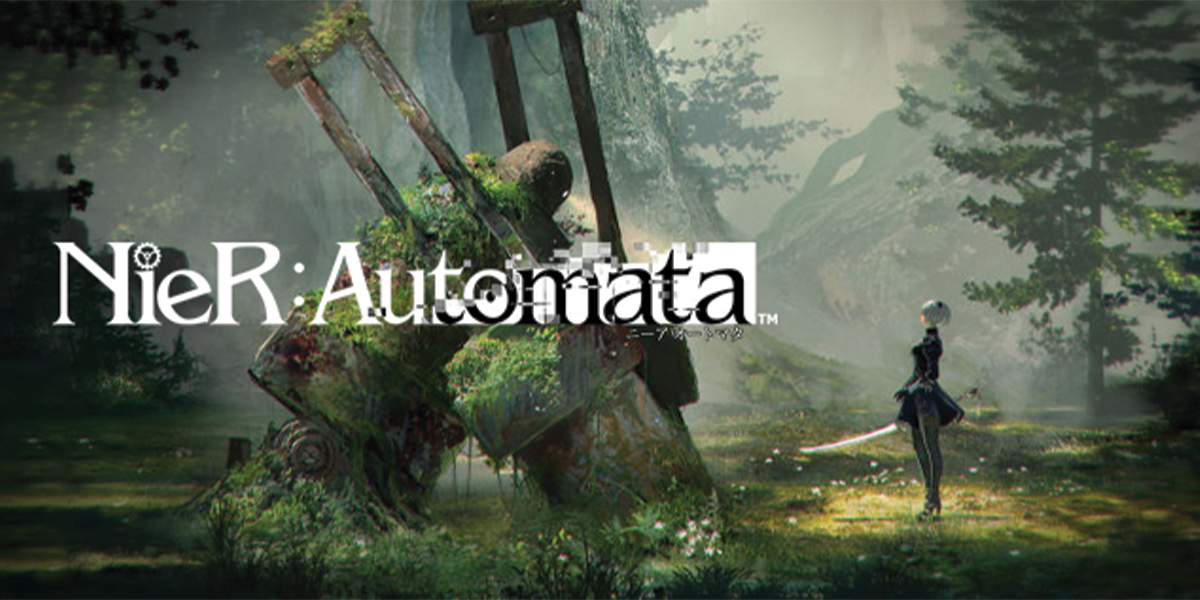
We created iThrive Game Design Kits for game designers and developers looking to create games that support social-emotional learning in teens. Check them out here!
Editor's note: This guest-authored post was inspired by a panel discussion called "Find the Kind" at MagFest in January of 2018. The panel was led by Heidi McDonald and Sean Weiland of iThrive Games, James Portnow of Extra Credits, and Dr. Shaun Cashman of Pfeiffer University. Please note that THIS POST CONTAINS SPOILERS for the game Nier: Automata.
__________
Being kind is easy in the abstract. When asked if we would save a child, rescue a kitten, or help a starving village most of us would say yes. But saying so is easy, the doing is so much harder.
Truly acting kind often requires something of you. Whether it's not having as much to spend on yourself because you chose to give to someone else or having an hour less in your day because you decided to listen to a friend in need, kindness often comes with a sacrifice and this is what so few games capture.
But there is at least one game that does: Nier: Automata (rated 18+ years).

The visually stunning world of Nier: Automata. Image source
Before we talk Nier though we have to talk about why most games fail on this front: it's because most games are about you, the player. This means that most acts of kindness within games are about you as well. When you're asked to save a village or help a child, you're going to get a reward, you're going to be called a hero, it's going to show off your prowess...and, perhaps most of all, the actual saving of that village or rescuing of that child is going to be fun. It's something you're going to want to do.
But real acts of kindness aren't about you. They sort of can't be by definition. Real acts of kindness have to be about the people who you are being kind to. They can't be self-centered or self-motivated, they can't be for the praise they'll bring or the reward they'll grant. They have to be acts of empathy, of pathos; acts of caring for other beings in the world. This is why most games struggle to deliver on acts of kindness that truly feel like being kind.
What's more, most games are about empowerment. They're about making you feel good, about making you feel strong. In many ways this is excellent, but sometimes we as game designers are too afraid to do anything which might make you feel as though you have a limit or as though something is being taken away from you. This means that almost no game asks for real sacrifice when it asks you if you wish to be kind.
Sure, some games may ask you to give up a few thousand gold to help a war-torn town, but by that point you usually have enough wealth to make this trivial, to make it not feel like a sacrifice at all. Other games may ask you to do a hard fight or beat a level in a more challenging way in order to do something kind, but that's just giving you more of what you love. That's us as designers finding a way to tell you that you made a tough choice to do the right thing when really we're actually just offering you something fun, exciting, or different to do for making the "kind" choice.
There are a handful of games that have moments that ask something more of players, from Papers, Please to This War of Mine. But there's one game that stands out for requiring true empathy and kindness, for requiring real sacrifice from players themselves. There's one game that made me put down the controller and sit for 30 minutes asking myself, "Am I really willing to make that type of sacrifice to do the right thing for people I'll never know?" This is, of course, Nier: Automata.
[NOTE: SPOILERS AHEAD!]
At the end of Nier: Automata you face an incredibly difficult boss battle, one that's nearly impossible. Each time you die you are met with a few words of encouragement from other players, so you reload and try again. After a few deaths you're presented with a new option: other players have offered to rescue you. Will you take their help? You load again to try a last time and, one by one, ships flock in, each with its own name, with its own real person associated with it, and the music swells from a single melody line to a chorus. Now you're not alone. Now you can win. As you fight and as they die — these people who have come to help you — you're told their data is lost. But at last, you win. Because of them, you can see the real end of the game.
The final cutscene rolls. You get to see the ending you've played so long to see. Then you're presented with one last choice. You can help someone out there. You can be one of those little ships sent to rescue a player who is stuck. But there's a cost. You must give up your save data. It will be deleted forever. The dozens of hours you put into this game, gone. Your chance to finish those quests you left undone, gone. The possibility of playing the finale again and watching the ending one more time, gone.
A player sacrifices save data to help another unknown player of Nier: Automata.
For players this is a real, meaningful sacrifice, something that giving up a handful of gold can never be. You have to let go, you have to give up all those characters you love. But when you remember the ships that came to save you — the other people who made this choice never knowing who you were, those people who came to help you anyway — if you're anything like me, you push that button.
You push it not out of gratitude or even out of respect, you push it because you know that there will be someone else out there like you, someone sitting in front of a screen excited to be close to reaching the end. Someone who will never get to see that ending without help. You understand what it is to be that person, so you push that button and watch as, line by line, item by item, the game deletes all the things you've done.
It's a moment of empathy for someone you've never met and will never meet. An act which will garner you no praise, for which you will be rewarded directly in no way by someone else. It's an act of pure kindness towards a stranger. It's a game reminding us: in the end, we're all in this together.
Hellblade: Senua's Sacrifice – Why the World Needs a Hero with a Mental Illness

Editor's note: This guest-authored post is part of iThrive's series on games and mental health. Articles in this series reflect iThrive's commitment to use and design games in support of teens' mental health and well-being, both within and outside of traditional therapeutic contexts.
Talking about mental illness can be difficult, confusing, and sometimes even scary. Many people first learn about mental illness from what they have seen on screen and from stories they have heard. However, relying on media portrayals of mental illness can leave people unprepared to empathize with someone coping with one since such portrayals are often exaggerated and promote harmful stereotypes. Independent video game developer Ninja Theory aims to change that with their latest and most courageous title, Hellblade: Senua's Sacrifice (rated 18+ years), whose heroic protagonist is no stranger to mental illness.
Senua's Quest
Hellblade: Senua's Sacrifice is the story of a young woman named Senua on her quest to save her slain lover. As she journeys through Helheim, the land of the dead from Norse mythology, Senua battles monsters, gods, and her own inner demons. If this game had been developed with only this premise it would have been intriguing enough, the gameplay would have been smooth enough, and the graphics beautiful enough to make it as entertaining as many other AAA games. However, developer Ninja Theory wanted to try something new.
In a behind-the-scenes interview, Tameem Antoniades, the Chief Creative Ninja of Ninja Theory, confirmed Senua suffers from "anxiety, depression, hallucinations, and delusions." To best capture what it is like for people who cope with these conditions, the developers worked with Professor Paul Fletcher, a psychiatrist and professor of health neuroscience at the University of Cambridge. The developers also worked extensively with people who had experienced psychosis and integrated their perspectives into the game. With guidance from both professionals and people with lived experience, Ninja Theory was able to create a detailed, immersive, and scientifically informed adaptation of mental illness for video game players to experience.

Senua begins her quest. Image source
In Hellblade, players experience a small measure of what it might be like to cope with severe symptoms of mental illness. For example, as soon as players start the game, they hear a series of voices telling them to turn back, questioning their every decision, and whispering worries of impending doom. These unsolicited voices warn, deride, guide, and encourage Senua throughout her quest. The audio was specifically designed so players would feel like the voices were whispering in their ears or circling around them, making it feel like the voices were in the player's own mind.
Several other aspects of the game were modeled off symptoms of severe mental illness. For example, the game requires the player to solve a series of puzzles to advance. To solve these puzzles, the player must find specific patterns in the environment. It is common for people coping with psychosis to see patterns where there are none, and this game mechanic was specifically designed to reflect that experience for the player.

Senua pieces together runes. Image source
Why We Need a Hero with a Mental Illness
The portrayals of persons with mental illness in movies, on TV, and in video games often feature disturbed, violent individuals and cackling villains. It's much harder to remember a hero with mental illness than to name scores of mentally ill villains. In Otto F. Wahl's 1995 novel, "Media Madness," he describes mentally ill characters as "more likely to be presented as villains than as heroes" (p. 66). Any "crazy," "psycho," or "schizo" villains are written to have originally been law-abiding and peaceful citizens who only become villains after developing a mental illness. This is harmful because it reinforces a social stigma that paints those who are coping with mental illness as dangerous, untrustworthy, or morally corrupt. In fact, persons with mental illness are not only less likely to perpetrate violence than they are to be victimized, they also are 12 times more likely to be victims of violence than persons without mental illness.
However misguided, stories about a pure-hearted and clear-headed hero who triumphs over the insane is how we express a fear of mental illness. Yet, to personify mental illness as a typically irredeemable villain, a being that can only exist in two ways — as maliciously powerful or permanently vanquished — does not inspire a deeper understanding of the complicated circumstances experienced by the mentally ill.
Hellblade confronts this stereotype by offering a character who is living with a mental illness and is also a hero. Her mental illness does not make her less human but instead makes her a more vibrant, complex, and sympathetic character. In other words, Senua is a fully realized character coping with a mental illness rather than a caricature playing out a tired stereotype. By inviting players to engage with a complex, humanized depiction of a person confronting severe mental illness, Hellblade creates a learning opportunity that can move the conversation about mental illness in a more compassionate and mindful direction by prompting players to consider the social stigma surrounding mental illness.

Senua battles Valravn, god of illusion. Image source
What Hellblade Offers Us
When playing Hellblade, players get to see someone with a mental illness as a hero and as someone worthy of understanding and empathy. The game reminds us that people with mental illnesses are, despite marginalization and misrepresentation, whole people. The game also offers players the chance to compare their own struggles with Senua's. We have all, in some measure, experienced anxiety and depressive moods. By playing Hellblade, players are given a chance to think differently about their own struggles with mental health and how they have embarked on their own quests to find redemption, salvation, or simply some inner calm.
For those who have experience with mental illness, but have had trouble communicating their experiences to loved ones, this game offers a helping a hand. One of the greatest challenges when coping with mental illness is the struggle to properly communicate ourselves. Our common language (reflecting how little our society talks about or considers mental illness in everyday life) doesn't have a lot of readily accessible language for us to use to describe our complicated thoughts or feelings. This can leave us and our loved ones confused about the reality of living with mental illness. (Senua had it even worse, only being able to refer to her disorders as a terrifying and mysterious "darkness"). By showing others the depictions of common symptoms of mental illness that we see in Senua, we can show others a glimpse of our struggles and help them better understand us.
Throughout the game, Senua experiences anxiety attacks, flashbacks to trauma, out-of-body experiences, and hallucinations. According to the developers, in their behind-the-scenes footage, she even experiences episodes of compulsive behavior where she cannot to move forward in certain areas of the game until she accomplishes a task or solves a visual puzzle. People who experience any of these symptoms can use this game to show others a compassionate and heroic depiction of their struggles, something rarer and far more helpful than the villainous portrayals we often see in media.
Ultimately, Hellblade encourages players to be more mindful and compassionate of those who are coping with mental illness. Playing this game can help dispel some harmful confusion and stereotypes and give players an opportunity to practice compassion for others' mental health struggles. What Ninja Theory has done is recognized art's use as a form of interactive education and created an opportunity for any and all players to learn more about mental illness, in themselves and others, and stoked the conversation about mental illness and its representation in the media.
__________
About the Author

Courtney Garcia's writing focuses on the practical use of games and other forms of media as therapeutic tools for developing emotional intelligence. She is a lifelong gamer and has experience as a secondary school educator using games to enrich her social and emotional learning curriculum. She has seen, firsthand, the engagement and creativity teens experience when they approach games as educational tools that can boost their well-being, too. Courtney earned her BA from the University of California, Riverside, where she graduated magna cum laude before earning her Masters in Education. Courtney has published research in scholarly journals and regularly writes articles for Screen Therapy, a blog about games, movies, and how we can use them to help ourselves.
Wallop! You Died (Again): Growth Mindset and Cuphead
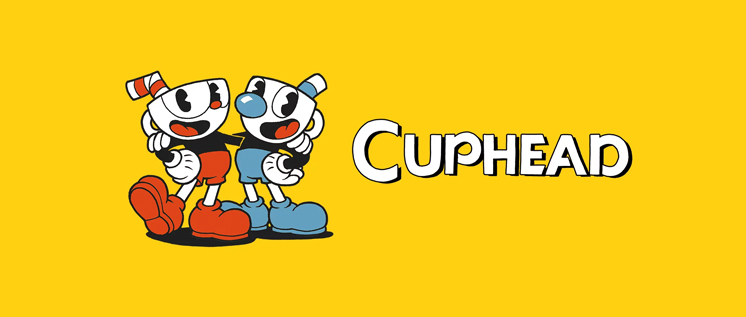

My favorite game right now is Cuphead (rated 10+ years), released this year by Studio MDHR on Xbox and Windows. A lot of the Let's Play videos for Cuphead on YouTube (like this one by Markiplier, one of my favorite YouTubers) are hilarious because they show a lot of people failing. It is a super difficult game, but the designers make it really fun to fail. The premise is that there's this cute little dude whose head for whatever reason is a coffee cup, and he has a bendy straw that bounces adorably while he runs around. Cuphead and his brother, Mugman (whose head, naturally, is a mug) accidentally lost their souls to the devil while gambling at a casino. In order to get their souls back from King Dice, the evil casino manager, they have to bring in the soul contracts of all the other characters who also lost their souls in that casino.


About Game Jams
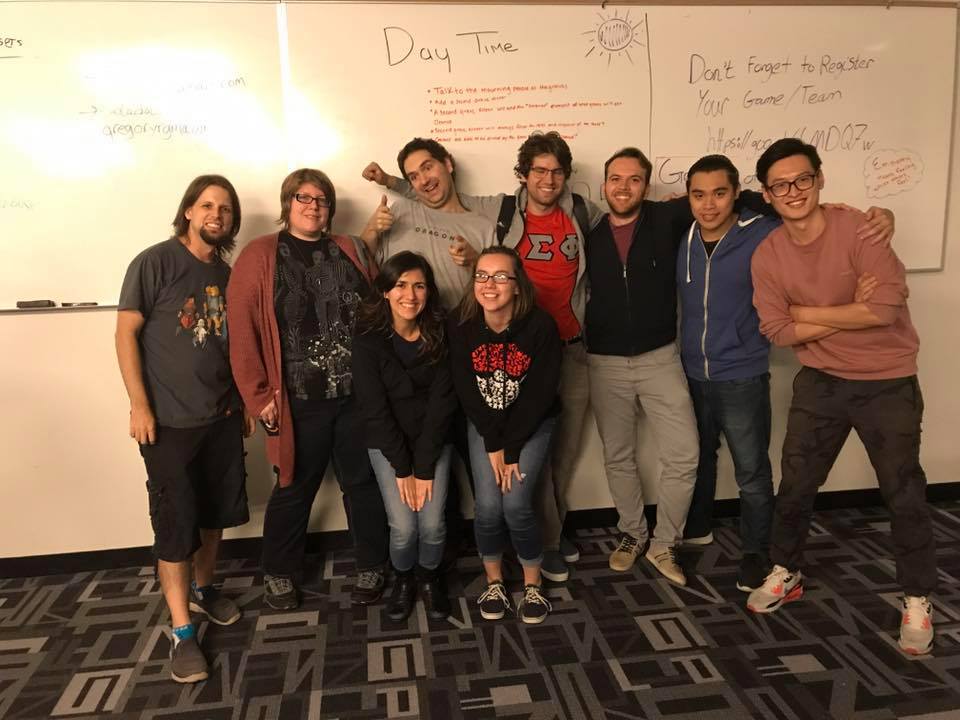
iThrive hosts idea jams, paper prototype jams and 48-hour digital game jams at universities, organizations, and regional game festivals, with the goal of bringing together professional developers, game design students and high school teens to build games together using our science based, expert-developed design resources. Our jams not only demonstrate what kinds of games can result from these design concepts, but are also important events to foster ongoing collaboration and to facilitate mentoring relationships at multiple levels...and, they're fun! These jams also allow us to test and refine our design resources with the help of the people they are intended for.
There are some key ways in which iThrive's Game Jams differ from other types of Game Jams:
- Participant Groups: Combines three specific, key groups of people as attendees, to foster cross-pollination, mentoring relationships, and learning for everyone:
- Professional developers
- Student developers
- Teen developers
- Design resources: Offers iThrive's science-based, expert developed design resources about designing for prosocial outcomes in a block of instructional content at the outset, with subject matter expertise on-site throughout.
- Strengths-based approach: Emphasizes a strengths-based approach to game creation as opposed to treating a social problem or emotional condition as a disease.
- Teen focus: Focuses specifically on making games for a teen audience.
Types of iThrive Game Jams
Idea Jam
An Idea Jam is a 4-hour jam which includes instructional content about designing for prosocial outcomes, and focuses on the generation of a game idea based on that instructional content.
The host location provides the space, publicity, and owns the registration process. iThrive Games provides supplies (paper, writing utensils, stickies, etc.), facilitator, instructional content and materials, subject matter expertise available throughout, and snacks and beverages. Planning for this event can happen over three months.
The deliverables of this type of jam are fleshed-out game ideas designed with the benefit of the instructional content, developed for a teen audience. The benefits of an Idea Jam as opposed to the other two types of jam products we offer include a shorter time commitment from participants, a larger focus on the instructional content, and that the results are easy to share online.
Prosocial Prototypes Jam
A Prosocial Prototype Jam is an 8-hour jam which includes instructional content about designing for prosocial outcomes, and focuses on the generation of an analog game (board game, card game, or paper prototype for a digital game).
The host location provides the space, publicity, WiFi, and owns the registration process. iThrive Games provides supplies (office supplies but also gaming supplies like timers, dice, spinners, game boards and playing cards, etc.), facilitator, instructional content and materials, subject matter expertise available throughout, lunch, snacks and beverages. Planning for this event can happen over three months.
The deliverables of this type of jam are paper prototypes of digital games, board games and card games, designed with the benefit of the instructional content, developed for a teen audience. The benefits of a Prosocial Prototypes Jam as opposed to the other two types of jam products we offer include a focus on design thinking rather than on digital tools, accessibility for people of all ages and experience levels to be able to participate, and the fact that it works well in a situation like MagFest where people are constantly coming and going, and team members can tag in and tag out at any time. What can be challenging about this type of jam is that the deliverables are often difficult to share online.
48-Hour Digital Game Jam
A 48-Hour Digital Jam, much like the Global Game Jam, operates over a full weekend. It includes instructional content about designing for prosocial outcomes, and the output is a playable digital game prototype. It is the only jam type that is competitive, with judging and prizes; judges are a mix between iThrive team members with various disciplinary backgrounds, and faculty members from the host university or staff from the host festival.
The host location provides space, security, computer labs and appropriate digital tools (where possible), publicity, WiFi, and ownership of the registration process. iThrive Games provides facilitator, instructional content and materials, subject matter expertise available throughout, (in locations that do not provide free food, like Google) meals, snacks and beverages, and prizes. Planning for this type of event generally takes three to six months based on the logistical needs of a longer jam.
The deliverables for this type of jam are digital game prototypes. The benefits to this type of jam over other types include helping people learn or practice their digital game-making skills (natural mentoring relationships develop between professionals, students, and teens); the prototypes are usually easily shared online; and teams often want to continue working on their games, toward possible release. The challenges with this type of jam include time commitment for the participants, higher operating costs, and technological considerations.
Instructional Content and Materials
At the start of each iThrive Game Jam, regardless of type, there is an hour of instructional content presented, so that participants understand:
- Who iThrive Games is and why we host these jams.
- Explanation of our design resources and where they came from, and encouragement to share feedback about the resources so that we can continue to make them better.
- Important definitions of specific prosocial concepts, including what the concept is and is not (ie., "sympathy versus empathy" and "being nice versus being kind") and examples of what the concepts look like in daily practice.
- How specific prosocial concepts can manifest in games, including specific systems, features and game mechanics, with game references as examples.
- Suggestions for what ways might help enhance prosocial concepts in games, and what things might take away from these concepts.
- Defining what a "transformational framework" is and providing guiding questions that help participants form a transformational framework for their game.
Participants are given hard copies of iThrive's Designer Guides (from our website, and they can either choose which design guide to work with or use one that follows a specific concept, like the Empathy Jam we held at DigiPen), and transformational framework worksheets. Participants are also given the link to an online survey where they can fill out information about their idea or prototype and the contact information for team members, so that work can be shared later on the iThrive website. (At digital jams, online survey completion is necessary for the game to qualify for prize consideration.)
Key lessons on providing instructional content at Game Jams:
- Developers really like having specific game references to help inform their work.
- The design resources on their own are helpful, but are not enough; equally important and also required is information about the transformational framework (ie., What specific change do we want to see? What barriers exist to that change taking place? How will our game remove those barriers and also encourage change? Can change be measured?)
- It's important to have subject matter expertise available to participants throughout the event. Not only do questions come up during the design process, but developers like to know that they are on the right track. iThrive team members hold several check-ins with each team over the course of the event helps them be more confident about the material, which in turn offers iThrive a valuable glimpse into their processes and intentions.
- Many developers fall into the trap of approaching the concept like a cure for a disease, rather than from a strengths-based position; this needs to be specifically called out and clarified appropriately at the outset.
Want to host a jam? Contact us HERE!
VR and Empathy: Tread Carefully
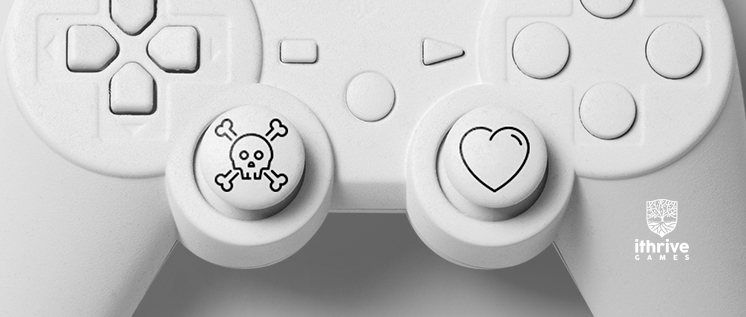
__________
Heidi McDonald, iThrive's senior creative director, felt inspired at the start of a recent virtual reality (VR) innovators meetup. In line with iThrive's mission, Heidi was eager to explore with the group how VR can create new opportunities to build positive practices like empathy — connecting and engaging with others' feelings and perspectives to prompt more caring, responsible behavior in the world.
Conversations began to verge on uncomfortable when some attendees got excited about how VR could be used to immerse people in intense experiences they don't typically have. "Men could see what it's like to get an abortion!" and "People could experience illegal deportation, natural disasters, or living in a war zone!" were some examples.
VR can open the door for audiences to have novel experiences and bear witness to deeply emotional circumstances. But is asking someone to experience another person's trauma necessary for developing empathy? As VR design and use takes off, how are we thinking about the ethics around creating immersive, potentially traumatic experiences?
Distress doesn't equal empathy
Just because you can drop someone into the thick of (simulated) loss, fear, pain, and chaos using VR, it doesn't mean you should. When you immerse players in a violent, intensely emotional, or graphic event that feels real, it's possible you'll cause them distress or trauma. Immediate reactions to trauma include shock and denial, meaning that a person shuts down and disconnects emotionally. Isn't that precisely the opposite of what we'd want an empathy game to do — engage and connect people?
Playing a game is different from how we engage with other media. As game developer Lindsay Grace likes to say: "Readers read, viewers watch, and players do." VR technology adds to this "doing" a deep level of immersion, complicity, and embodiment — the sometimes unsettling sense that you're really there in the thing you're doing. We don't yet know how psychologically powerful that immersion might be. In fact, VR's ability to blur the line between fantasy and reality is one reason for the continuing concern, unfounded or not, over whether VR is safe for kids.
Careful planning and a clear goal are essential when designing and deploying VR experiences meant to evoke strong and potentially distressing emotions in the name of building empathy.
VR and empathy: A process for intentional design
At iThrive, there is a set of questions we encourage all VR devs to ask before designing in the name of empathy:
1) Who are my players?
2) What do I really want my players to do?
3) What does the science say?

1. Who are my players?
Take a participatory co-design approach to build empathy with your end users.
Earlier this year, we featured on our blog an interview with Dr. Doris C. Rusch, a game developer with expertise in wielding empathy as a design tool. She created the game Elude to give people who don't suffer from depression a window into what it feels like. Accordingly, the co-designers and playtesters who informed Elude were people with depression, their loved ones without depression, and clinicians who understand and treat the disorder.
At iThrive, we do something similar in Game Design Studio: we use a participatory, co-design approach when we invite teens to lead our design process. Over several sessions, we encourage teens' self-expression, identify themes that are meaningful for them, and constantly elicit their reactions to what we've created. That's a key way we ensure that the experiences we create are ones that are valuable — and not distressing — to the players we want to reach.
Kinful offers another helpful model in which the end users are the content creators. Kinful uses VR technology in schools to support students' empathy through cross-cultural exchanges. Students who participate in the Kinful curriculum create 360° immersive videos of their own lives to share with peers around the world.
If you understand who your players are and include them in every step of the design process, you'll be better able to design for what you want your players to do and ensure that you're getting the intended results.
2. What do I really want my players to do?
Set a clear goal and consistently revisit it.
Why are you motivated to create an empathy game in the first place? What change do you want to see in your players, and what kind of experience do you want them to have?
There are many valid reasons for making a meaningful game: self-expression; helping players realize they're not alone; encouraging players to understand and care for others who are far away in distance or life experience from themselves; prompting activism. Some — but not all — of these motivations require that players feel empathy.
Whichever of these or other goals you are designing for, be specific and revisit the goal consistently. Getting players to feel something is a very different undertaking from getting them to do something in the real world. And remember that just because a game lets players experience something new, intense, or shocking, it won't necessarily promote empathy.
Consider Dys4ia, a short web-based game that Anna Anthropy made to express her experience with gender dysphoria and hormone replacement therapy. The game was praised as an "empathy game" that could help players understand the experience of a transgender person. But Anthropy pushed back on this categorization:
"If you've played a 10-minute game about being a transwoman don't pat yourself on the back for feeling like you understand a marginalized experience." - Anna Anthropy
It's far from a given that someone who plays a game like Dys4ia suddenly understands what it's like to be transgender or is equipped to act in a meaningfully better way towards and about transgender individuals as a result. And, in this case, Anthropy says that's not why the game was made.
Make sure you design and test your experience for the specific outcome you want. To support that process, you need to understand how changes in feelings, attitudes, and behaviors come about. That's where the science comes in.
3. What does the science say?
Create a multidisciplinary design team to weave in content expertise.
When creating a game to evoke feelings of empathy, make research a part of your design process from the very beginning. There are at least two ways to do that.
First, explore and understand empathy. Empathy is a set of complex thought processes and emotions that enable us to identify — and identify with — another's thoughts and feelings. In the best-case scenario, that identification helps us act in more considerate, kind, and helpful ways towards others. Empathy is different from sympathy (pitying or feeling bad for someone) and has two distinct types: cognitive empathy and affective empathy. These types (and their subtypes) can align with specific design goals, so ensure you choose and learn as much as you can about the type you're seeking to influence.
Second, include researchers, clinicians, and other content experts in the design process from the start. Someone with clinical training can help you assess and plan for meaningful change in players, monitor whether an immersive experience has crossed a line into overly distressing territory, and decide whether players might need additional resources to process what they have seen and felt. Games intended to have some positive social impact can only benefit from a multidisciplinary design team that represents a range of likely perspectives and responses.
__________
VR is an exciting medium and one we should use to its fullest potential for great entertainment and education. Given its relative newness, there are many unknowns. As developers, tread cautiously, plan, and seek good information and partners. By infusing empathy — both for your players and what they'll experience, as well as a deep knowledge of what empathy is — into your design process from the beginning, you stand a greater chance that empathy, not trauma, will result.
Have a concept for an empathy game — VR or another medium? iThrive Games can help! Check out our resources on empathy and contact us for consultation.
How Bad Data Have Given Video Games a Bad Rap (and How To Read Beyond the Headlines)

I'm a psychologist, game designer, and researcher studying how people interact with games and how games impact players. I also make games that explore mental health issues and analyze how mental health is represented in games. I love talking about the psychological complexities of designing games and how games can be used to help us understand ourselves. But when it comes to talking about psychology and games, I often spend most of my time answering the same question over and over: Aren't video games bad for you?
This is a question that has been asked for decades, and before Pac-Man ever said his first "Waka-waka," the same question was asked about pinball, the radio, jazz music, and even the written word. For the last few decades, our technology-related boogeyman has been video games. Video games, especially those with violent content, have had a bad rap almost since the very beginning. And although many of the concerns about violent games stem from sensationalized media coverage, psychologists have added fuel to the fire by making big claims based on little evidence.
A Brief History of Violent Video Games
Controversy over violence in video games can be traced back over forty years. Death Race, a black and white, coin-operated arcade game, holds the honor of being the first video game to start a media panic in 1976.
"A new coin‐operated driving game called 'Death Race' that puts players behind the wheel trying to run down humanoid figures on a television screen is apparently catching on in amusement parks around the country—to the outrage of the National Safety Council." - The New York Times, December 28, 1976, Page 12.

Arcade flyer and gameplay capture for Death Race, a game advertised as being about "chasing monsters" (not "humanoids") and which caused a media panic in 1976. Image source.
The rhetoric against violent video games spiked in 1992 with the release of Midway's competitive fighting game Mortal Kombat.
"Cold blooded murder is making Mortal Kombat the most popular game in history. Kids relish their victory and their bloody choice. Should they pull out their opponent's heart or simply rip his head off just to see his spinal cord dangle in a pool of blood?...[Mortal Kombat] is expected to sell 2 million copies at $50 a pop. A horrifying possibility for parents...The bottom line, parents wonder if kids can separate fantasy from the real thing." - FOX, 1993
In response to national media coverage of Mortal Kombat and games like it, Senator Joe Lieberman called a press conference condemning violent video games. He stated, "We're not talking Pac-Man or Space Invaders anymore.... We're talking about video games that glorify violence and teach children to enjoy inflicting the most gruesome forms of cruelty imaginable." A Senate inquiry followed, but due to a lack of evidence connecting violent video games to real-life violent behaviors, senators could only ask the game industry to create a rating system.
The 1999 Columbine High School shooting radically raised the media profile of violent video games. Both gunmen had played the video game Doom, a fact that was highlighted as a possible contributing factor to the shooting. Linking killers with their use of violent video games continues to be commonplace in the aftermath of tragedies such as the Sandy Hook, Virginia Tech, and Aurora shootings. In fact, there's no evidence of a link between video game consumption and gun homicide.

The Sept. 10, 2013 Fox & Friends newscast propagated an unsupported link between video gameplay and real-world gun violence. Image source.
Psychology and the Violent Video Game Debate
In 2005, the American Psychological Association (APA) — the leading professional and scientific organization for psychology in the U.S. and a major influencer of attitudes about controversial psychological issues — released a policy statement outlining its stance on violent video game content. The APA stated that exposure to violent video games increased aggressive thoughts and behaviors and decreased helpful behaviors.
Although the recommendations outlined in the statement fit into the social zeitgeist around violent games at the time, the research from which the conclusions were drawn was, at best, weak and inconsistent. The lack of solid evidence was the reason the 1993 Senate inquiry on violent games ended without legislative action. Unfortunately, the APA did not demonstrate the same respect for good research.
In 2013, the APA created the Task Force on Violent Media to review current scientific research on the impact of violent games. The task force's review was supposed to ensure that the conclusions and recommendations made in 2005 reflected modern research.

Timeline: Controversy over violent video games has raged on for decades.
A lot changed in the field of psychological games research between 2005 and 2013. Before 2005, the vast majority of published scholarly research had focused only on the relationship between violent games and aggressive behaviors. Around 2008, psychologists began examining factors other than violent content that could be responsible for the relationship between violent games and aggression, such as competitive versus cooperative gameplay or family violence. Academic journals like Criminal Justice and Behavior, Psychological Bulletin, Psychology of Violence, and Cyberpsychology, Behavior, and Social Networking started to publish studies that found no relationship between violent games and behavior, something that was almost unheard of prior to 2005.
The 2013 task force was an opportunity to change the narrative around video games and correct past mistakes. A group of 228 psychologists and media scholars wrote an open letter to the task force noting the decline in societal violence since video games entered the scene and voicing concern about overstating the evidence and drawing broad conclusions from a field of research that was so divided and with such inconsistent findings. The letter closed with an offer to support the task force in their research. However, according to The Huffington Post, over the next two years no one from the APA even contacted this group of field experts.

In 2015, the Task Force on Violent Media doubled down on the APA's 2005 policy statement and announced they had found "a consistent relation between violent video game use and increases in aggressive behavior, aggressive cognitions, and aggressive affect and decreases in prosocial behavior, empathy, and sensitivity to aggression."
Issues with the Task Force on Violent Media's 2015 Report
Outlets like The Huffington Post, Newsweek, Rock Paper Shotgun, Pixelkin, and Kotaku published reponses and close analyses of the 2015 report following its release, and I recommend giving these a read. Critics called the report, among other things, "dead on arrival," "nonsense," "junk science," and "truly disappointing."
Indeed, there were several issues with the 2015 report, including the biased way studies were chosen, the quality of the studies, and the questionable objectivity of the task force members (more than half of them had conflicts of interest).
One significant issue with the task force's report was the flawed way in which they defined "aggressive behaviors." Completing word fragments with "aggressive" words (e.g., completing MU_ _ER with "MURDER" instead of, for example, "MUTTER") is one example of how "aggression" was measured in studies the task force reviewed.
Should filling in letters to complete a negative word really be called an "aggressive behavior?" At worst, it's an "aggressive thought process," and even that may be a stretch. However, that is one behavior upon which the task force based their findings of a "robust" link between violent game content and aggression.
Including questionable experimental methods like these in their review was exactly what the task force was warned about in 2013 by the 228 psychology, games, and media scholars. It is why the scholars urged the task force to refrain from drawing broad conclusions and offering recommendations based upon unreliable data, as was done in 2005.
It's Complicated, But We'll Get There
Human behavior is complex. We often are blind to our own biases and seek out the truths that fit with how we see the world. Simple explanations that, on the surface, seem like common sense are easy to digest and can even feel comforting. It's easier to scapegoat video games when senseless violence occurs than to accept that we might never know exactly why someone made the choice to end others' lives. However, making broad statements based on weak and inconsistent research does more harm than good. It obscures the true causes of aggressive behaviors and ultimately hurts the credibility of psychological science.
Here's what I know based on years of playing and designing games and reviewing and contributing to games research:
- Violent video games don't make people act violently. But that doesn't mean that a game's content is appropriate for everyone, and that includes any online social content a game might offer. Be sure to talk to your kids about safe online practices.
- It is okay for kids, teens, and adults (yes, adults too!) to play video games. As with anything, games should be played thoughtfully, with balance and healthy limits. A study out of Oxford University found that moderate screen time might be better for teens' well-being than none at all. Check out the iThrive Games Resource Center and blog for specific ways games can support positive mindsets and skills like empathy, curiosity, growth mindset, and kindness.
- It pays to play games with your kids. If you are concerned about the games your kids are playing (and even if you're not), play the games with your kids. Let them teach you how to play. Ask them open-ended questions about the games (what's it about, what do you like about it, what do you think of what that character just did?). You will learn a ton about the games and why your child enjoys them. And most importantly, you'll be spending quality (yes, quality!) time together.
- The info you need is at your fingertips — check ratings and reviews. Commercial games are assigned an age and content rating by the ESRB, the equivalent of PG, PG-13, R, etc. ratings for movies. A quick search of the ESRB games guide will tell you everything you need to know about what's in the game and who the game is appropriate for. You can also check out family-friendly sites like PixelKin or Common Sense Media for game reviews and information.
- Look into "indie" games. Many independent game developers make engaging games with positive social messages, opportunities for cooperative play, and themes related to helping others or improving the world and its many systems. Check out the Games for Change website, home to over 150 games that engage contemporary social issues in a meaningful way.
What do you think — are we as a culture making progress towards less alarmist conversations about video games? Share with us in the comments!
__________
Learn more about Kelli Dunlap, PsyD, by visiting her website and following her on Twitter.
We Can’t Design Games for Teens Without This

iThrive Games and EdTogether are co-designers and co-facilitators of Game Design Studio, a special game-based social and emotional learning program for teens. In this post, you'll learn: what teens in Game Design Studio have said really matters to them; the goals and structure of the program; its key features; and a primary takeaway from our design work with teens. You'll also be able to watch a brief video about Game Design Studio and learn more about iThrive Games and EdTogether.
It was week four of Game Design Studio at a Boys & Girls Club an hour west of Boston. We opened our session asking teens to complete these statements: "It drives me crazy when adults...." and "I wish adults knew that...".
The flurry of activity—the teens writing their responses on sticky notes—was unexpected. It was as if they couldn't write fast enough to keep up with their thoughts. The eagerness with which teens jumped up to share their responses reflected the urgency of giving voice to their experiences.
"I wish adults knew that teens have their own goals."
"It makes me crazy when adults...punish us, but they never own up to their mistake and never act like they did anything wrong. They never have to say sorry."
"We kids spend a long day at school walking from class and doing homework. We get tired too. And they call us lazy."
"It makes me crazy when adults don't need to do something the child asks, but when the adult asks the child, it HAS to be done."
Across their dozens of responses, many teens came together around mutual respect. That's not really too surprising.
Teens' Need for Respect
Although there are many individual differences across teens, something they share in common is a biologically-driven need to feel respected both by their peers and by adults. Respecting teens means engaging them with the intent to listen and to take their needs and interests seriously.
Even the most well-meaning adults are sometimes guilty of trying to enhance in young people the strengths we want them to have (ahem, self-regulation) rather than empowering them to pursue what they love and to build the unique profile of strengths that makes them, well, them.
In the 1990's, the disability rights movement launched the motto, "Nothing About Us Without Us." The same credo should guide the creation of games intended for teens. It's only when we involve teens directly that we can know whatever we create is truly FOR them.
We have collaborated with EdTogether to create a context for engaging with teens in a deeply meaningful and transformative way. Game Design Studio is our program that encourages teens to express what matters to them and to create games that reflect their point of view, ideas, and experiences.
Game Design Studio: An Outlet for Teen Voice
In Game Design Studio, teens explore who they are and express that to others across a series of sessions as they play, analyze, and co-design games.
Teens create characters, game worlds, rules, and mechanics around themes they identify as relevant to their lives. They test existing games and games of their own design to assess player experiences during gameplay. They alter game mechanics to test hypotheses around what affects player experiences and use that data to make gameplay more satisfying.
"I put what I thought, how I felt, into the game, and I knew that players would feel the same way I felt since I designed the game." - Game Design Studio participant, Age 13
We then share teens' insights with professional game developers with the goal of creating more meaningful games for teens. Game Design Studio strives to create a tight feedback loop in which teens' voices inform the design of digital games, teens play and analyze those games, and the feedback teens provide helps developers to iterate on and continually improve those games.
Inviting teens to dissect games in this way engages them as prosumers. They become critical analyzers of games and make more informed choices about what they spend their time playing. They think about how games were designed to make them feel, and whether they are comfortable with that or not. They are able to articulate what they like and don't like about games, and why. Instead of merely consuming media, they become their own informed advocates.
Key Ingredients of Game Design Studio
We structured Game Design Studio to have six key features that ensure an authentic and meaningful experience for teens:
- Focus on Teen Interests. Nearly all teens play games. Engaging teens starts by focusing on something that genuinely appeals to and motivates them. Games offer an excellent context for authentic discussions and learning that meets teens where they are. Games are used as the launch pad for teens to reflect and focus on their own social and emotional challenges and opportunities.
- Co-design. Game Design Studio's co-design approach invites teens directly into the game design process. Co-design changes the power dynamic of a typical learning interaction and empowers teens to directly engage with adults, challenge them, and co-design as equals. In this way, teens practice finding their voice and raising it in service of their own learning and development.
- Dynamic. The structure of Game Design Studio is intentionally adaptive to the insights and reflections from teens. We're constantly adapting to what teens find meaningful because that's what's going to produce games that feel authentic to teens' lived experiences.
- Universal Design for Learning. Game Design Studio was designed using Universal Design for Learning principles. In designing each activity, we consider the diversity and variability inherent to the teens involved and work to prepare the learning environment to be rich with options for how teens take in information and express their new knowledge and skills.
- Social and Emotional Learning. Game design requires social and emotional skills. How does the design of the game affect players' feelings? How does the design of the game keep a player engaged? These are critical social and emotional skills — identifying and managing other people's emotions. As teens work together in design teams, they build their collaboration skills.
- STEM Skills. In Game Design Studio, teens pinpoint the emotion they want someone else to feel and then leverage engineering principles to reflect, question, ideate, define problems, collect and analyze data, and build and test their creations. This kind of iterative, critical process is essential for learning. It also helps to redefine for teens what "science" is. Science is not confined to test tubes and programming; it's using curiosity about ourselves, others, and the world to pose questions and to experiment with possibilities. This can help to break down some of the barriers to belonging in STEM fields that many teens experience.
Key Takeaway: The Limitations of "Average"
Before iThrive Games and EdTogether launched Game Design Studio, we had only general impressions of "what teens like." But we soon found out that the general or average doesn't actually reflect any one person's experiences, values, or preferences. The huge range and complexity of interests and needs teens bring to Game Design Studio means that we just cannot design meaningfully for teens without engaging with them deeply and authentically.
We engage with teens to listen, not to impose our ideas of what's best for them. We at iThrive Games and EdTogether have committed to only designing for teens alongside a lot of authentic engagement with teens. We heard them ask for mutual respect. We listened and are acting accordingly.
"Game Design's definitely given me confidence in what I think I can do, but it also helped me think about how I could build off of other people's ideas in order to reach one progressive goal." - Game Design Studio participant, Age 13
Get Involved in Game Design Studio
Interested in making a difference with and for teens? Contact iThrive Games about hosting or sponsoring Game Design Studio!
More About iThrive Games and EdTogether
iThrive Games exists to empower teens to thrive using great games. Teen development is impacted by the settings they inhabit — their home, their classrooms and school, their neighborhood, their city. More and more, teens are inhabiting virtual settings. Their screens are available 24/7. They can and do take them anywhere and everywhere. The interactions they have in these settings impact how teens think, behave, and what they value. Video games are prevalent and offer an opportunity to engage teens where they are. iThrive Games is committed to creating meaningful experiences for players in games, experiences where they cultivate assets to support their thriving across the teens years and into adulthood.
EdTogether works to leverage emotion in education in order to engage all students. So many students (and especially students with unique learning needs) experience consistent disengagement from their educational experience, feel negatively about learning, and lack critical supportive relationships at school. This puts them at a significant disadvantage. They are, in essence, emotionally excluded from learning. EdTogether seeks to enhance the spirit of learning among all students by designing educational settings that spark and leverage curiosity and motivation.
Oxenfree: Spooky and Meaningful Halloween Play
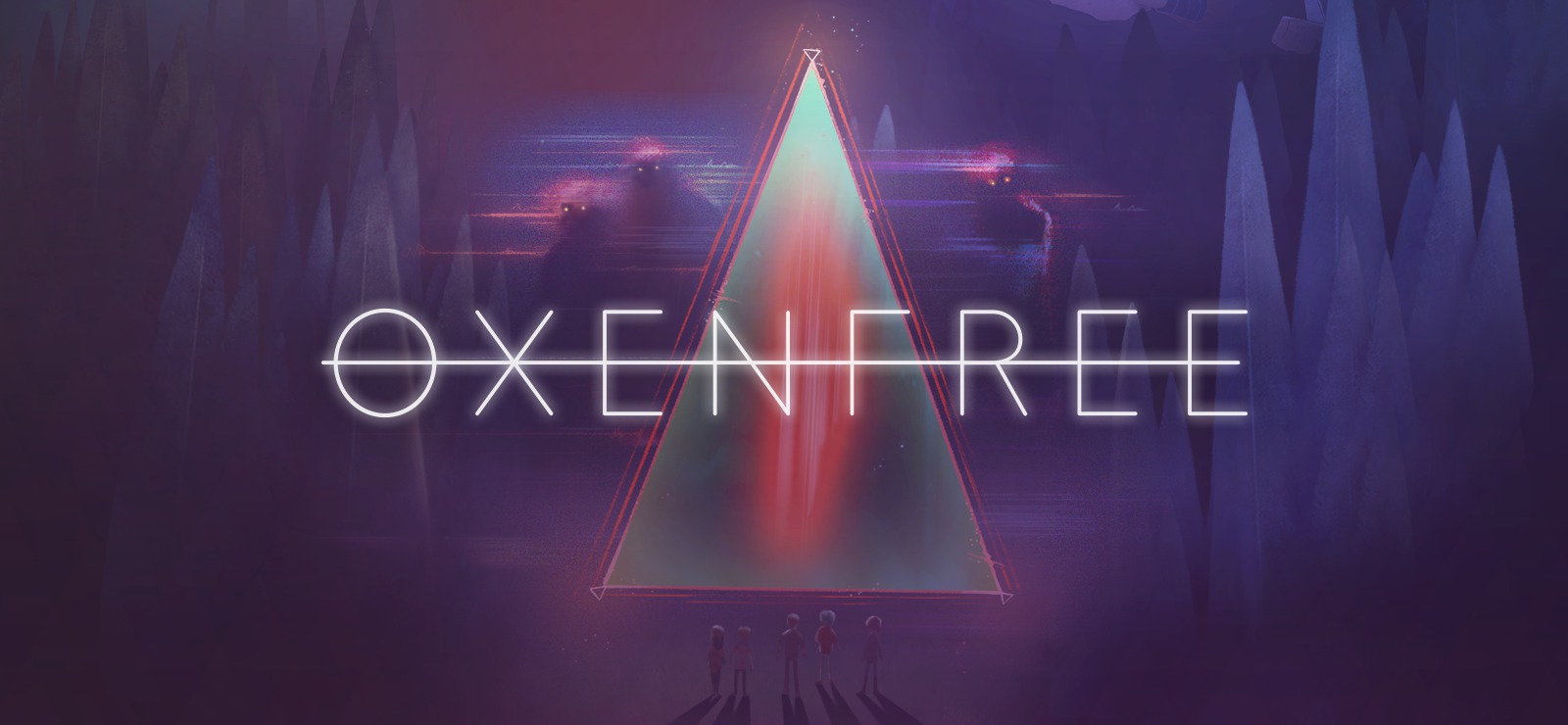
I'll be hearing eerie radio static in my nightmares for the foreseeable future.
That's because last night, in preparation for my favorite holiday, I turned out the lights and spent three hours taking in the delightfully spooky Oxenfree, a horror game that uses tuning a handheld radio as a core mechanic.
Released in 2016 by Night School Studio, this adventure game that's "equal parts coming-of-age tale and supernatural thriller" offers depth and meaning alongside enough ghostly encounters to leave anyone jumpy.
What starts out as an overnight island beach party for the local high school seniors takes a sinister turn when Alex and her friends accidentally open a portal to the world of the dead. As the teens attempt to close the rift and escape the island using just a map and a radio, the past is unearthed and bonds are formed or broken, depending on how you play.

It's just a bonfire at the beach until someone opens a ghost portal.
Considering this game through the lens of the mission of iThrive Games — to provide meaningful experiences for teens through gameplay — here's why I really liked Oxenfree:
- It's teen-focused. According to Oxenfree's lead artist, Heather Gross, the game captures the "delicious awkwardness" of the late teen years. It manages to tackle both run-of-the-mill teen drama — fitting in, rivalries, crushes, family dynamics, deciding what to do after high school — and life-changing tragedy. Writer Adam Hines says of Oxenfree's teen characters, "I wanted them to be intelligent, complex, complete, surprising characters. I didn't really think, 'What would a teenager say?'" The result is authentic characters that kept me engaged throughout. And it's rated 14+ years by Common Sense Media, so Oxenfree is developmentally appropriate for teens to play, too.

Oxenfree's teen characters are relatable and authentic.
- It's insightful AND creepy. The supernatural storyline is punctuated by unexpectedly poignant moments that remind the player not to take for granted bonds with friends...or even frenemies. It touches on universal themes of love, loss, friendship, sacrifice, and discovering what makes life meaningful. But also, as the player, you will contend with ghosts who want to live inside you and demonic voices from who-knows-where asking if you want to play. It's a horror game, after all.

The mouth of the cave is where the real trouble begins. Put down that radio!
- Choices matter. Player agency matters a lot in games and Oxenfree certainly provides that with over 12,000 possible lines of dialogue and at least 10 different possible outcomes based on how the player speaks and behaves. [SPOILERS: Here's a guide to Oxenfree's possible endings.] As your own incarnation of Alex, the complex female protagonist, you can choose to be silent, snarky, kind, aloof, nosy, rebellious, brave, and selfless. You can take sides or stay neutral, be judgmental or accepting, tell others what to do or mind your own business. The choice is yours and, just like in real life, often there is no clear right answer for every situation.

Alex has meaningful dialogue choices that shape the outcome of the story over time.
As you watch your Oxenfree story come to its conclusion, you're invited to reflect on how your actions and inactions changed the course of the tale. After only one playthrough, I couldn't help but feel that pieces of the story were still missing. That's as it should be. The impressive complexity and depth of its branching means that the Oxenfree has many secrets to reveal over multiple plays.
So, tonight, after the trick-or-treaters have come and gone, I might just re-enter the world of Alex and the spirit portals and do everything differently than I did it before. If you're looking for a meaningful story and a good scare, I recommend you do the same. Happy Halloween from iThrive Games!
Have you played Oxenfree? What did you think? Please share with us in the comments!
My Favorite Games from IndieCade 2017
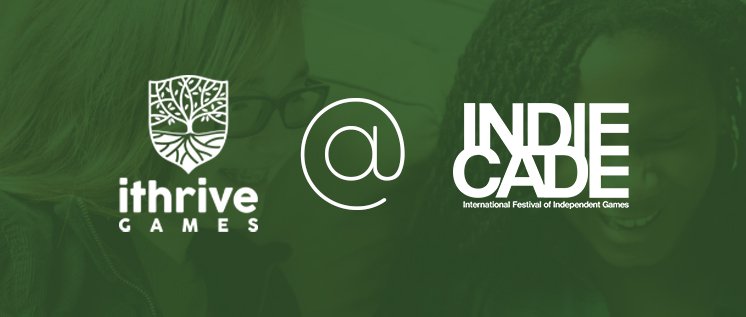
From Oct. 6-8, I was lucky to attend the 10th IndieCade International Festival of Independent Games in Los Angeles. The weather was beautiful and ramen was available in more varieties than I was able to consume (although I tried). I set out through Little Tokyo to play as many games as possible and chat with developers from various backgrounds.
Video games are the mainstay of IndieCade, but there were also tabletop games, role-playing games, and games that were a mix of digital interaction and guerrilla theater. The commonality was developers using games as a form of expression — rather than merely a dopamine-dispensing mechanism — something several developers told me was important to them. Developers, media representatives, and attendees were there to see what was new and have a meaningful experience through gameplay.
There were just over 100 games on display this year and the majority of those I got to try incorporated themes of social change, equality, and empathy for others. Here, I share the top IndieCade games I tried that left an impression on me. I would recommend these for players looking for a fun gameplay experience that's also eye-opening and meaningful.
- A Normal Lost Phone (ages 18+, developed by Accidental Queens) asks players to explore the contents of a lost cell phone to find out what happened to its owner. It tackles themes of sexual identity and privacy. (Note: iThrive Games supplied the diversifier that helped inspire A Normal Lost Phone at the 2016 Global Game Jam! Accidental Queens dev Elizabeth Maler talks about that in the video clip below, starting at 3:22.)
http://https://youtu.be/Q7X8DDjREWM?t=201
- _transfer (not yet rated*, from developer Abyssal Uncreations) is an intriguing text-based game "about computers, memory, and identity." The soundscape and DOS-era prompts make it a unique and ambiguous experience, and it's supposed to be that way. A primary theme of the game is exploring gender and sexual identity.

IndieCade attendee sampling _transfer. Photo Credit: Sean Weiland.
- Bury me, my Love (not yet rated**, developed by The Pixel Hunt, Figs, and ARTE France) is "a story of love, hope and migration." It follows Nour and Majd, a Syrian couple who are separated as Nour immigrates to Germany to escape the Syrian conflict. The player plays as Majd and communicates with Nour via a WhatsApp-like cell phone interface. The game is informed by real events.

Playing Bury me, my Love at IndieCade. Photo Credit: Sean Weiland.
- Four Horsemen (not yet rated***, developed by Nuclear Fishin' Software), an IndieCade 2017 Finalist, is a visual novel that infuses authentic humanity into a portrayal of the immigrant experience. Players take the perspective of four teenagers that come from one of 12 fictional countries. The teens find an abandoned bunker to live in, and the player's decisions determine what kind of community the teens build.

IndieCade attendee sampling Four Horsemen. Photo Credit: Sean Weiland.
If you're looking for more games to try, I highly recommend checking out all the IndieCade 2017 nominees and award winners (just make sure to check out the content of each title you're recommending to teens). These games represent a wide range of perspectives and approaches to impactful design.
IndieCade has attracted a fantastic community. It speaks to the quality of the festival that developers from all over the world make the effort to come to this more intimate, non-AAA event. The devs I met were supportive, intelligent, kind, and open. No surprise that they make engaging and meaningful games! I am looking forward to exploring the games I didn't have time to play and continuing the many great conversations I started there.
Did you attend IndieCade this year? If so, what games and developers impressed you? Please share with us in the comments!
———-
NOTE: Parents and guardians should be informed of the content of games their teens are playing and decide together what is appropriate for them.
*According to the developers of _transfer, the game is appropriate for ages 15+. They caution that there are "a few scenes of intimacy and sexuality but nothing terribly explicit."
**According to the developers of Bury me, my Love, the game likely will be rated by Pan European Game Information (PEGI) as appropriate for ages 12+, but standards may not translate exactly from PEGI to ESRB and "it might be better to be a little older than that to really get what's going on."
***According to the developers of Four Horsemen, the game is appropriate for ages 15+. They caution that the game contains "a LOT of profanity...(in multiple languages)" as well as "a small amount of blood and a few realistic (but not graphic) depictions of hate crimes some players may find traumatic."
That’s a Wrap on Design Hive 3
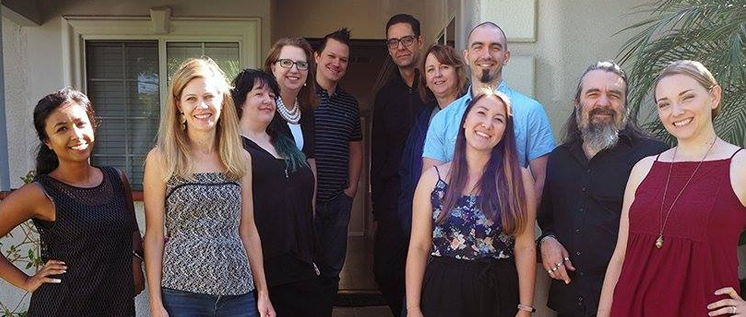
What do you call an enthusiastic gathering of game devs and psychologists? In the world of iThrive Games, that's an #iThriveDesignHive!
Our third Hive took place Sept. 21-24, 2017 in Anaheim, CA. We added a fantastic group of individuals to our collective Hive Mind, which includes indie, educational, and AAA devs and studio heads, top researchers and professors of game design, and social and emotional learning experts.
For Hive #3, we were lucky to host 6 stellar influencers who joined us in a series of discussions about what makes games meaningful and where there are opportunities to help games, game devs, and players more fully realize their potential. Attendees were:
- Jason VandenBerghe, ArenaNet's brilliant studio director of design and former creative director at Ubisoft, who lent an invaluable AAA industry perspective.
- Sheri Graner Ray, also from the world of commercial games, who's a game industry veteran and the founder/CEO of Zombie Cat Studios. She's been called an "industry hero" for championing gender diversity in games.
- Mitu Khandaker, PhD, an entrepreneur, BAFTA Breakout Brit, game scholar, and professor at the NYU Game Center who helped us to think deeply and critically about what gives players an authentic emotional stake in their gameplay.
- Chris Hazard, PhD, of Hazardous Software, who lent his point of view as a computer scientist, game engine architect, and game theory expert who's working to make AI more responsive and emotionally compelling.
- Paul Darvasi, a doctoral candidate and educator who's an expert at engaging his 12th grade English students in deep learning using a range of games, many of his own invention. For more on that, check out his blog "Ludic Learning" and the post he guest authored for us. Darvasi also wrote UNESCO's report on empathy in games.
- Barbara Chamberlin, PhD, professor and project director for the Learning Games Lab at New Mexico State University. She knows pretty much everything about building engaging games that teach and assess the skills students need most. Look out for her forthcoming book on transformational game design with Jesse Schell.

From left: Hivers Chris Hazard, Mitu Khandaker, and Sheri Graner Ray discuss meaningful game design.
We also were thrilled to host as a guest presenter Diana Divecha, PhD, a developmental psychologist with expertise in adolescence and social and emotional learning. Diana encouraged this group of game devs to consider teens' unique potential as well as their vulnerabilities. She reminded us all that "If you're producing experiences for teens, you're hard-wiring their brains." A big responsibility, yes, and also an amazing opportunity!

Diana Divecha (center) with iThrive team members Susan Rivers (left) and Michelle Bertoli (right).
Dr. Divecha shared some compelling design challenges for teen audiences that attendees were eager to explore. For example, how can we use games to empower players to manage feelings of loneliness? What about dealing with discrimination and microaggressions? Or harnessing the power of strong feelings to guide wise actions and choices?

Hive attendees Jason VandenBerghe (left) and Chris Hazard.
The highlight of the weekend for us — beyond getting to know and work with these industry heavy hitters — was making progress on shaping our strategy for spurring the production of more meaningful games that can improve players' lives and maybe even the world. Feedback from our Hivers validated and opened new pathways for our focus on:
- Expanding our current offering of developer tools
- Exploring the potential of games for learning and building social and emotional skills
- Engaging teens both as reflective players and designers of games, as we have begun to do in Game Design Studio and through other strategic partnerships

iThrive team members Jane Lee and Sean Weiland enjoying the Hive.
At iThrive Games, we continue to build a network of passionate and thoughtful partners on the road to making more meaningful games. We are so grateful for their contributions to our vision and mission. Thank you, Hivers!
Making a Game in One Hour: The Power of Our Choices
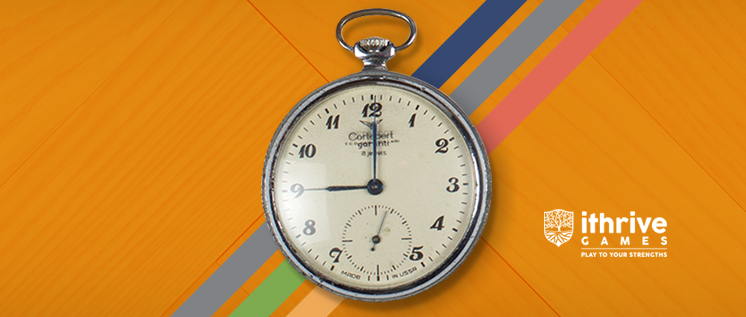
Editor's note: At iThrive Games, we're always curious about how video games—playing them and making them—can support personal growth and transformation, especially for teens and young adults just venturing out on their life's path. Here, guest author Belinda Zoller, community manager for Extra Credits, reflects on a game design project that delivered meaningful insight...and fueled a key career decision.
***
It was just after 7 p.m. on Dec. 4, 2016 when my friends called wanting to go on a leisurely drive downtown. I packed up my tiny, outdated tablet PC that ran only an hour or so on battery life and jumped in the passenger seat of my friend's car with one goal: make a game.
It was an unconventional office space for making a game, but I told myself it was now or never. I had already procrastinated on my entry for the upcoming Self-Care Game Jam for weeks.
At the time, I wasn't working in games full-time, but that's where I really wanted to be. I just didn't know how to move forward. I had let myself get wrapped up in graduating from school and "learning to adult" and I was feeling disconnected from a greater purpose for my life beyond everyday survival. My day job back then was marketing for a B2B startup. I loved the work itself, but the company's mission and clients didn't leave me feeling like I was making a real difference, creatively or otherwise, in the world.
Even though I lacked a road map for how, exactly, to get where I wanted to be, deciding to make a game that night represented driving in the right direction.
My laptop's terrible battery life created a one-hour time limit to reach my goal and also inspired my subject: an interactive journal entry about the decisions we make every moment.
Taking this time to lay aside any existential concerns about my long-term worth as a creator, I dedicated my game's purpose to exploring my decisions in this exact moment. I'm in a car with my friends, going on a leisurely downtown drive, with no distracting internet access. What are the (ordinary) ways this scenario could play out? What choices am I making right now as I'm both participating with my friends and, at the same time, observing all of us experiencing this moment together?

A screenshot featuring one of the choices December 4, 2016 asks the player to consider.
I listened to the passionate conversations between the other people in the car as they discussed relationships and life. I stared at the hazy Christmas lights in the neighborhood and concentrated on not getting motion-sick. Those observations were opportunities for choices I could make, even when I felt limited in my choices for how to spend my daily working life.
Hyper-focusing on these mundane choices I found myself making throughout my design process—when to listen in or speak up in the conversations, when to pay attention to the outside scenery versus the blank Twine editor—made me curious about the bigger choices I found myself seemingly unable to make. Why was I unable to move forward when I knew what I really wanted to be doing? What outside pressure was I allowing to keep me stuck?
Much like the driving car that was my design office for the evening, the personal drive to create and express ourselves is not really a constant acceleration the way we tend to use it in sentences: "They lack the drive to finish this game." Really, we're always driving, even if it means waiting our turn at the intersection for a green light to flash, for that motivation to keep going even when we're running low on inspiration. Being able to make this short "trip" to the destination of just finishing and publishing a game, any game, empowered me to realize that, no, I don't have to keep being a passenger in my own life.
This realization guided me through the rest of the week. On Monday I found myself laid off. Instead of panicking about my seeming lack of direction or income, I took it as a sign that my instincts on Sunday night were spot on: I had no more excuses to procrastinate my passion. By Friday I had renegotiated a previous part-time gig into more stable, consistent employment at one of my dream companies. I wasn't directly working on games, but I was nonetheless ecstatic to contribute my skills to a cause I cared about—helping other people find their own creative fulfillment.
What unfolded in December 4, 2016 doesn't necessarily fit my vision of what a game that I make could look like. For one, it offers far too few and far too mundane choices. You'll find at least one typo in it. There will never be a polished version or a second pass. But when I look back at it as an experiment in exploring my sense of purpose, I realize that game design has the power to shine a light on the choices that are already in my power to make.
***

Psychology and Game Design: One Possible Future Path
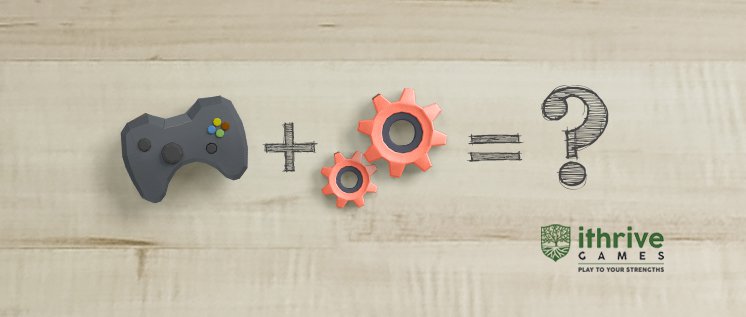
**EDITOR'S NOTE: Ian Schreiber joined iThrive Games for our October 2016 Design Hive, where he learned about our mission and felt inspired to post about it on Facebook (check that out here). This blog is an extension of the thoughts he shared there.
"Is flow the only concept from positive psychology that...help[s] us design better games regardless of our motives for doing so? Or is it just the only one that the game design community has discovered so far?" - Ian Schreiber
It's rare to find a game designer who hasn't studied any psychology. Our job is to craft compelling experiences; understanding how humans experience things is vital to our work.
And yet, much of the field of psychology is devoted to what happens when things go wrong. As with medicine, there is more of a focus on pathology than maintenance or wellness. Most of the training doctors and psychologists go through focuses on how to fix problems, with little attention paid to taking happy, healthy humans and maintaining or improving their health. Much of a game designer's study of psychology, then, focuses on human weakness. When I teach game design in a classroom, for example, I cover topics like these:
- Why most people misunderstand basic probability, and how to design our games' random systems so that they aren't misperceived as unfair (or conversely, how gambling games and some free-to-play games exploit these misconceptions for money);
- Reasons why players are jerks to one another in online games, and how to design our games' social systems to minimize the effects of trolls and griefers;
- Behavioral conditioning, addictive behavior, and other mind hacks that trick players into continuing to play our games long after they would otherwise choose not to;
- Cognitive biases, fallacies, and other traps that our designer brains and player brains lay for us so that they can destroy the fun in our games, and how to design with these very human fallibilities in mind.
This is not to say that these things aren't important. They certainly are. But most players of games are physically and emotionally healthy and well-adjusted humans. Especially if we are designing for the mass market, it would seem prudent to understand not just abnormal psychology, but also the healthy, whole, and thriving mind.
POSITIVE PSYCHOLOGY
The field of positive psychology is concerned primarily with improving an individual's happiness, well-being, and self-fulfillment. Rather than focusing on curing mental illness or eliminating maladaptive behavior, positive psychology seeks ways for individuals to improve their happiness, whether or not they suffer from any disorder in the DSM-V. Here are some examples of concepts studied by positive psychology researchers:
- Empathy: Understanding what others are feeling, and why
- Curiosity: Cultivating a desire to explore the world around us
- Gratitude: Being thankful for the kindnesses of others
- Growth Mindset: Believing that we can improve rather than being limited by our DNA
- Mindfulness: Being present in the moment in a non-judgmental way
- Purpose: Pursuing a life of meaning
- Flow: Challenging ourselves at the peak of our ability
...Wait, what was that last one? It probably sounds familiar, because Mihaly Csikszentmihalyi's work on flow, a key concept in positive psychology that was popularized in games by Raph Koster's Theory of Fun, is standard content in most Game Design 101 classes.
BETTER PEOPLE, BETTER GAMES
Game designers, particularly those of us working on games for entertainment (as opposed to "serious games"), are primarily tasked with making our games fun, to the extent that this will help the games sell enough copies that our studios can keep making games.
I've met a lot of game designers in the last couple of years who seek a greater purpose—far more than I've seen in the 15 years before that. Some of us want to make games that don't just entertain, but that make the world a better place. Not all of us are driven by this ideal, of course, but it seems there are more of us talking about this than ever before.
Even if you're the type of game designer who just wants to make games that are fun and views that as enough of a lifelong challenge without also having to save the world, thank-you-very-much, you've still probably heard of this concept of flow, and maybe used it to improve your games. Not because you want to improve players' lives, but because this concept from positive psychology helps you make games that are more fun. Any lifestyle improvement that happens as a result is a nice bonus, sure, but you wouldn't even bother except that it also makes your games more compelling.
This begs the question: Is flow the only concept from positive psychology that has this property, helping us design better games regardless of our motives for doing so? Or is it just the only one that the game design community has discovered so far?
Given that positive psychology deals with things that improve people's enjoyment of life, it's likely that these concepts would also improve our players' enjoyment of our games. We just need to figure out how. And once we do, perhaps we will enter an age where our best entertainment games do, in fact, make people's lives better. Not because they were designed to do so, but merely because they were designed well as pure entertainment.
If you agree there is potential here, then, consider this your call to action. Join in seeking ways to apply these concepts to game design. I look forward to seeing the better worlds that you create as a result. (If you couldn't guess from the location of this post, iThrive Games is a non-profit organization specifically working in this space, so if you are reading this and thinking that this is describing your
current or future projects, or that you'd like to know more, I'd suggest getting in touch with them.)
***
About the Author: Ian Schreiber (@IanSchreiber) has been in the game industry as a designer, programmer, and educator since 2000. In addition to his role as an assistant professor of game design at Rochester Institute of Technology, he has worked on several shipped titles including online trading card games, console games, online social games, and some "serious games" for corporate training. He is also an author and a co-founder of the Global Game Jam.
Games for Personal Growth: A Design Process

EDITOR'S NOTE: We were lucky to have Brie Code at our February 2017 Design Hive in Anaheim, CA. She told us that our discussion of positive psychology and strengths inspired new design approaches at her studio, Tru Luv Media, and she shares her insights here. Also check out our interview with Brie.
"When I think of my friends saying they want to 'grow and change' from the media they consume, I know they would find games designed around developing their strengths to be rewarding." - Brie Code
***
I love video games, deeply. Video games have been a resource for me at key moments of my life. They have been a safe space for relaxation, for meditation, for introspection, for identity experimentation, and overall, for growth.
But most of my friends don't like video games. In fact, when I talk with my friends, their biggest misconception about video games is that games are a waste of time and don't help them grow or change.
At my company, Tru Luv, we're making games with the intention of repairing this misconception. First, each project is designed with someone who doesn't like video games. This helps us break out of geek culture. And second, each project is designed with personal growth at its core.
The first step in our design process is the Why. We start by brainstorming around a specific meaning or purpose that comes from the heart of the creator.
The first game we'll release, a game called #SelfCare, is designed with Eve Thomas, a magazine editor and artist from Montreal. In early brainstorms with Eve the concept of self-care came up fast. Eve was seeing an increasing number of posts on Tumblr about self-care and it was resonating with her. When she first came across the trend, it annoyed her. Why should women need a medical-sounding term, an authoritative excuse, to take some time for themselves? Why not just take a bath and call it a bath?
Then Eve realized that for many of us, we need external permission to take care of ourselves. Women have been raised to take care of everyone around us. We've been taught to be polite when people cross our boundaries. We've been taught to do the majority of the housework, childcare, and care for aging family members. At the office we learn that our ideas get made when we give them to a man. In general we aren't used to demanding what we need. Eve decided if the concept of self-care helps women block off some time for that bath we may desperately need, then that's fine.
However, with so many external demands, even once the permission is there, not all women can find that time. So Eve wanted to make a mobile game that was a moment for self-care, a moment of relaxation and peace while boiling water on the stove or taking an elevator to an important meeting.
The second step is How. How can we convey that this game is a refuge for taking care of yourself? We decided that the game should calm panic, should bring positive energy, and should feel satisfying and not frustrating.
The third step is Who. Who are the characters in the game? Who does the player interact with? Who is the player? We decided that the game would have one character, a person who couldn't face the world and who stayed home for the day and stayed in bed—a person who is living the ultimate delicious fantasy of taking a mental health day.
The fourth step is Where/When. Where and when is the game set? We set the game in the bedroom of the person who stays home. The bedroom is welcoming. It's decorated in a familiar, current style for people who love Tumblr and Pinterest and Instagram. It's full of familiar, comforting objects. Maybe you can't afford that cute Tarot deck in real life, but you can have one in the game.
The final step is What. We design the game mechanics last. They emerge from all the previous steps. What game mechanics are calming, positive, and satisfying but not frustrating? What game mechanics feel like a mental health day? What game mechanics feel like a comforting, tasteful bedroom? We decided that for each object in the bedroom, there is a different meditative interaction you can do that is calming for the character and calming for the player as well.
From there, we created a prototype of the design, gave it to Eve, worked with her to identify changes or next steps, and repeated. We are very flexible about trying new, strange ideas.
When we're designing the game mechanics we think a lot about what psychological rewards are relevant for the core meaning and purpose of the game. Video games are about managing rewards so that the player is never too bored and never too overwhelmed. Most games achieve this by managing the level of stress—the fight-or-flight stress response triggers dopamine rewards in the brain and is very satisfying. But we're not interested in making stressful games. We consider other reward systems, ones that lend themselves more to understanding and growth.
First, we look at a different stress response, not fight-or-flight, but tend-and-befriend, mediated by oxytocin and opioids. I think often about managing oxytocin rewards instead of dopamine. Opportunities to display care in a game can be rewarding. Eve's game is very much a place for the tend-and-befriend stress response.
Beyond stress reactions, we think about other branches of psychology and what rewards we can find there. We think about Quantic Foundry's Gamer Motivation Model. We also think about personality psychology and the Big 5, and how people will tend to seek out situations to display their dominant personality traits and find it rewarding to do so. Customization and other opportunities for identity experimentation in games can be very rewarding.
And then earlier this year I attended an iThrive Games Design Hive and learned about positive psychology and the VIA Strengths. This was a key that was missing in Tru Luv's design process. While most psychology is about fixing psychological issues, positive psychology is about identifying your unique strengths and developing them—about personal growth. When I think of my friends saying they want to "grow and change" from the media they consume, I know they would find games designed around developing their strengths to be rewarding.
Right now we're busy debugging #SelfCare for beta release. But on each subsequent concept, we'll be experimenting with integrating strengths into the brainstorm process. If we were re-designing #SelfCare thinking about strengths, I would start by asking Eve to do the VIA Strengths profile. If Eve was attracted to the concept of self-care, it is probably because there are some interesting correlations or tensions between that concept and her dominant strengths. I'd ask her how her strengths relate to the topic of self-care. And then as we brainstorm the game mechanics, we could start with those individual strengths. What kind of game mechanics could develop those strengths? In the case of #SelfCare, I could imagine expanding it beyond the meditative interactions for calming stress. Once the character feels just well enough to leave her bedroom, I could imagine further rooms in her house that are designed around developing strengths that seem related to self-care, such as Appreciation of Beauty & Excellence, Humour, Creativity, Kindness, or Self-Regulation.
***
About the Author: Brie Code is a speaker, writer, AI programmer, and the CEO and creative director of Tru Luv Media, a video game studio making games with people who don't like games. Previously she was a lead programmer at Ubisoft Montreal on the soft, ethereal game Child of Light and three Assassin's Creed games. Her favorite games are This War of Mine, Skyrim, and The Colonel's Bequest.
GUIDE: A Video Game for Challenging Your Fears
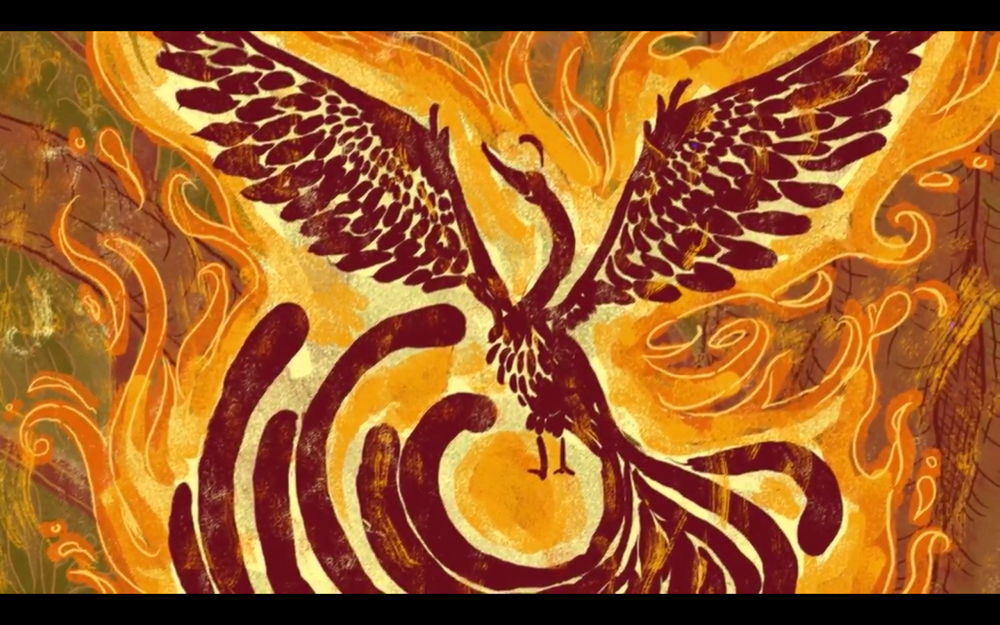
"The voice in your head is not always a truthful guide, and the journey of fighting your fear starts by making the choice to question your own narrative." - www.guidethegame.com
You are Fia, a baby phoenix just born back into the world from a pile of ashes. Lightning strikes the tree you call home and you fall from your nest, only to awaken flightless and alone on the forest floor in thick darkness. A mysterious orb of light floats towards you and urges you to follow. It is a friend, it seems. It will take you to safety.
You take some cautious steps forward, the orb of light illuminating your way. Then the light urges you to jump across a wide chasm. "You will make it," your guide says, stoically.
You take a running leap, but miss the ledge and fall down, down, down into a world of dead ends, shadows, and ever-vigilant eyes. Maybe your guide isn't so trustworthy, after all...
* * *
This is the introduction to GUIDE, a puzzle platformer about anxiety and the value of challenging the fearful voice in our heads. Made by University of New Brunswick alumni Rebecca Goodine, Elliot Coy, Jade Yhap, and their teammates,* GUIDE won second place in the international student design competition for empathy games that iThrive Games co-hosted with Games4Health in 2016.
GUIDE was a standout among the submissions owing to its charming art style, unique mechanics, and compelling theme of questioning the inner voices that keep us stuck. Since the competition, the team has had time to build on the original concept, so we checked back with them to find out how GUIDE is coming along and what's next for the intriguing empathy game.
Michelle Bertoli: What inspired you submit an entry to the empathy design competition iThrive co-judged with Games4Health? Why does empathy in games matter to you?
GUIDE Team: We were approached by one of our professors (and now team member), Jeff Mundee, with the collaborative iThrive and Games4Health empathy competition. The theme was immediately intriguing, as it stood out from a lot of other themes in similar competitions at the time, and it also aligned with our personal design and research interests. We wanted to design a game about social anxiety because it was a condition that had affected us and people we knew. Empathy was an important vehicle through which we could address the issue of social anxiety. GUIDE attempts to prompt empathy in an experiential way, but also can be a catharsis for those who identify with anxiety.
MB: Why is it important to you to give players a window into how social anxiety feels?
GT: Social anxiety can be a very isolating and internal experience, and with GUIDE we wanted to show that struggle in a way that allows players to relate to Fia and these very personal battles. Our goal is that the game allows players to reflect on their own struggles, or helps them better connect to a friend or loved one with social anxiety.
MB: GUIDE encourages players to question the internal voices/narratives that keep them stuck in fear. How does this contribute to empathy?
GT: The internal voice or narrative is represented in GUIDE by a small light who leads Fia through the game's forest. The AI for the Guide hovers towards geometry the player needs to see to progress through levels. This light from the Guide, like the thoughts in our heads, "clearly" illuminates the path the Guide wants us to follow. However, over the course of the game it becomes apparent that the Guide is not always right, and the player should start to question the Guide, since there are other, sometimes better, roads to travel. In this way, GUIDE players must begin to acknowledge the perspective of others and how it differs from theirs.
The eyes that hide from the Guide's light in the game represent social anxiety. Players feel like they are being watched and may be able to empathise with Fia's fear. They can start to relate to how people with social anxiety feel like they are being scrutinized. Players also learn that the voice of the guide is an internal voice, like the voice in their heads that can sometimes lead them astray.
MB: Why is it important for teens and young adults to challenge their own internal narratives?
GT: Teens and children are bombarded with messages from all angles, and at such a vulnerable life stage, it is important for them to know how to question the ways they think about themselves. We hope that our game can be used as a springboard for learning such self-improvement skills.
MB: Fia can flap her wings to light fires and burn down obstacles to move forward. It's a really fun and unique mechanic! Where did you get that idea, and what's its significance?
GT: It was important for us to represent Fia's internal journey through external and player-visible mechanics. As Fia progresses in the game and learns about herself, she also gains greater control of her phoenix powers, like fire and gliding.
As a phoenix, players go through a transformation before the game even begins, watching in the introduction as Fia burns out and becomes a chick once again. This shows how Fia in a sense is a blank slate; all her experiences are new once again. We want players to recognize that Fia is new, her experiences are new, her actions are new, that she does not know what the world is like anymore and that she has only a Guide to trust moving forward. This shows how someone with anxiety may see the world, that their inner voice may not be so trustworthy.
MB: How does GUIDE's art design contribute to the emotional impact of the game?
GT: The art of GUIDE is designed to be "storybook"-esque, evoking feelings and memories from childhood. This is designed to help put the player in a state of greater openness towards and acceptance of our game's metaphors. It also allows them to engage in a form of "dangerous" play. That is, they can explore a stressful situation in a contained environment that provides a level of safe abstraction, "levelling up" their empathy skills by relating to the content in an affectively risky, but not truly harmful, way. Through our research we have found that one way that people can gain empathy is to first experience and simulate those skills in a safe, virtual environment.
MB: You have done some playtesting of GUIDE in after-school programs. What has stood out most to you about young players' reactions to the game?
GT: The reaction to Fia stands out the most to us. Players have been receiving her well, commenting on how it is cool to be the "bird that can light things on fire." Players really enjoy playing through the levels using Fia and her abilities, and they seem to think that the challenge/flow state is enjoyable.
MB: You are working to design some curricular materials to accompany GUIDE. How do you envision teachers using GUIDE with their students?
GT: The curricular materials are discussion guides. We believe that the lesson of GUIDE is best received through a short discussion, otherwise a player may misinterpret the message. The vision for GUIDE in a classroom situation would be for teachers to briefly introduce the idea of GUIDE, have students play it, then have a classroom discussion, asking students to expand on what they thought about the message of the game as well as some of the concepts that may be difficult to grasp immediately. GUIDE could also be used by guidance counsellors to help children work through anxiety, by creating an avenue to talk about how Fia may be feeling, and associating her character with themselves. GUIDE is a game first and foremost. It is meant to be a fun experience. At the end of the day, if a child played our game, had fun doing it, and learned a quick lesson on empathy, that's the best way they could have learned.
MB: What have you learned about designing a game for empathy that you most want to share with other game developers?
GT: We have found it very helpful to draw on our own personal experiences with anxiety in the creative process, as it allows us to connect to what we are making in a tangible way. However, it is also important to research the subject you are interested in to ensure that you are portraying the subject matter in an accurate way.
MB: The current version of GUIDE ends with "To Be Continued." What can you tell us about what's next for GUIDE, both in terms of the narrative and in terms of GUIDE's exposure? Congrats on GUIDE's acceptance to the Smithsonian American Art Museum Arcade in August!
GT: Thank you! We are indeed excited to be presenting GUIDE at the Smithsonian SAAM Arcade in Washington on August 5th and 6th, 2017. We also were recently featured at the Jalloo Festival of Animation and Games, Congress 2017, and the Women Making Waves film festival.
In terms of plot, GUIDE will be delving into the perspective of a character introduced at the end of the current version of the game: the "Thunderbird." Players will learn about the background of the Thunderbird and why it is pursuing Fia. They will understand why the Thunderbird seems to be so angry and aggressive, so that they may begin to empathise with the character.
Interested readers can check out our progress on GUIDE at www.guidethegame.com and follow us on Facebook and Twitter: @GuideTheGame.
* * *
*The GUIDE team:
Rebecca Goodine: Team lead, story, level design, and art. For more of her games-related work, please see www.rebeccagoodine.com.
Jade Yhap: Research, story, level design, and networking.
Elliot Coy: Lead programmer.
Jeff Mundee: Advisor.
Virginia Alecia: Art and illustration.
Jordan Roherty: Audio, music, and sound effects.
Nick Tremblay: The newest addition to the GUIDE team, Nick will implement new features and polish the existing game.
Zest in Video Games: Teens Need Some Excitement
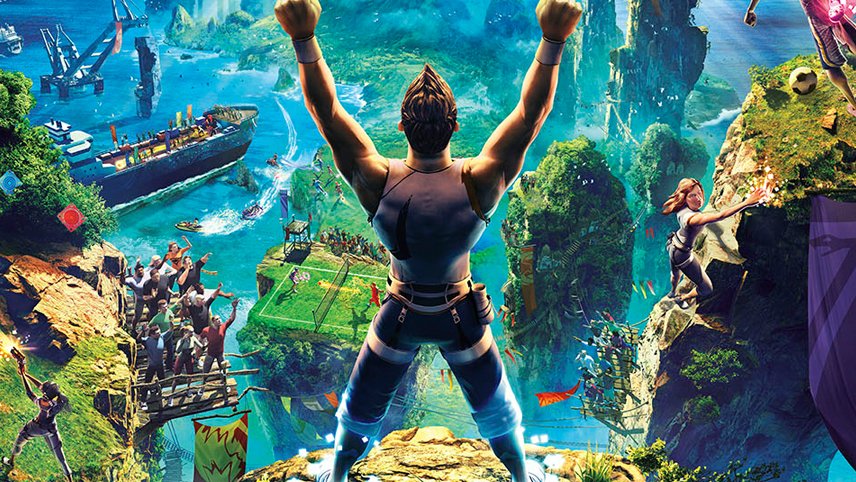
This article is part of a series that captures game industry experts' opinions on game titles and mechanics that might boost habits, mindsets, and skills that empower teens to thrive. These insights arose from discussions at an iThrive Games-sponsored think tank with game developers and scholars.
Teens are wired to venture out, take risks, and discover who they are in the world during what should be an exhilarating time of life. So it's troubling that so many teens report mostly feeling bored, stressed, and tired at school, and excited less than 5% of the time. Developmental psychologist Diana Divecha told us that teens can get disconnected from their natural enthusiasm for life outside of school, too, when they experience too much stress or family conflict or have too many energy-draining activities scheduled in their day. Teens need time to reset, rebuild their energy, and explore the things they're enthusiastic about on their own terms. And since teens' brains are incredibly plastic, the teen years are an important time to cultivate and protect their zest for life.
What exactly is zest? Zest is sometimes described as vitality or "feeling alive." It means embracing experiences or life in general with positivity, enthusiasm, and energy, and it looks different in different kinds of people. For instance, an extravert might show zest by energizing others to join a cause, and an introvert might show zest by exploring a personal passion in a quiet, reflective way. But however it manifests for any one person, studies have found that teens who report higher levels of zest also report greater satisfaction with life, fewer symptoms of anxiety and depression, and greater feelings of self-efficacy, meaning they believe they are in charge of and capable in their own lives.
There are many ways to support zest. Practicing healthy habits like exercise, healthy eating, mindfulness, and getting enough sleep are important for good physical energy. People can also support zest when they savor life's good experiences, practice optimism and gratitude, and maintain good social relationships. And video games are another tool that might empower teens to reconnect with the enthusiasm and energy that they don't often feel in school (and to engage in other habits we mentioned, like exercise and social connection. More on that below). We talked to game developers and scholars about how exactly this might work. Besides the fact that video games are a ton of fun, what specific features and mechanics can support teens in tapping into their energized enthusiasm?
VIDEO GAMES MIGHT SUPPORT ZEST WHEN THEY:
- Feature whimsy, humor, lightheartedness, and joy. Video games that use bright colors, upbeat music, and funny dialogue and characters can contribute to a high-energy, positive mood. Pikmin (10+ years) and Zoombinis (8+ years) feature cute, whimsical characters and entertaining sound effects. Grim Fandango (13+ years) and Monkey Island (12+ years) are silly and playful with over-the-top memorable characters, quirky art styles, and funny circumstances that inspire happy, energized feelings.
- Let players take risks and be daring in a safe environment. In the Assassin's Creed (18+ years) and Infamous (16+ years) series, players feel the thrill of doing parkour without the physical risk. In Tony Hawk's Pro Skater HD (13+ years), players can dare to try awesome skateboarding tricks without getting hurt. Just be sure teens are realistic about how risky these activities can be in the real world.
- Allow innovation and exploration. Goat Simulator (11+ years with certain settings) and Octodad: Dadliest Catch (10+ years) both have an absurdly silly premise. They allow the player to be able to do almost anything and to see their experimentation pay off in unexpected and hilarious ways. Minecraft (8+ years) gets players fully absorbed in building anything they can imagine within a gigantic open world that features soothing music and vibrant colors.
- Encourage a sense of exhilaration and adventure. The Elder Scrolls V: Skyrim (18+ years) and Uncharted series (14-15+ years) inspire a sense of adventure, allowing players to explore lavish, beautiful environments and to uncover stories of intrigue. Classic adventure games like Myst (13+ years) and Monkey Island (12+ years) intrigue players with fun puzzles.
- Require real-world motion. Sports and fitness games like Wii Sports Resort (8+ years) and Kinect Sports Rivals (10+ years) and rhythm and dance games like the Dance Dance Revolution series (6-13+ years) give players a chance to move and groove, which helps boost energy levels and may even help teens meet physical activity guidelines. Since not everyone is physically able to play these games, simulating high-energy movement in games can also be exhilarating. Endless runners like Temple Run (9+ years), Sonic Dash (6+ years) and Jetpack Joyride (13+ years) have colorful visuals, catchy, upbeat music, and constant motion to keep energy levels high.
- Let players make social connections and fun memories. Party games like Charades or The Metagame (14+ years) have players interact with, perform for, and play off of each other in fun, creative, sometimes physical, and often silly ways.
- Give players a chance to contribute to a meaningful cause. Some players might be really motivated and energized by real-world positive outcomes of their gameplay. Check out our post on purpose in games like Sea Hero Quest (E for Everyone) and Foldit (all ages) for more.
- Keep players engaged right to the end. "Completionists" show their zest through their dedication to exploring, doing, and collecting everything possible inside a favorite game. Open-world games like Elder Scrolls V: Skyrim (18+ years) can inspire this, and so can games like Pokémon Go (13+ years) with their emphasis on creature collection ("Gotta catch 'em all!").
When have games helped you to feel zest, enthusiasm, and energy? What games or mechanics have we missed? Share with us!
Brie Code: Cultivating "Tru Luv" for Video Games
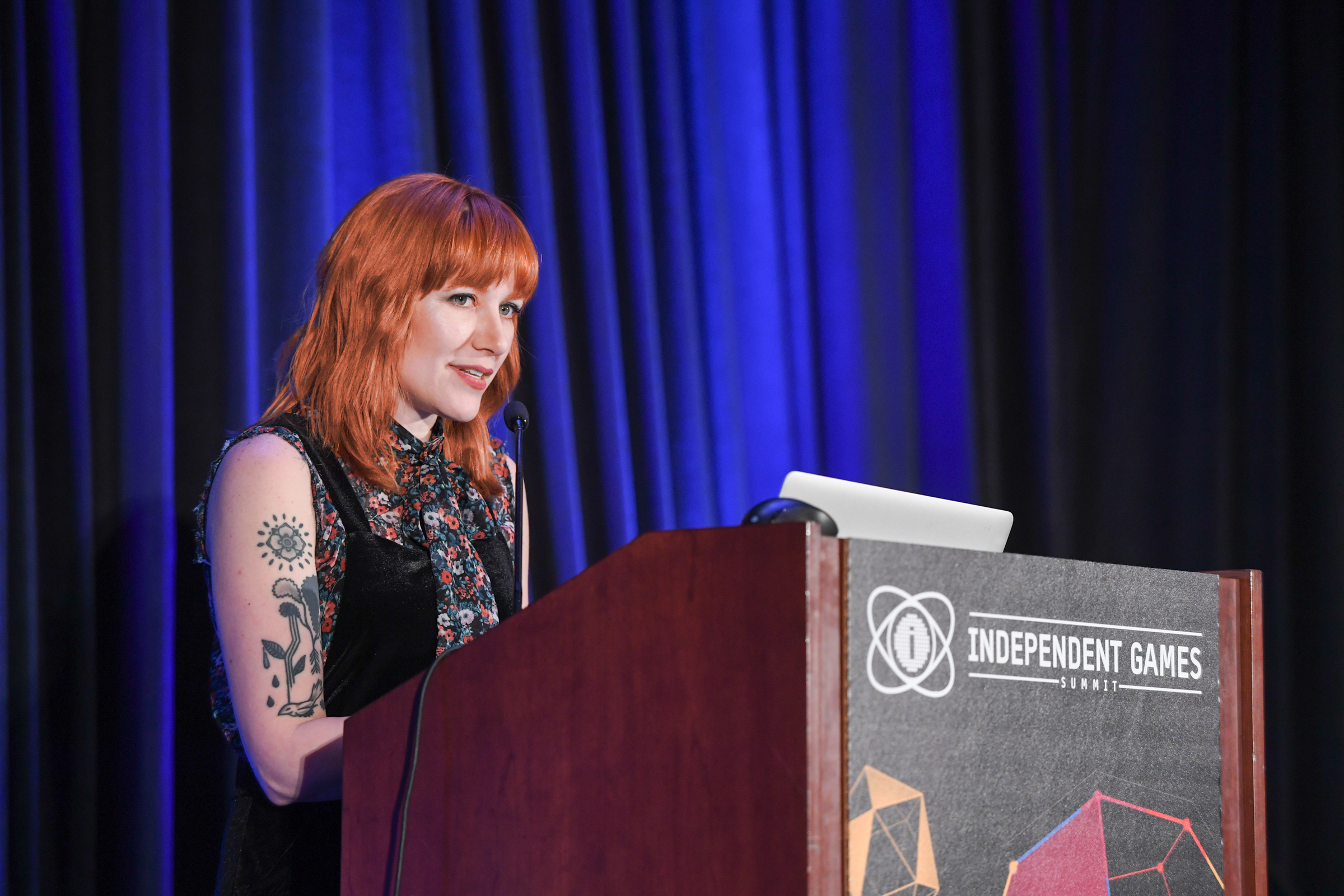
"Most people who follow me seem to be playing video games more for what they wish they were than what they are. We all tend to agree that games as a medium has so much, so much potential and that we are just beginning to explore what that potential is." - Brie Code
When indie game developer Brie Code—author of the fantastic "Video Games Are Boring"—joined iThrive Games for our February design hive, we were inspired by the depth and openness of her thinking, her cool, calm demeanor, her adventurous travel style, her awesome tattoos, and the fact that she makes games with people who don't like games. We were so intrigued—what inspires her to do this, and what disservice are developers doing when they make games only with people who already love them in mind? How can developers cast a larger net and make new converts of people who haven't yet experienced the transformative potential of games? Brie generously provided some insights into the workings and philosophy of her new studio, Tru Luv Media, and what games have meant for her personal learning and growth.
MB: You founded Tru Luv Media to make video games with and for people who don't like video games. What inspired you to take this on? Why is it important to you to reveal the power of video games to this audience?
BC: All my life I've had friends who don't like video games. We share the same tastes in music, film, art, even food. My friend Kristina, for example. We like all the same things except video games. But then three years ago her husband's brother gave her his old PlayStation 3 and she asked me if there was anything she should play. I was thrilled, and I recommended the game Journey. It turns out she didn't like it as much as I thought she might, but it did intrigue her enough to try a few more games.
At some point, I recommended my favourite game, Skyrim. She looked it up online and laughed and said she wasn't interested. She doesn't like medieval fantasy and she doesn't like violence. A few weeks passed. And then one evening she phoned me and she was crying because she had accidentally killed one of the characters in Skyrim, Lydia. She had been playing Skyrim obsessively over those few weeks. She said to me that for all these years, it wasn't that she didn't like video games, it was that she didn't know what video games could be. She didn't know they could be about creating a version of yourself in a world full of characters you care about and who care about you. I hadn't realized that she didn't know.
At first, this delighted me because I realized I could share the thing I love with the people I love. But then it made me angry because I realized that I had had this great resource throughout my life for stress management and for learning about myself, and Kristina and my other friends had not had this resource. Not because they don't like games, but because we don't make games that welcome them. So I decided to make my own studio to make video games for my friends who don't like video games.
Then I took it a step further and decided that not only would I make video games for my friends, but I would make them with my friends. Each game is co-designed with someone from a different creative field who doesn't like video games.
MB: What's your process for finding and working with this non-player audience? How diverse is it in terms of age, gender, background, etc.?
BC: For the first few concepts my studio is working on, I've asked the six most interesting people I know from outside the games industry. This is a diverse group in some ways: women and men, different ages, different nationalities and backgrounds. Different interests. But since each of them is a friend of mine they aren't as diverse as I would like. As I grow my studio over time I plan to collaborate with a wider range of creators from all backgrounds.
MB: How have video games, or one in particular, changed your life? What is it about the power of video games that you most want to share with those who don't play them regularly?
BC: Play is how we naturally learn. Video games offer a variety of learning experiences from concrete skills in games such as DuoLingo (which is totally a game) to more abstract personal growth in games such as Skyrim. I've used video games at key stressful moments of my life to experiment with my identity and imagine a better future for myself and what steps I would need to take to get there.
The first game that gave me this opportunity was The Colonel's Bequest, an adventure game made by Roberta Williams in the late '80s. I had this game when I was 9 years old. I had been living with a few different families over the preceding years and had recently been separated from my sister. The main character in The Colonel's Bequest was an inquisitive university student named Laura Bow. Getting to play as Laura Bow and explore an old house and learn about the characters in the house gave me a meditative activity to help me cope with my tumultuous life. It also helped me begin to understand myself and my unique talents and values and needs and what kind of future I wanted when I was older. It gave me hope of what my life could be one day when I went to university. I ended up gaming the system at my high school to figure out how to skip 11th grade to get to university earlier.
I graduated from university when I was 20 and I wasn't ready for adult life yet. I didn't start my career right away. I wasn't sure what career I wanted. I kept my student job and saved up and went traveling to find answers. But in the end I didn't find my answers while traveling, I found them while playing Morrowind. Just like The Colonel's Bequest, Morrowind helped me cope with the changes in my life. It was meditative, and it gave me a place to experiment with and discover more about my identity and how I wanted to relate with people and how I wanted to move through the world. I realized over this time that I needed to find a creative, pro-social way to use my computer science degree. I wanted to work with creative people and I wanted to help the world in some way. And then I started my career in the video game industry.
MB: What have you found to be the primary elements that make existing video games unappealing to non-players?
BC: I think there are two levels on which existing video games are unappealing to many people. The first is that video games can range from quite aggressively off-putting to just simply unwelcoming. They rely on offensive stereotypes, they mainly reference geek culture and not more mainstream culture, and they assume the player understands certain conventions from how the controls work to how the game mechanics work. The second is that video games don't offer deep, meaningful experiences to all people. They are often designed around the fight-or-flight response to stress: They are designed to keep the player in a flow state by keeping the player slightly frustrated. But not all people have the fight-or-flight response to stress and are looking for other rewards from the media they consume. They may want to experiment with their identity, to take care, to connect with characters or other players, and to understand the world more.
MB: What has surprised you most about the reception to Tru Luv Media's mission, both among other game developers and players?
BC: What has surprised me most is how unreceptive some people who love games are to the idea that other people might love something different. Not everyone has to like the same thing.
MB: What overlap have you seen between meaningful in-game experiences for people who consider themselves gamers and those who don't play video games much or at all?
BC: The overlap I see in terms of product design. A good product solves a problem in people's lives. Life is hard and I think most people turn to entertainment to help them cope and to help them navigate their lives. Games can offer a safe space in which to relax and to learn. Games could offer this safe space to anyone, if we made the right games.
What differs on top of the need to relax and to learn is the different ways that people relax or the different aspects of themselves that they feel good developing.
MB: Your team is currently developing a video game about self-care. What inspired that game? What are some of its essential mechanics, and how were they chosen?
BC: #SelfCare is the first game we'll release. The concept was created by Eve Thomas, a magazine editor and artist in Montreal. When Eve first noticed the rising trend of self-care being discussed more and more on Tumblr and Instagram, it disturbed her. She didn't like that people seemed to need an excuse to take care of themselves, to make their own health a priority. But then she realized that people did need an excuse for this, and she wanted to make a game to help people take that space for themselves.
It's a mobile game about a character who has stayed in bed for the day. Their bedroom has different activities they can do for self-care. While the character practices self-care, so do you.
After we designed the activities, I read a book about post-traumatic stress disorder treatment and discovered that each activity we designed corresponded to one of the treatments in the book. We did that intuitively, partly based on how I've used games to process traumatic periods of my life. I found this discovery fascinating.
MB: You've mentioned that you're interested in how video games can support post-traumatic growth. Can you tell me more about what that looks like, and how it has worked for you personally?
BC: A few years ago as we were in the final crunch finishing Child of Light I was diagnosed with cancer. My mother had died of cancer at the same age I was at the time, and a very good friend of mine had died of cancer at the same age just a few months before I was diagnosed. As a systems programmer I have an overdeveloped sense of pattern recognition and so I couldn't help myself—I had this creeping fear that I was next. I went into surgery the morning that the reviews of Child of Light came out. It turned out that the tumour was very early stage and very slow growing and very easy to remove. I was extremely fortunate to have found it so early, and I still feel a bit guilty for my experience with cancer being so breezy and lucky. In the months following, I retreated into video games again to process the whole experience.
Over that time, everything became crystal clear in my life. Until this period of introspection, I had been taking opportunities as they came up in my life based on where I seemed to be needed in the moment. I didn't have any larger purpose. But during this time, I had some strong realizations about how I used video games differently than the developers I worked with, and about how my friends who don't like video games seemed to want the same things out of video games that I did. We wanted video games about identity, care, and characters. I developed a strong sense of purpose around the idea of making these games and mentoring young people who wanted to make these kinds of games. I reorganized my priorities and my life completely around this purpose. I quit my job, traveled for a year to meet young developers around the world, and founded my studio.
A big inspiration to me was Jane McGonigal's TED talk about her game SuperBetter. She talks about how video games can help build the resilience that leads to post-traumatic growth. It really resonated with me, especially during this time.
MB: We've followed you on Facebook and you ask the best questions! (Eg: "When are you most likely to play video games? In what emotional state?" and "How do you feel after you play video games?") What are some of the most striking insights you've gotten from your Facebook network about the feelings and motivations that surround playing video games?
BC: Thank you! I reach out to my network whenever I am grappling to understand something, usually when I am working on a new article or a new talk, or trying to make a design decision in my game. To me, the most striking thing is that most people who follow me seem to be playing video games more for what they wish they were than what they are. We all tend to agree that games as a medium has so much, so much potential and that we are just beginning to explore what that potential is.
MB: What inspires you to create a new video game, and what's your design process?
BC: When I work with someone to create a game concept with them, we start with a problem in the person's life. What is something that is bothering them, or that they wish they could change? This could be about themselves, about the world, about anything.
From that problem, we begin brainstorming the purpose, the message of the game. We start general and work towards specifics: We build on the purpose to identify a style and a set of systems and mechanics that would support that message. Story and characters appear on top of that. But this can vary based on what type of thinker the creator is. I try to adapt the process so if someone thinks more in stories we start with story and extract the message from there and then build the rest. If someone thinks more in visuals than we start with art direction and extract the message from there and then build the rest, etc.
As soon as we have any sort of rough idea of where we are going, we develop a prototype. I bring the prototype to the creator and we see how they interact with it. From there we bounce around some more ideas and try some changes in the prototype. And we continue like that. We test each new idea against the purpose of the game so that the game stays consistent and true.
MB: What tips would you give other game developers who want to make video games that speak meaningfully to a broad range of people, including those who don't regularly play?
BC: The most important tip is to talk to your target audience early and often. Immerse yourself in their culture and invite them into your design process. Test your concepts early and often. Prototype early and often. And be very open-minded. Pay attention to their subtle cues when they seem uncomfortable with some aspect of the game or seem intrigued by some aspect of the game. When discussing ideas, gently ask yourself and your target audience "why" many times a row to get at the underlying purpose and meaning in the discussion. For example: "I like this colour palette." "Why?" "Because...." "Why?" etc.
If the game is built around a purpose and a message that truly resonates with some people then it is worth making and has a chance of resonating with a broad range of people. This is true especially if no other game has yet truly addressed your unique purpose.
MB: Thank you for your time and insights!
For more gems, follow Tru Luv Media on Facebook and @briecode and @truluvmedia on Twitter.
Purpose in Games: Empowering Teens To Explore Who They Are

This article is part of a series that captures game industry experts' opinions on game titles and mechanics that might boost habits, mindsets, and skills that empower teens to thrive. These insights arose from discussions at an iThrive Games-sponsored think tank with game developers and scholars.
Only about twenty percent of high school-aged teens already know what they want and where they're going in life, and that's probably just as it should be. Adolescence isn't about nailing down a life course. It's about searching for one. In the words of developmental psychologist Diana Divecha, "Teens, especially 11-15, need room to explore and pursue their temporary interests, whatever they might be." And teens who are actively engaged in an authentic exploration of their purpose experience more well-being and hope than their less purpose-oriented peers.
Unfortunately, it's no secret that typical high schools have a long way to go towards prioritizing students' free, trial-and-error process of self-discovery. Patrick Cook-Deegan, who leads an initiative to create "purpose-provoking" experiences for teens, laments, "Our current model of high school rewards perfection and discourages risk taking,...students are either rewarded for being perfectionists or shamed for failing." Given this high-stress, high-stakes approach, where can teens turn to engage in the critical process of exploring their purpose in a low-risk, supportive environment?
The rich experiential learning opportunities video games provide can offer teens meaningful experiences with the potential to shift their perspectives, attitudes, and knowledge about their own interests and capabilities and may open their eyes to needs and possibilities that exist in the world that they weren't aware of before. Together with expert game developers and scholars, we brainstormed some of the ways video games might serve as one of many settings where teens can take the lead on building self-awareness about who they are and what they might eventually want to accomplish. Games might support teens' path to purpose by:
- Prompting self-discovery. Games of all types support self-directed exploration in an environment where risk and failure are just a fun part of the journey. Games offer the agency and low-risk experimentation that teens rarely get in traditional learning environments but sorely need to discover who they want to be. Intriguing open-world sandbox games like Minecraft and The Sims inspire teens to set their own goals and explore what interests them most. What are they most drawn to doing when the options are nearly limitless? Role-playing games let teens explore the skills, traits, and mindsets of many archetypes (mage, warrior, healer, etc.) and decide what abilities and characteristics are most important to them to hone.
- Modeling purpose through a character's noble quest. The list of beloved, purpose-driven characters in games is a long one. Think Link and Mario's never-ending missions to rescue Zelda and Peach in Legend of Zelda and Super Mario Bros., respectively. (Sure, the damsel-in-distress thing is antiquated, but you've gotta admire their commitment.) Aloy's search to discover her identity and prevent calamity in Horizon Zero Dawn is another mission teens can get behind. The torch-bearing avatar in Road Not Taken conquers increasingly bewildering puzzles to rescue children lost in a storm and reunite them with their families. When teens take part in the hardships their characters endure to save the world, stave off extinction, solve a mystery, rescue someone, or defeat evil, it reinforces the power of a (wo)man on a mission and shows how not to give up on a cherished goal.
- Connecting teens with "something bigger." Feelings of awe can inspire purpose by showing teens that they are part of something larger than themselves, counteracting feelings of meaninglessness. Games are a powerfully immersive way to remind teens that they exist in an interconnected web within an amazing world and that their action (or inaction) has important consequences for that world. Eco makes tangible teens' place within and impact on Earth's fragile ecosystem. Abzu sparks awe by depicting in beautiful depth and color the amazing wonders worth protecting under the ocean's surface, and lets teens restore health and beauty to neglected areas. Kerbal Space Program sparks awe and curiosity about the vastness of space and encourages teens to expand their minds and skills in order to travel there.
- Sparking epic cooperative efforts. Video games help demonstrate what can be accomplished when many hearts, minds, and fine motor skills unite. Gameplay in the service of a noble purpose can do authentic good for the world: it can literally help scientists progress towards curing diseases like HIV/AIDS, cancer, and Alzheimer's. Foldit asks everyday people to put their puzzle-solving abilities to work in the service of discovering all the myriad ways proteins can fold, a key to understanding disease processes and therapies, and something computers still can't do quickly enough. Sea Hero Quest, a charming mobile navigation game for all ages, has already helped scientists collect many decades worth of data on spatial navigation skills across the lifespan to inform the diagnosis and treatment of dementia. By playing and (optionally) sharing anonymous data with the scientists, teens can play a key role in advancing the process of curing a devastating disease.
Teens stand to gain important insights about their interests and skills and to learn more about what's possible to do in the world through rich gameplay experiences, perhaps especially when gameplay is designed with that purpose (pun intended) in mind. How else can developers make games to deliberately encourage teens to think about their purpose, explore their strengths, and reflect on the tenacity and effort it takes to make progress on their chosen path? What games have we missed here? Let us know in the comments!
***
VIDEO GAMES THAT MIGHT INSPIRE PURPOSE:
- Abzu (10+ years): Dive below the ocean's surface, exploring awesome underwater ruins and observing deep-sea creatures as you work to restore neglected areas.
- Eco (all ages): Work collaboratively with others to save the world from an impending meteor strike by building new technologies, but don't ruin the environment in the process.
- Foldit (all ages): Solve 3D protein-folding puzzles that help scientists test potential therapies.
- Horizon Zero Dawn (13+ years): Lead warrior huntress Aloy on her quest to discover where she came from and what destroyed the civilization that came before her in this visually stunning role-playing game.
- Kerbal Space Program (8+ years): A rocket-building sim that lets you launch missions to "the Mun" and other destinations in the Kerbal universe using real rocket science principles.
- Legend of Zelda series (8+-12+ years): Solve a series of clever puzzles on the way to banishing villains and rescuing Zelda in this classic action-adventure role-playing game.
- Minecraft (8+ years): Move through a virtual "sandbox" with nearly endless possibilities for what you can create from the resources you gather.
- Road Not Taken (10+ years): Solve tricky puzzles to rescue children who were lost in a blizzard and reunite them with their families.
- Sea Hero Quest (E for Everyone): Steer your boat through magical seas to find unique creatures in this mobile game that gives scientists real spatial navigation data they can use to understand and treat dementia.
- Super Mario Bros. (6-10+ years): What wouldn't Mario do to save Peach? Fight the bad guys, conquer Bowser, and save the princess in the many manifestations of the Mario universe.
- The Sims series (12-16+ years): Choose your ultimate aspiration and help your Sim achieve it in this life simulation where almost anything is possible.
John Krajewski, "Eco" Developer, On Play that Saves the World
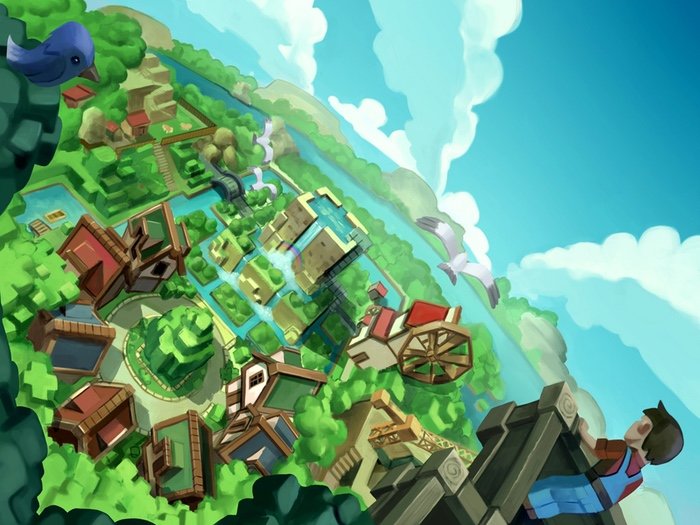
It's almost Earth Day, folks. To celebrate, get out there and hug a tree, join your local March for Science, then settle in and play Eco, Strange Loop Games' award-winning online, multiplayer survival sim.
Eco calls on players to work together on a shared server to tackle only the most pressing dilemma of our era: How do we save the world...from ourselves? Players work within a simulated ecosystem to develop the technology to prevent a catastrophic meteor strike without dismantling that ecosystem in the process. Players collect natural resources to build things and drive an economy, analyze data to make projections (At this hunting rate, when will the elk go extinct?), and work together to enact laws to protect vulnerable populations.
Eco brings the consequences of resource mismanagement into sharp relief, especially for those of us who haven't (yet) experienced them in drastic ways in the real world. Eco players have to confront the conflict between individual wants and collective needs (Isn't my mansion awesome? Oh, wait, where'd all the trees go?). This design encourages a mindset oriented towards the common good. Case in point: When considering how much to "charge" other players to use his in-game crafting table, Eco game reviewer The 8-Bit Ninja sets a generous rate, musing, "Everybody should have access to crafting. That's, like, a basic human right." Well said.
So, how does John Krajewski, founding CEO of Eco studio Strange Loop Games, approach designing a game that relies so much on players' self-awareness, cooperation, and empathy? He was kind enough to share some gems based on his experience developing this fantastic multiplayer sim.
MB: People sometimes describe Eco as a game about saving the environment. You've said that Eco is actually, first, about creating a civilization and, second, about the wise use of natural resources. Can you talk about why you took that approach?
JK: I believe it's more powerful as a secondary goal. You give this player a rich system where they have things they want to do unrelated to "saving the environment," but through pursuing those goals they begin to see the importance of the ecosystem and the world around them. Letting players realize that, rather than beating them over the head with the message, is much more powerful. The game is still in early stages, but it's great to see discussions among players about what should be allowed in the world, and all the different opinions that people weigh in with. They're really looking at the wider view and working to understand other people's perspectives. Debating your point with other players with vastly different specialties and immediate goals is challenging and a key aspect of the game.
MB: In terms of a game design approach, what's the difference between requiring cooperation and creating a world in which players want to cooperate? How does Eco encourage authentic cooperation?
JK: In Eco there's nothing forcing you to cooperate, but you'll be a lot more effective if you do. It's rewarding both in gameplay terms and personal terms. We allow a big range of cooperation in the game, from asynchronous interactions in the economy (buying at your store) to sharing property and building together. Since the game is all about social institutions, the relationships you form and how you interact with other players is a key mechanic to the game.
MB: What role does a player's social intelligence play in a "social sim" like Eco?
JK: With the game focused on social institutions like governments and economies, social intelligence becomes a huge advantage. It's all real people you're dealing with in Eco, trying to hash out the best way forward based on simulation data and the history of events in the game. This is a mechanic that's a great fit for many games, giving players responsibility for a world and challenging them to solve problems that require consensus (in a world where players naturally have very different viewpoints and goals). Our goal is to use this similar structure for many subjects, building on the Eco engine.
MB: Was one goal for Eco to help players feel empathy for the needs of other species? If so, what are some specific design choices that you used to trigger empathy?
JK: Yes, you're existing in their world, in a natural, beautiful place that they thrive in. You need to take from that environment to survive and succeed, but you can easily kill off that beauty if you're not conscious of what you're doing. There's an instant connection when something is vulnerable, you're connected to it and take on responsibility for it.
MB: How might playing Eco in middle school (where it's been embedded into classroom instruction) impact players' longer-term environmental awareness?
JK: When you're growing up, your world can seem a lot smaller than it really is. The concept of something that happens on such a vast scale of space and time as climate change is nearly impossible to imagine when you have this tiny vision into the world that you barely recognize is tiny. Our goal with Eco as a game is to shrink down that vastness of time and space, let them experience in the game world, among their peers, over the course of 30 days, an analogy to what happens in our massive world, among billions, over hundreds of years. It gives you a view and experience that you don't get otherwise, but is very relevant to the challenges we face now. Widening a person's viewpoint at that age is especially powerful.
MB: What are the most important things for game developers to consider when creating fun games that also encourage critical skill-building for teens (and adults!), like cooperation, empathy, and social awareness?
JK: It's important to think about the kind of social landscape you're building. What are the types of interactions that will take place in the world you've designed? How do you keep those positive and/or challenging? What are the hidden incentives of your structures? It's surprisingly easy to incentivize the opposite of what you intend. Multiplayer is so key to these skills as well, and so much more powerful than simulated interactions. With games so ubiquitous, there's lots of opportunity for connecting real players.
MB: Do you feel that in Eco you succeeded in making a game that does entertainment and education equally well? What advice would you give other game developers who have this goal?
JK: We've got a good start! With a successful Kickstarter and strong Early Access sales on our website, we're confident it will continue to do well in the entertainment market. My advice for games that merge education and entertainment is you really have to have a love and appreciation for the subject first, and see the beauty of it. If you approach it from the angle of, "We'll trick them into doing this classwork by wrapping points and leaderboard and gameplay elements around it," you're not going to create anything useful. Respect the medium of games, understand how fundamentally different (and I would argue more powerful) it is compared to traditional schoolwork, and integrate the learning deeply into the game. Whatever you're learning in a game shouldn't be the obstacle you need to get past to succeed. It should be what lets you succeed. The education subject should be your sword, not your boss monster. (Author note: is John quotable, or what?!)
MB: What's the best way for teens (and people of any age) to access and play Eco now?
JK: You can join our alpha build now at strangeloopgames.com/eco. We also have dev tier packs where we share the source code with players.
MB: Thank you, John!
JK: My pleasure!
Hear more from John on how Eco helps players feel meaningfully connected to the beautiful world his team created:
Doris Rusch, Deep Games Developer, Talks Designing for Empathy
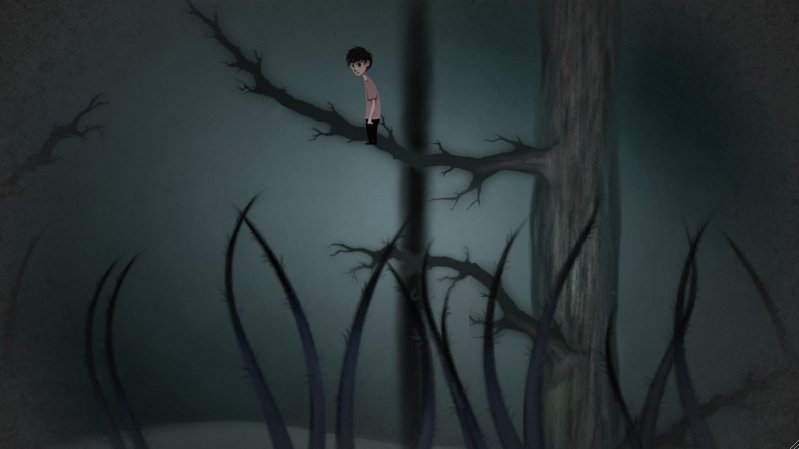
"I firmly believe that everything can be made relatable. We are all, after all, humans. Our experiences may vary (sometimes A LOT), but we all carry everything within us. We just need some ways of accessing this deep, dormant understanding of the whole range of the human condition." - Doris Rusch
One moment I was bounding from one branch to the next, scaling a giant tree, weightless as the birds chirping nearby. Suddenly, barbed vines emerged from below and dragged me deep underground, where I sank helplessly through layers of quicksand. No measure of will or button mashing could stop it. This is the essence of playing Doris Rusch's Elude, a hauntingly beautiful online game intended to help players relate to the lived experience of depression. (It takes 5 minutes to play. Go ahead! I'll wait.)
As a believer in the power of games to build empathy for difficult experiences, I was eager to hear about Doris's process. What motivates her to design for empathy, and does it work? I "sat down" with Doris (over email) to get a download from her brilliant brain. (Note: I could never fit all that brilliance into even the thickest volume. This interview has been edited for length.)
| MB: How and why did you get involved in designing Elude?
DR: Three factors converged to inspire Elude. I had just presented a game on substance abuse (Akrasia) at the Games 4 Health conference in Boston. A child psychiatrist (Atilla Ceranoglu) was in the audience. He approached me afterward and said, "That's cool, let's make a game together!" I was going through a rough time myself and an acquaintance had recently committed suicide (a suicide he had announced on Facebook). All of this happened at the same time and so it seemed obvious to make a game that helped communicate to friends and relatives of people with depression what it's like to help fight stigma and promote support. MB: Is the game successful at helping players to empathize with someone who's depressed, and how do you know? DR: We tested the game a lot when we developed it, making sure we got it in front of friends and relatives of people with depression. Afterwards, it was picked up by many self-help blogs where friends and relatives could access it. I still receive emails from people from all over the world (including Thailand, Singapore, Europe and the U.S.) who played the game and want to share their experiences. It has also been used in nursing education by Barb Harris at DePaul University. My evidence is anecdotal but based on a wide player base. What I heard consistently from players who don't suffer from depression themselves was, "I felt like I didn't have a choice. All of a sudden, when those vines came after me and dragged me down, I was helpless. I couldn't do anything!" They say this with a realization that depression is not a character weakness. The loss of agency is very real. Often, friends and relatives of people with depression experience tremendous anger and frustration that their loved ones can't "pull themselves together." Understanding that it doesn't feel like that's an option is key to a better dialogue and more empathic relationship. MB: What's unique about trying to understand depression by playing Elude, as opposed to, for example, reading about someone's personal experience with the condition? DR: Elude uses games' capacity for embodied learning. Players submit to the rules of the gameworld, which model the inner landscape of someone with depression. "What it feels like" becomes the law in this world, as real as gravity. As the player, it is your happiness that is now constrained, your agency. Sinking deeper and deeper into the quicksand of despair is your reality. That's what other media cannot portray. Elude creates this sensation by first modeling happiness, letting the player soar higher and higher through a sunny sky using leaves and flower petals as footholds. Then it slows and drags the player down through the tree canopy and into the darkness, modeling the loss of capacity for happiness in a tangible way. And there is no way to just "try harder" to break out of this stuck place because the rules of the game—following the lived reality of depression—don't permit it. I came to feel that the game should focus on this part of the experience, and not on the healing part. I wanted people who don't necessarily "get" depression to just sit with it for 5 minutes and allow it to be. People often want to "fix" the person with depression, but that devalues their experience and underscores that "something's wrong with you," so wrong that we can't even talk about it. Sometimes, being able to talk about it, accepting it the way it is, is crucial to establish a dialogue and relationship that is productive for change. That's why Elude focuses on conveying what it's like without offering a solution. MB: What is your process for designing a game meant to inspire empathy in the player? DR: I first need to understand deeply the reality that the game should model. I do a lot of background research. For Elude, I drew on my own experiences with depression but also did a ton of complementary reading to get a broader picture of what it felt like to others. I read William Styron's "Darkness Visible" and Julia Kristeva's "Black Sun." It was not a happy year! I also dug through a lot of clinical literature provided by Atilla Ceranoglu and we discussed his expert perspective on the issue. I had in-depth conversations with people who'd experienced depression, my subject matter experts (SMEs). I looked for metaphors in the language they used because our inner worlds are abstract and we often draw on metaphor to make them concrete. Sometimes, I co-design with SMEs. We might make every design decision together, or I might derive a preliminary metaphor/rule system from SMEs' reports, prototype a game, and then let my SMEs play it and give feedback, on which I iterate. The SMEs' feedback is essential but not the only factor in the design process. If the goal is for the game to convey to people without lived experience "what it's like," I also playtest with those people. They need to get it. If the experience the game models is too idiosyncratic, the metaphor too obscure, I have to find a way—with the SME—to make it more relatable. I firmly believe that everything can be made relatable. We are all, after all, humans. Our experiences may vary (sometimes A LOT), but we all carry everything within us. We just need some ways of accessing this deep, dormant understanding of the whole range of the human condition. MB: When your goal for a game is to inspire empathy, how does that affect your design choices? I'm especially curious about the decisions around the main character, who appears to be a teenage boy. DR: We could have just as well designed the main character to be a teenage girl and if we had had the time, we would have done both and let players choose. But we thought: it's a game. Teenagers play games. Teenagers often struggle with depression. So, if we make a game, our target audience is probably friends and relatives of teenage boys with depression who play games and use them to self-express, relate, explore. It made sense for the topic and the audience. We thought parents might be able to see their child in the character and other players might be able to see themselves. But yes, having a female version would have been good, too. MB: What else do players need to do or know outside of this game to enhance their empathy for someone with depression? Why is the game alone not enough? DR: The game is a good starting point, but its purpose is to foster dialogue. Nothing beats real, human interaction. Often this interaction needs a little nudge. We hope Elude can be this nudge by offering a shared experience that can then get people talking about it. The game can also help those with depression to "feel felt." I heard this often from players who have firsthand experience with depression. They know the designer gets it. Someone gets it. They are not alone. But then this needs to spread to their friends and family and possibly even strangers. MB: Why should game developers design for empathy, and how can they do it better? DR: Games are great media to enable embodied experiences because players learn through consequences of their actions and can experience inner worlds by submitting to their realities. It's extremely powerful to see life through someone else's eyes (at least salient aspects of it and for the time of the game). But it all starts with listening, with being truly open to the experience the game aims to convey. It is easy to project and assume, and when you do that, what the game depicts has little to do with "what it's like" for the single mother, the refugee, the person with an eating disorder, or the teenager who thinks she's just no good at math because math is not for girls. Design approaches should be participatory, including people with the actual, lived experience as experts. To design for empathy, you need to have empathy yourself first. You need to make room for the reality of others and make it your job to understand it as fully as possible. It's a great "no-ego" exercise. And this leaks into other areas of life, too. Making a lot of empathy games is a powerful way to adopt empathy as a permanent mindset. I think creating empathy games so more people can play them and learn something from them is important, but it would be just as important for people to learn how to design empathy games themselves. |
For more about Doris Rusch, check out her Play for Change lab, pick up a copy of her book on designing deep games, and don't miss her TEDx talk on April 18th, 2017!
Video Games: A Safe Place to Wonder

"Games are driven by a curiosity over what's in the next level, what's in the next chest, or who the next boss will be." - Mark Filipowich
EDITOR'S NOTE: This article is part of a series that captures game industry experts' opinions on game titles and mechanics that might boost players' positive habits, mindsets, and skills. These insights arose from discussions at iThrive-sponsored think tanks with game developers and scholars.
Without a desire to explore our world, how could we learn? In fact, how could we have survived at all if our ancestors had not ventured into new territory to find food or experimented with ways to start a fire? They had to control their fear of the unknown in order to get the big payoff of expanded knowledge and resources. And in order to overcome fear, something powerful had to motivate them—something like curiosity.
THE POWER OF CURIOSITY.
Curiosity is so rewarding to the brain that it activates the same circuits as sugar. But it is better than sugar, because curiosity helps us learn. When we are curious, we pay closer attention. We think about information more deeply and remember it better. Plus, curiosity gives us a dose of feel-good dopamine, making it a reward in itself. Curious teens report feeling greater life satisfaction, positive emotion, purpose, and hope than their less curious peers.
Generally speaking, people are naturally curious. But fear can get in the way of exploring novelty because, well, the unknown is risky. Venturing outside of our comfort zone can result in failure, or worse. For example, some scholars have argued that traditional education in subjects like science can actually shut down kids' curiosity when it focuses too much on getting the right answer and avoiding mistakes.
"Teens need self-directed opportunities to express their curiosity and explore to their imagination's content within safe boundaries." — Diana Divecha, PhD, developmental psychologist
Teens' brains are especially sensitive to rewards, and they are driven to take risks that broaden their understanding of the world and their ability to navigate it independently. However, the stakes of failure in traditional academic and social settings may hold teens back from fully diving into the trial-and-error process of learning on which curiosity thrives. To engage with new and (for some) intimidating topics like science and technology, or the exploration of personal identity including sexuality, teens can benefit from environments where they feel safe enough to make mistakes and have the freedom to direct their own actions and find personal meaning in the content.
ENTER VIDEO GAMES: A SAFE SPACE FOR CURIOSITY.
Video games are a fantastic playground for curiosity because they are (arguably) a perfect blend of risk, reward, and safety. Players constantly fail but usually stick with it for the promise of great rewards (and often a great story). And when players fail, the stakes are low—they don't lose much beyond a little bit of pride. Because failure is such a natural part of learning to play a game, the process is perhaps less distressing than it might be in "real life." What's more, game developers' skills mixed with technological advances make for virtual worlds that are incredibly intriguing, sometimes purely for their visual splendor and mystery. It's no wonder that teens are drawn to exploring these worlds for hours at a time, testing the limits of what's possible within them.
At iThrive, we are interested in how games can provide a powerful outlet for feelings of curiosity about topics that are constructive, meaningful and relevant to teens' lives and aspirations. We seek out great games that provide opportunities to put curiosity to good use to build skills and learn about the world.
We spent time with expert game developers and scholars to come up with a list of games in diverse genres that are especially promising for channeling teens' curiosity—the strength of seeking out new knowledge and experiences for their own sake, and embracing uncertainty. We share their insights here:
GAMES MIGHT ENCOURAGE CURIOSITY WHEN THEY LET PLAYERS SOLVE A MYSTERY, LIKE IN:
- Her Story (16+ years): More an interactive film than a game, players use a police computer to solve a murder mystery via video clips and searchable transcripts.
- Kentucky Route Zero (10+ years): A point-and-click adventure game/interactive novel "about a secret highway in the caves beneath Kentucky, and the mysterious folks who travel it." - http://kentuckyroutezero.com/
- Nancy Drew series (10+ years): A series of point-and-click mystery adventure games. Players interview characters and search for clues to solve the mystery at hand. Bonus: Depending on which game from the series players choose, they might learn about topics like physics and electricity or become more familiar with other cultures as they play.
- Myst (13+ years): Players explore and examine objects on a mysterious island to reveal secrets about an injustice that they can then help to right.
- Broken Age (13+ years): Players switch between two teenage characters living in very different worlds. They combine objects and explore the world to ultimately discover how the characters' destinies intertwine.
GAMES MIGHT ENCOURAGE CURIOSITY WHEN THEY LET PLAYERS NAVIGATE WORLDS THAT TURN THE LAWS OF PHYSICS AND GRAVITY ON THEIR HEADS, LIKE IN:
- Portal 2 (10+ years): In this spatial puzzle-platformer, players help their robot companion to "find the portal gun, rescue other test subjects, and rebuild the dilapidated facility...Players have to figure out where to shoot portals, how to jump through them, and at what velocity and angle." - www.commonsensemedia.org
- Monument Valley (7+ years): Players experiment with physics and gravity to move a silent princess through a beautiful world of MC Escher-inspired architecture.
- This Is The Only Level series (6+ years): A set of online games where the level stays the same, but the mechanics constantly change. Guide the elephant to the exit...once you figure out the rules!
GAMES MIGHT ENCOURAGE CURIOSITY WHEN THEY LET PLAYERS EXPERIMENT TO CREATE NEW THINGS, LIKE IN:
- Spore (11+ years): An evolution simulation where players create their very own species and guide creatures through 5 stages mirroring real-world evolution: Cell, Creature, Tribe, Civilization, and Space.
- Little Alchemy (8+ years): A simple but delightful online game. Players start with just four elements (air, earth, fire, water) and combine them to create over 500 different objects.
- Minecraft (8+ years): Players move through a virtual sandbox featuring nearly endless possibilities for what they can create from the resources they gather.
GAMES MIGHT ENCOURAGE CURIOSITY WHEN THEY LET PLAYERS DISCOVER THE SECRETS OF FANTASY WORLDS, LIKE IN:
- The Legend of Zelda franchise (8+-12+ years): A classic action-adventure role-playing game with a series of clever puzzles to solve and massive dungeons to explore on the way to banishing villains.
- Dreamfall (18+ years): A mature adventure game that takes place in a future world where the ability to dream is in jeopardy. "An epic adventure across continents, and visit exotic locations in an action-packed and emotional storyline." - www.dreamfall.com
- Dragon Age: Inquisition, (18+ years): An open-world fantasy role-playing game that offers opportunities to explore a massive world and complete quests that interest the player.
- The Elder Scrolls V: Skyrim (18+ years): A fantasy role-playing game with a vast, beautiful world to explore, and countless quests players can opt to take on or ignore. Choices shape who the player becomes.
GAMES MIGHT ENCOURAGE CURIOSITY WHEN THEY LET PLAYERS EXPLORE THE FAR REACHES OF THE "REAL WORLD," WITH SOME TWISTS, LIKE IN:
- 80 Days (13+ years): Players race to make it around the world in 80 days, meeting fellow explorers and learning about 19th-century cities along the way.
- Kerbal Space Program (8+ years): A rocket-building sim that lets players launch missions to "the Mun" and other destinations in the Kerbal universe (similar to our own) using real rocket science principles.
- Abzu (10+ years): Players dive below the ocean's surface, exploring underwater ruins and observing sea creatures as they work to restore neglected areas.
- Pokémon Go (13+ years): An augmented reality game where players explore the real world to catch virtual Pokémon and train them to be strong fighters. The game intrigues players with the shadows of mysterious creatures they haven't yet seen.
GAMES MIGHT ENCOURAGE CURIOSITY WHEN THEY LET PLAYERS EXPERIMENT WITH SOCIAL ROLES, INTERACTIONS, AND IDENTITIES, LIKE IN:
- The Sims 4 (12+ years): This life simulation game lets players fully customize the appearance and personality of their sim and then experiment with interacting with other sims in a variety of kind, mean, and romantic ways.
Video games are a safe and intriguing setting for teens (and all of us!) to let curiosity reign and to freely explore the worlds and topics that interest them as they discover their identity and purpose. Have these or other games let you explore the far reaches of your imagination, or learn about new cultures, places, or eras? What other ways have games let you use or expand your curiosity? Tell us on Twitter at @iThriveGames!
Curiosity Takes Us to the Mun an Beyond
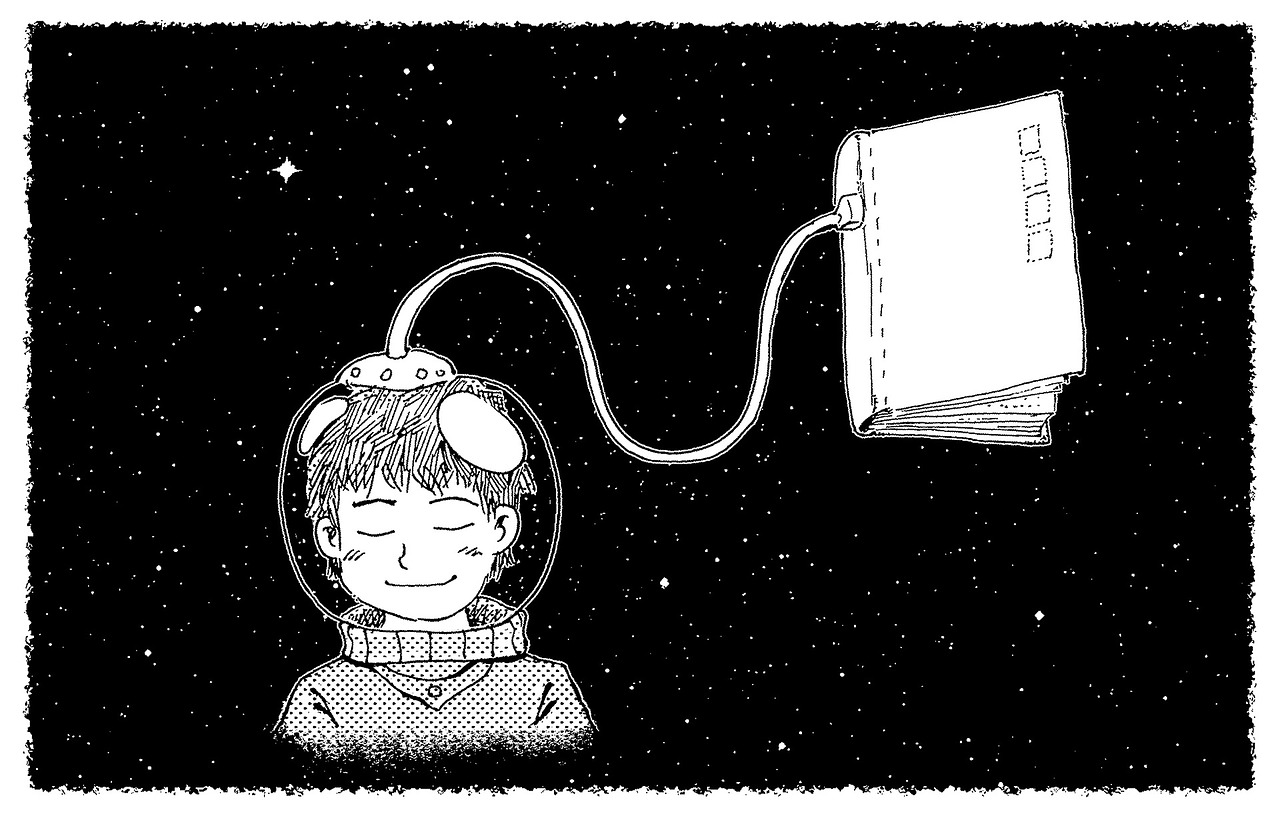
"Curiosity is nature's built-in exploration bonus. We're evolved to leave the beaten track, to try things out, to get distracted and generally look like we're wasting time. Maybe we are wasting time today, but the learning algorithms in our brain know that something we learnt by chance today will come in useful tomorrow." - Tom Stafford
This week's exciting news of the discovery of several Earthlike, potentially life-sustaining planets 40 light years from our own solar system is the perfect illustration of the big payoffs of curiosity, a strength of character that drives us as individuals and as a species to explore the vast unknown and to gather knowledge and experiences for their own sake. Curiosity about space is one area of inquiry that's found an outlet for expression in video games, and games like Kerbal Space Program can, in turn, stoke the fire of teens' curiosity about science and technology. iThrive's Creative Director, Heidi McDonald, shares a story about her son's experience with Kerbal:
"A couple of years ago, my (then) 10-year-old son—who is not especially passionate about science (he's more of a performer at heart)—became obsessed with trying his hand at rocket launches thanks to the video game,Kerbal Space Program. This rocket-building simulation game lets players use concepts from actual rocket science to conduct space explorations and send Kerbals—adorable green creatures that resemble the Minions from Despicable Me—to the "Mun" and other destinations in the Kerbal universe. My son's favorite character in the game was a Kerbal named Jebediah, and he poured hours into finding a way to get that lovable creature to the Mun.
"The day came when the in-game mission was a go. My son sat rapt, watching as the rocket containing his friend Jebediah went up, up, up toward the Mun...but then missed the Mun completely, and flew directly toward the sun. Apparently, the calculations were a bit off. All my poor boy could do was sob as he watched his favorite Kerbal float helplessly toward the Sun.
Fortunately, the Kerbal Space Program developers weren't so cruel as to have Jebediah char to a crisp. Instead, Jebediah's ship was now in constant orbit around the Sun. From then on, whenever my son played, he would sigh deeply each time he saw Jebediah make another revolution—a sad reminder of how he had failed his buddy. "I'm so sorry, little dude!" he would say every time.
We talked about whether or not he should just reinstall the game. The potential issue with doing that was it might mean that he'd never see Jebediah again, depending on the way the game was designed. Games like The Sims randomly create a set of characters to populate the world for gameplay. This is called procedural generation. My son and I didn't know whether the Kerbals were procedurally generated or not. If they were, he could reload the game, but Jebediah would not exist in that new version. My son wondered, do I continue to watch my friend orbit the Sun forever, or do I reload with a chance of never meeting him at all? It was the most intense existential crisis I've ever seen a 10-year-old have.
As it turned out, I was headed to IndieCade that October. Kerbal Space Program was going to be exhibiting there, and my son begged me to ask the developers about procedural generation in their game. When I approached Kerbal animator Daniel Rosas (not at all crying or grabbing him by the lapels and explaining my son's desperation!) he kindly invited my son to email him directly with his questions. As it turns out, most characters in Kerbal Space Program are procedurally generated, but there are six which were specifically created...and Jebediah is one of the six! This gracious developer also explained that it was possible, using the real science in the game, to mount a rescue mission and bring Jebediah back from the Sun!
My son was THRILLED to hear this. He emailed the developer and in return got a few tips on how to mount that rescue mission. He was adamant that he didn't want the answers—only clues to help him figure it out for himself. It took him seven more months, but, with curiosity as his motivation, he was finally able to rescue his favorite character. And he eventually conducted a successful space mission that put Jebediah on the Mun."
Games have the power to inspire our curiosity about science, technology, and the world around us, and this was clear watching a 10-year-old boy play Kerbal Space Program. Heidi reports that she had never seen her son so passionate about wanting to explore what he didn't know as when he was playing the game. Suddenly, he was asking philosophical questions, questions about the design of the game itself, and questions about things like torque and trajectory that he needed to investigate to get Jebediah home and to the Mun. His curiosity gave him the tenacity to go straight to the developers for answers.
Kerbal Space Program created a fantastic environment for a young boy to exercise his curiosity about how things work, and it made him want to mount his own space missions. The developer went one step further to individually encourage and reward his curiosity. We don't know if he will ever be motivated to scan the skies for habitable planets as a career, but if he is, there's a good chance that the seed of his curiosity was planted by a great video game.
Check back with us next week, when we'll dig into other ways games might prompt players to practice curiosity.
What games have made you curious about science, game development, or the wider world?
Celebrating Random Acts of Kindness
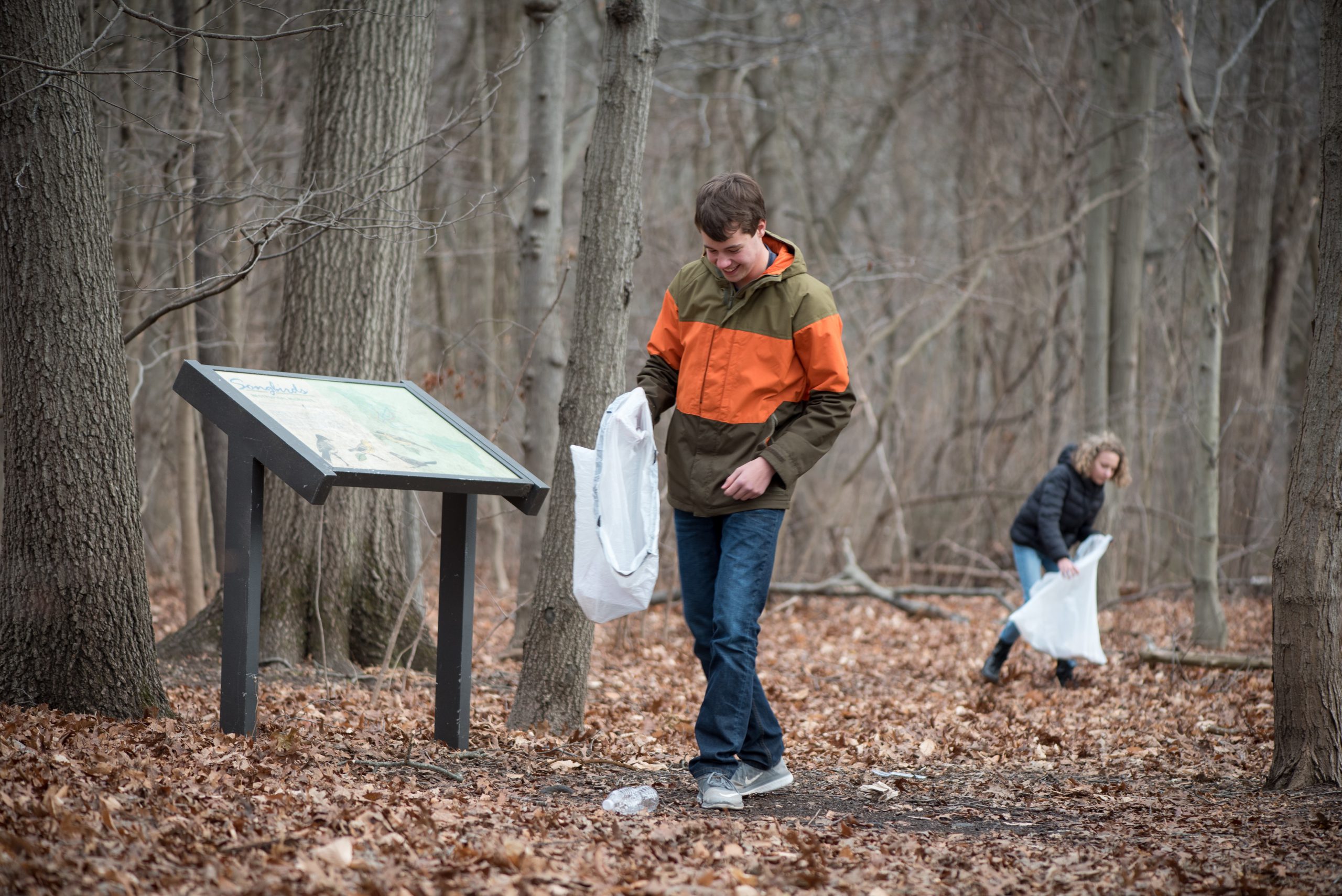
"A single act of kindness throws out roots in all directions, and the roots spring up and make new trees." ― Amelia Earhart
Several weeks ago, I was sitting in line in the Starbucks drive-thru, waiting for my iced grande nonfat chai tea latte with one pump of caramel. I was feeling pretty down about the tension and division in our country (and briefly pondered whether my 11-word-long drink order was part of the problem). I drove up to the window, credit card in hand, ready to pay. The barista beamed at me and reported dutifully, "The person in front of you paid for your order. She said she hopes you have a great day!" I had heard about this happening in drive-thrus, of course, but it was the first time I experienced it personally. It was a simple thing, but it gave me a rush of goodwill and hope for society (which was magnified when the same thing happened three more times that week!). I gave a polite honk and waved at my benefactor as she drove away. I took a moment to savor the warmth of a stranger's kind impulse and wondered if it was just my imagination that the chai tasted a little extra delicious that day.
Because kindness is a powerful tool, that woman's act of kindness benefited her as much, if not more, than it benefited me. Kindness is one of the 24 strengths of character that, according to the founders of positive psychology, is nearly universally valued and considered key to a good life. Research by scientists including happiness scholar Sonja Lyubomirsky suggests that doing kind things for others is a reliable way to boost our own health and well-being. Receiving kindness has the power to heal, and often sets off a chain of paying it forward to others. (But beware: greedy acts are contagious, too—putting kindness into the world is a better choice for everyone).
Over the next few days, still touched by that small, thoughtful act, I was on the lookout for sneaky kindness opportunities. I got a little bit of a rush just contemplating making someone else's day. Buying someone's coffee was an obvious choice. I did it a few times and loved it. But soon I needed to change it up. Research on happiness-enhancing activities—like showing kindness or expressing gratitude—shows that people get a bigger boost when they vary the activities they do. Choosing a novel act of kindness to try every now and then is one way to ensure that the effort delivers maximum happiness payoff.
It turned out that new opportunities to show kindness were everywhere I looked. I donated some of my paid time off to a fellow employee who needed more hours to spend with her father in hospice care. I took the time to get out of my car and stop a shopping cart from rolling into the side of a stranger's truck. Almost every time I did one of these small kindnesses, I noticed yet another that was paid back to me. The man in front of me at the airport noticed I was rushed and insisted I take his place in line at the baggage drop. A stranger took the time to pay me a sincere compliment as we crossed paths.
Stories like these abound, and in honor of Random Acts of Kindness Week (February 12-18, 2017), let's give a shout-out to a few ways that opportunities for kindness show up in and around the world of games:
- Mission: Kill with Kindness: In Cruel 2 B Kind, Jane McGonigal and Ian Bogost's experimental pervasive game, teams compete to be the first to "assassinate" other players in public spaces through kindness. The trick? You don't know who's playing, and who's just an "innocent bystander." Compliment a non-player, and you've made their day. But compliment a fellow Cruel2BKind-er and you may have carried out a successful kindness assassination. What other games do you know of that get throngs of people shouting super nice things to each other in the streets for the win? Watch Cruel 2 B Kind gameplay below (or here).
- Gifting In Games: In Farmville, an online social game where you deck out your own little farm, there are certain objects you can only get through friends' generosity. Gifting things like ducks, bird baths, and topiaries raises the likelihood that others will gift back to you, resulting in fancier virtual farms for all involved! And in case you're wondering, it's okay to be kind because you think your kindness will be appreciated or reciprocated. Getting a benefit for your kindness doesn't make it less meaningful (and in fact, being appreciated for your sacrifice might make future kindness feel more worthwhile).
- Gifting THE Game: Show your love for a favorite game (and the developers who created it) by gifting it to others! A Redditor known as "gildedkitten" bought license keys to Stardew Valley for strangers in order to combat piracy and support the game's developer, and this act set off an inspiring chain of giving. Platforms like Steam also let you gift games to friends. Show kindness by gifting play!
- Gamifying Acts of Kindness: While it's not a game, using the compliment generator at www.happify.com may impart a sense of achievement and a warm glow by letting you visualize the chain of kindness that grows when you share sincere praise for those you love and inspire them to do the same for others. Also take advantage of ways to track your random acts of kindness (and discover new ones you hadn't thought of) at https://randomactsof.us/ and https://www.kindness.org/.
Happy Random Acts of Kindness Week from iThrive! Where else have you seen kindness in the world of games? What are some ways you can be kind in MMO's and other social, multiplayer games? Share your experiences in the comments!
I Haven’t Leveled Up…Yet: Growth Mindset in Video Games (Part 2)

Note: This article is part of a series that captures game industry experts' opinions on game titles and mechanics that might boost players' positive habits, mindsets, and skills. These insights arose from discussions at an iThrive-sponsored think tank with game developers and scholars.
Last week, we introduced the idea that video games like The Sims might encourage what Carol Dweck calls a growth mindset—the belief that abilities are not fixed but can improve through effort.
Research with thousands of young people has shown that a growth mindset boosts achievement, motivation, and persistence. The research on growth mindset in digital games, however, is limited and has focused on "serious games" (those with a primary purpose other than entertainment) like Refraction, a math game that uses a "brain points" incentive system to reward effort and use of strategies instead of just correct answers.
We at iThrive were curious about how existing entertainment games might also foster the mindset that abilities can be built one step at a time. So we asked some experts to weigh in.
ITHRIVE DESIGN HIVE
We hosted a think tank ("Design Hive") with six video game experts to gather some insights about the potential for entertainment games to boost skills like growth mindset that are important for teen thriving. These industry experts—a mix of developers and scholars—met with us over a long weekend to trade reflections on games and design features that open the door to positive practices like growth mindset, even if by accident.
Here are seven ways the experts thought games might support a growth mindset:
- The Buster Principle. The Buster Principle encourages game developers to ensure that games "recognize" when players have hit a wall. In the "brain points" version of Refraction, for example, players have the option to start a new level after 3 minutes of struggle without success. It is important for growth mindset that players don't give up completely just because they don't (YET) have the skill to succeed at one specific task. The Buster Principle urges game developers to design for sustained perseverance by making the task just a little easier when players have repeatedly failed, arguing that, "A small decrease in the difficulty may be the difference between an unhappy player throwing the controller across the room and an ecstatic player rejoicing and pumping their fists upward with a sense of accomplishment." - 100 Principles of Good Game Design
- Leveling up. This basic feature of role-playing games (RPG's) like World of Warcraft is one reason so many people find them endlessly engaging. Similar to the brain points system of Refraction, small actions completed over time in RPG's accumulate experience points (XP), skills, and stats that let players "level up," becoming more powerful and effective.
- Learning how NOT to die. It turns out that both adults and children with a growth mindset pay more attention to what they do wrong. It might sound counterintuitive to thrive by focusing on your errors, but what it really means is that people with a growth mindset aren't afraid of their mistakes. They know that mistakes contain super important information. In some video game genres, including platformers like Super Mario Bros., errors in timing = virtual lives lost (just Google "Ways to die in Super Mario Bros"). This is fantastic motivation for paying close attention to errors: ensure they'll teach you how to survive longer next time. Video games may be safe spaces to learn from failing, instead of letting it shut down effort (or the player).
- Visualizing the growth you're headed for. Games have many methods for showing players where they're headed if they persist. Progress maps show players where they've been and what's left to explore, lending meaning and direction to each small step. Ability trees in games like World of Warcraft and Final Fantasy XV let players plan for which skills they will choose when they level up, giving a concrete destination for incremental progress. These games tend to feature visual reminders of the effort put in over time, such as more intimidating armor for players who have achieved more.
- Literal growth through effort. Games like Dominion, Castles of Mad King Ludwig (both tabletop games), Clash of Clans, and Civilization highlight the literal move-by-move strategic growth of a kingdom, castle, or empire. In games like these, effort and persistence manifest as expanded influence and control and bigger and more impressive castles. In Pokémon Go, players' persistent effort enables them to evolve the creatures they've collected into bigger, more powerful fighters.
- Rewarding dogged persistence. Masocore games and challenging platformers like Spelunky, with its ever-changing levels and traps, reward players who stick with it. Games like these may not make much use of the Buster Principle—they're designed for those who really want a challenge, like gamers with a Mastery motivation. It would be interesting to learn if players who already practice growth mindset are more interested in mastery and more attracted to games like this in the first place.
- Gamifying real-life growth. "Helper apps" and websites with game-like elements such as Fitbit, Lumosity, and Happify track incremental progress towards physical, cognitive, and emotional fitness, respectively. They are built on the premise that growth through effort is possible, and they make that growth measurable and accessible through game-like interfaces.
Because games are designed to be beatable and fun, there is an inherent optimism that we can succeed, given enough time and effort. We expect games to challenge us and to present a learning curve, but we also trust that they will teach us the strategies and skills we need to progress. And some games will inevitably do this better, or more intentionally, than others.
Our Design Hive experts recommend these games (and gamified "helper apps") that are developmentally appropriate for teens and may provide opportunities to practice growth mindset*:
- Fitbit: A wearable tracker that charts progress towards healthy habits like exercise.
- Lumosity: Online brain training that hones players' mental speed, flexibility, memory, attention, and problem-solving skills.
- Happify: Online "games" that help build habits like gratitude that boost happiness.
- The Sims series: Players create and customize characters, then guide them through the ups and downs of life, befriending other Sims and building a range of interesting skills from charisma to alchemy.
- Pokémon series: Gotta catch 'em all! Players explore their surroundings to catch Pokémon, then train and evolve them into powerful battlers.
- Spelunky: A platformer set underground where levels are randomized, challenging players in new ways every time.
- Super Mario Bros. series: A classic platformer with many variations and lots of chances to hone timing skills.
- Dominion: A card game where players are ambitious monarchs, challenging one another to build the largest, most civilized kingdom.
- Castles of Mad King Ludwig: A tile-laying board game with the goal of building an extravagant castle room by room.
- Civilization series: A turn-based strategy game centered on building an empire.
- Clash of Clans: A strategy game where players train raiders to fill their coffers.
- RPG's: Role-playing games like Final Fantasy XV and World of Warcraft let players aim to achieve a set of skills in areas that interest them, and see their persistence pay off one level at a time.
Have you played any of these games? How have they (or other games) helped you or someone you know to practice growth mindset? Share your story!
For more guidance on adopting a growth mindset, read this.
*Note: iThrive produced the curated games list in a joint effort with expert game developers and scholars. Their recommendations are rooted in evidence-based definitions and examples of growth mindset provided by iThrive. These games have not been scientifically proven to boost growth mindset, but they contain features that appear to provide opportunities to develop it.
I Haven’t Leveled Up…Yet: Growth Mindset in Video Games (Part I)
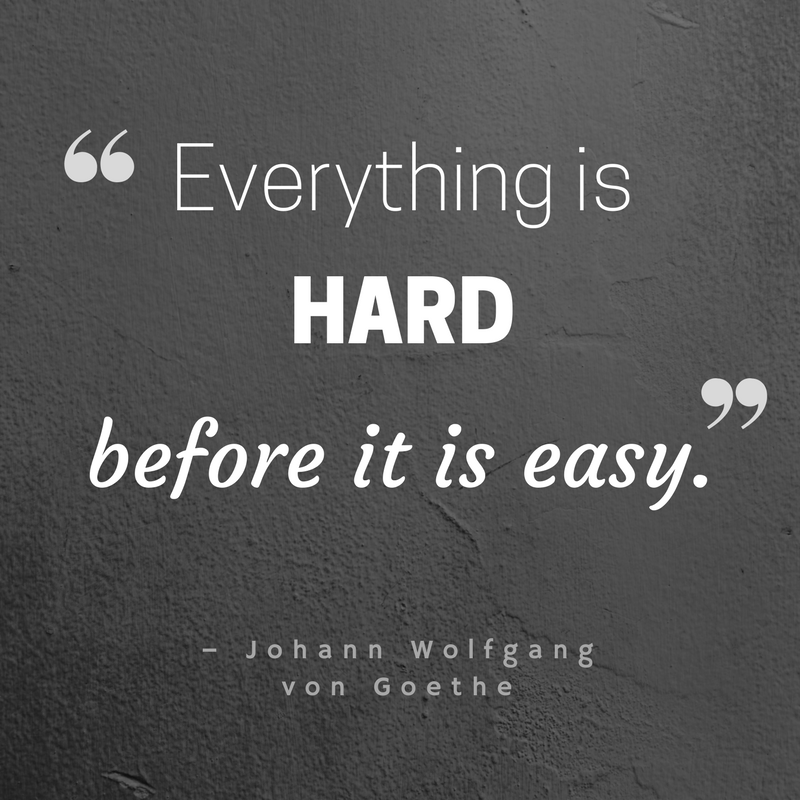
The first time that I realized that social skills can be developed was, ironically, not in my job at a social and emotional learning research lab. It was when I first played The Sims 3.
I had spent maybe 20 minutes lovingly putting the finishing touches on my Sim, getting her eyebrow shape and her personality quirks just right, until she was a (slightly thinner) mini-me named Victoria. I was, for whatever reason, thrilled by the prospect of guiding her through the mundane activities of daily life in miniature on my computer screen.
I bought her a house and set her off on her daily tasks of burning spaghetti, falling asleep in random places when I didn't get her to bed on time, and going to the bathroom, like, a lot. But it was delightful.
I was getting into a routine when a message popped up on the screen. "Victoria wants to socialize! Invite some people over to give your Sim a mood boost." I hovered the mouse over "Throw a party" and saw that I'd have a limited amount of time to host a get-together which would be judged by my guests. I hesitated but clicked, curious to see what would happen.
When Sims of all shapes and sizes strolled through the front door and started making themselves comfortable in Victoria's house, my heart actually started beating a little faster. In real life, I hate throwing parties. The pressure to have fun and be fun is sometimes too much for this introverted homebody. So, my Sim guests put me a little on edge. Sure, they were just NPC's, but I felt almost the same urgent need to impress and entertain them as I might in real life.
I greeted a Sim named Tom and was taken aback when a bright red minus sign lit up over his head, indicating that I had said something he didn't like. "Tom thinks Victoria is being boring," a notification informed me. And, after another attempt, "Tom thinks Victoria is being awkward."
Fantastic. I am hopelessly awkward and even the game knows it! There's nothing I can do about it. About a million middle school social traumas flooded my mind.
I turned to my (real-life) husband and demanded, "Why don't these dumb Sims like me?!" "Well," he grinned, noticing I had maybe spiraled just a little, "it usually starts out like that. But you can compliment your guests and joke around to win them over. Just keep doing it over and over again."
He patiently showed me the dialogue options with the best chances of success, and soon I had triggered enough plus signs (see photo) to get feedback like "friendly" and "amusing." Aha! I could grow my social skills here little by little. First impressions didn't mean everything. After several interactions, Tom became my friend.
It occurred to me after some practice striking up and maintaining friendships in The Sims 3 that, in real life, there are concrete, meaningful actions anyone can take to build and nurture friendships despite shyness or anxiety. Regular contact, sharing jokes, giving sincere compliments, and showing genuine interest in other people's likes and feelings are deposits in the friendship bank that add up over time.
This was easy for me with some people in my life, but when I was meeting someone for the first time or felt some anxiety in a new group, I found myself conjuring up memories of Sims gameplay as a reminder to get to the basics of social interaction—smile, tell a joke, compliment. Having played out the scripts in a virtual space and getting positive feedback (and new friends) was crossing over to my life outside of the game.
I began to visualize an imaginary Sims-inspired "friendship meter" filling up in my real life each time I struck up a conversation with someone new or finally scheduled that coffee date with an old friend after too many months. My usual anxiety of meeting new people was not as high. (Thanks, Sims!)
GROWTH MINDSET
The Sims, I would argue, is one example of a digital game that plants the seed of what Carol Dweck calls "growth mindset." Growth mindset is the belief that abilities aren't fixed or static, but that trying and effort make a difference in how sociable or proficient in math a person can become. It doesn't mean that everyone has the same potential in every area. It does mean that applying optimism, effort, and effective strategies has the potential to move the dial on the skills you'd like to improve.
Dweck and colleagues including Eleanor O'Rourke recognized the potential for digital games (in this case, an educational computer game called Refraction) to train growth mindset. They collaborated with game scientists to create a modified incentive system that, in their words, was "designed to reward the micro behaviors that are indicative of productive struggle." In other words, their "brain points" system rewards small, incremental actions like trying a new strategy or starting over, instead of rewarding only the slightly longer-term achievement of completing the level.
The researchers found that the 7,500 students who played the version of Refraction with the "brain points" reward system stuck with the game longer and used more strategies than the students who received traditional "level completion" rewards—and they also were more engaged and persistent.
The research on growth mindset in digital games is limited and has focused on serious games—games designed for a primary purpose other than entertainment. But experiences with entertainment games like The Sims made us at iThrive wonder what other types of games already out there could be mined for growth mindset principles. And what would happen if more developers deliberately designed games to boost skills like growth mindset using principles of great game design?
We've sat down with expert game developers and scholars to discuss just that. Check in with us next week for Part 2 to see what we discovered!
Has a game ever helped you or someone you know to practice growth mindset? Share your story!
For more guidance on adopting a growth mindset, read this.
Video Games Can Boost Empathy

Note: This article is the first in a series that captures game industry experts' opinions on game titles and mechanics that might boost players' positive habits, mindsets, and skills. These insights arose from discussions at an iThrive-sponsored think tank with game developers and scholars.
Researchers and policy advocates have spent decades tallying the dangers of video games. But there is growing scientific evidence that prosocial video games—those with opportunities to help instead of harm others—can boost players' empathy and prompt them to be more helpful towards others in the real world.
Many games that demonstrate prosocial outcomes in research (Lemmings and Super Mario Sunshine are two examples) were designed first and foremost for entertainment, not to leave players hankering to do good. So the empathy boost captured in much of this research appears to be a happy byproduct of great game design, not—at least not always—an outcome developers deliberately target. It turns out even games with violent themes can prompt prosocial behavior in players who play in cooperative mode.
This made us at iThrive wonder, what other great games already out there might be brimming with opportunities to hone skills and habits that benefit teens? And what would happen if more developers did aim to boost skills like empathy using principles of great game design?
ITHRIVE GAMES' DESIGN HIVES
To gather some insights into these questions, we hosted a think tank ("Design Hive") with six expert video game developers and scholars. These industry experts met with us over a long weekend to trade reflections on games and design features that open the door to positive practices like empathy, even if by accident. We left with a curated list of promising "empathy games," shared below.
We launched the discussion on empathy with iThrive's evidence-based definition (adapted from the work of emotion researcher Dr. Jamil Zaki): Empathy means feeling what others feel, imagining how they view situations, and being motivated to do something with that knowledge. Here's what the developers had to say.
INHABITING THE MEDIUM
One insight permeates the rest: video games are special in the world of media. Games researcher Katherine Isbister (who attended the Design Hive) writes in her book, "At their heart, games differ from other media in one fundamental way: they offer players the chance to influence outcomes through their own efforts. With rare exception, this is not true of film, novels, or television."
The ability to fully inhabit the world of a video game, to embody characters with agency and a chance to impact the world and characters around them, is foundational to many of the experts' other insights about games and empathy. The action in a game, unlike in most other media, is the result of something "I, the player" have done. This stands to make players uniquely invested and immersed in the story before them. And research shows that immersive presence can be linked to increased empathy.
So, from the perspective of "me," the agentic player, these are a few of the ways games offer chances to develop empathy:
- I see other perspectives as valuable currency. In some games, I have to consider points of view different from my own in order to succeed. I must examine both sides of a family feud in Star Wars: Knights of the Old Republic, decide how probing a question to pose to each character in Telltale's The Walking Dead, and interview characters in detective games like Nancy Drew to piece together what really happened. I take my time to listen because missing something important has real consequences for my success.
- I act from different points of view. In games like Never Alone, Brothers, and Telltale's Game of Thrones series, I can switch from one character to another. This lets me see the same world through many eyes and viscerally explore and appreciate each character's unique perspectives and abilities to move the action forward.
- I inhabit difficult circumstances. Even though I may never do it in real life, I can experience the perils of war in This War of Mine and 1979:Revolution, embody someone who is different and marginalized in Dys4ia, see the world through the eyes of a boy with autism in Max: An Autistic Journey, and care for a child with a terminal illness in That Dragon, Cancer.
- I lose someone important. When I lose characters or companions who have helped me or kept me company throughout the game—like in Passage, Fable 2 or Dragon Age: Origins—I wonder if there was something I could have done differently to save them. I have to strategize about what I'll do without them and adapt to their absence. I might feel more empathy for the experience of loss in general.
- I make choices that impact others. In Mass Effect, I choose which character will perform a potentially fatal mission. In Undertale I decide which characters to help and which to fight, and in Papers, Please I find out how willing I am to break the rules to help someone else at a personal cost. In multiplayer online games like World of Warcraft, my choices have an impact on real players. I weigh whether to cooperate or compete, whether or not to share my loot, and learn how it feels when others make these decisions about me. I watch the consequences of my choices play out for better or for worse.
One thing was clear after this session: video games can model and prompt empathy, and it doesn't happen in a vacuum. It helps if players are willing and able to reflect on what they encounter and have the supports necessary to do so effectively. At iThrive, we strive to identify or create the supports that allow games to be meaningful for teens' well-being. But starting with great game design certainly doesn't hurt.
In that spirit, our Design Hive experts recommend 8 games that are developmentally appropriate for teens and may provide opportunities to practice empathy*:
- 1979 Revolution: Black Friday
- Never Alone
- Papers, Please
- Passage
- Star Wars: Knights of the Old Republic
- That Dragon, Cancer
- This War of Mine
- Undertale
Have you played them? How have these or other games helped you or someone you know to develop empathy? Share your story!
Note: iThrive produced the curated games list in a joint effort with expert game developers and scholars. Their recommendations are rooted in evidence-based definitions and examples of empathy provided by iThrive. These games have not been scientifically proven to boost empathy, but they contain features that appear to provide opportunities to develop it.
Why Do Teens Play Video Games?
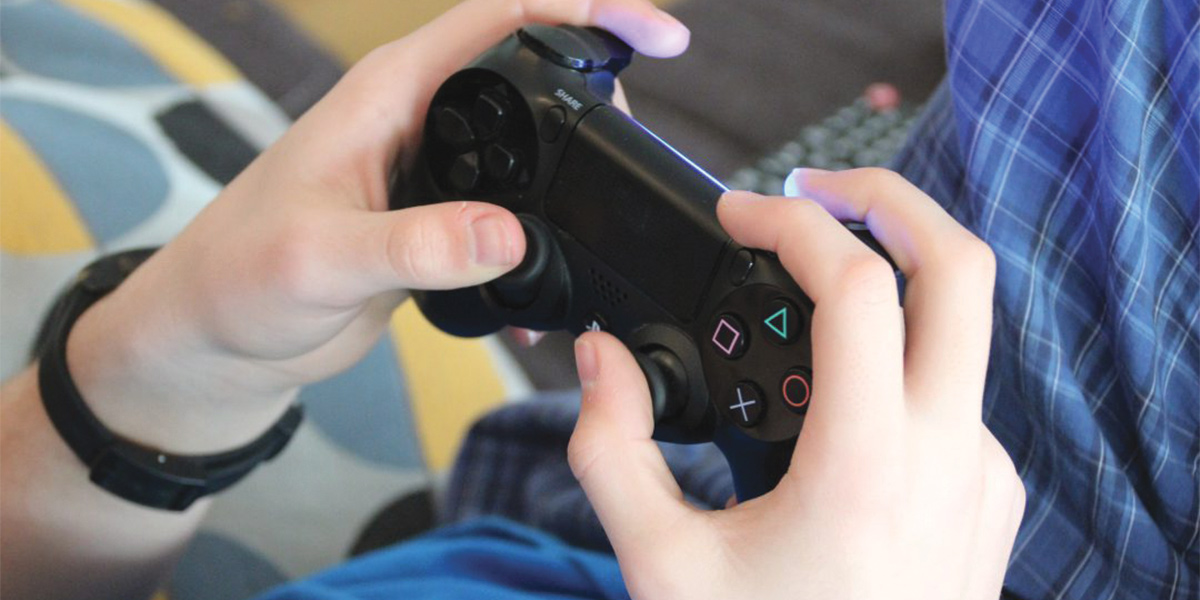
97% of American teens play video games. You'd be hard-pressed to find many other activities that 97% of teens do. Maybe school and sleep. Maybe. So what is it about video games that appeals to nearly all teens? Well, to get the obvious out of the way, video games are play, and play is fun. (It's also more important than many people realize.) But in addition to using video games as a source of play, teens might be doing something else quite sophisticated. Whether they know it or not, teens are harnessing video games to boost well-being by meeting their psychological needs.
GAMING TO THRIVE
According to Self-Determination Theory, all people share three basic psychological needs: competence, autonomy, and relatedness. And the same psychologists who developed this theory argue that one reason video games are so motivatingis that they help players meet all three of these needs. Here's how.
COMPETENCE: VIDEO GAMES CAN HELP TEENS FEEL MASTERFUL.
You know those word searches on the back of Honey Nut Cheerios boxes where you have to locate obscure cereal jargon like "milk" and "spoon"? Have you ever started one of those and refused to leave the table until you completed it, even though you had long since devoured your bowl of Cheerios? No? Just me? Well, in a (honey) nutshell, that's the need for competence. Teens (and people of all ages) seek out opportunities to be challenged and to master a given task-even if that task is finding inane words on a soon-to-be recycled strip of cardboard.
Video game developers use a set of tools that reliably help players feel masterful. Great video games get harder as you progress through them. They ensure that you're always challenged, but not so much that you'll give up. And they provide constant feedback via leaderboards, achievements, and progress bars to make your accomplishments tangible and highlight how to succeed.
Take Guitar Hero. As you play through story mode, the songs get harder, requiring trickier strumming patterns and more fingers on the fretboard. But you also get concrete affirmations of your skills: the song sounds radio perfect when you get it right, your note streaks are satisfyingly tallied and displayed on the screen, and the crowd cheers you on when you shred a sweet solo. In other words: Challenge? Check. Mastery? Check. More fun than the Cheerios word search? Check.
AUTONOMY: VIDEO GAMES PUT TEENS IN CHARGE.
In Self-Determination Theory, the need for autonomy means that people are more motivated to do something if they can make choices about it and shape their own experience. This need becomes a top priority as kids grow into teens. Teen expert Laurence Steinberg calls becoming autonomous "one of the fundamental developmental tasks of adolescence."
The majority of people who play video games do it because they want to, not because they have to. The very decision to pick up a controller and pour hours into a boss battle is one way a teen exercises autonomy. What's more, there are so many styles of games (racing, action-adventure, role-playing, simulation, platformers...) that, just by picking a genre that matches their tastes, teens have the freedom to generate the experience they want every time they switch on a PC or console.
And there's one video game genre that's just brimming with opportunities to feel autonomy. "Sandbox" games-Minecraftis one example-let the player roam wherever, build whatever, and complete tasks whenever. Minecraft players have the choice to build a home (or not), explore the far reaches of the map (or not), and slay the Ender Dragon (or not). In games like this, teen players have the freedom to-quite literally-craft their own experience.
RELATEDNESS: VIDEO GAMES CONNECT TEENS.
What is relatedness? Relatedness is friends. Relatedness is fellow adventurers, soldiers, teammates, band members, and super heroes. Relatedness is humans' desire for connection with others. Positive relationships are key to leading a healthy, fulfilling life, and research finds that teens are using games to make friends.
According to a Pew Research Center report, gaming is social for most teens. Three-quarters of teens play video games with other people at least part of the time, and nearly half of the time that gameplay is done with someone a teen already knows in "real" life.
Katherine Isbister looks to players' publicly posted reflections on gameplay as one way to research how digital games support relatedness. Isbister's book calls out examples of meaningful connections forged through gaming, like the surprisingly deep bond a player felt with an unknown fellow traveler in Journey, even though no words passed between them. Or another player's re-connection with an old friend she didn't know lived in the same city, until Words With Friends matched them up for a challenge.
Game-based relatedness covers a range of connections. Feeling the warm fuzzies for a non-playable character run by the game's artificial intelligence, deepening a connection with someone a player already knows, or taking a friendship with a fellow player out into the real world are just some of them.
APPRECIATING WHY TEENS PLAY
So the next time you're playing a video game (or watching a teen play), see if you notice how the game challenges, frees, or connects. Does the game succeed at teaching skills little by little, paving the way to mastery? Are players free to customize their avatars, choose their difficulty level, or explore at their leisure? Are quests more fun when completed with companions sitting across the room or across the globe? Considering video games from the viewpoint of competence, autonomy, and relatedness, you may develop a deeper appreciation for why many teens choose great video games as one reliable way to meet their needs.
